Author: James Williams
Side Seam Reinforcement
One last thing to do for the hem area is to add a gusset to the bottom of the side seam. This strengthens the area, preventing the seam from ripping open with use.
You can begin by drafting or printing the pattern for the gusset. There are other sizes and styles you could draw, but this is the most basic version I’ve found.
To draft, first draw an equilateral triangle, 2″ on each side. You can refer to this video to draw the triangle.
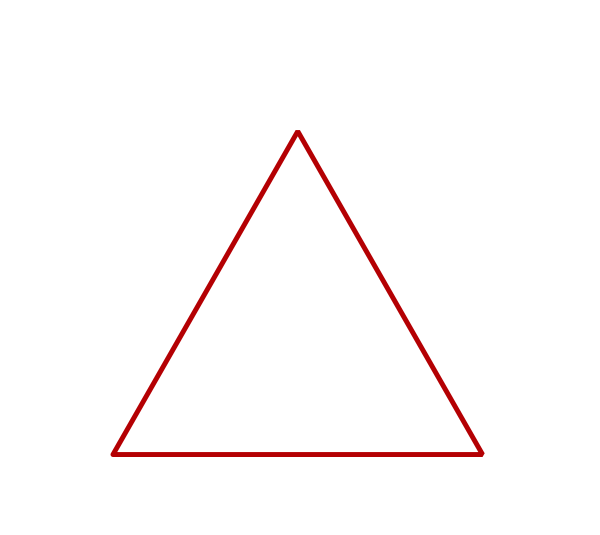
Next, mark the midpoint, 1″ from each corner, on both sides.
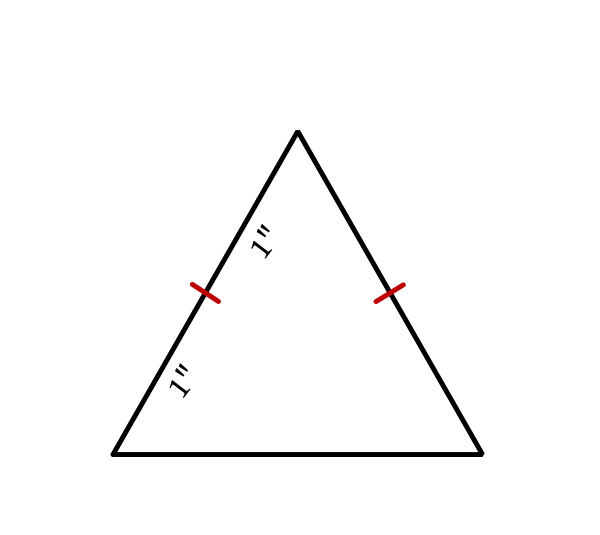
Add a 1/4′ seam allowance all around.
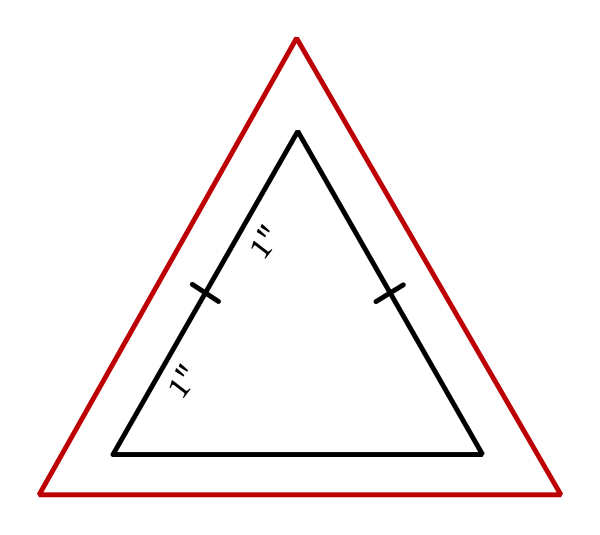
Finally, draw a line (they don’t have to be dotted), passing through the two points you made along the side. Then make another two lines across the bottom corners, about 1/4″ from each corner. These are the fold lines.
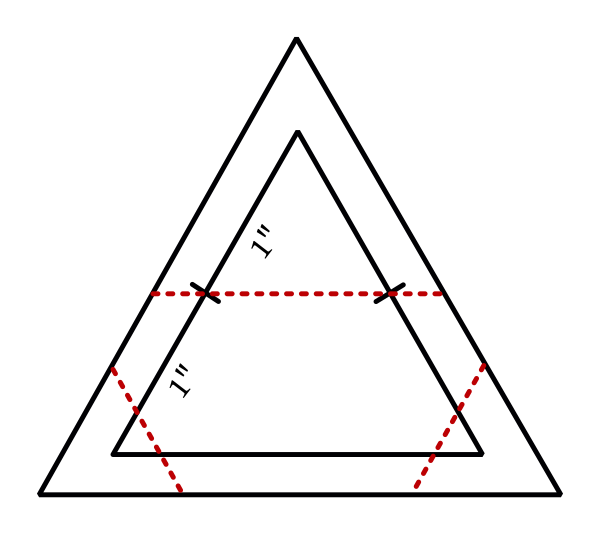
Here’s the completed pattern with the grain line indicated.
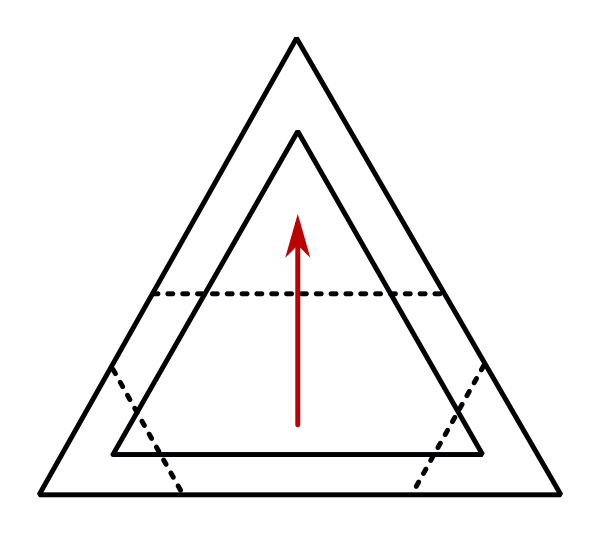
With your pattern complete, cut out two gussets. You may want to cut a couple of extra to practice with the pressing.
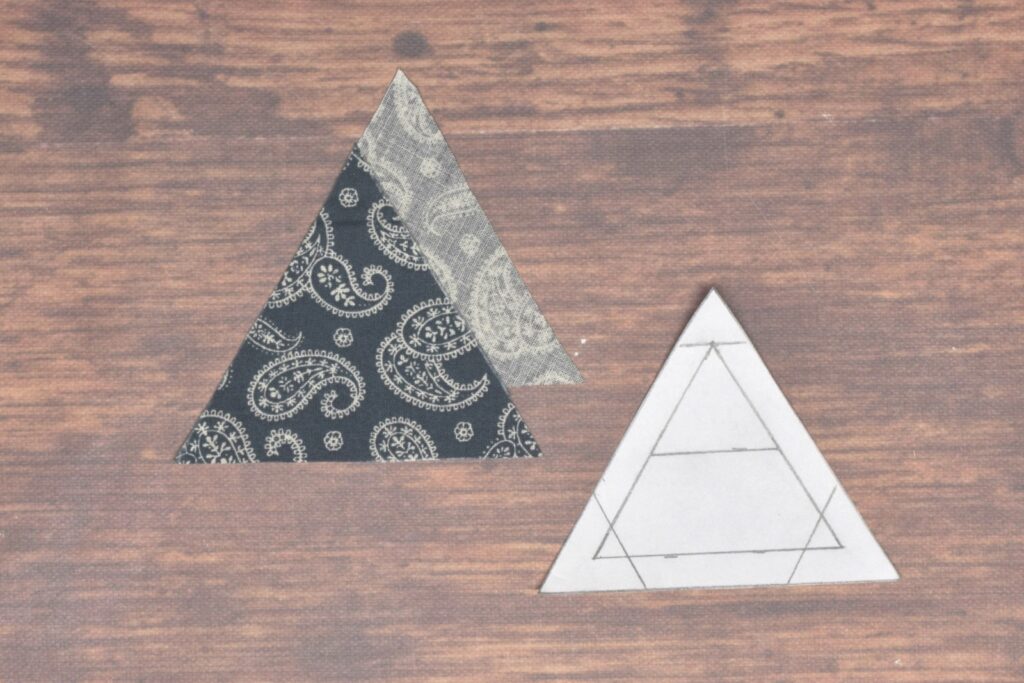
The pressing is definitely the trickiest part here, as the folds are so small. You get one looking good, and then it gets messed up as you press the next one. Just keep working at it!
Press the two bottom corners up along the fold lines. Press the top corner down so that the fold is where the top of the triangle (without the seam allowance) falls.
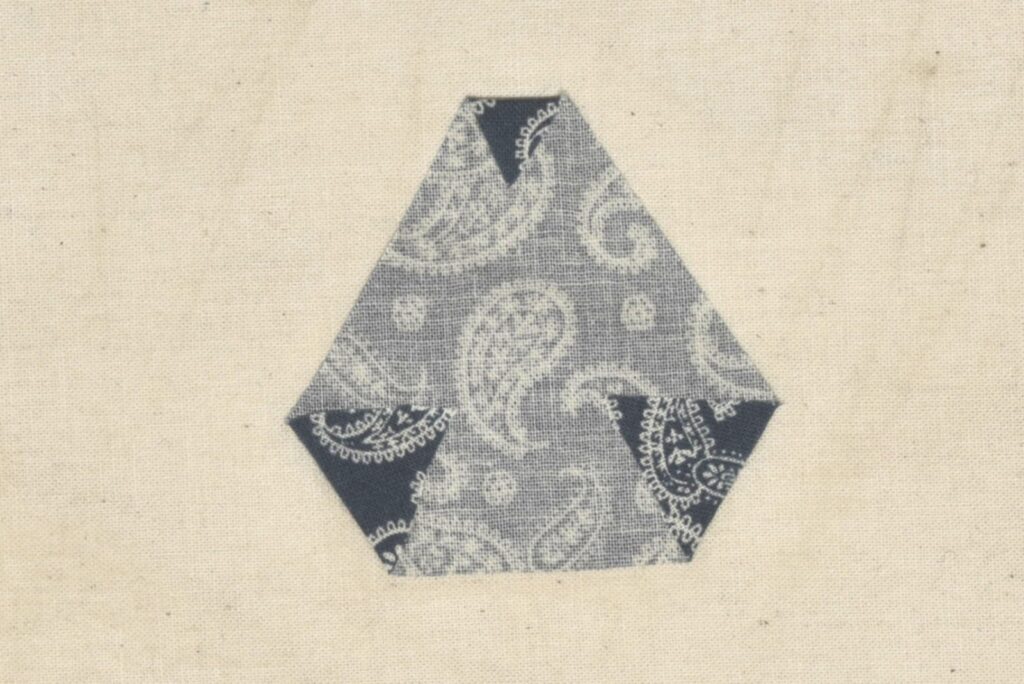
Press the two sides over using a roughly 1/4″ seam allowance. I say roughly, because it’s almost impossible to get the folds to 1/4″ exactly and have everything still looking good. Try to get the top corner as sharp as possible.
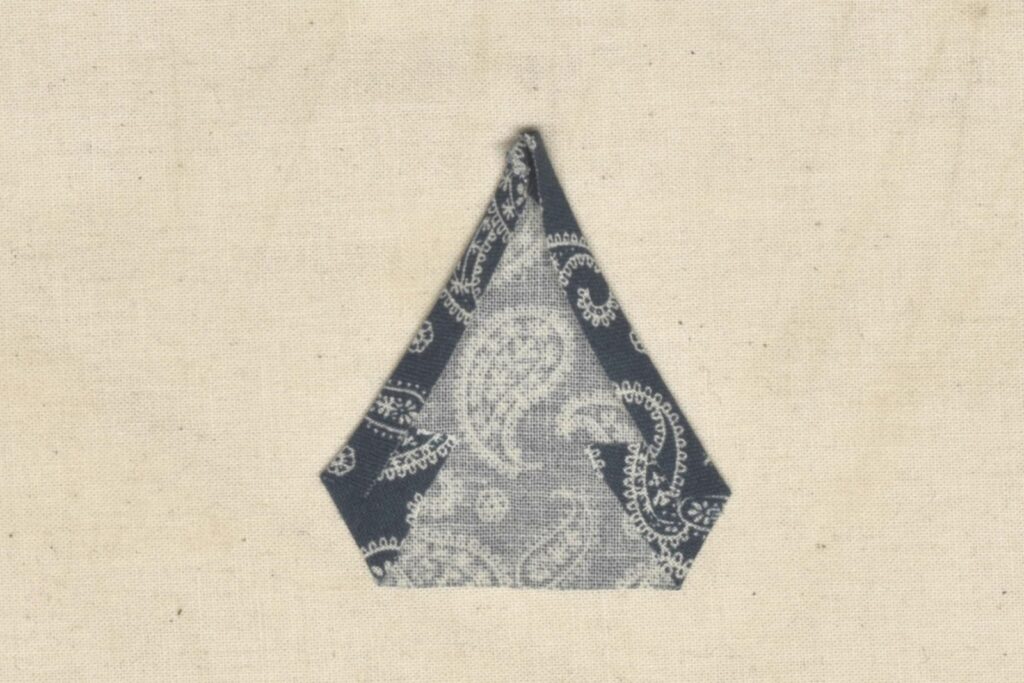
Fold the bottom edge upwards. The bottom corners of the triangle are not sharp, but form two additional flat edges.
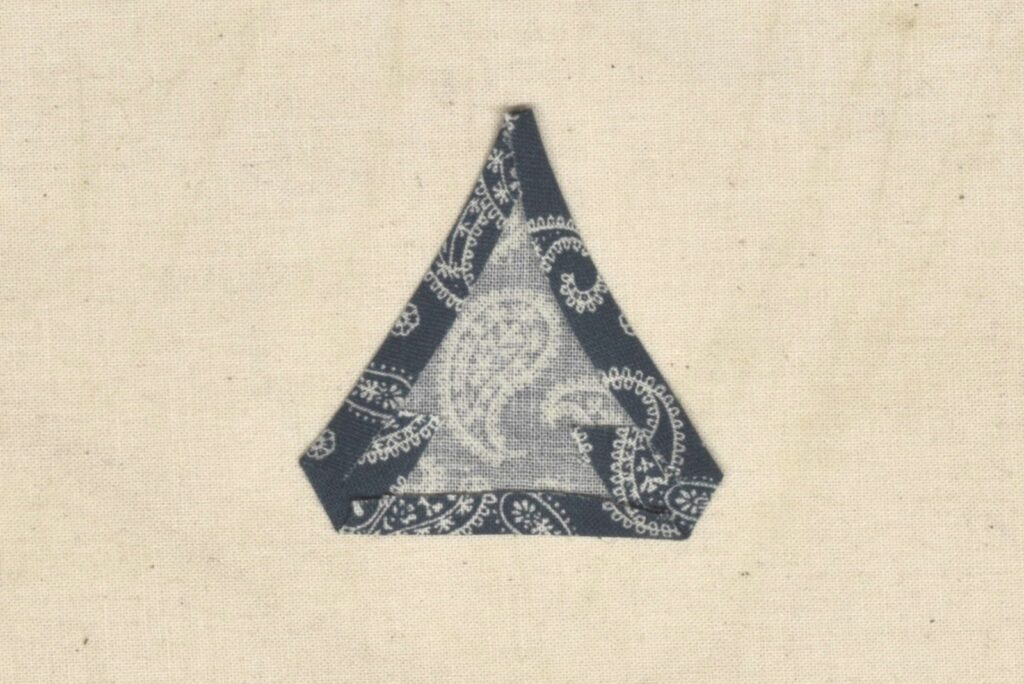
Press everything as best you can, then turn to the right side and press again. I used a bit of starch in an attempt to get everything to stay flat. After the photo I did sharpen up that top corner a little more.
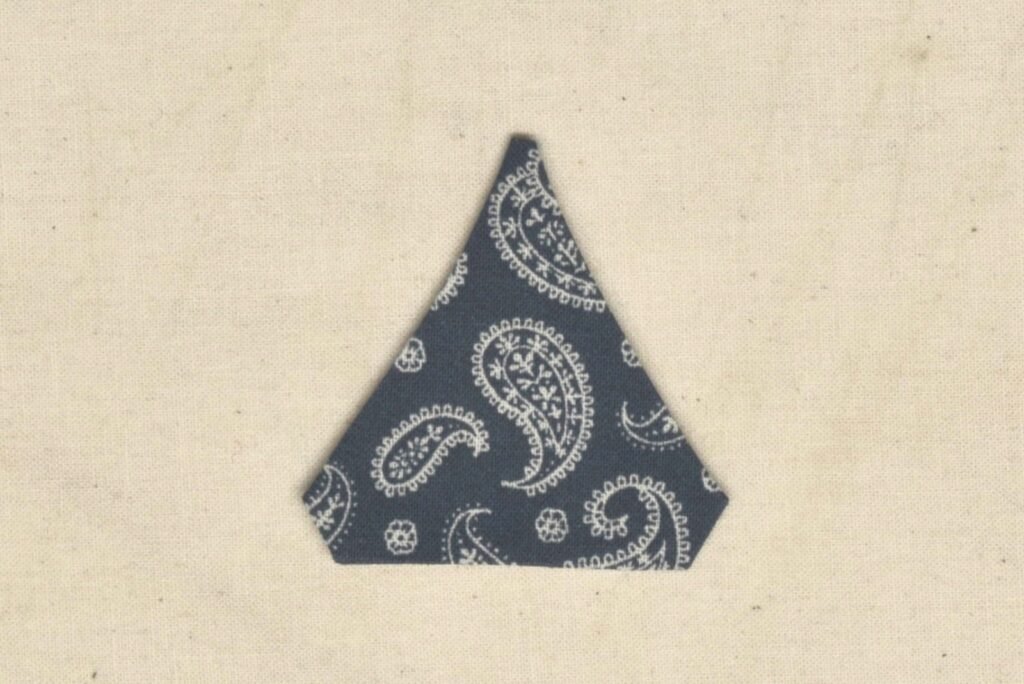
Finally, fold the gusset in half along the vertical fold line as shown.
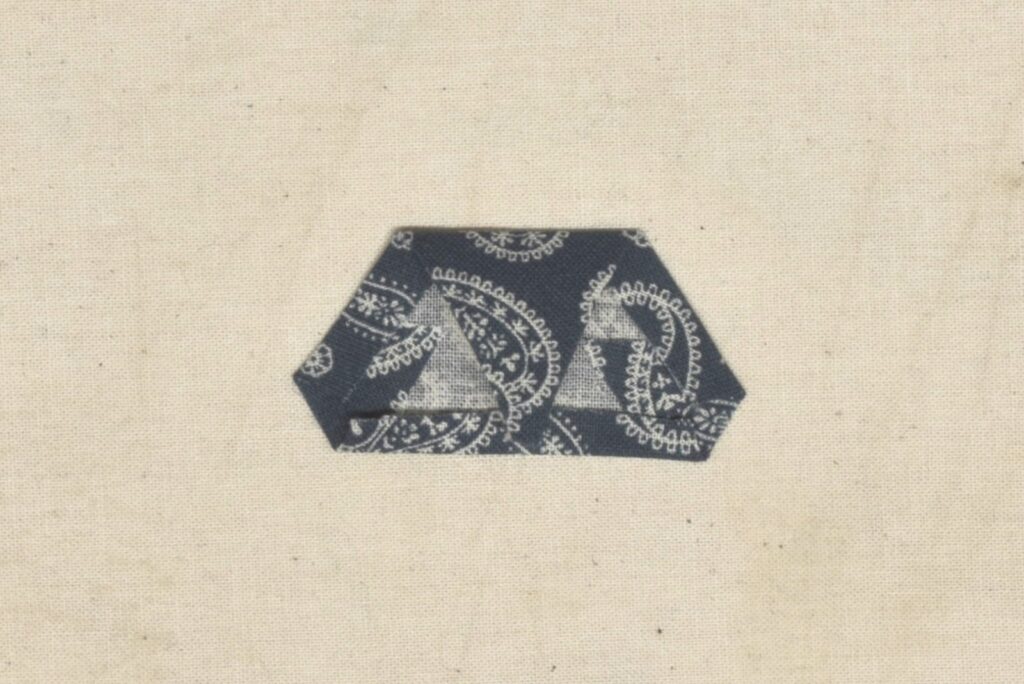
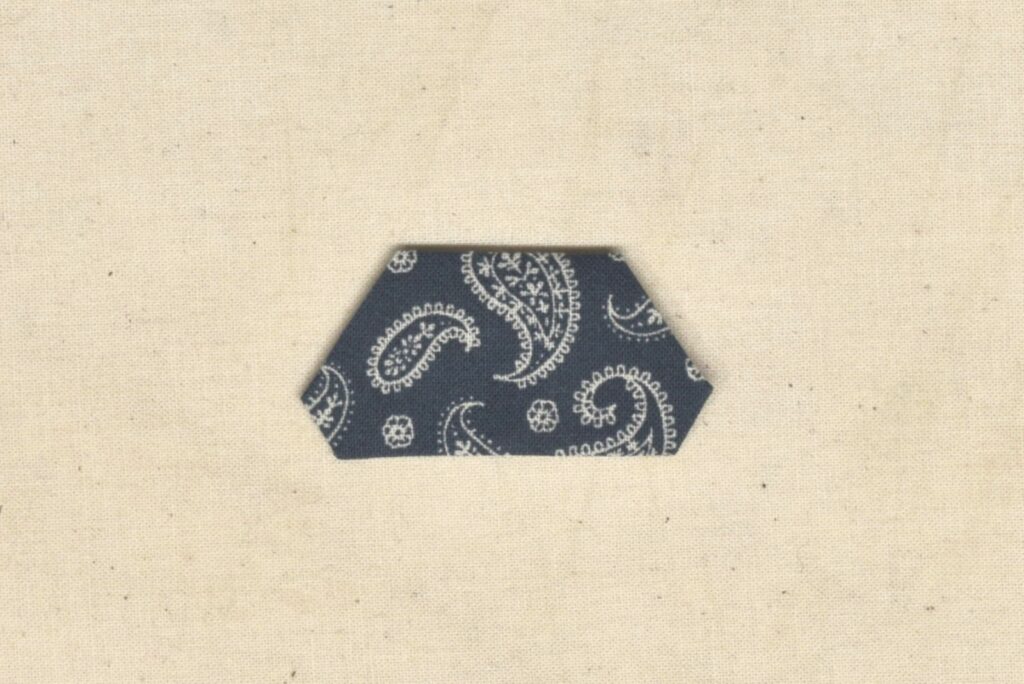
Repeat for the other gusset.
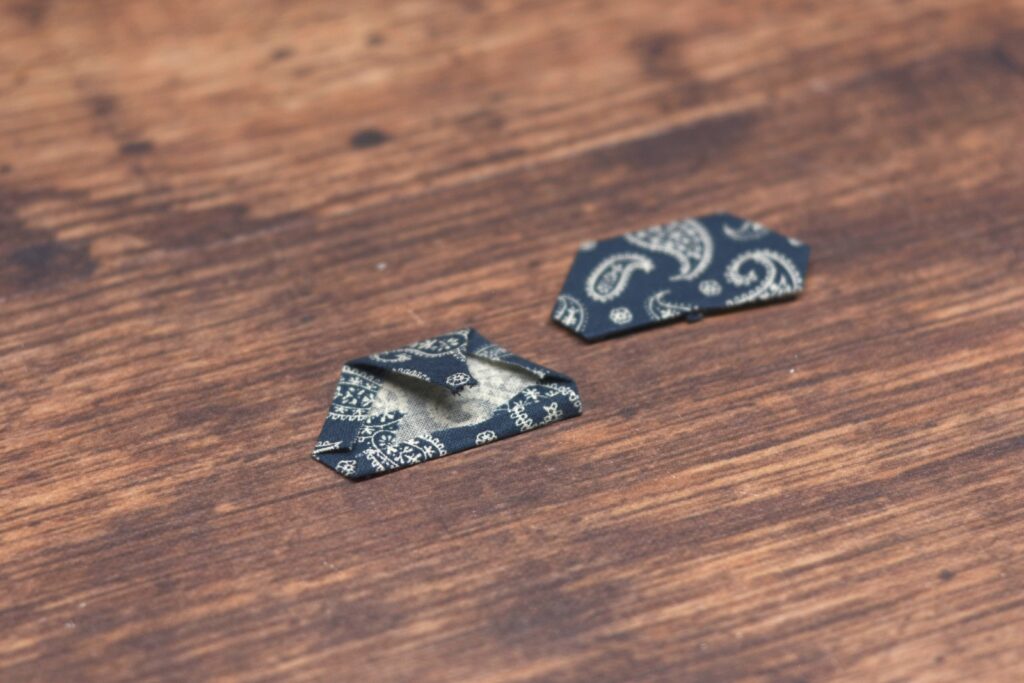
Attaching the Gussets
With the gussets all folded up, lay the shirt side seam right side up and position one of the gussets in place, the smaller triangular half facing upwards towards the seam.
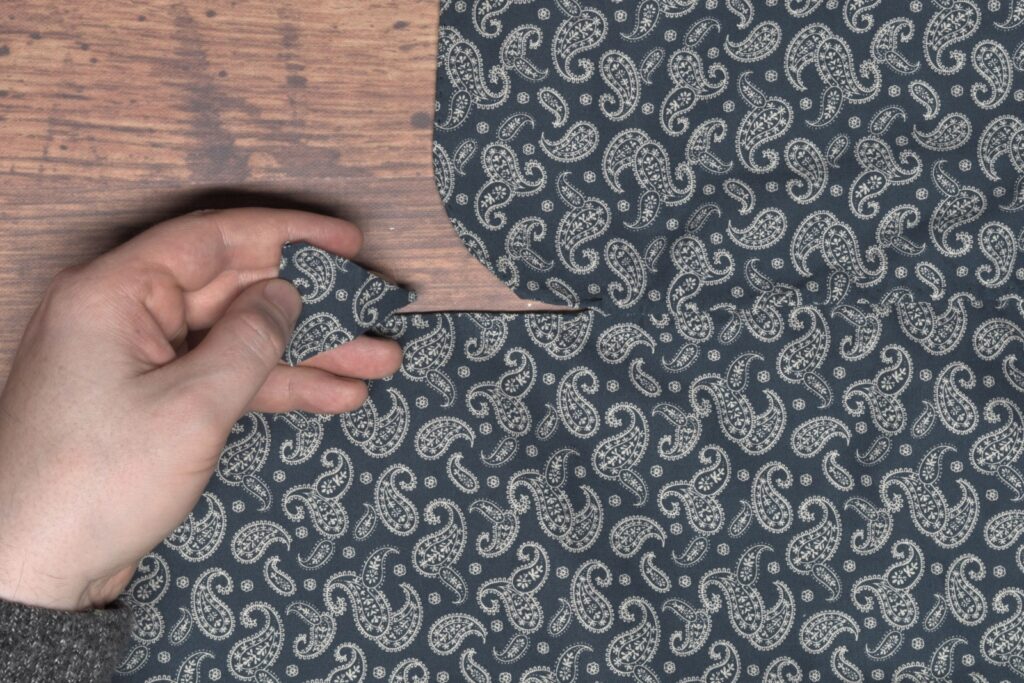
It takes some fiddling with, but I ended up folding the gusset in half as I positioned it at the bottom of the side seam. The tip of the gusset should be about 1/4″ above the bottom of the side seam. The shirt the splays out a little to make room for the gusset.
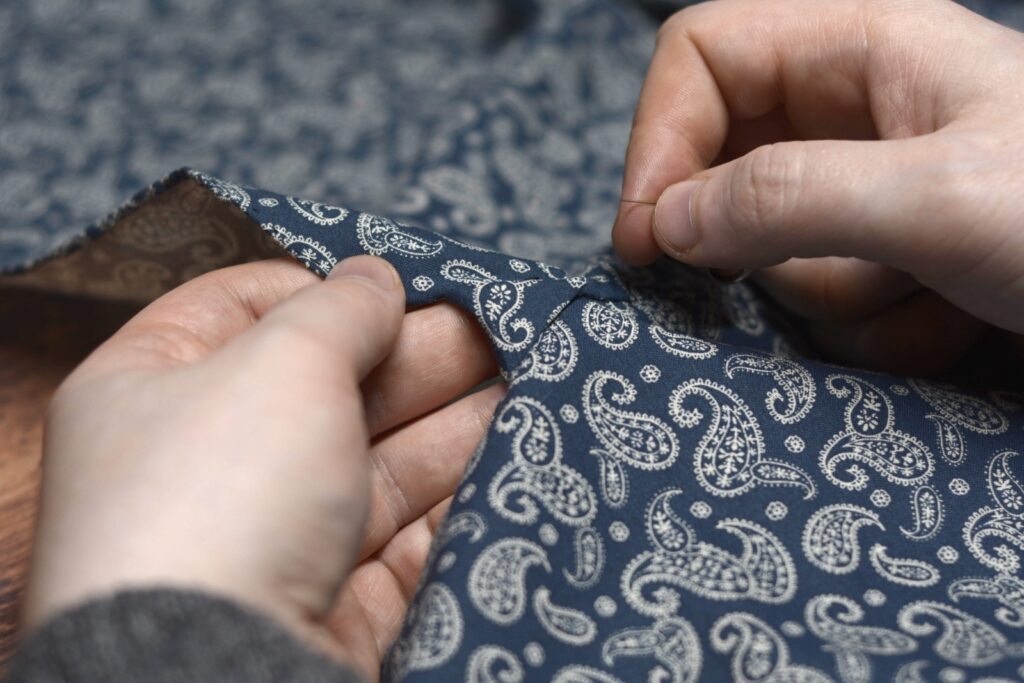
Fell one edge of the gusset to the shirt, keeping the rolled edge of the shirt as tightly into the gusset as you can without distorting the fabric. It’s a little tricky in that the shirt will want to pull out of the gusset since the tolerances are so small.
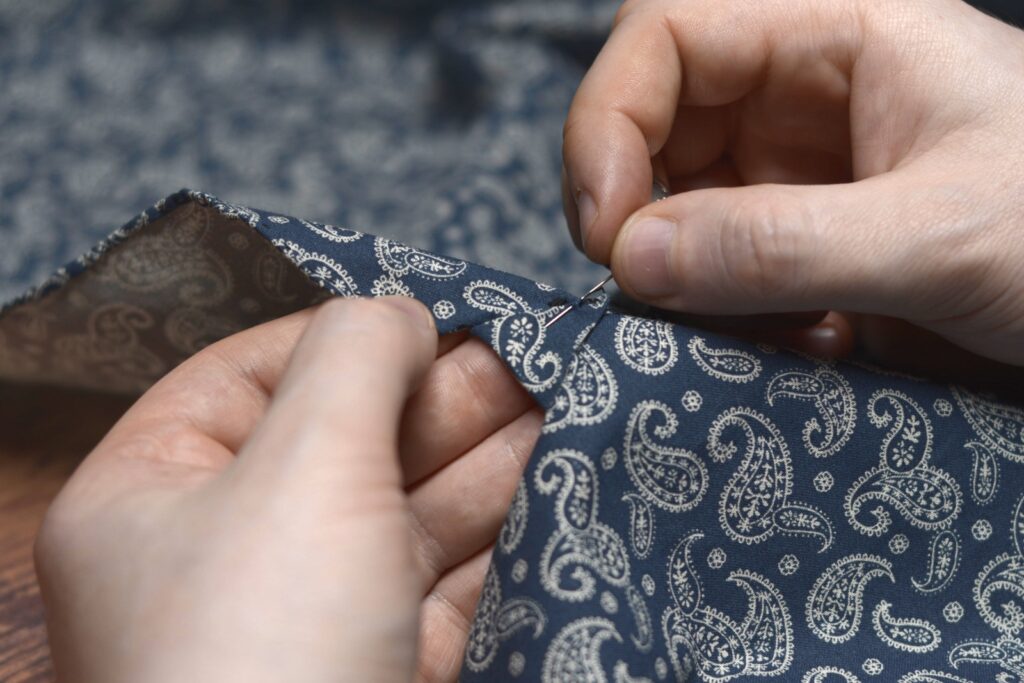
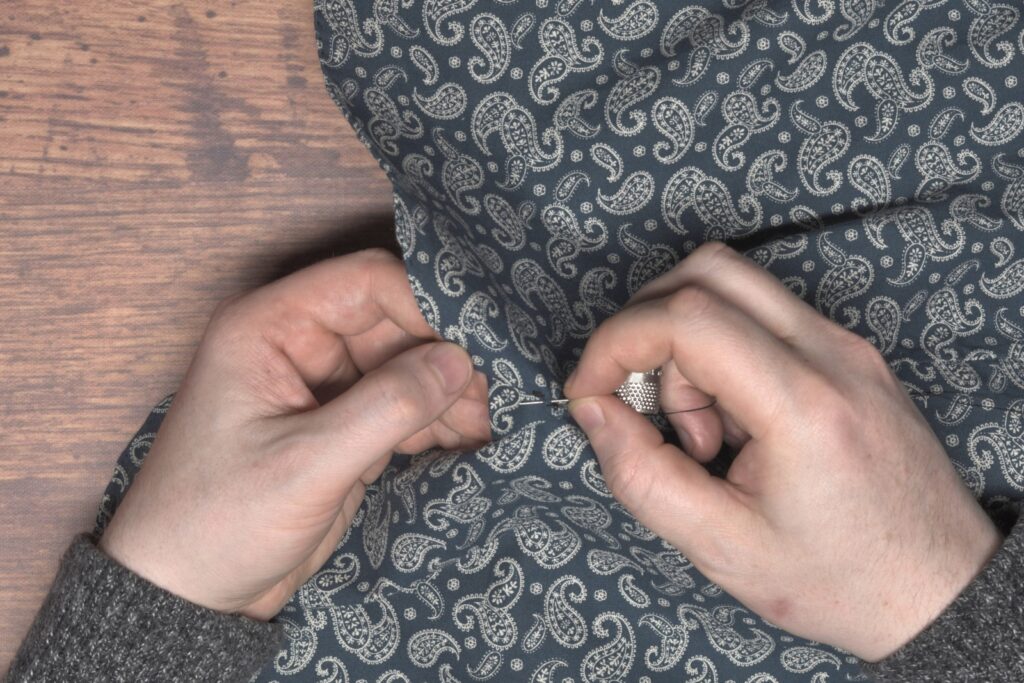
Fell the other half of the gusset to the shirt in the same manner. If you’ve made it this far the rest is much easier!
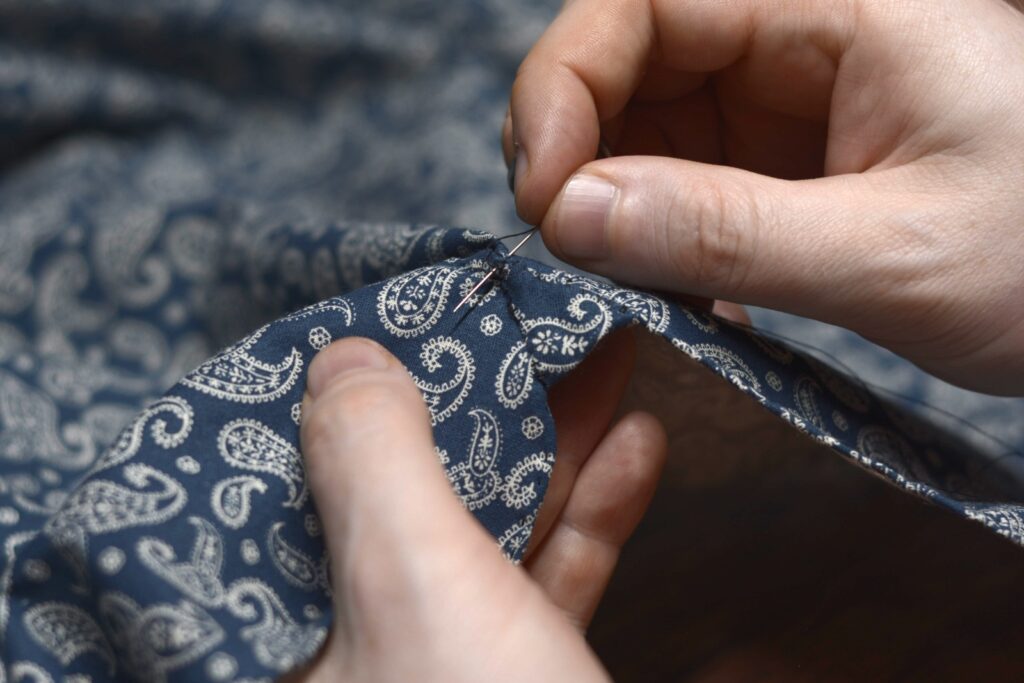
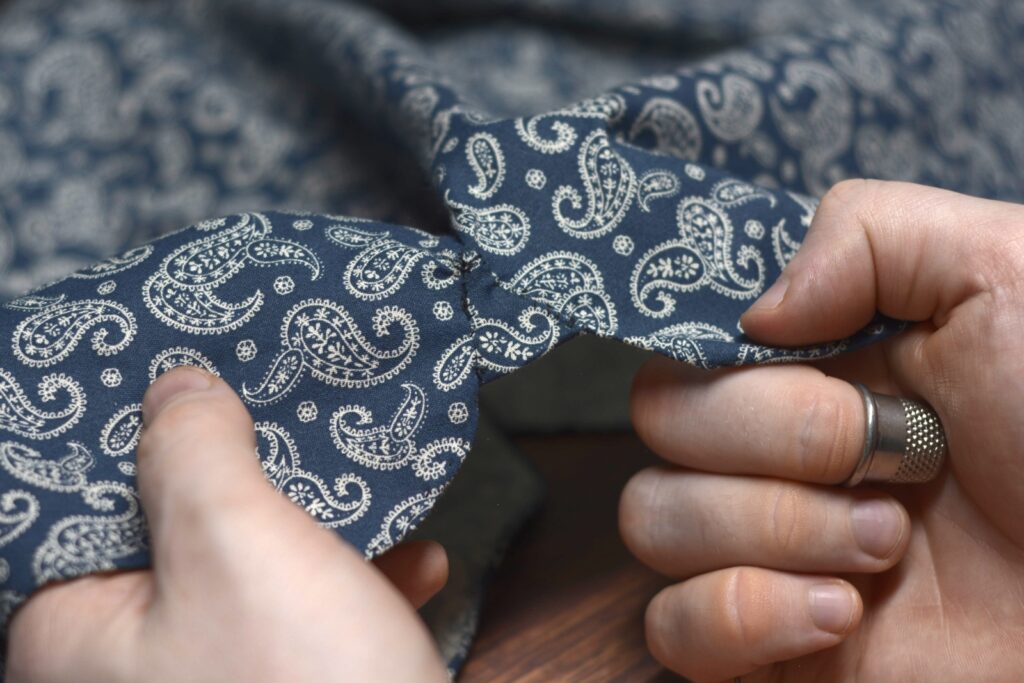
Now fell the inside of the gusset to the shirt, smoothing out the shirt and gusset as you work as necessary.
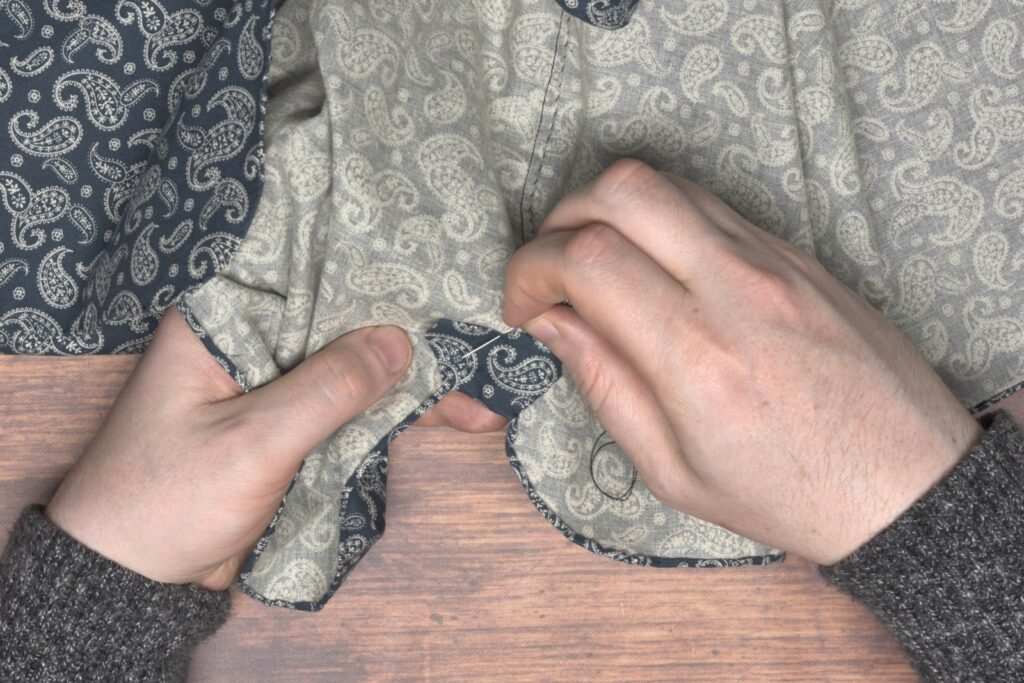
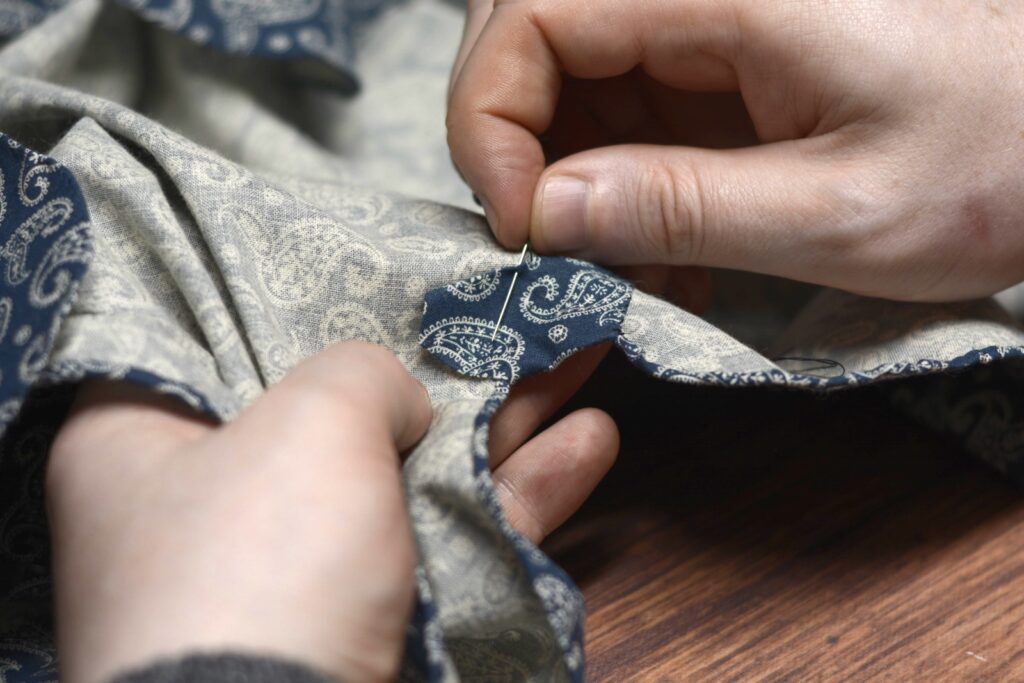
Here’s my gusset from the inside. I found it tricky to keep the inner layer centered, so both of mine were off by quite a bit. Will need to work on that next time.
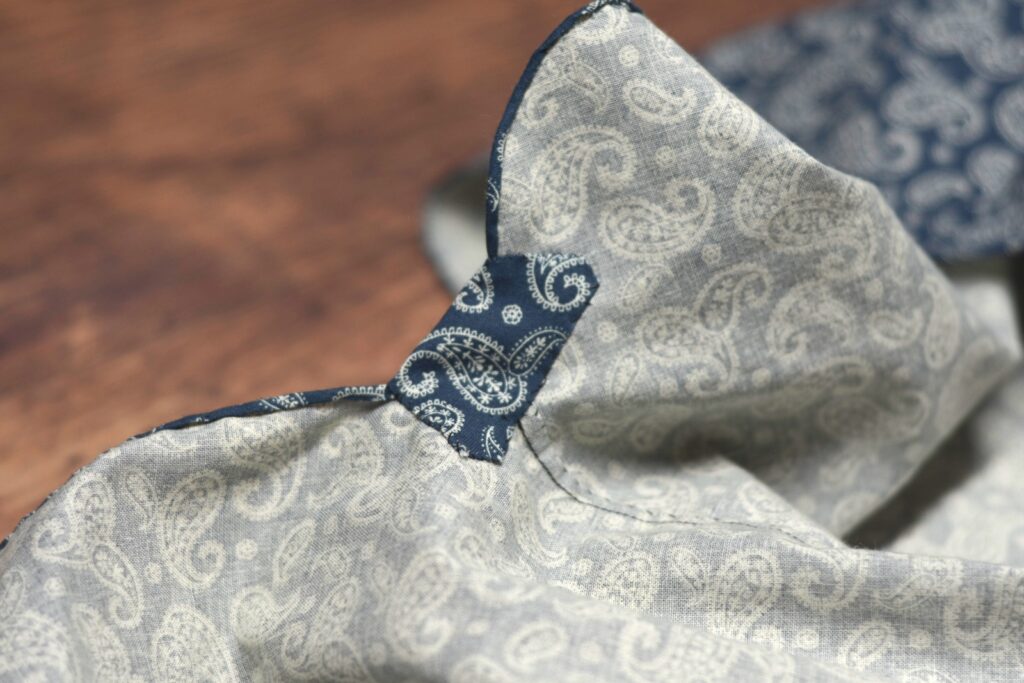
Finally, top stitch the gusset from the outside along the edges through all layers using a back stitch. I sewed across the upper sides of the triangle where the shirt could be felt underneath. Then I sewed across the bottom of the triangle to further keep the layers in place.
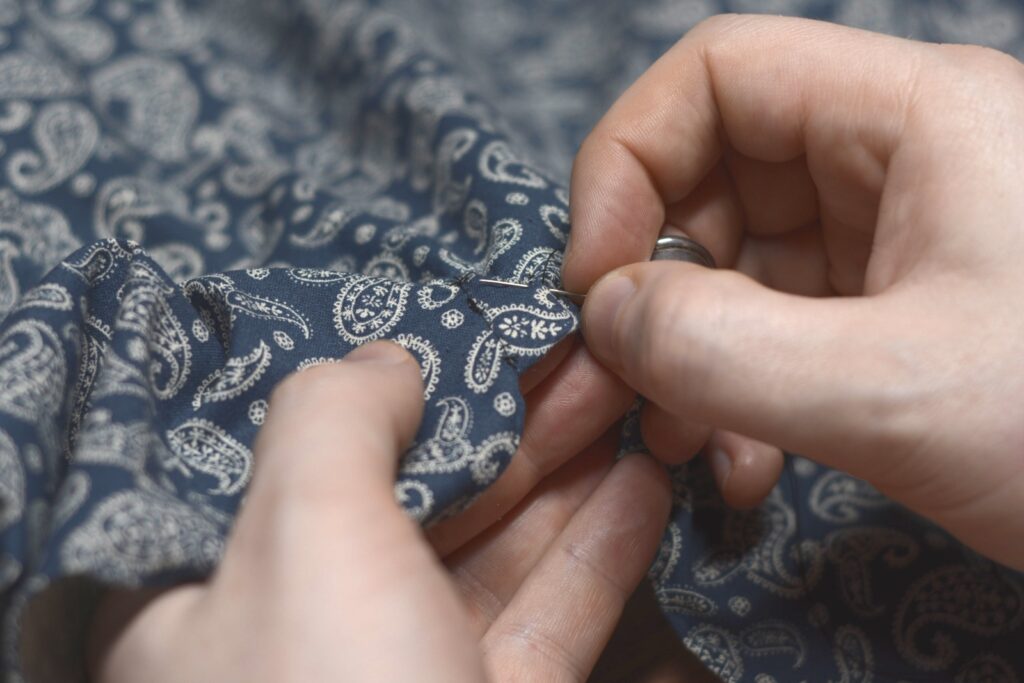
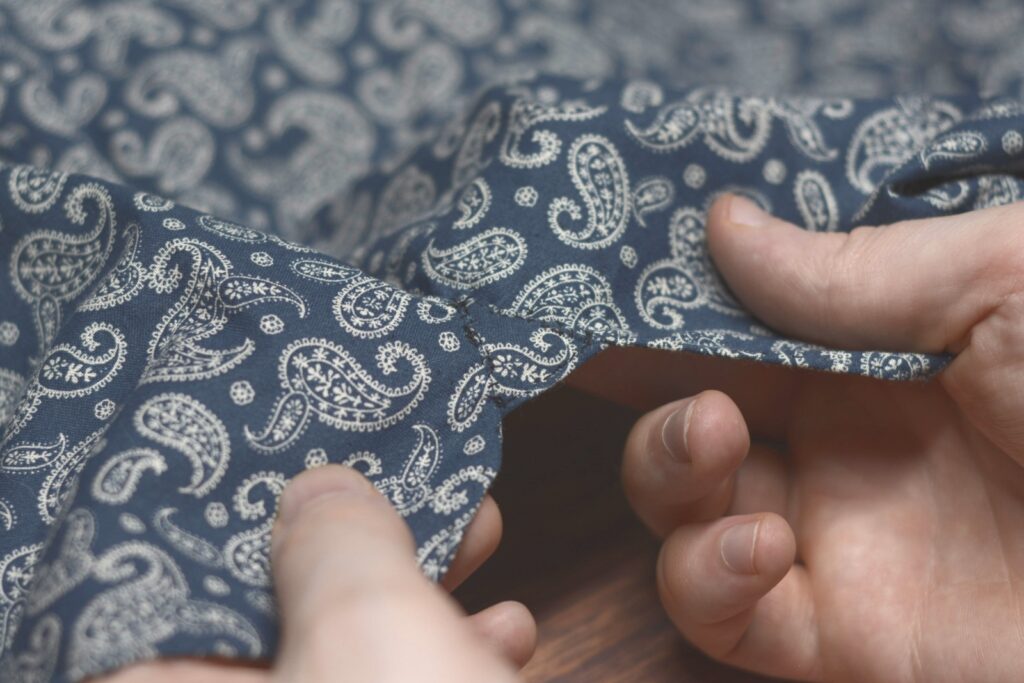
Your Progress
[columns gutter=”0″]
[col]
1 | Draft or print the gusset pattern. | |
2 | Press and attach the side seam gussets. |
[/col]
[col align_text=”center, middle”]
[/col]
[/columns]
Rolled Hem
Shirts of the period were often hemmed with what is known as a rolled hem, a very narrow – 1/8″ or even less – stitch that rolls the fabric back over itself. It can seem intimidating but once you learn how it works, it becomes second nature very quickly.
Begin by trimming the remaining seam allowance near the bottom of the side seam to 1/8″, tapering it into the curve at the bottom.
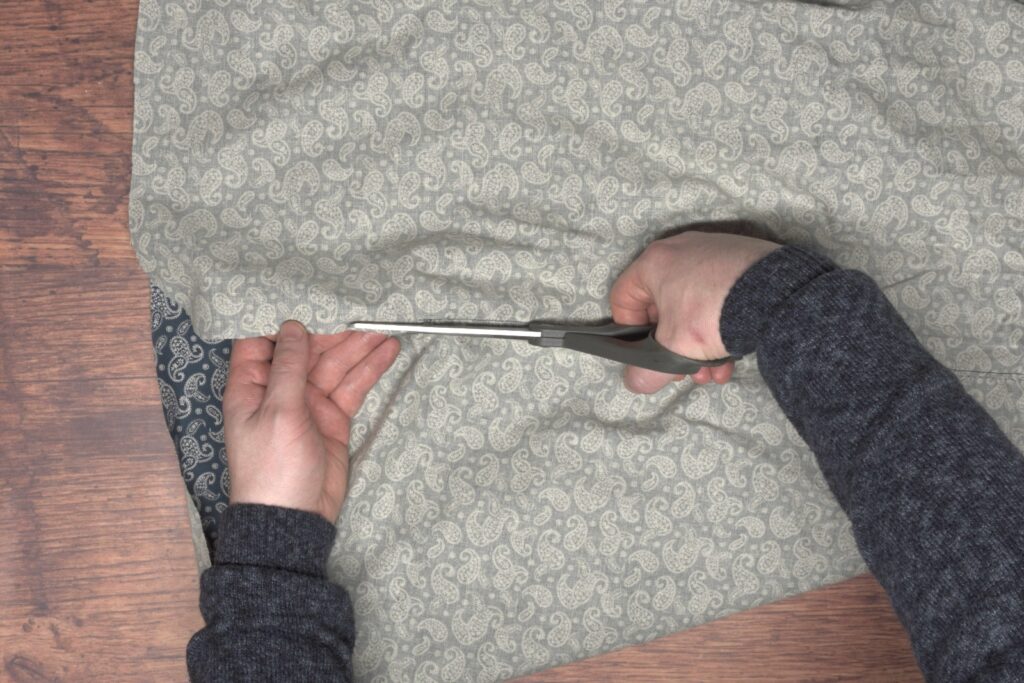
Turn back the raw edge to the wrong side 1/8″ along the entire hem, pressing with your fingernails as you go.
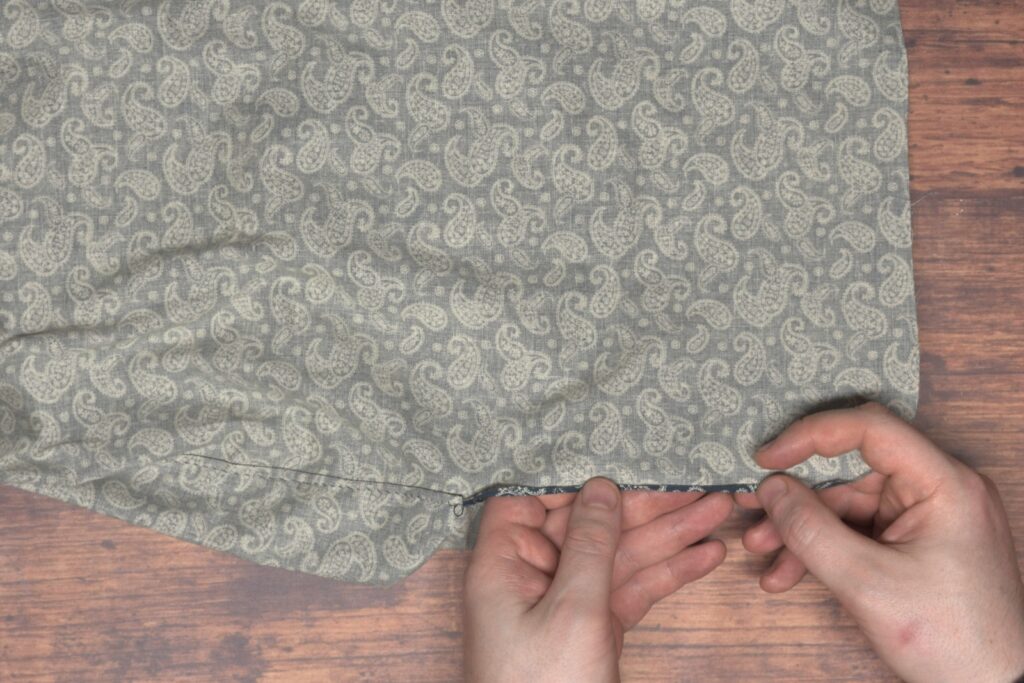
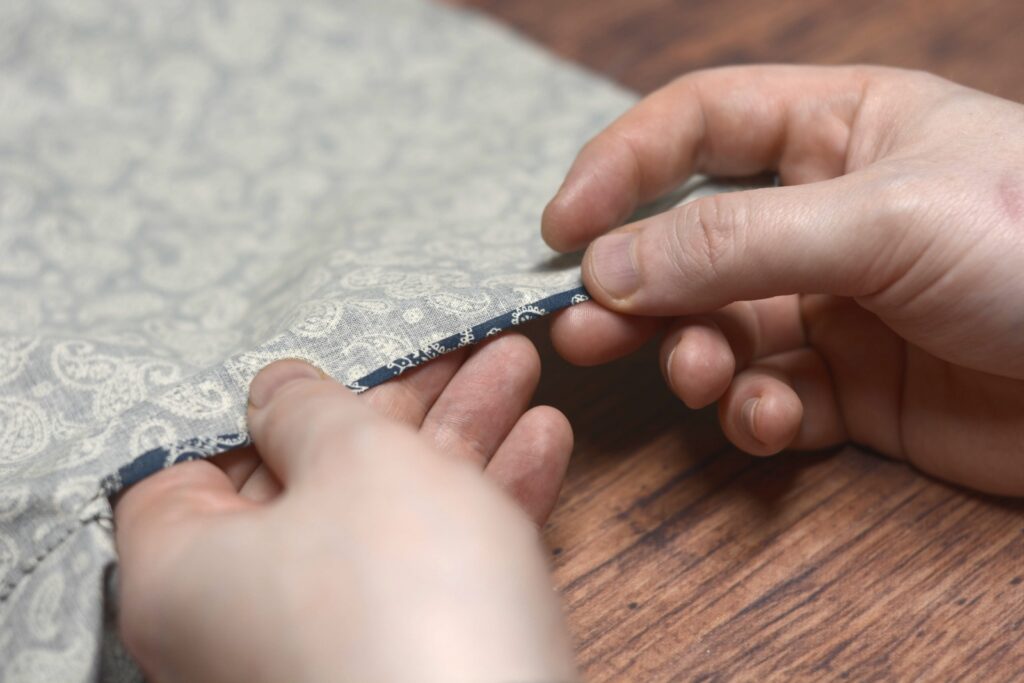
The curved areas can be a little troublesome, just keep working at it, keeping the fold as narrow as possible.
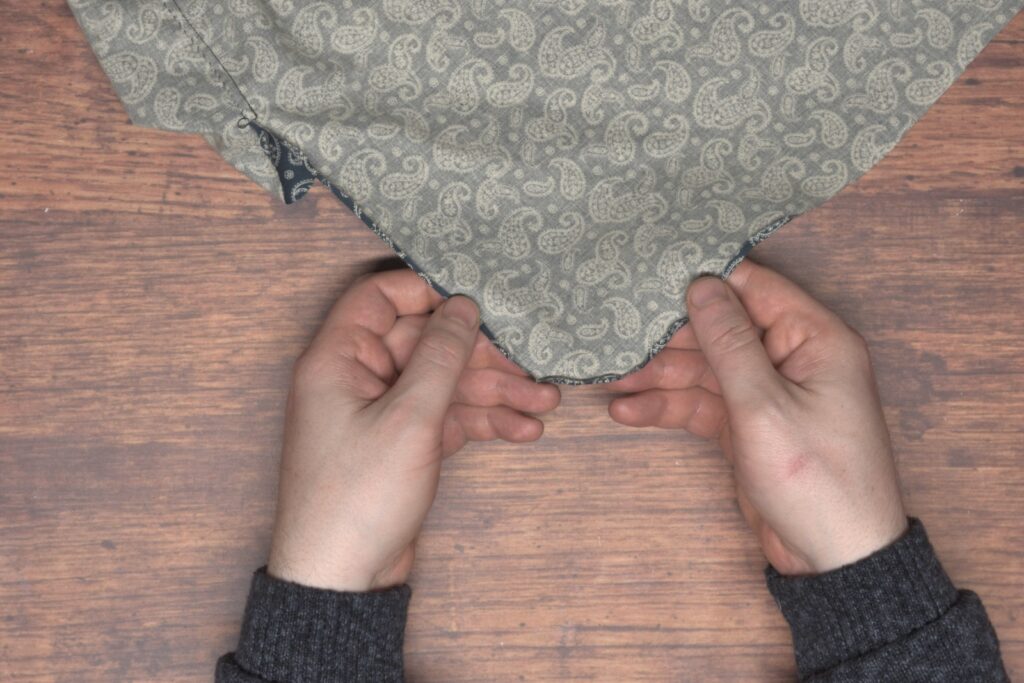
You can press the fold with the iron afterwards to keep everything more firmly in position.
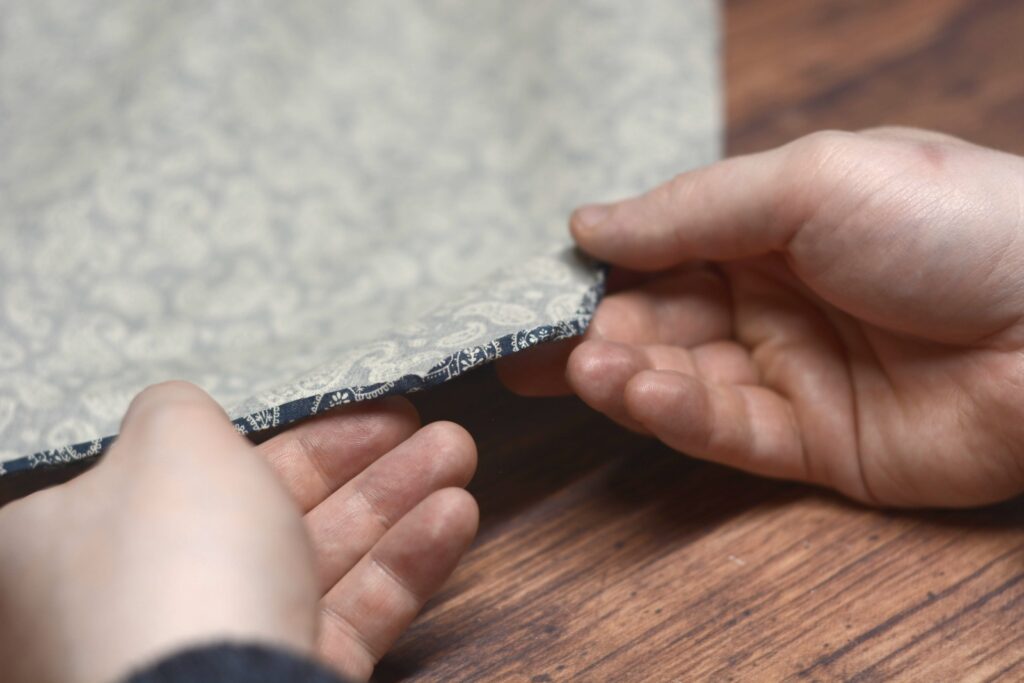
Start the hem stitch about 1/4″ below the bottom of the side seam, allowing us to taper the seam after and keep everything flat. Begin with three stitches in place on the fabric, just past the raw edge of the fold.
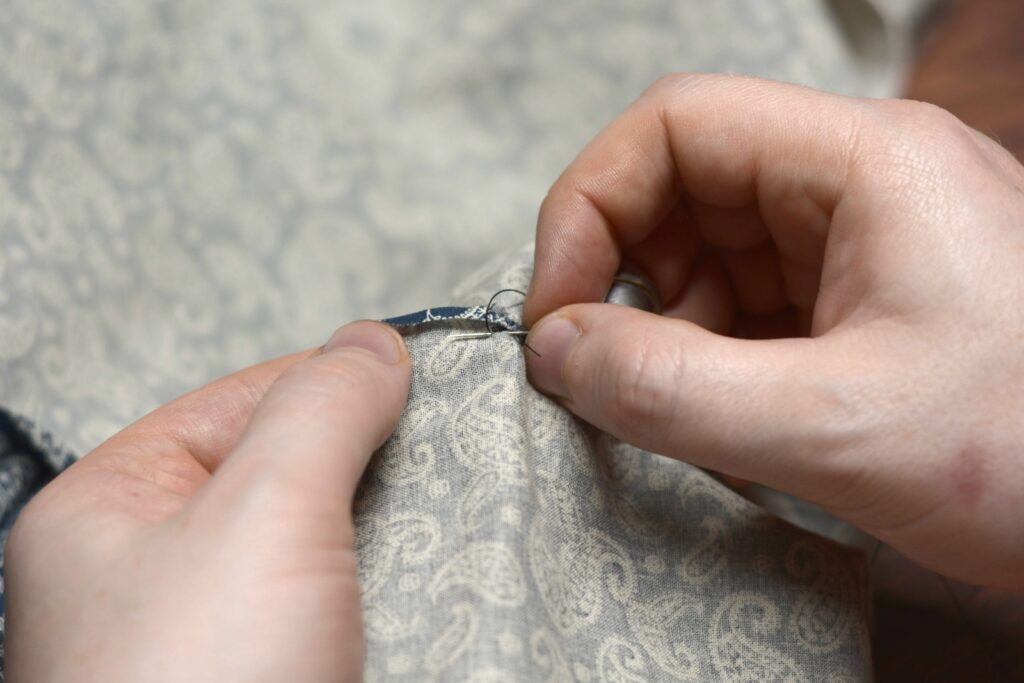
Take a small running stitch directly across from the end of the previous stitch, catching only the fold.
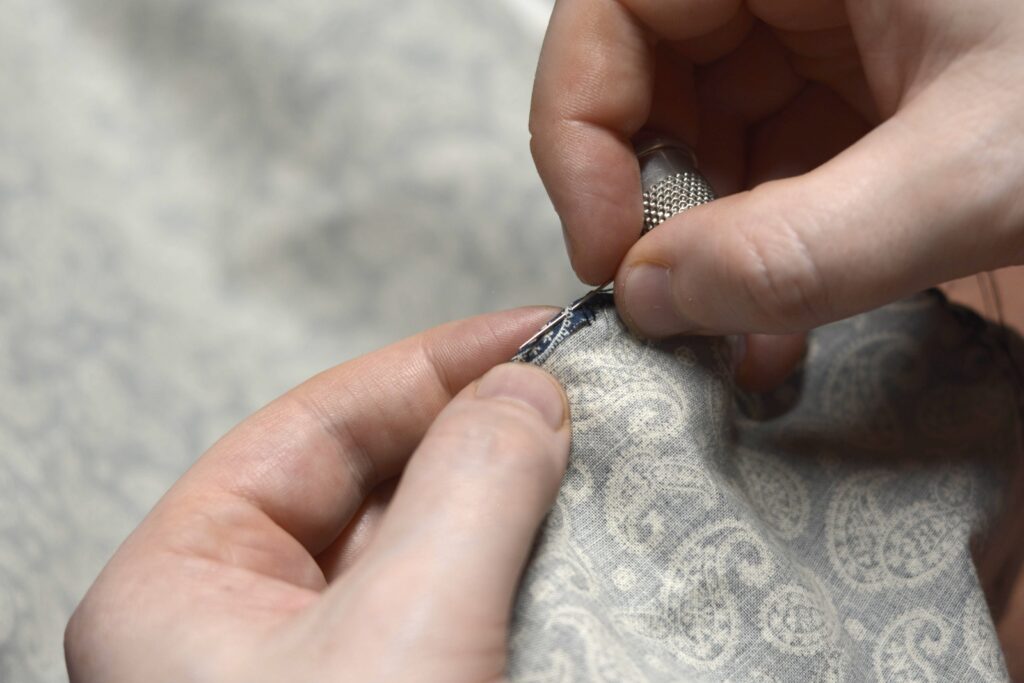
Then take another small running stitch just below the raw edge, directly under the end of the previous stitch. Don’t pull the stitches taught yet.
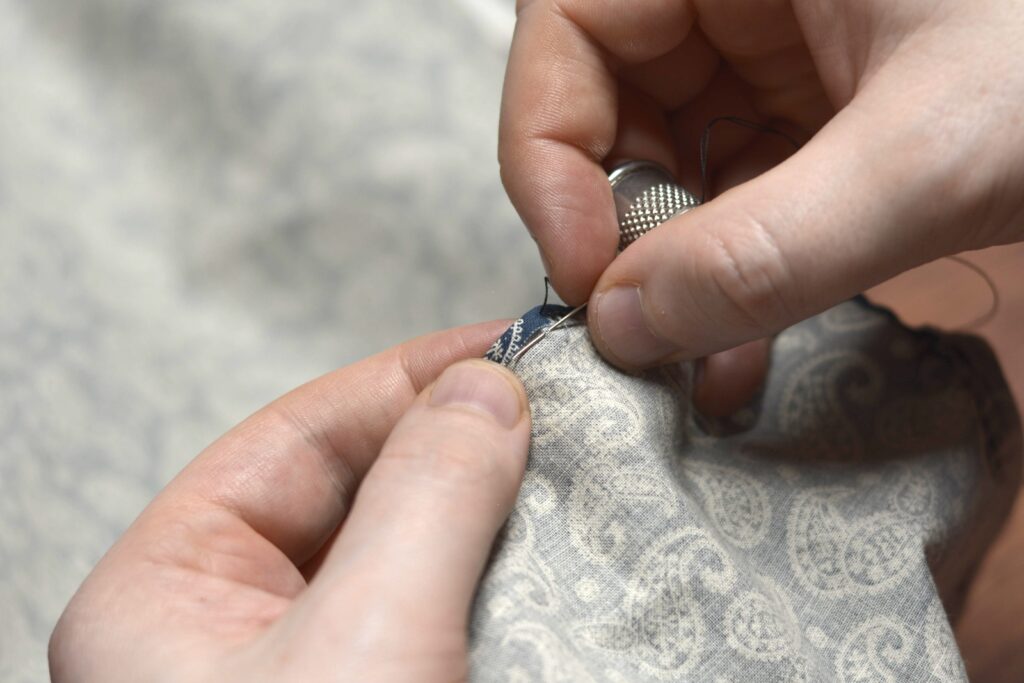
Continue working stitches until you have an inch or so of progress.
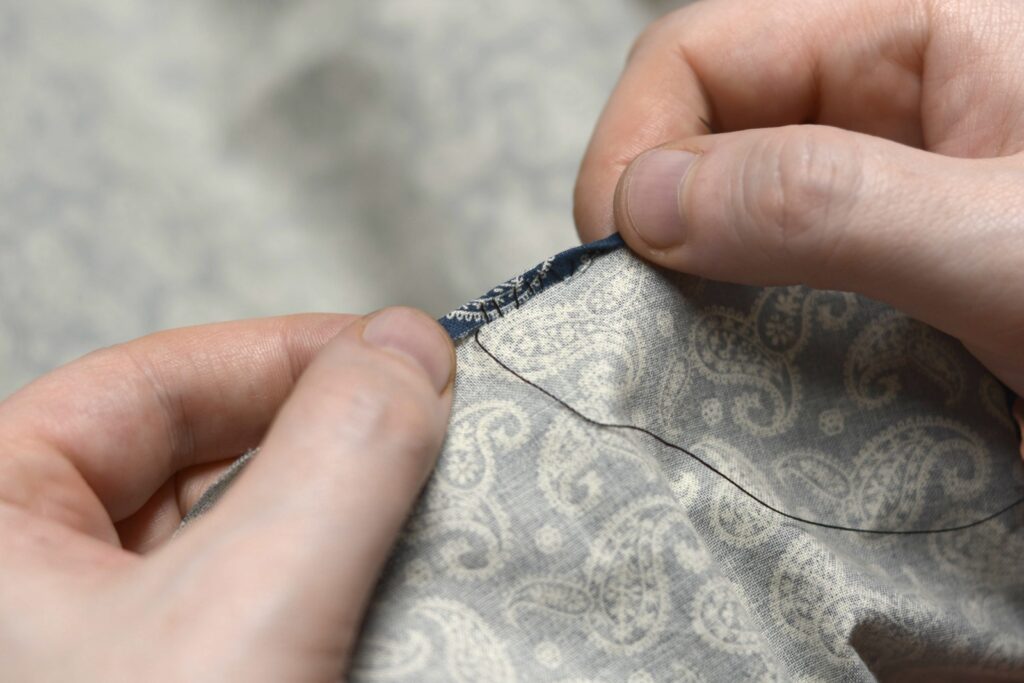
After sewing about an inch, gently pull on your thread, tightening up the stitches you just made. The folded edge should begin to roll over itself, forming the rolled seam. Don’t pull too tight, or you’ll begin to pucker the fabric. You can make up to about 2″ worth of stitches before pulling, though the tension on the thread does get a little higher and you risk breaking the thread.
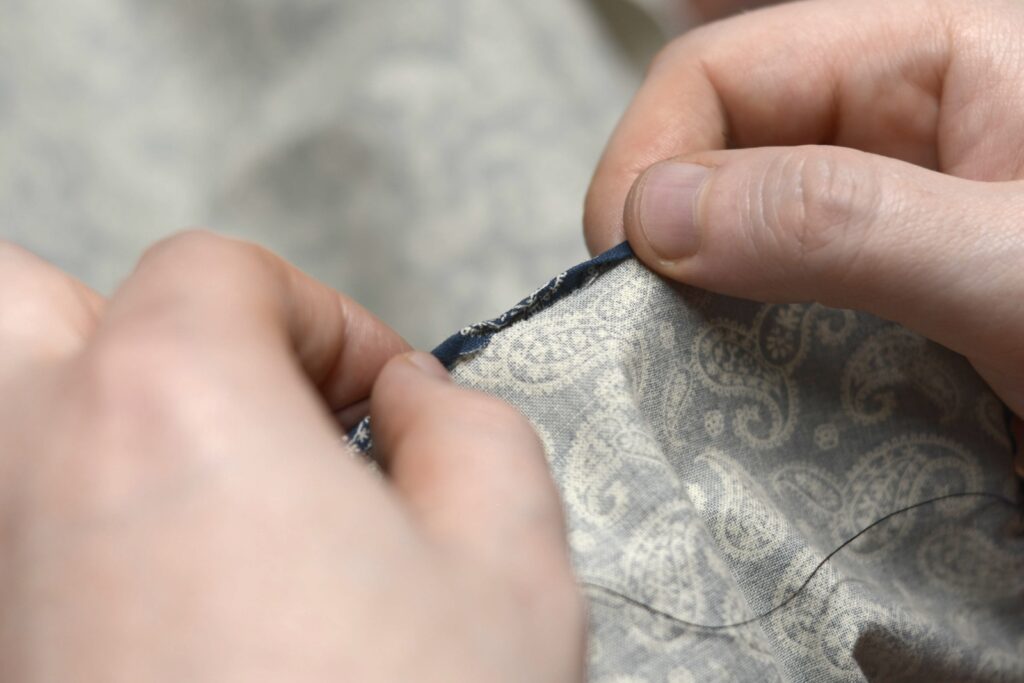
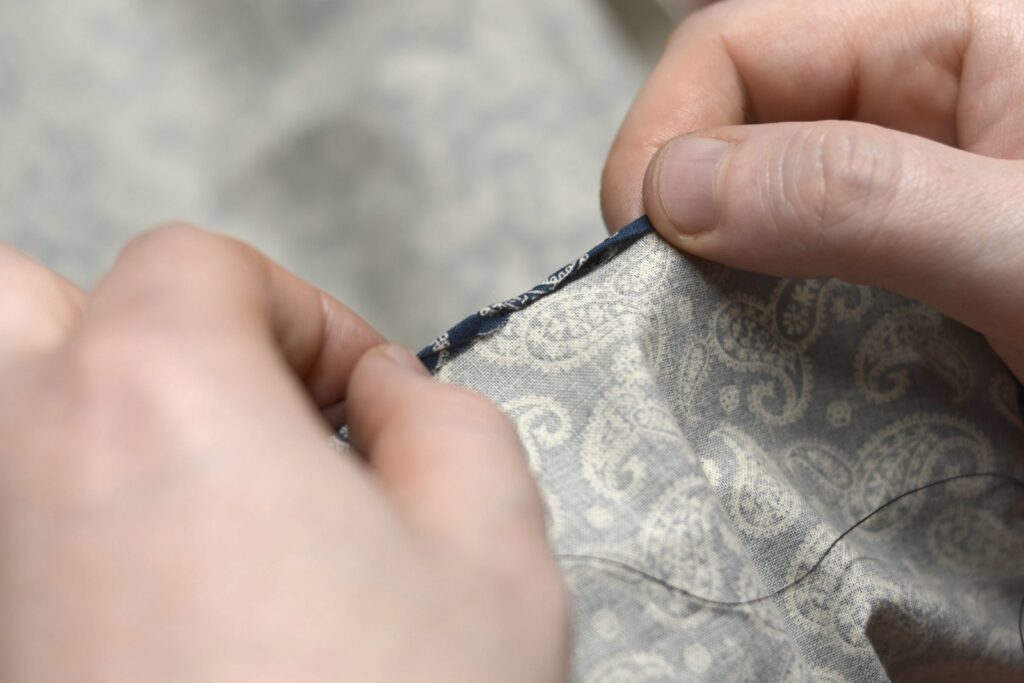
Here are the results so far. Continue stitching across the entirety of the hem to within 1/4″ from the bottom of the other side seam.
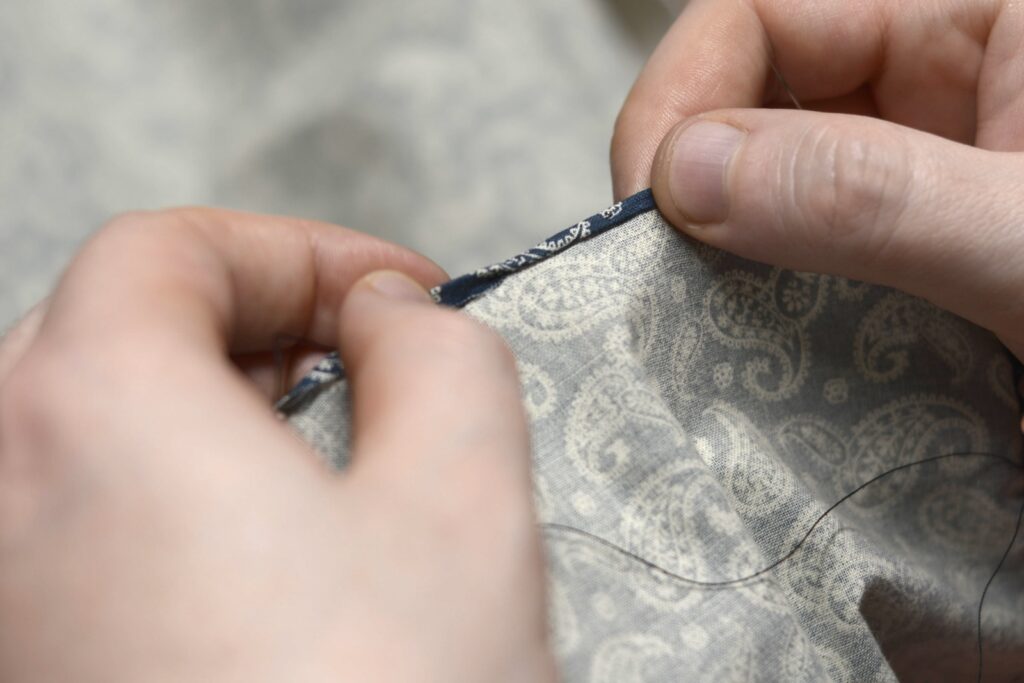
On the right side, you should have a crisp edge, and a row of small running stitches showing about 1/16″ from the edge.
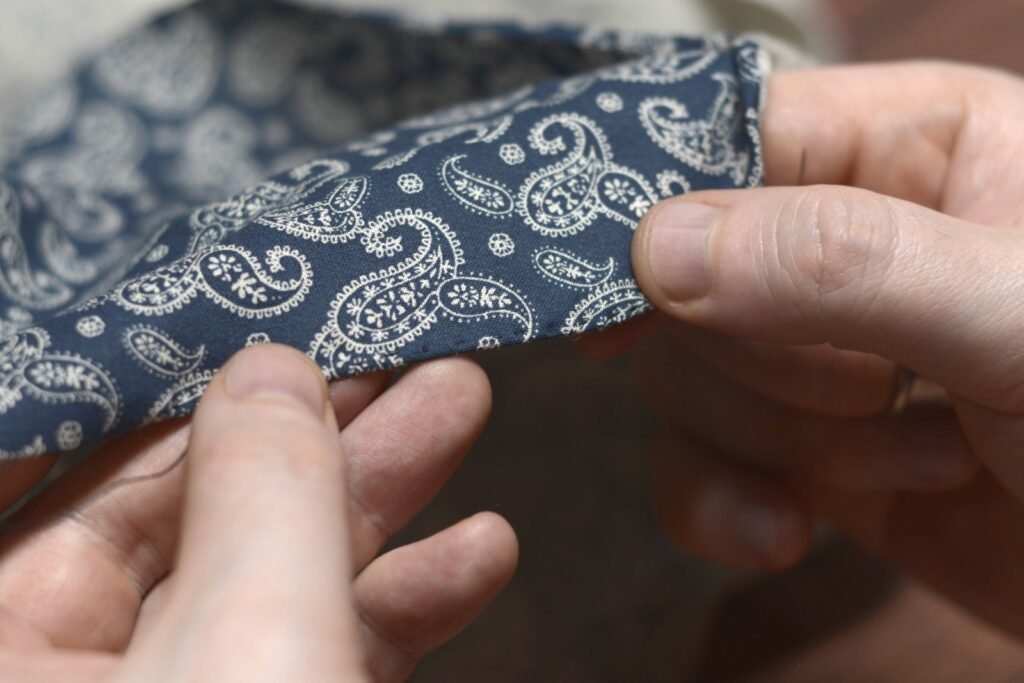
Here’s the completed hem.
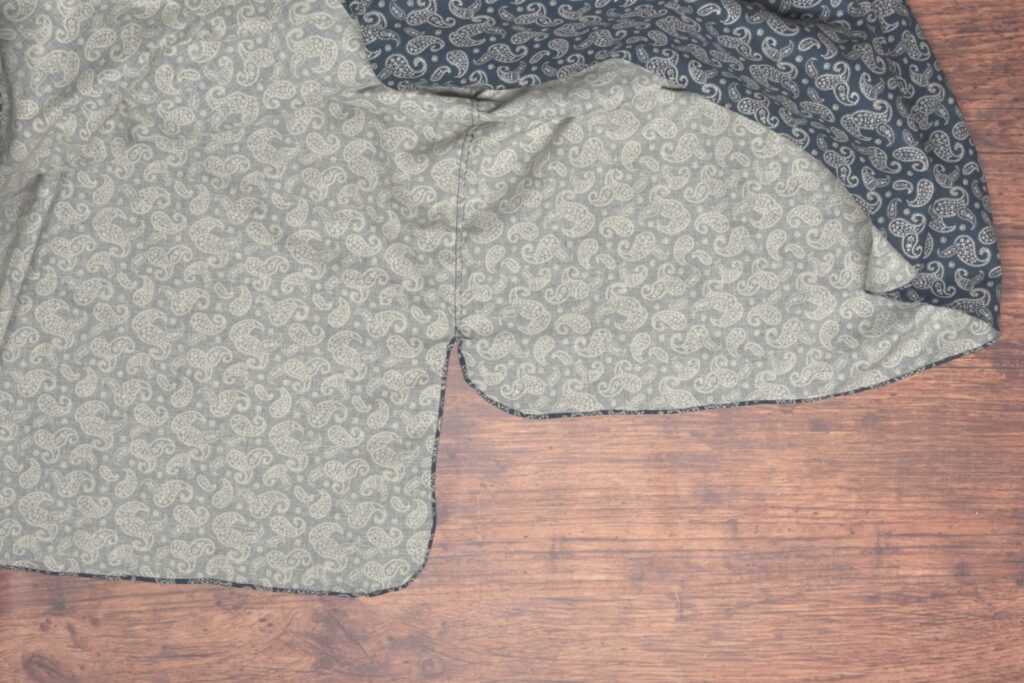
At the bottom of the side seam, I kept the stitching about 1/4″ from the bottom, to allow the hems to taper gently out of the roll, giving a flatter edge. This also avoids having to deal with 1/16″ or 1/32″ seam allowances trying to get everything lined up perfectly with the rolled edge.
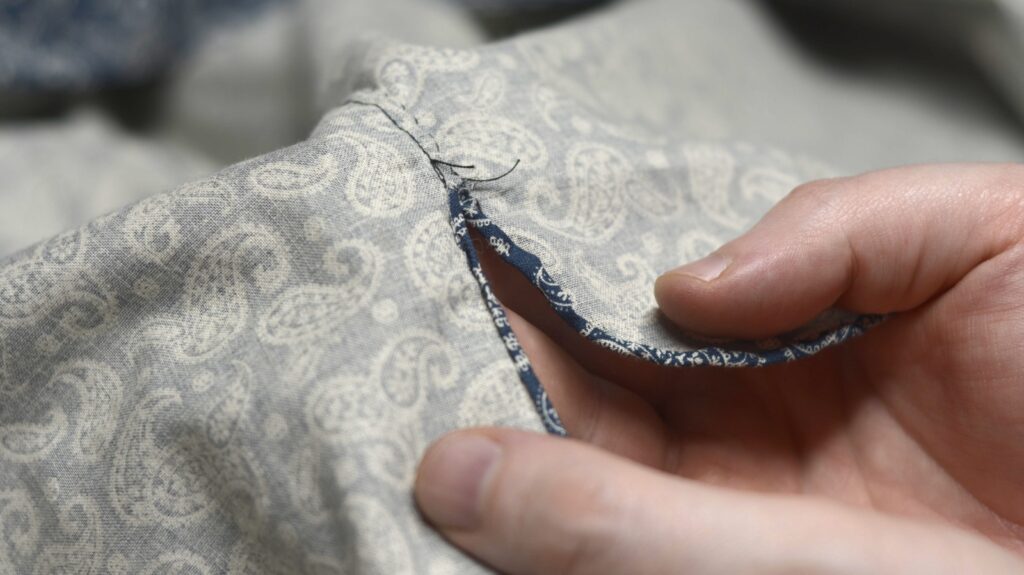
Everything should be as flat as possible near the bottom of the side seams, no puckering or anything.
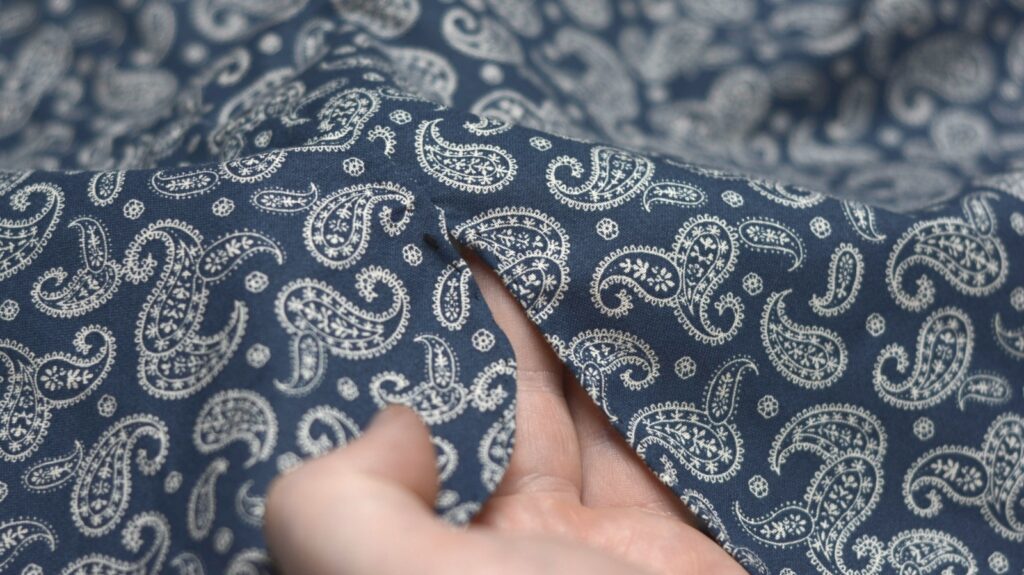
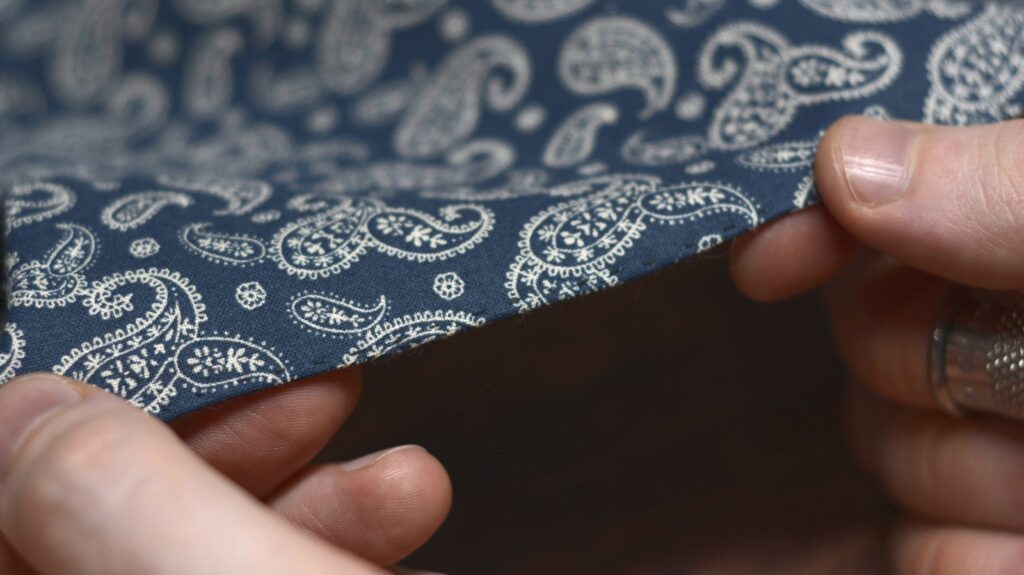
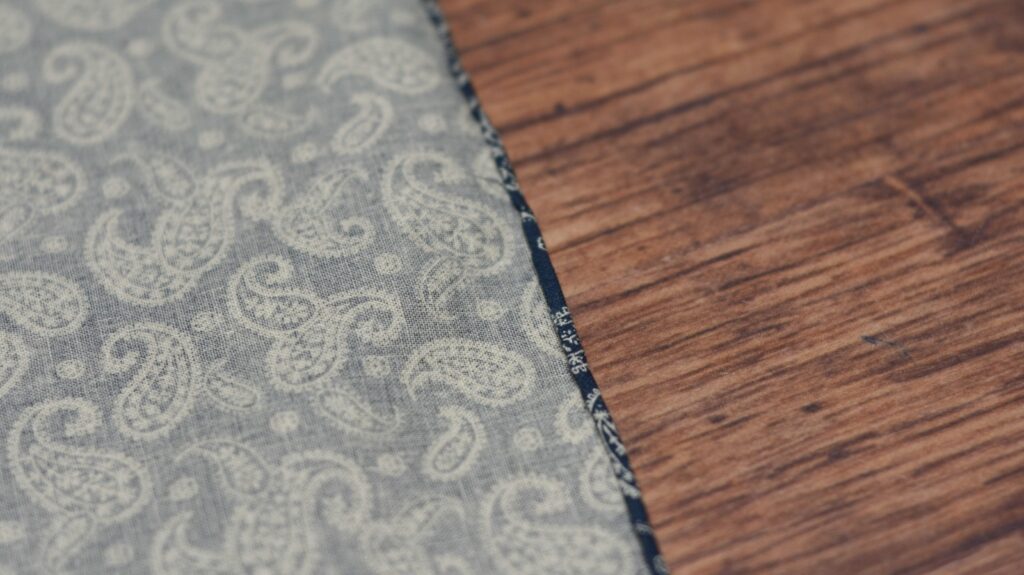
Your Progress
[columns gutter=”0″]
[col]
1 | Form and stitch the rolled hem. |
[/col]
[col align_text=”center, middle”]
[/col]
[/columns]
Felling the Lining
With the side seam felled, we can begin closing up the lining permanently with a felling stitch. Begin by folding under the remaining raw edge of the front lining just below the armscye, along the side seam. Baste.
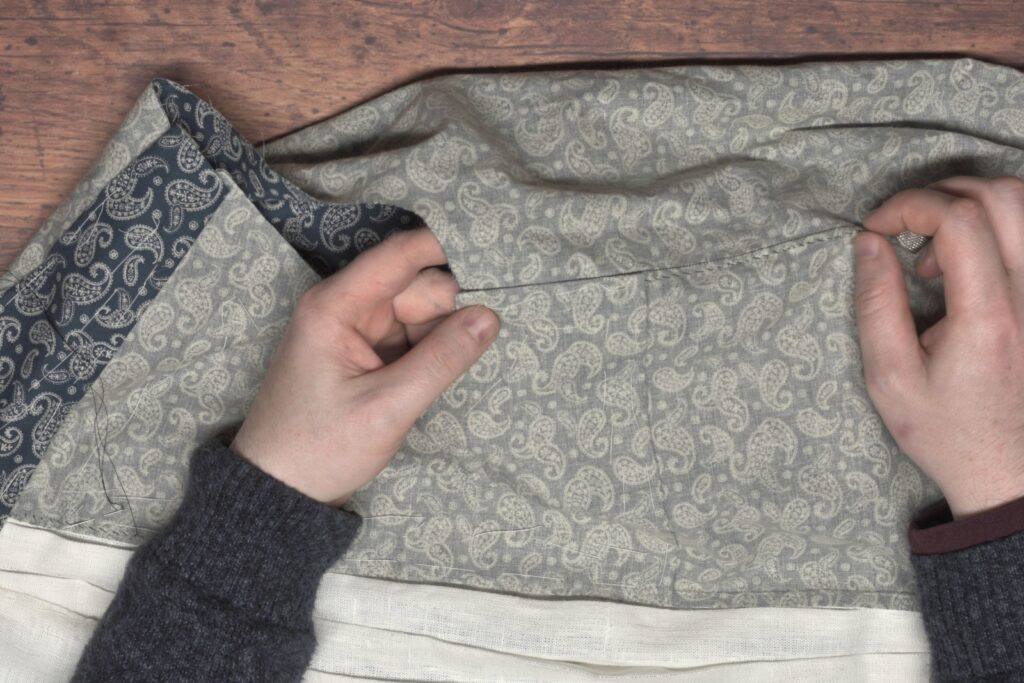
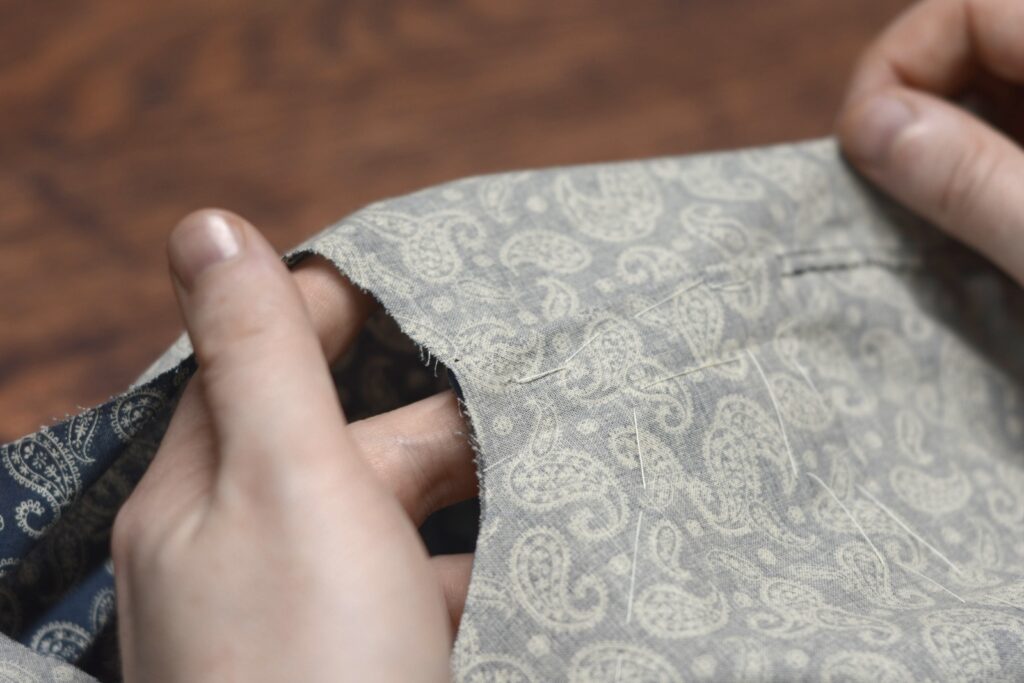
Begin felling the lining down with a small stitch, 10+ per inch, though it really depends upon the size of your thread and the fabric how small you can go. Catch only a couple of threads on the right side. Work from shoulder seam, across the bottom, and along the side, or the other way around as works best for you.

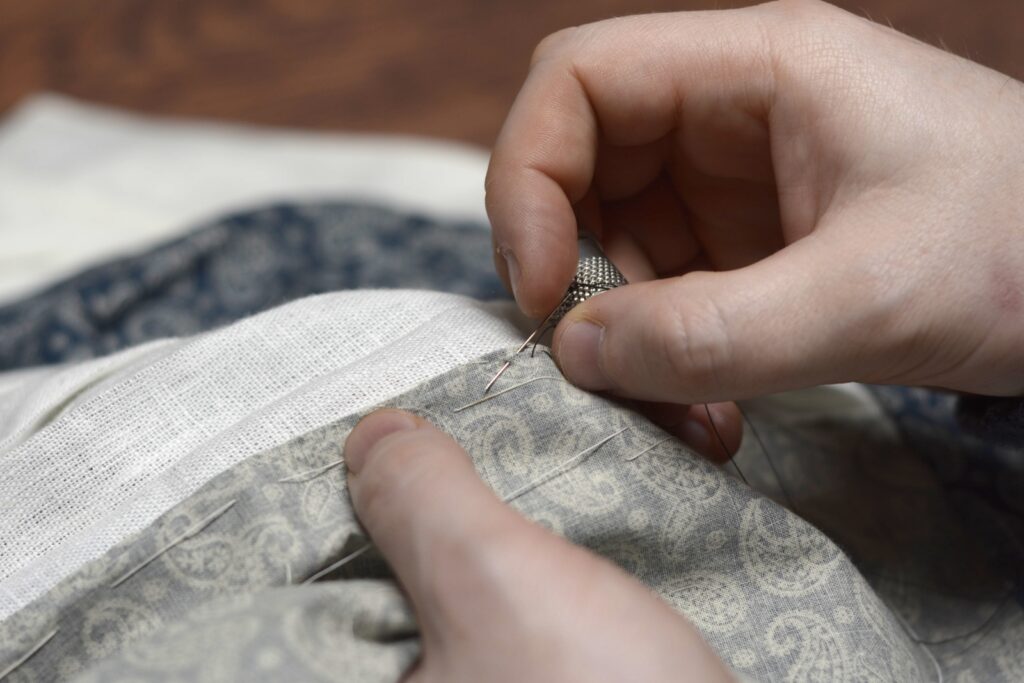
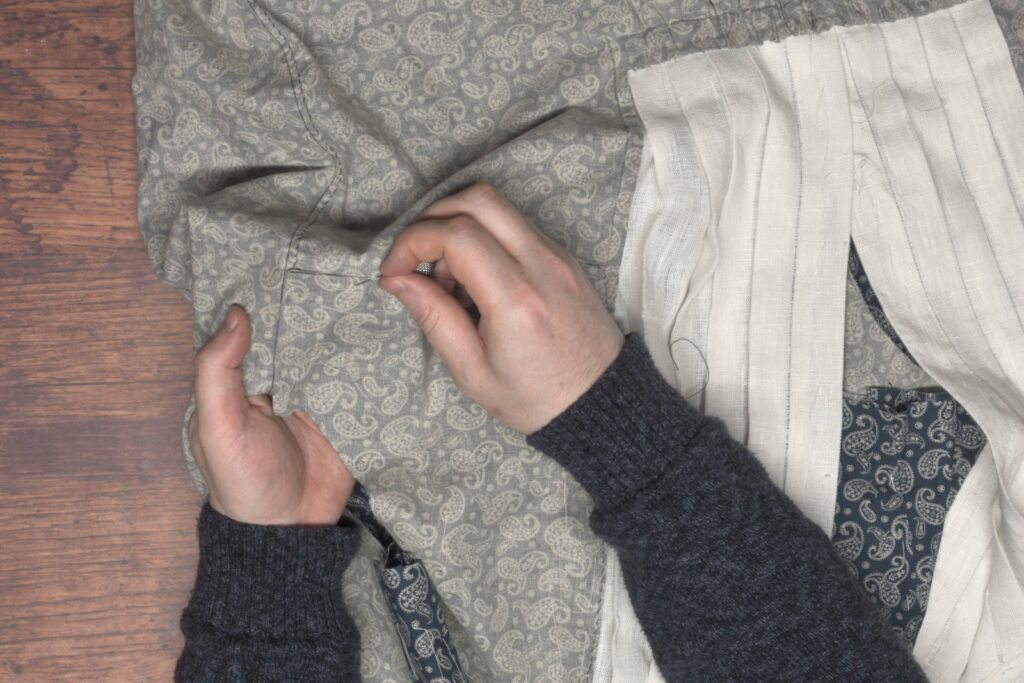
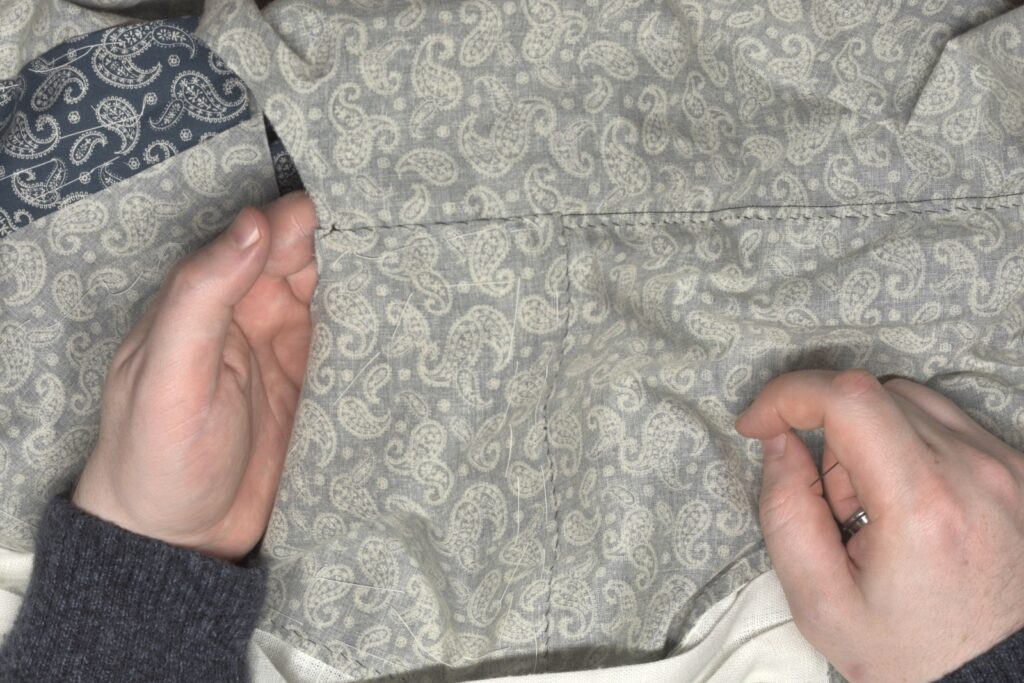
One half of the front lining felled in place. I ended up taking larger stitches than I should have due to the new thread I was testing. I ordered a slightly heavier weight accidentally, and going any smaller with the stitches would have made the seam too bulky.
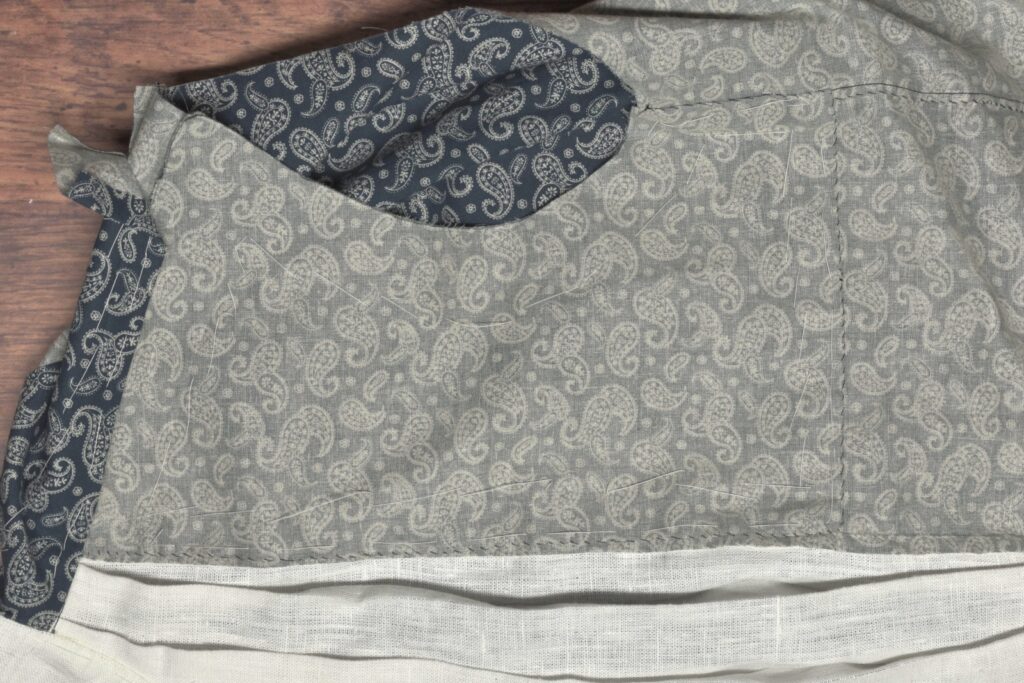
Now turning to the back of the shirt, fell the yoke along the shoulder seams.
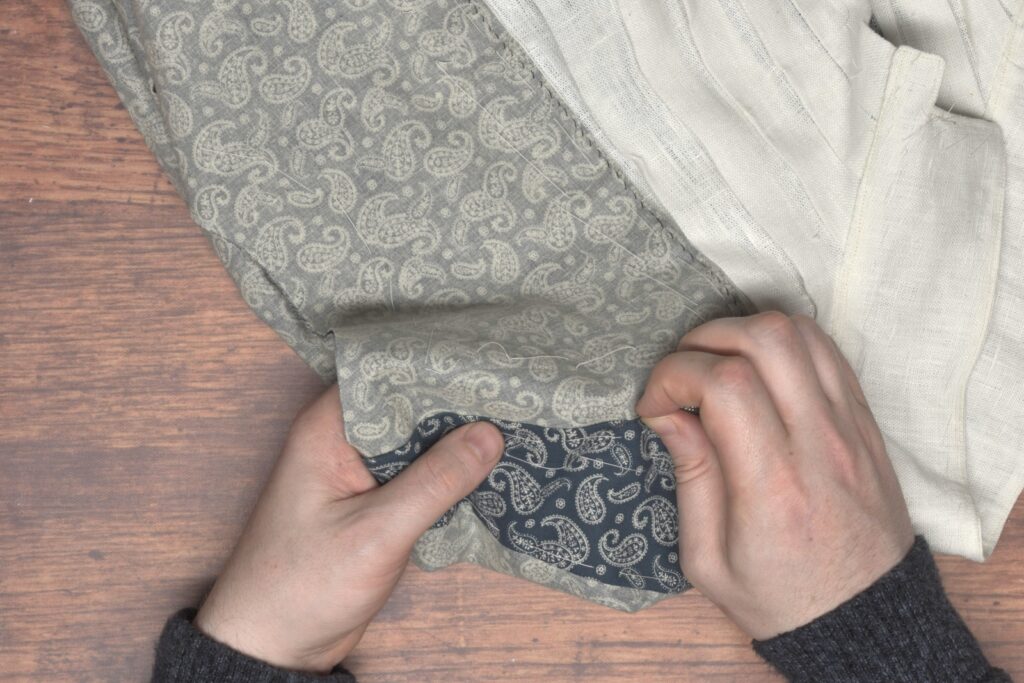
Take extra care along the shoulder seam near the pleated front, that your stitches don’t show through on the right side.

Fell also across the bottom of the yoke, across the width of the shirt.
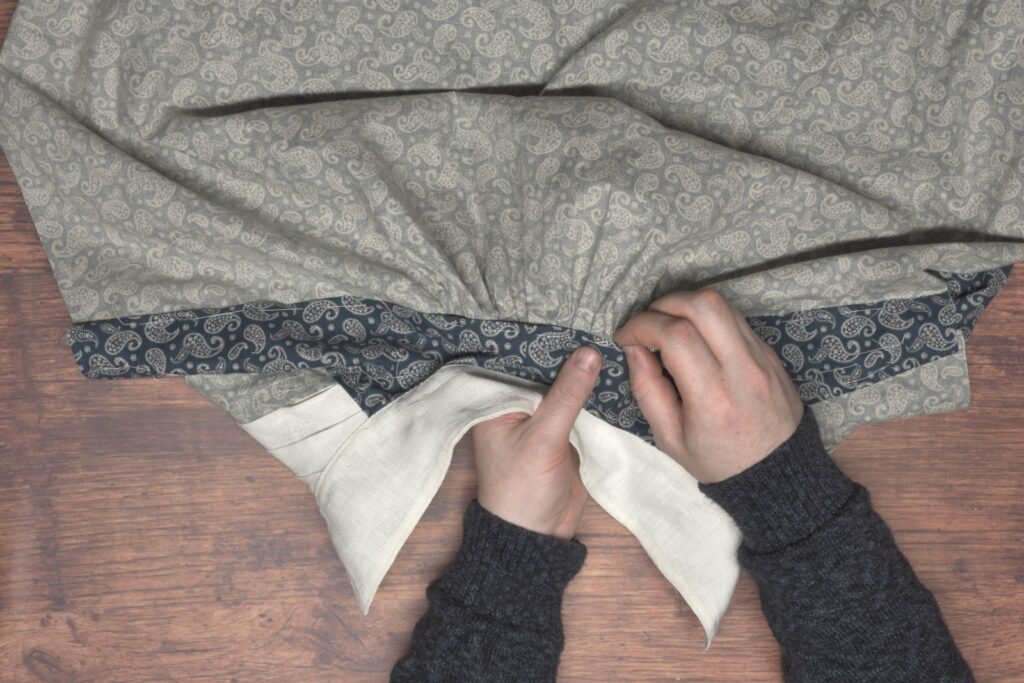
Finally, top stitch the yoke through all layers across the shoulder seams and across the lower seam using a small back stitch. This secures everything more firmly in place and helps prevent shifting of the layers over time.
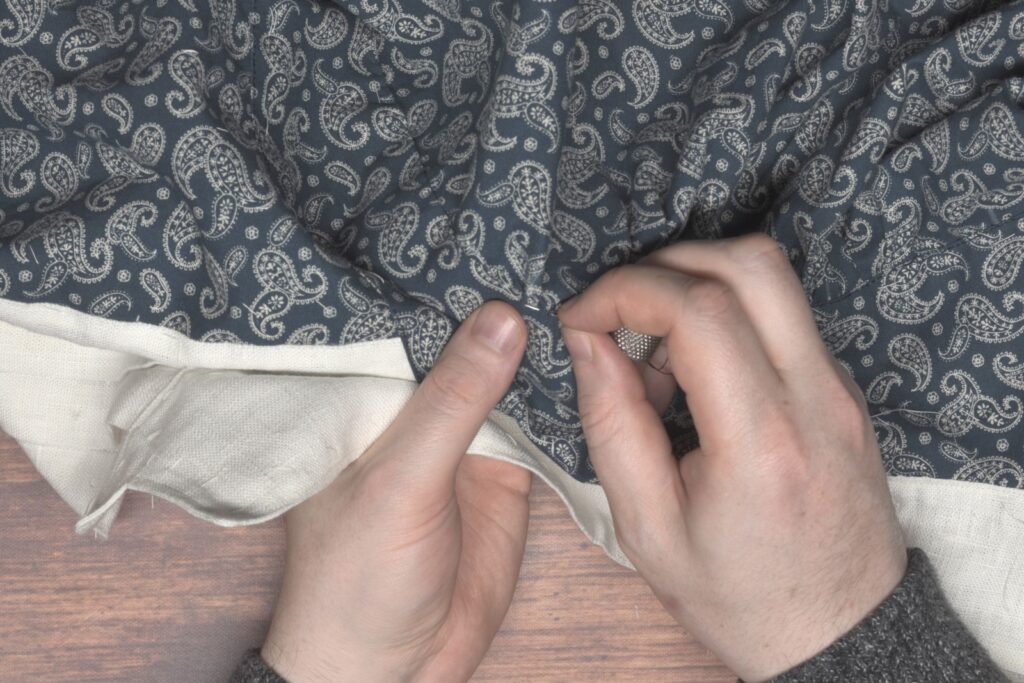
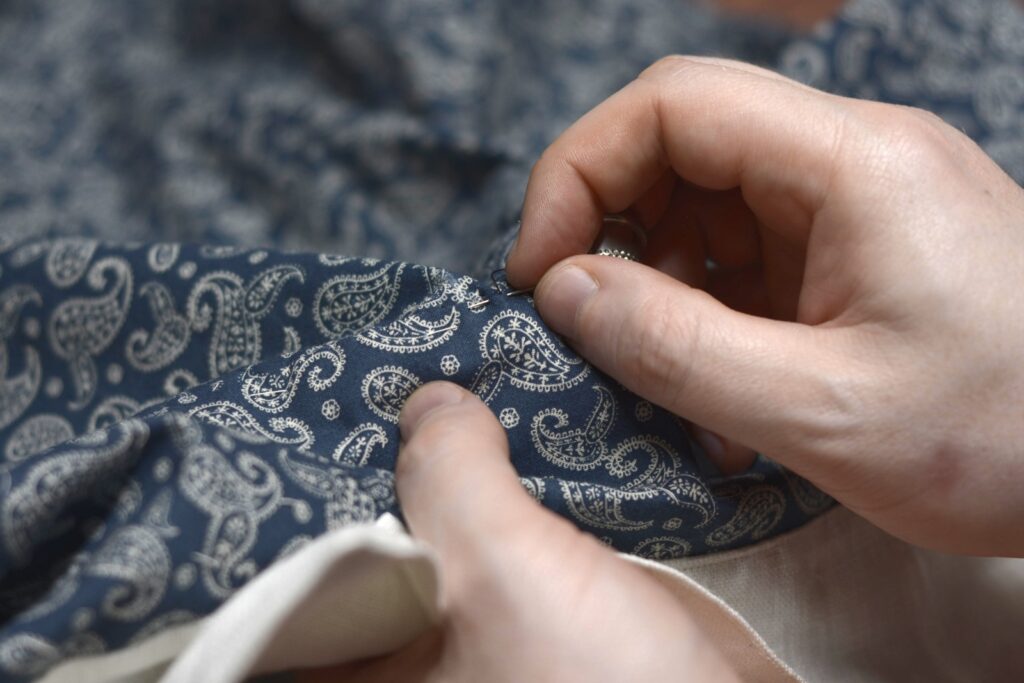
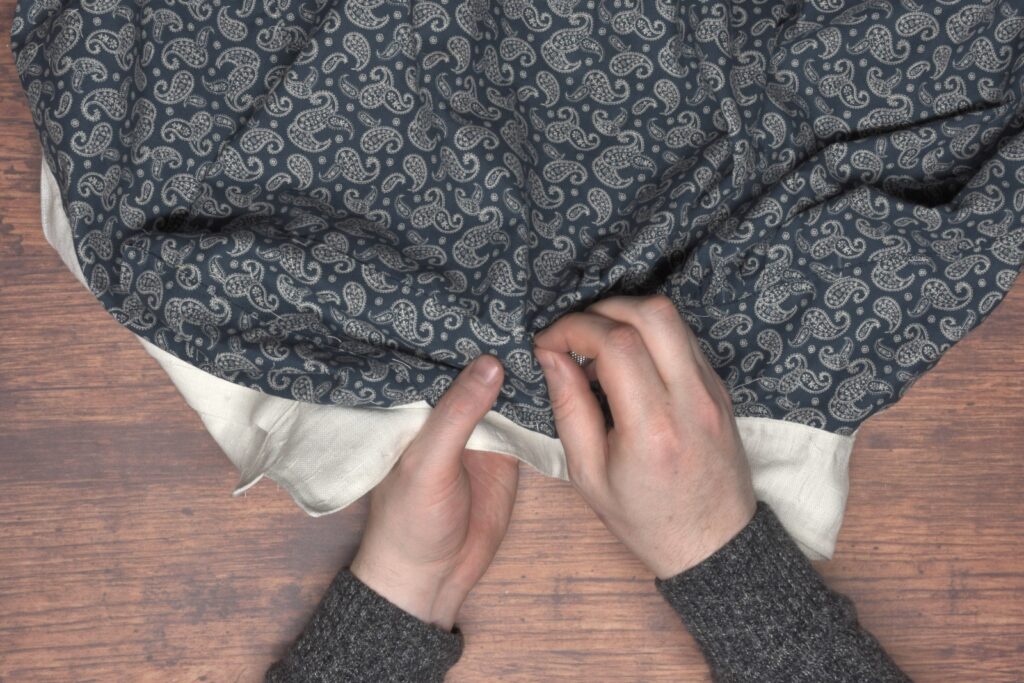
Your Progress
[columns gutter=”0″]
[col]
1 | Fell the front lining. | |
2 | Fell the back lining. | |
3 | Top stitch the yoke. |
[/col]
[col align_text=”center, middle”]
[/col]
[/columns]
Felling the Side Seams
Before moving on to more interesting areas such as the sleeves, there are a few details to take care of in the shirt body, beginning with felling the side seams.
Shirts of the period usually had very small seam allowances – 1/8″ or even less. If you are a beginner or new to shirt making, I’d recommend leaving the full 1/2″ seam, giving you a 1/4″ finished seam, otherwise, I’ll be demonstrating a 1/8″ seam.
Begin by trimming the side seam allowance to 1/4″ from the armscye to the bottom. I don’t measure this at all, just do it by eye.
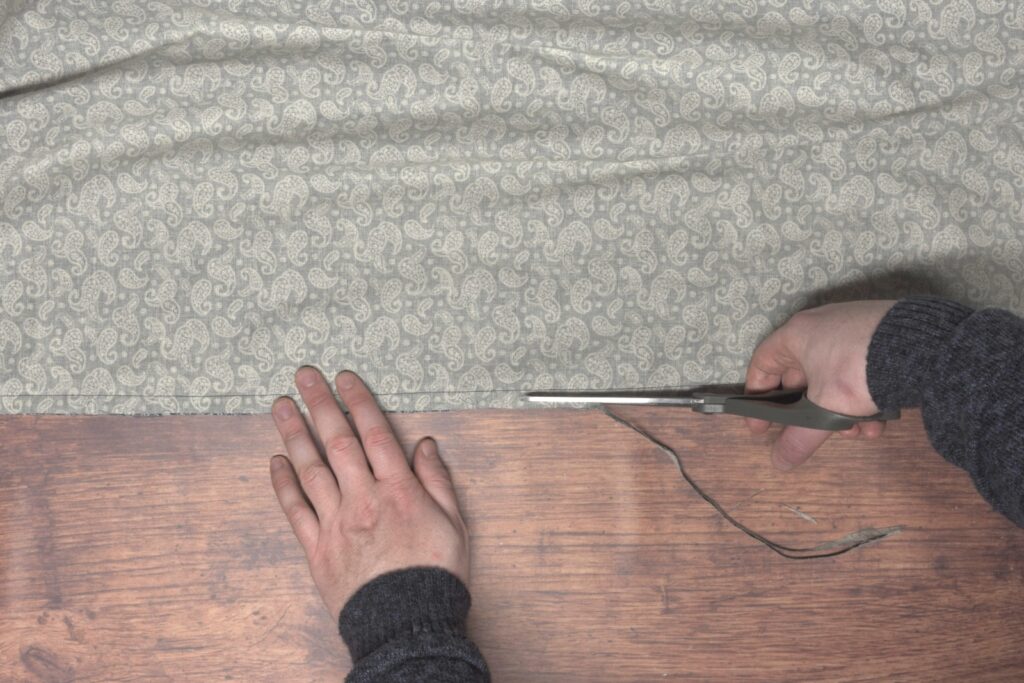

As you get to the curved areas at the bottom, just taper the cut into the existing curves.

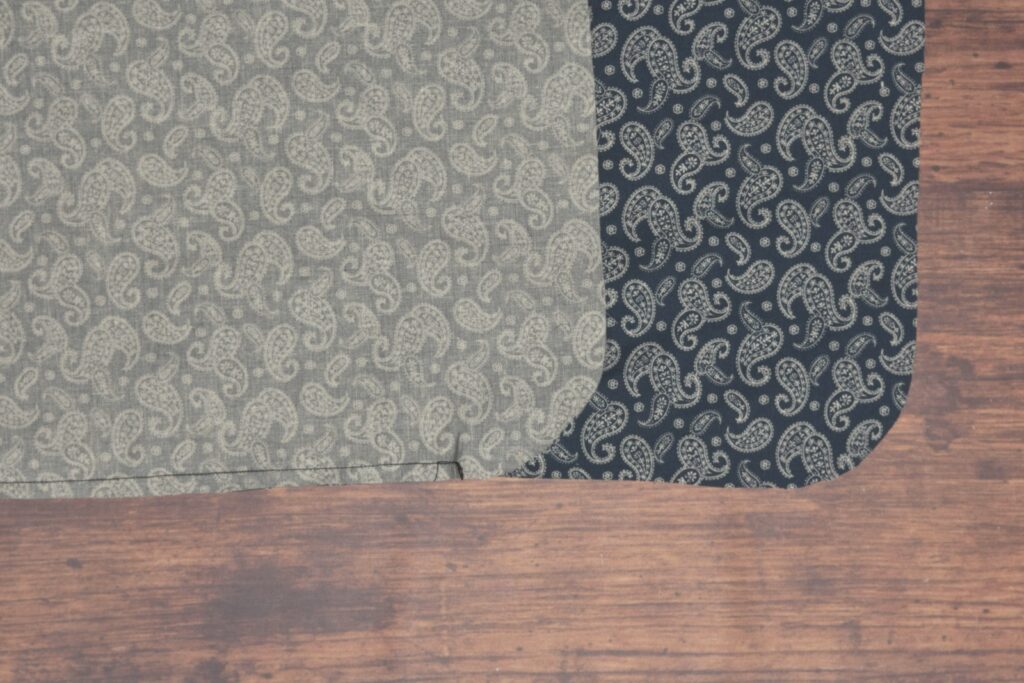
Now carefully trim one of the seams back to 1/8″. I chose to trim the front seam allowance but it doesn’t really matter as long as you’re consistent between the two seams. Try to cut as evenly as you can. At the bottom edge you’ll have to taper it into the curve again.
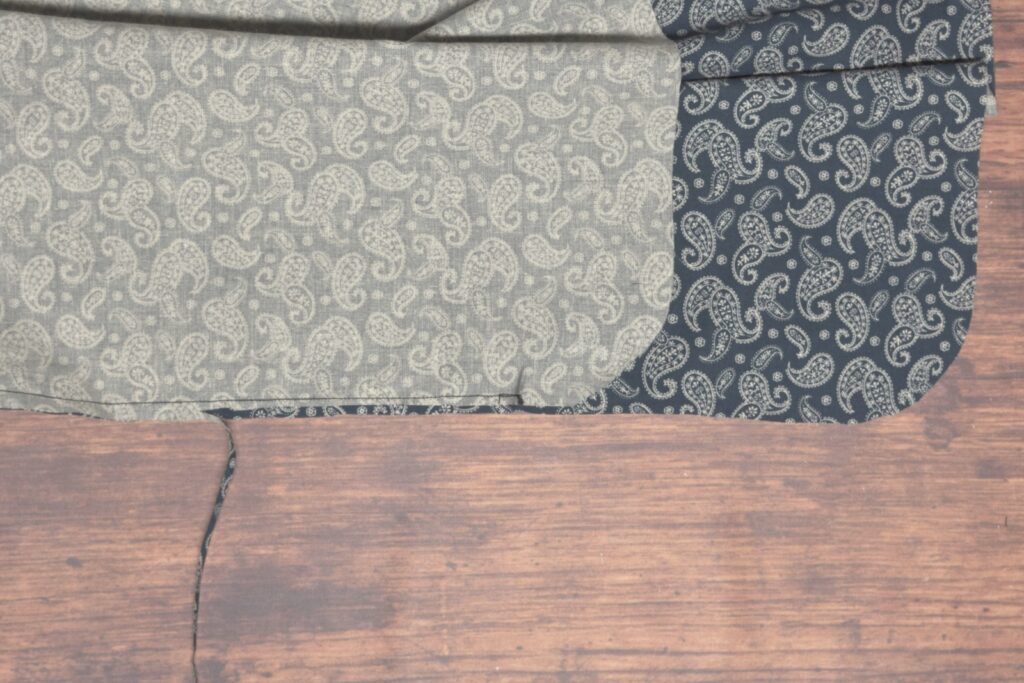
Trim all the way to the armscye. Also be sure to keep the front lining folded or pinned out of the way.

On the back or other half of the seam, snip the seam allowance at the bottom of the seam just to the stitching.
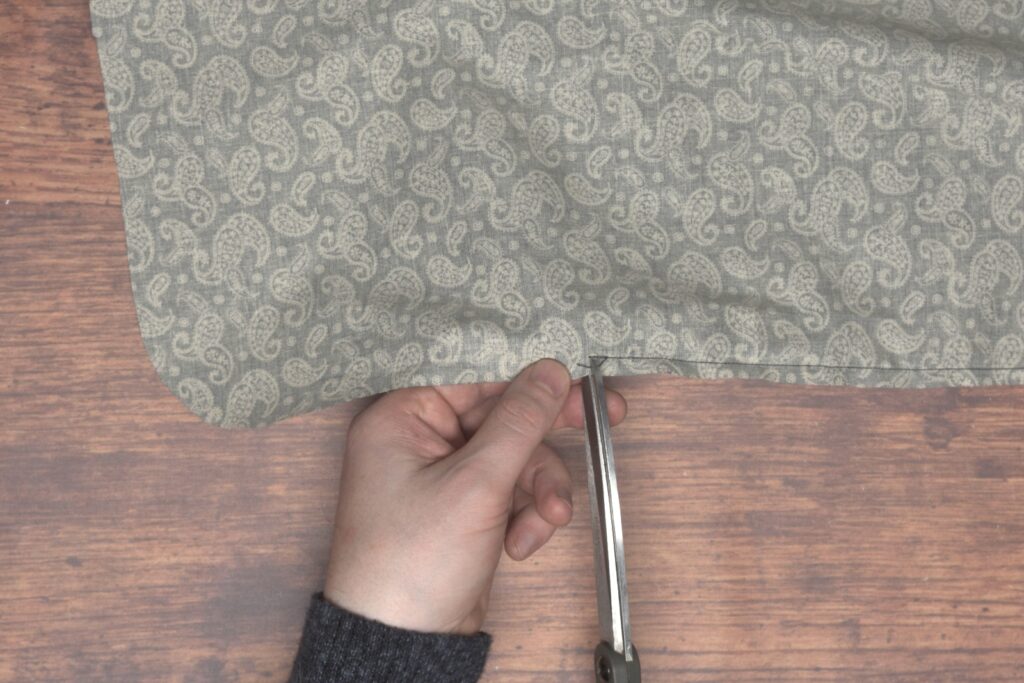
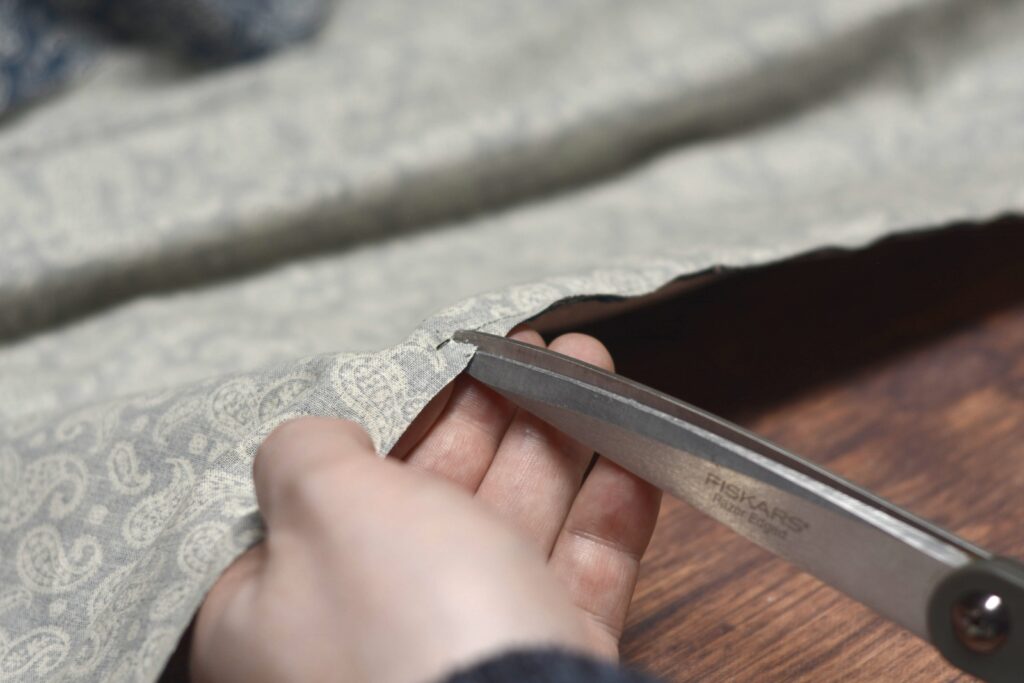
This frees the seam allowance to be manipulated more easily.

Lay the side seam on the pressing table and insert a sleeve roll under the seam to make pressing easier. Press the seam towards the front, or the 1/4″ seam over the 1/8″ seam.
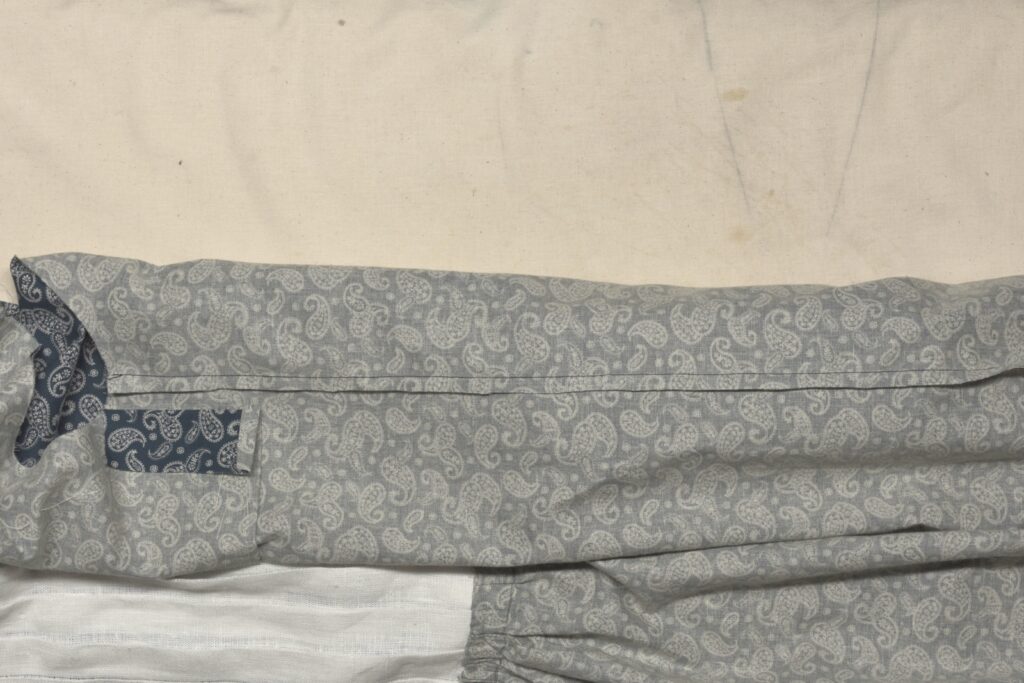

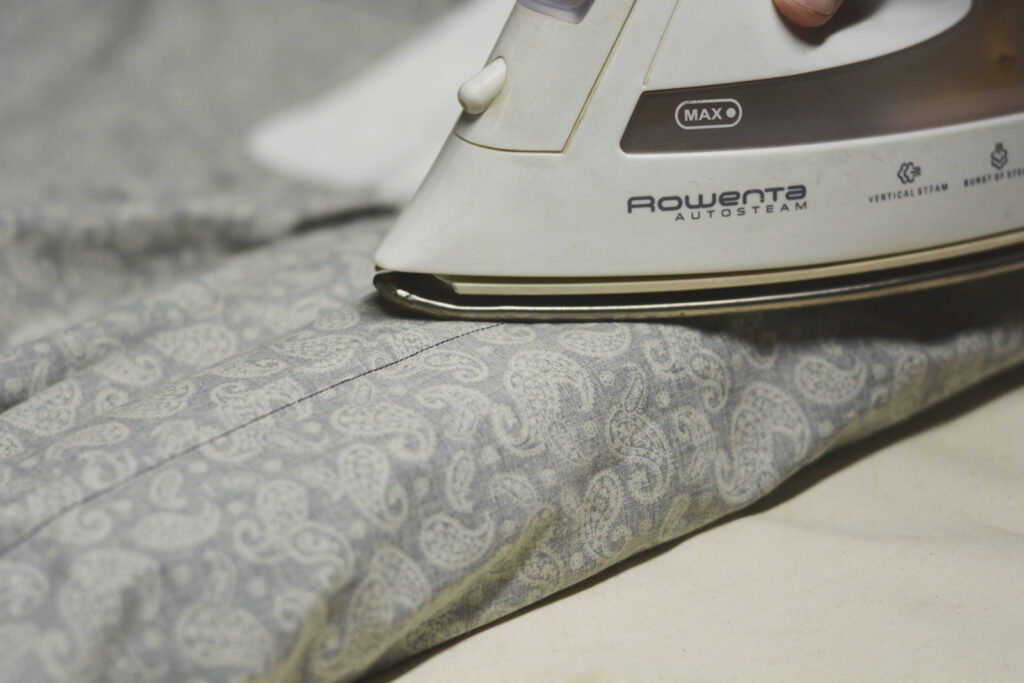
Working from the bottom or top of the seam, fold over the 1/4″ seam allowance, sandwiching the 1/8″ seam in between and forming a 1/8″ seam. I just fold an inch or so at a time, and then fell that, folding more as I go.
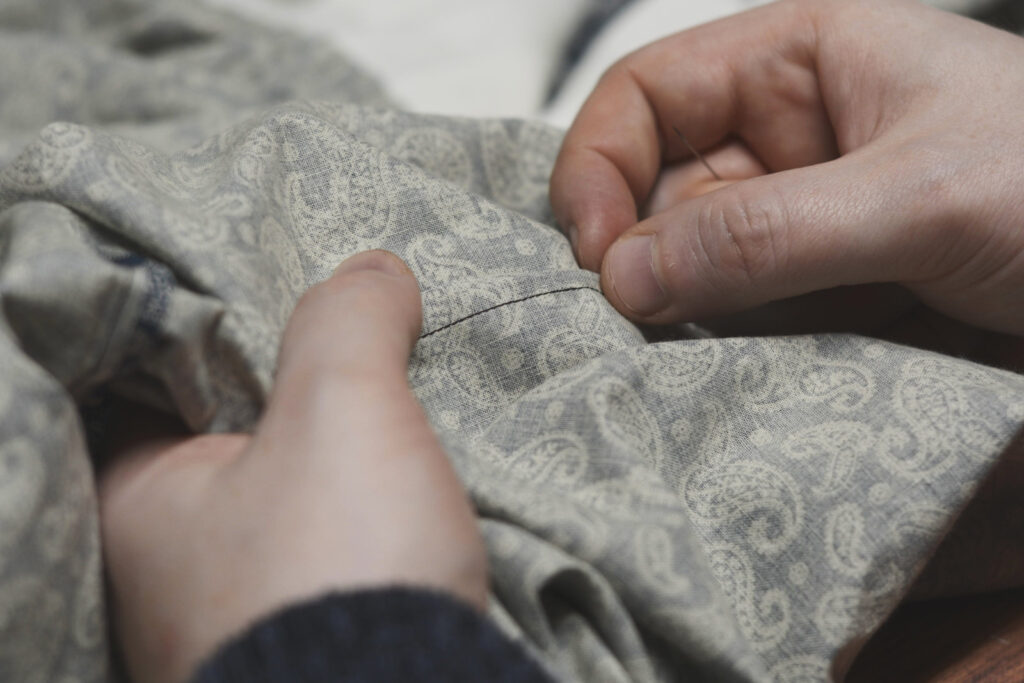
Fell the side seam, keeping a small stitch on the right side and the diagonal part on the wrong side. You should only catch a thread or two of the right side of the shirt. Keep the stitches small, at least 8 – 10 stitches per inch. Originals can be seen with threads as dense as 20 per inch!
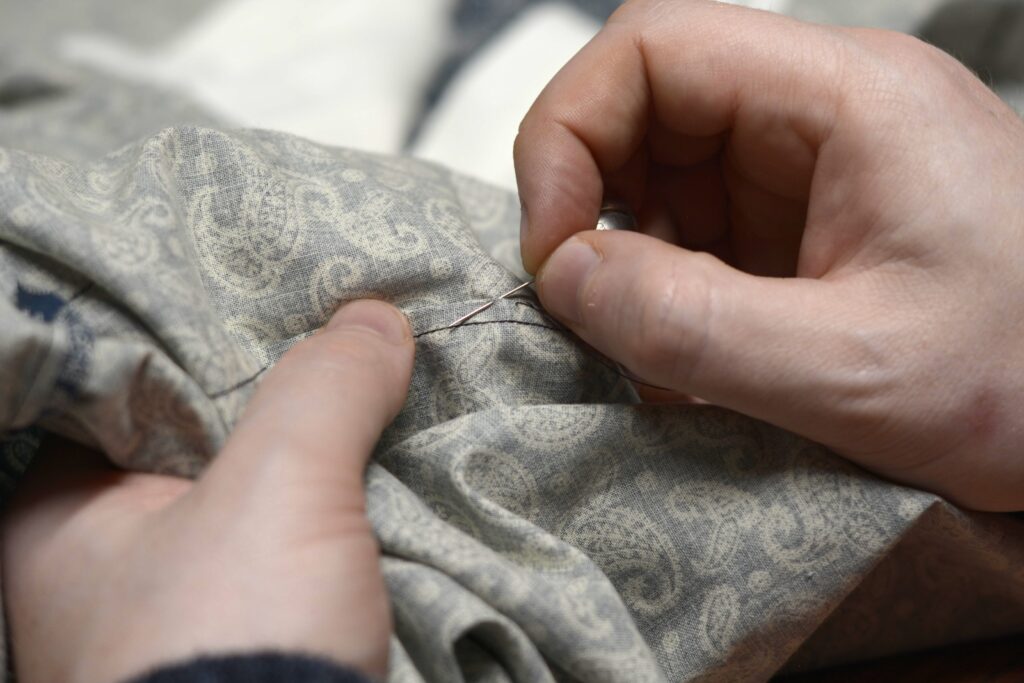
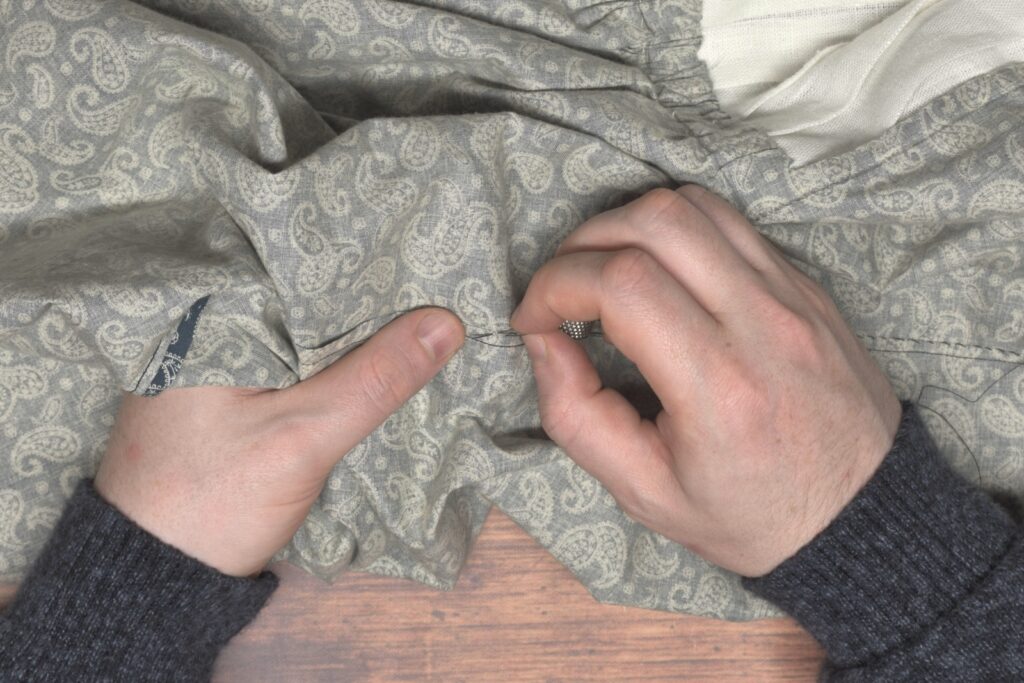
Continue sewing until you reach the end of the seam. The bottom of the side seam is fairly weak at this point due to the cut in the seam allowance, but we’ll reinforce it after hemming the shirt.
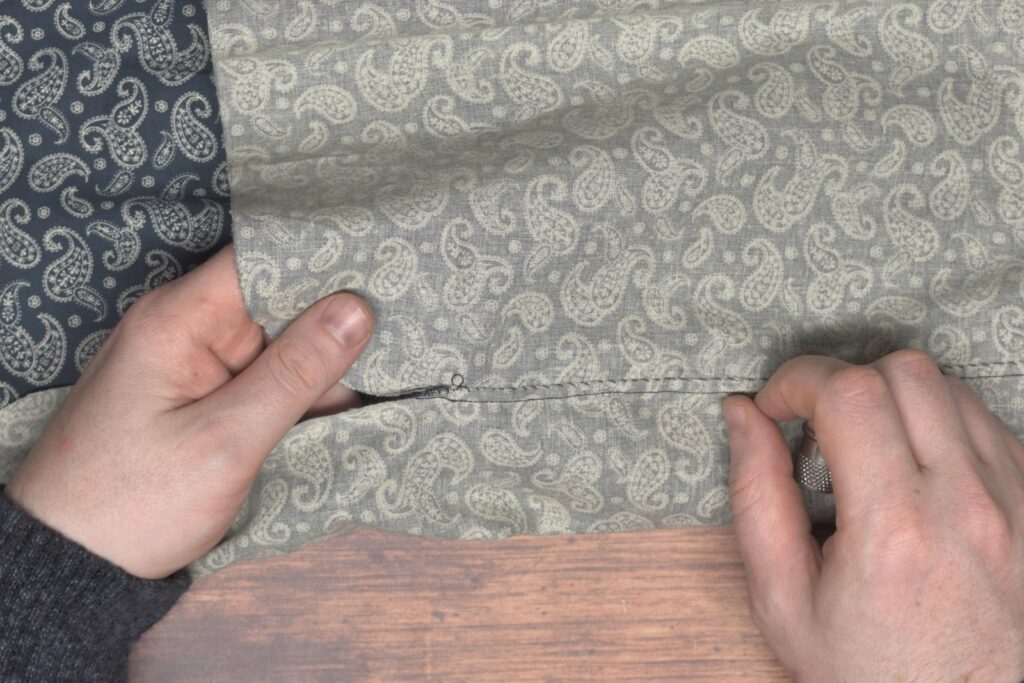

Your Progress
[columns gutter=”0″]
[col]
1 | Fell the side seams. |
[/col]
[col align_text=”center, middle”]
[/col]
[/columns]
The Collar
Installing the collar can be a little intimidating at first, but it’s really just a long series of small steps and will become second nature soon enough.
Begin by marking the seam allowance (1/2″) at both ends along the bottom edge of the collar, on the wrong side. This will help us attach the collar with the proper alignment.
Just as a note, when marking the collar, try to be as light as you can in your markings, using a white chalk or very light pencil. I used a pencil, making the marks dark enough to show up on camera, but there was a great risk of the lead bleeding through to the right side, especially when pressing.

With right sides together, pin the bottom edge of the collar to the neck seam at the center back.
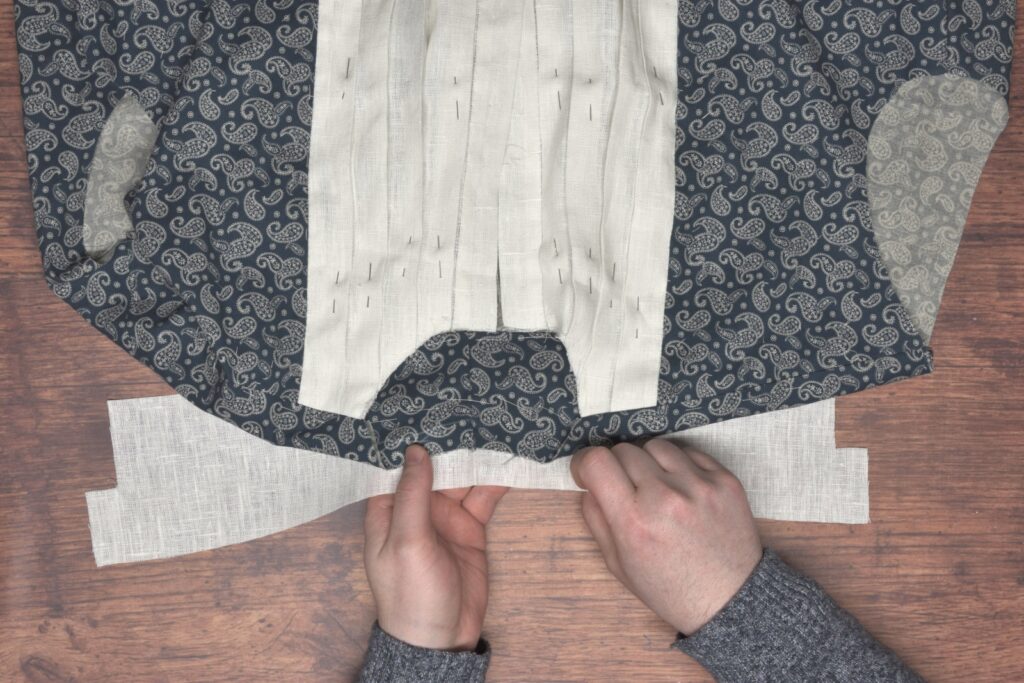
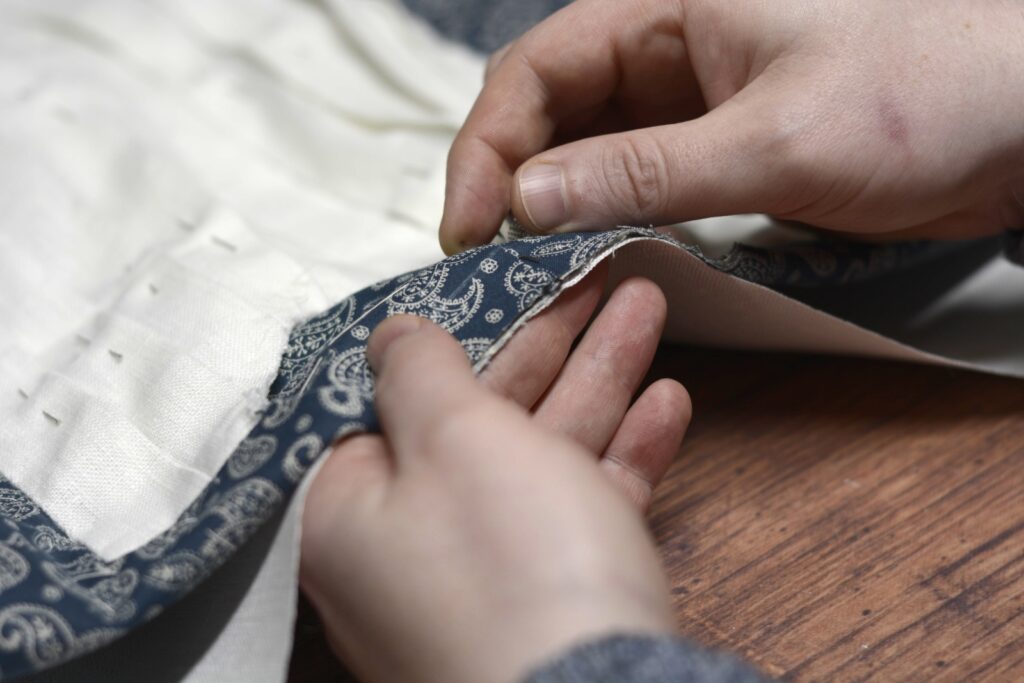
Moving to one end of the collar, pin the end of the collar to the neck at the placket, ensuring that the mark you just made is just past the edge of the placket. Repeat for the other end as well.
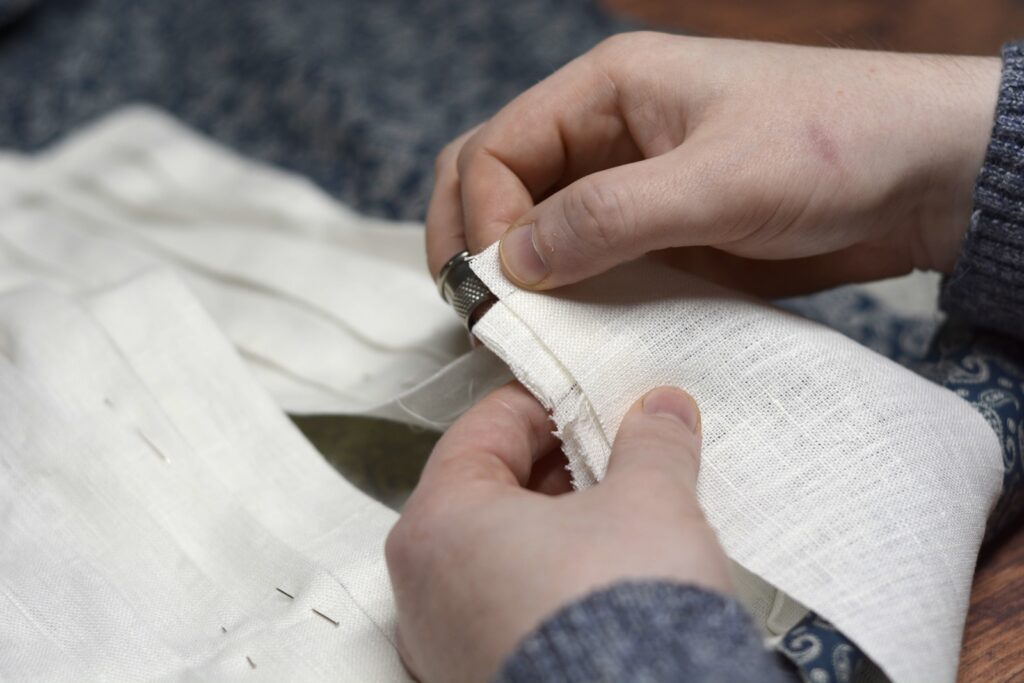
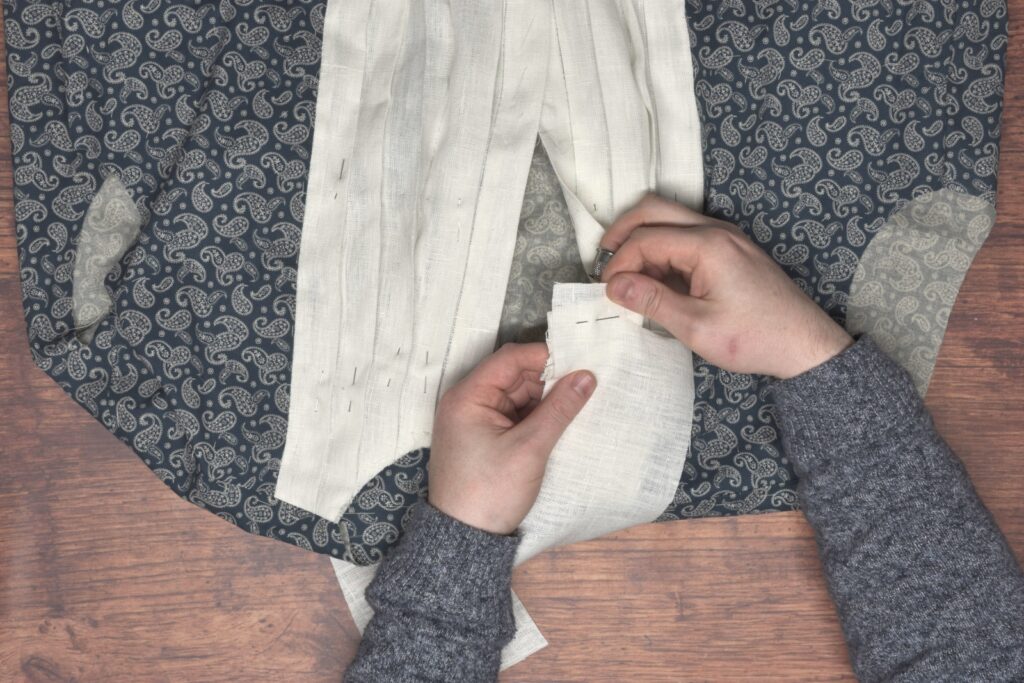
Now baste the collar to the neck, from the center back to the front, distributing any fullness with your fingers as you work. If you prefer you could pin the rest of the collar before basting.
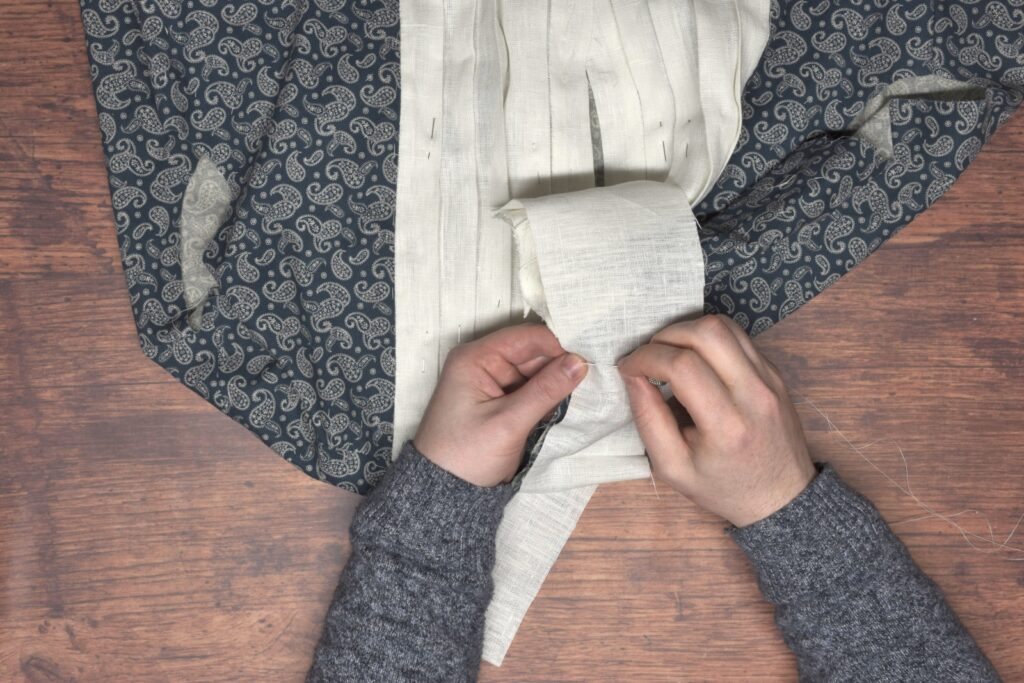
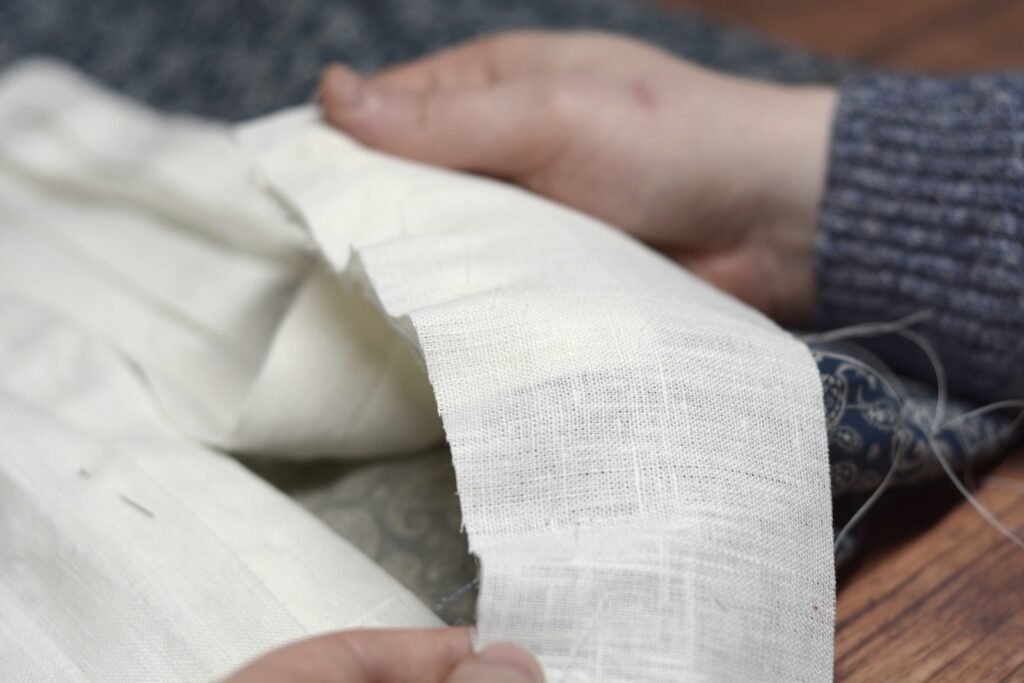
Repeat for the other half of the collar. If you look carefully at my attempt, on the left side nearer to the front, you can see a small pleat starting to form. I wish I had noticed this earlier, but alas. It should have been more evenly distributed.
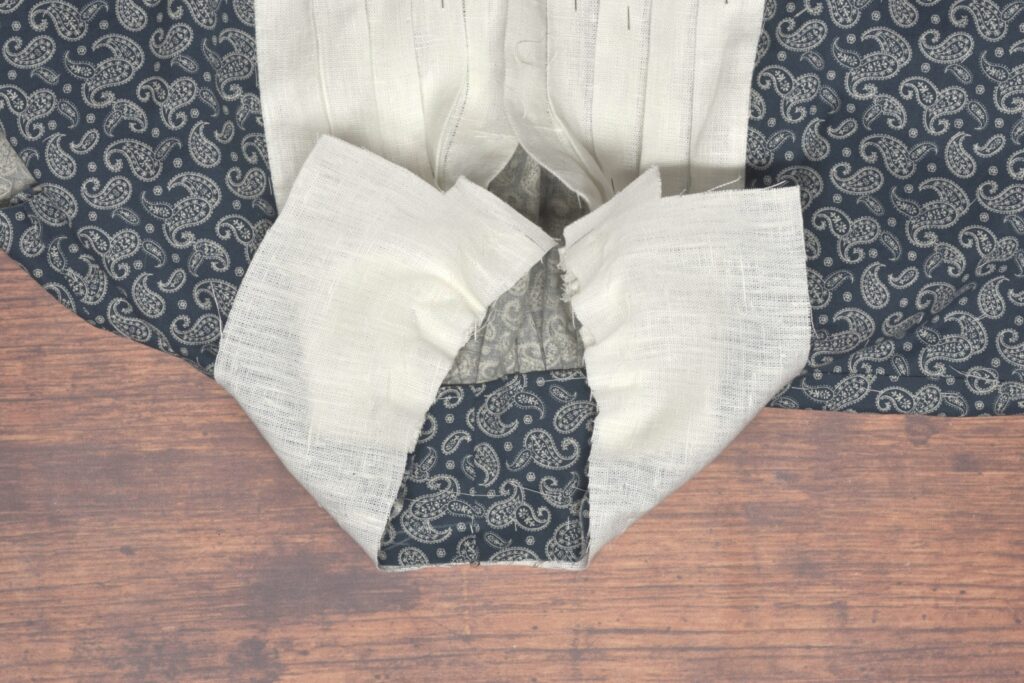
Sew the collar seam from end to end, with the collar facing down, using a 1/2″ seam allowance. Take care near the pleated area, as they have a tendency to want to open up. And yes, I remembered to switch to a white thread before sewing.
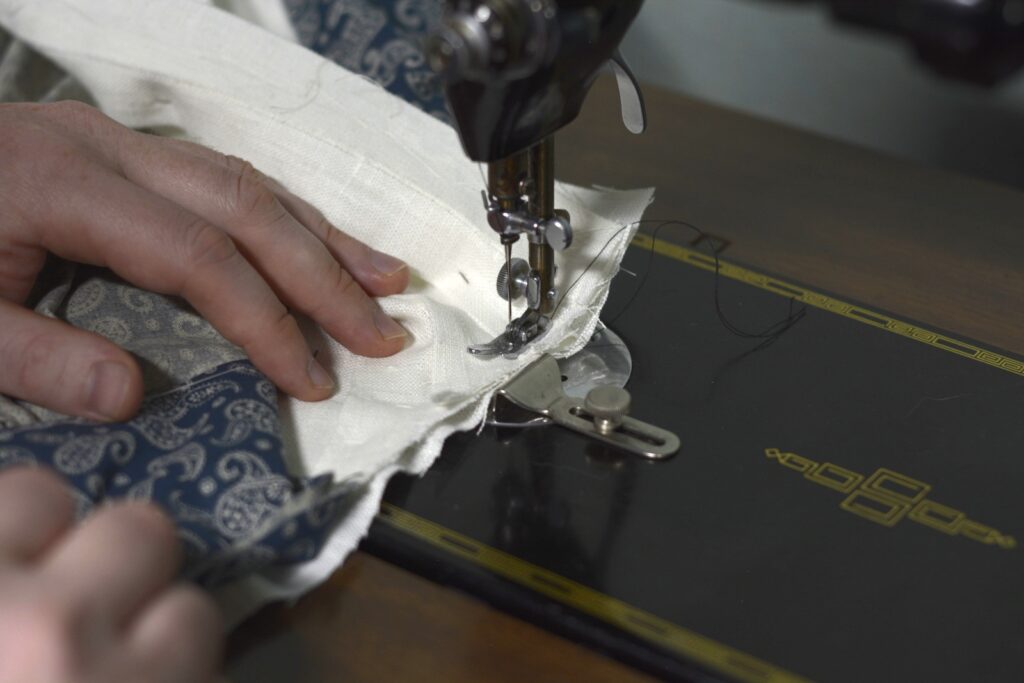
Also be careful not to let the fabric slip as you’re sewing. With all the fullness built in, and the bias of the neck seam, it’s very easy for things to get out of alignment here and there.
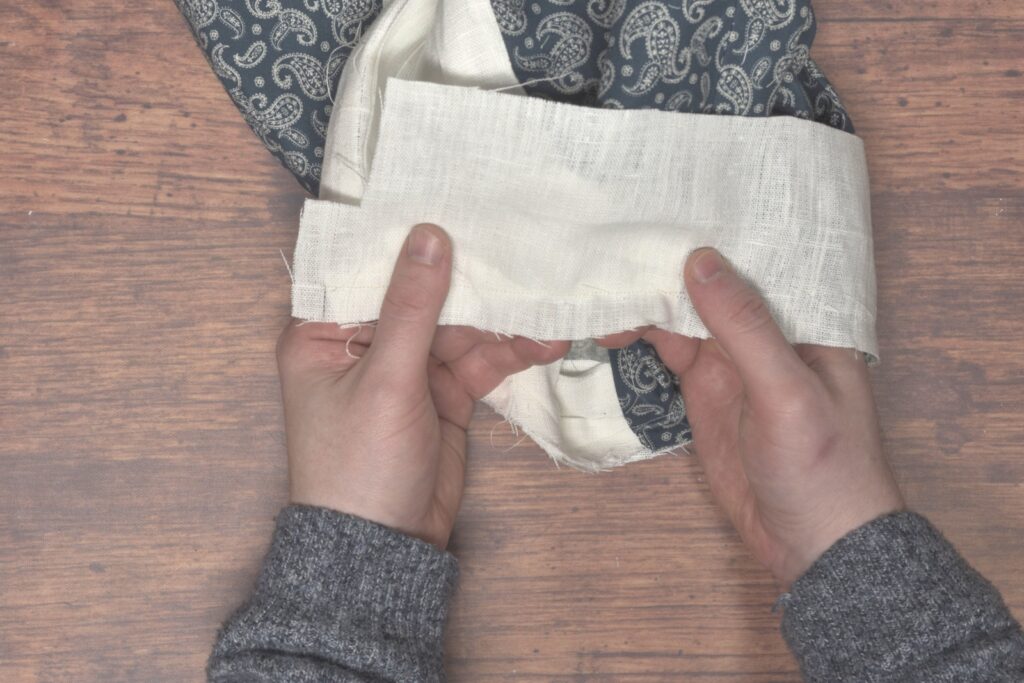
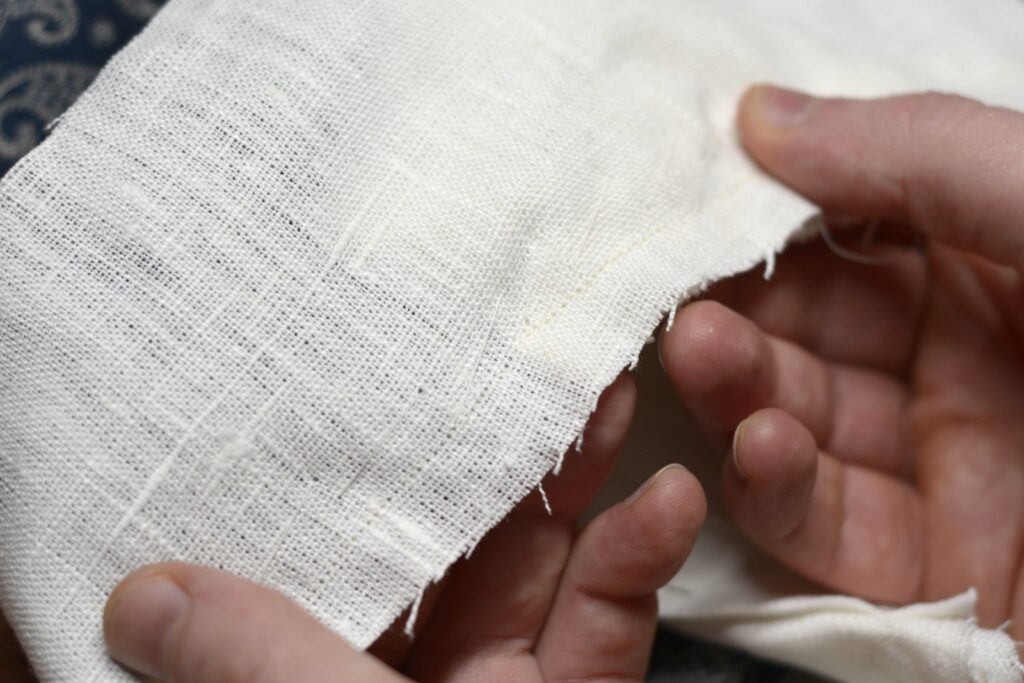
Trim the collar / neck seam allowance to 1/4″. It’s easiest to do this before pressing.
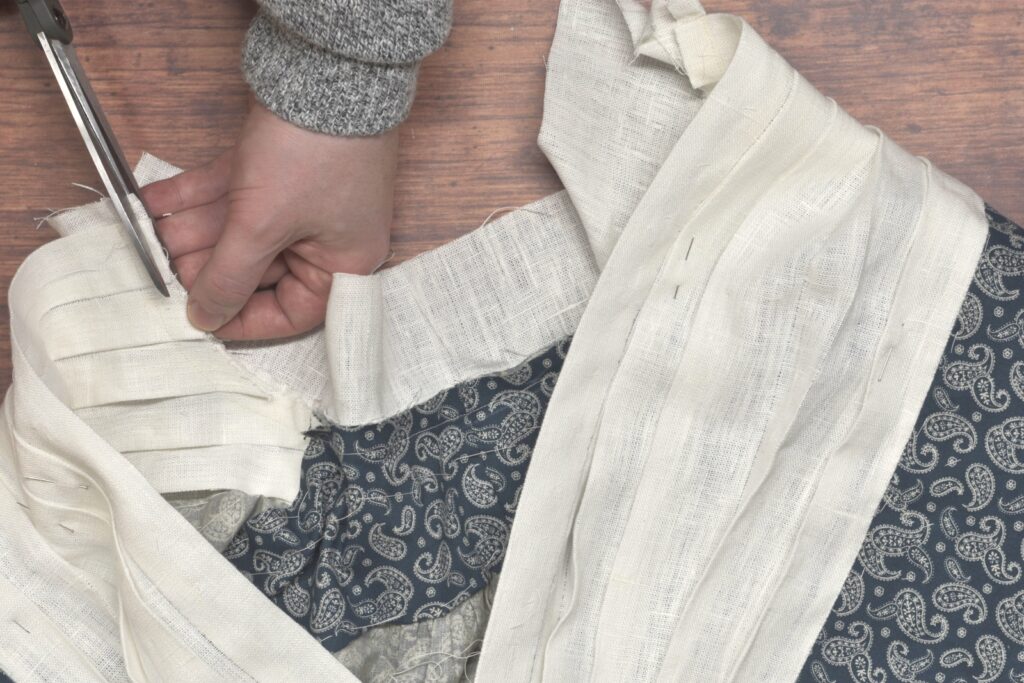
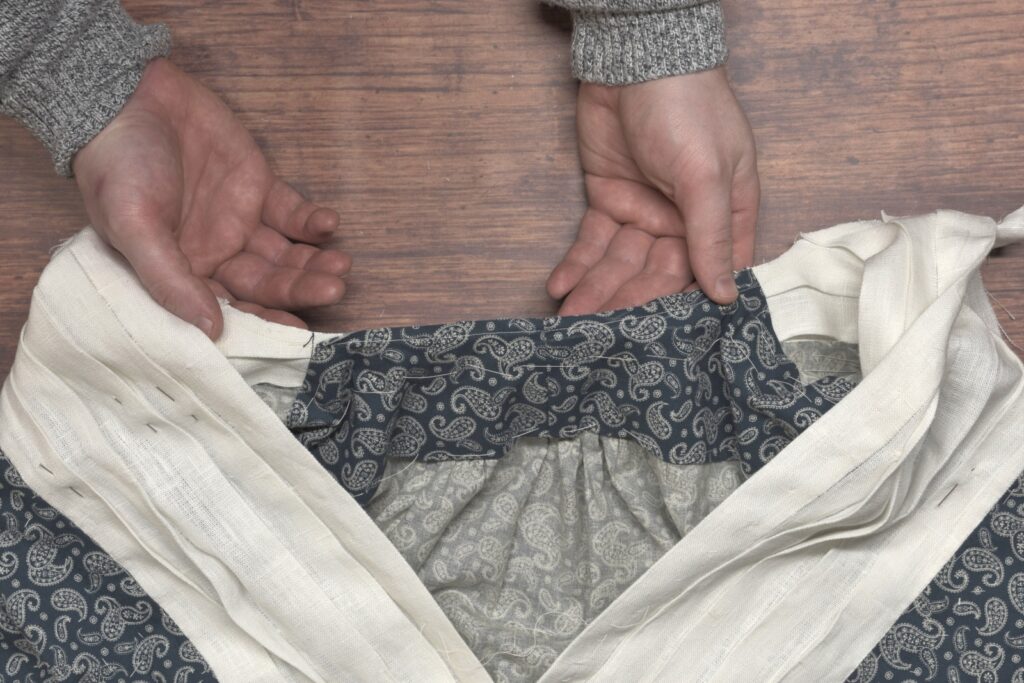
Press the collar and neck seams up towards the collar. Again, you’ll have better results by trimming the seam allowance beforehand, taking out some of the tension in the curved areas.
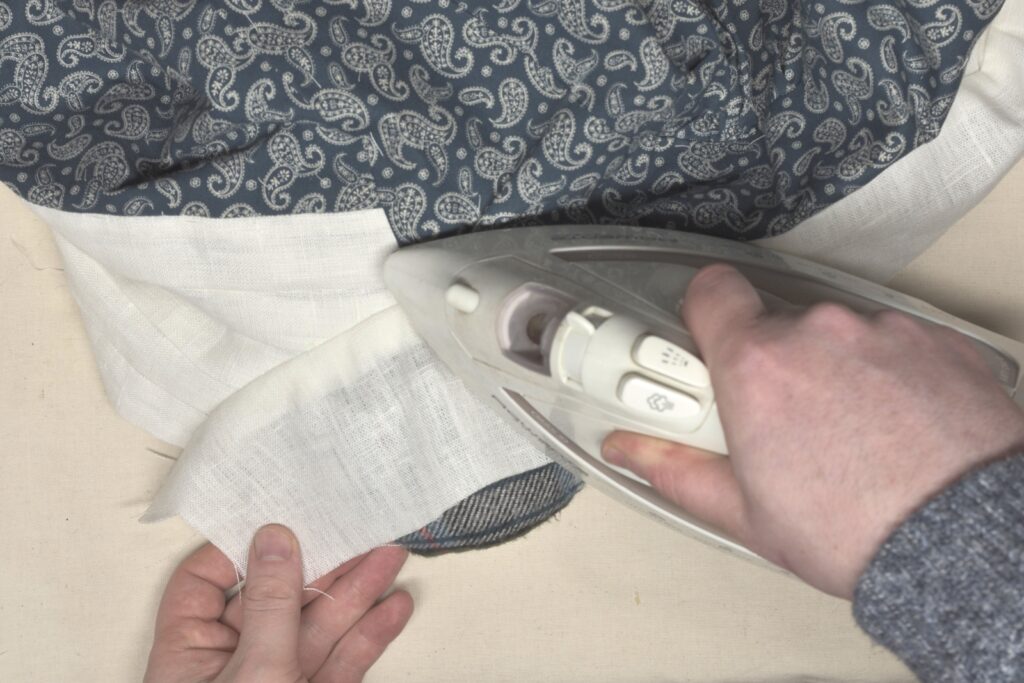
Here’s a very tiny mishap in the collar, caused by allowing too much fabric to be gathered into the area, or perhaps not being careful enough with my sewing machine. I ended up just leaving this, but the easiest fix would be to unpick the stitches within about 1″ of the area, baste, and sew again.
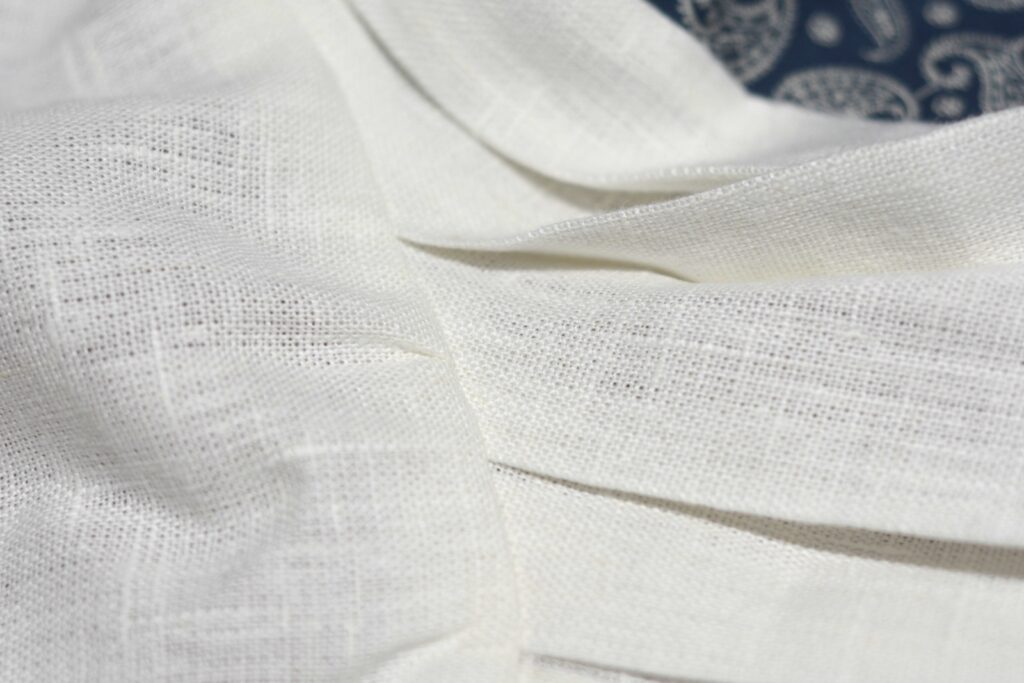
Attaching the Inner Collar
Lay the inner collar under the outer collar, right sides together.
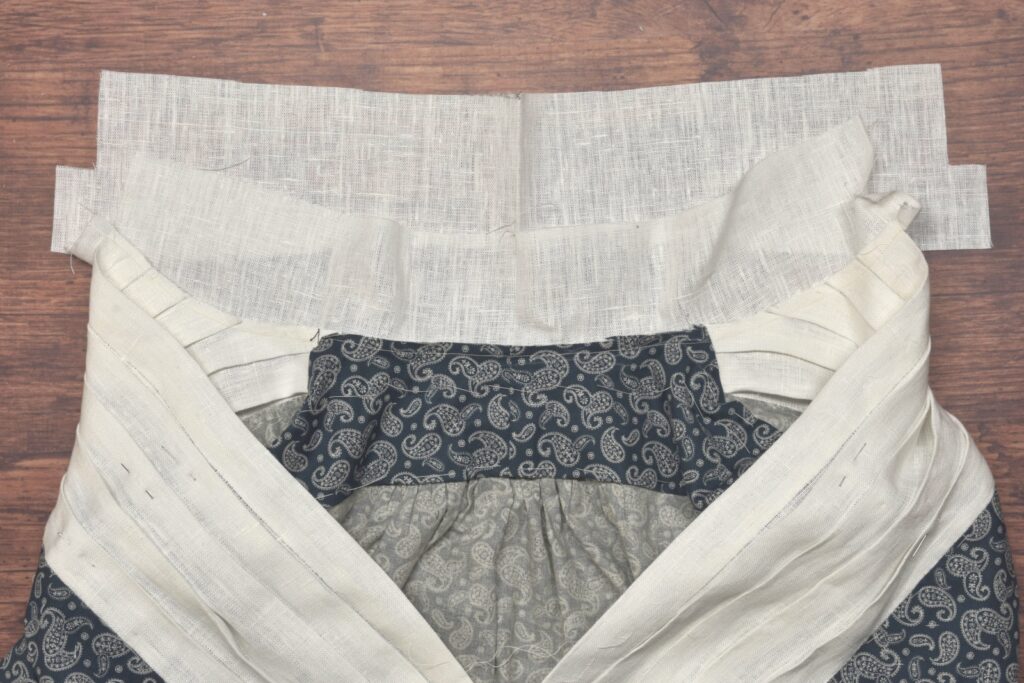
Beginning from the center back and working your way towards the front of the collar, baste the outer collar to the inner collar.
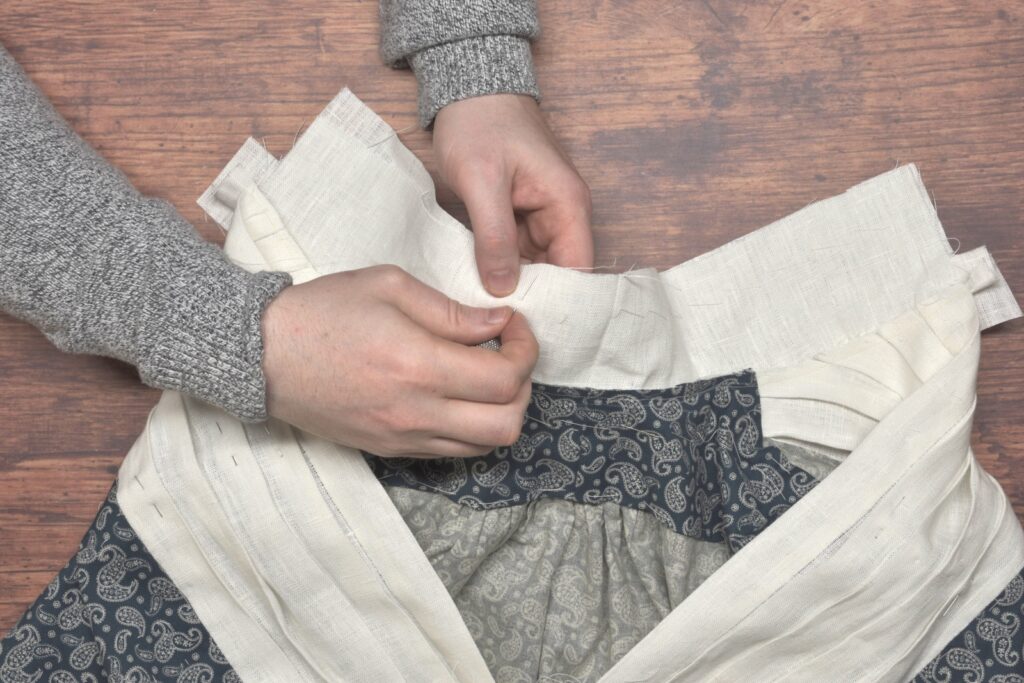
As you’re basting, lift your left hand and allow the fabric to drape over it naturally. In effect, this makes the inner collar (below) shorter in length than the outer collar (on top), which will reduce some of the excess folds that might appear otherwise on the inside of the finished collar.
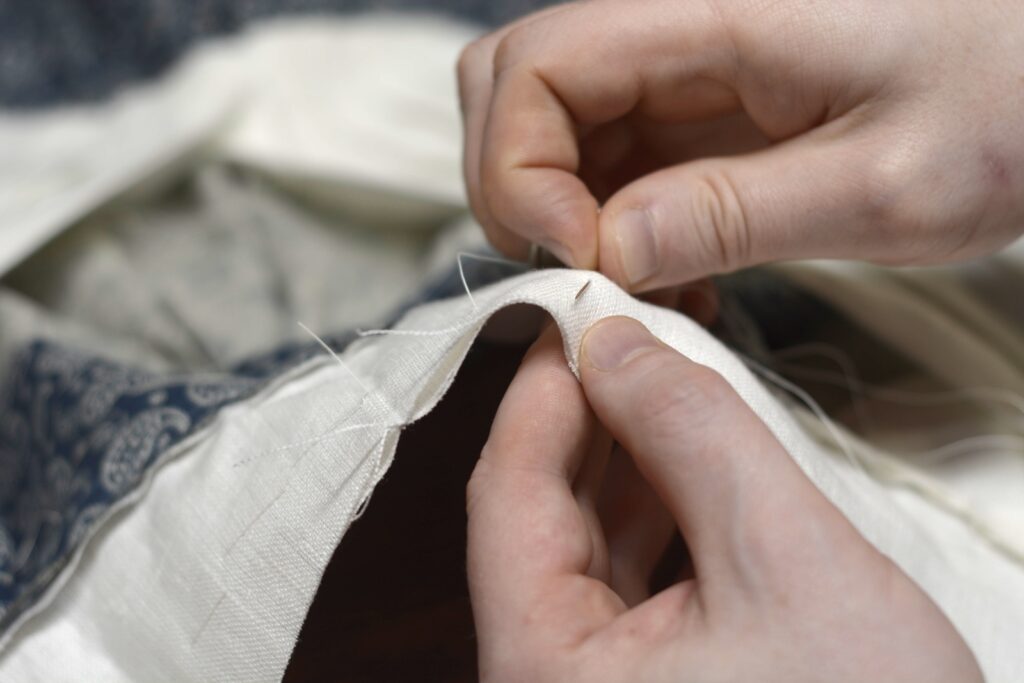
At either end, you’ll notice that the inner collar extends beyond the outer collar by about 1/8″ or so. Trim this inner collar flush with the outer collar on both ends.
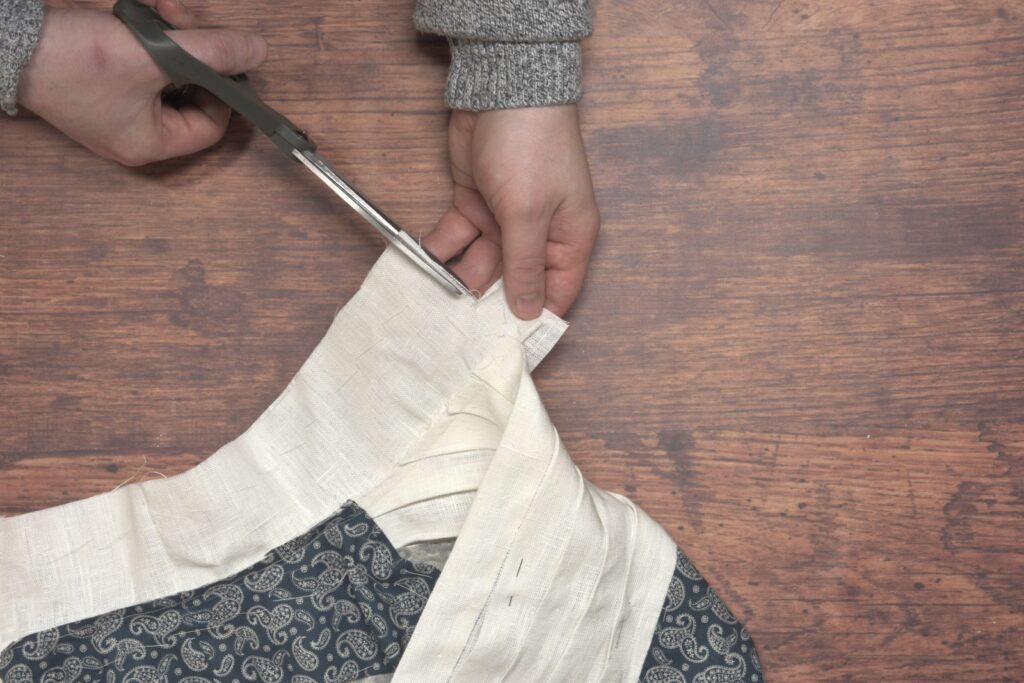
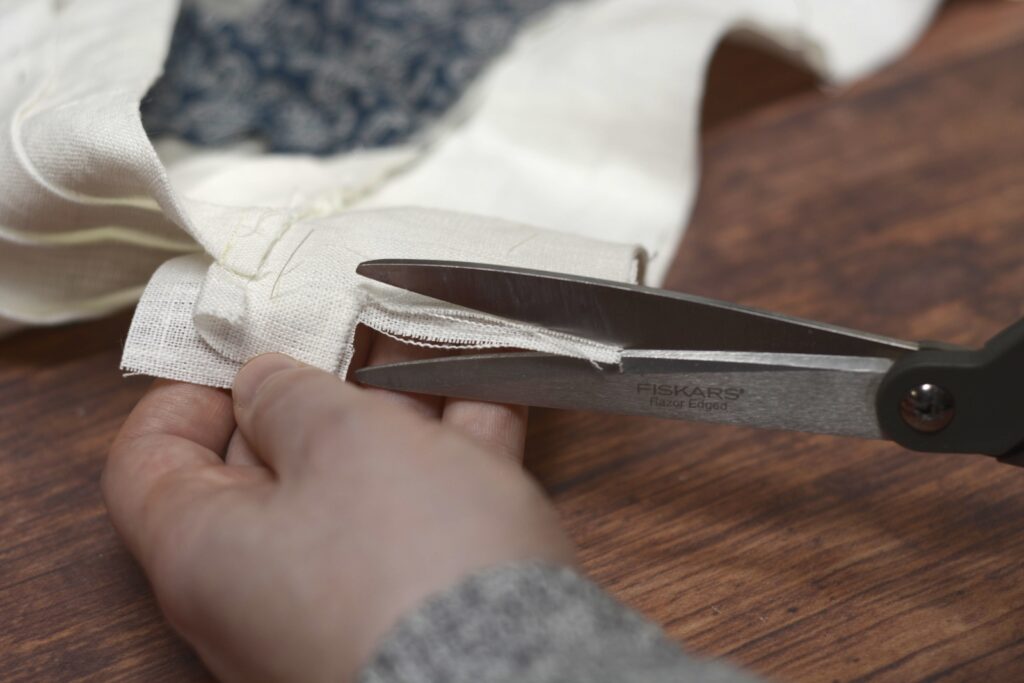
At both ends of the collar, draw in the seam allowances lightly to help make your sewing more accurate.

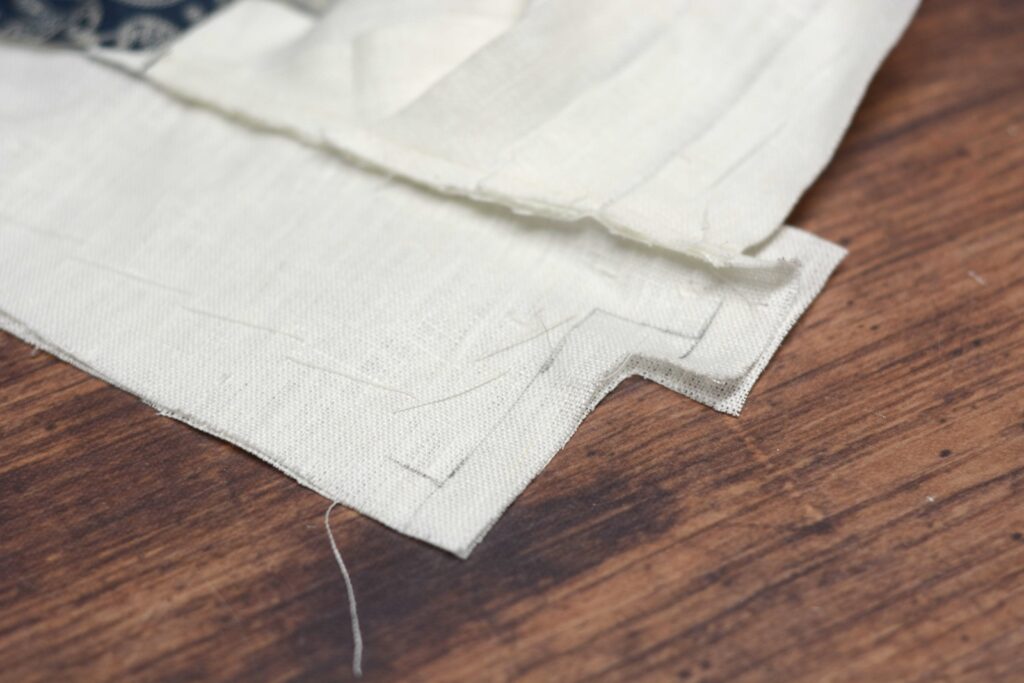
At one end, I had a slight discrepancy in the collar lengths, in that the collar extended about 5/8″ to 3/4″ beyond the edge of the facing, rather than the 1/2″ it was supposed to be, so I had to redraw the lines to make up for this error.
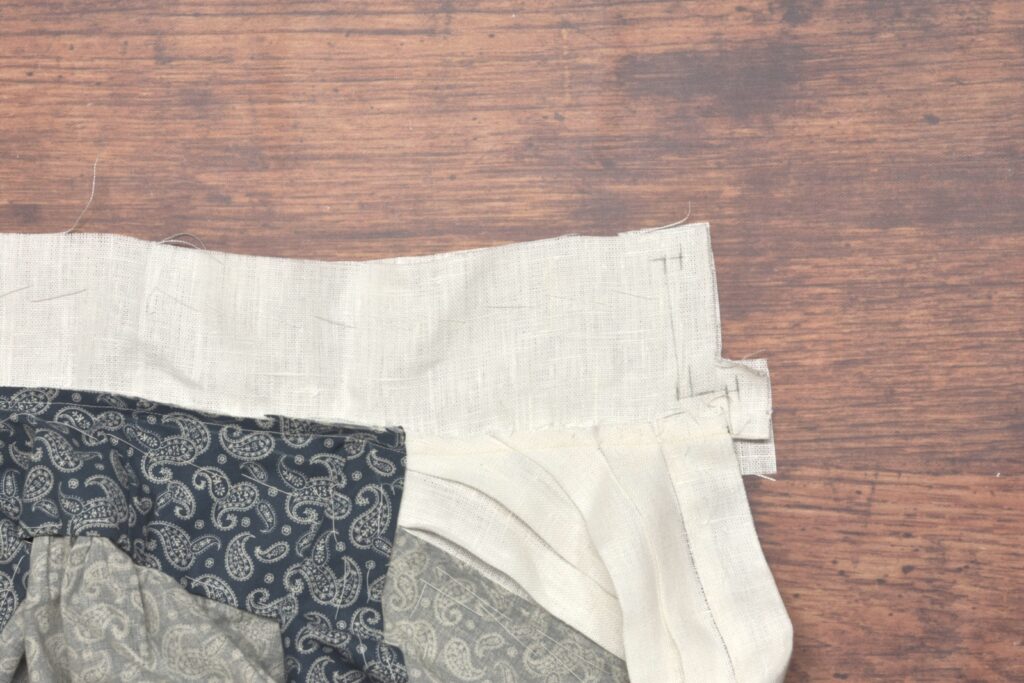
Sew the collars together beginning at the end where the collar meets the placket, around the shaped front, and across to the other side. When you get to an angular section and need to change directions, rather than just making a sharp turn with your stitching, make one stitch at a diagonal across the corner. This will give a little extra room for the seam allowance when the collar is turned right side out.
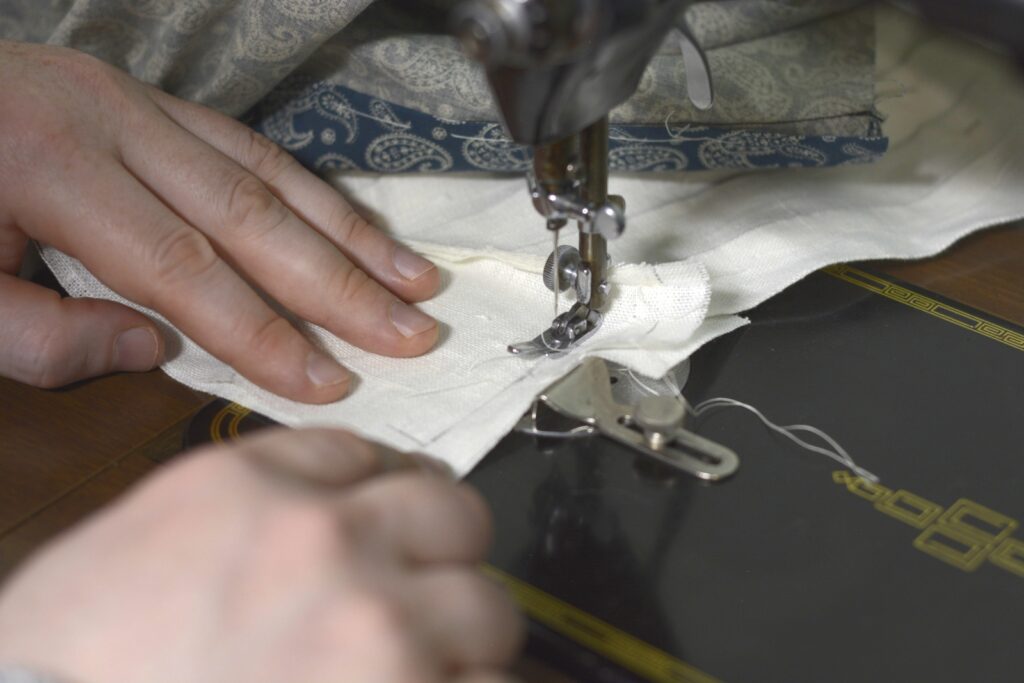
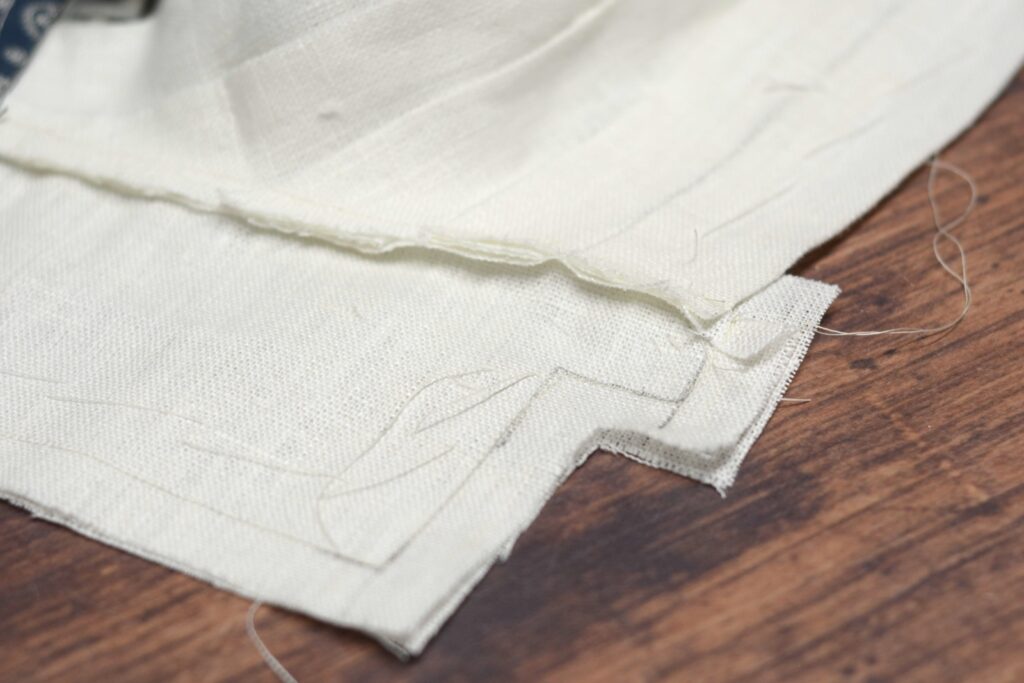
Trim the collar seam allowances to 1/4″.
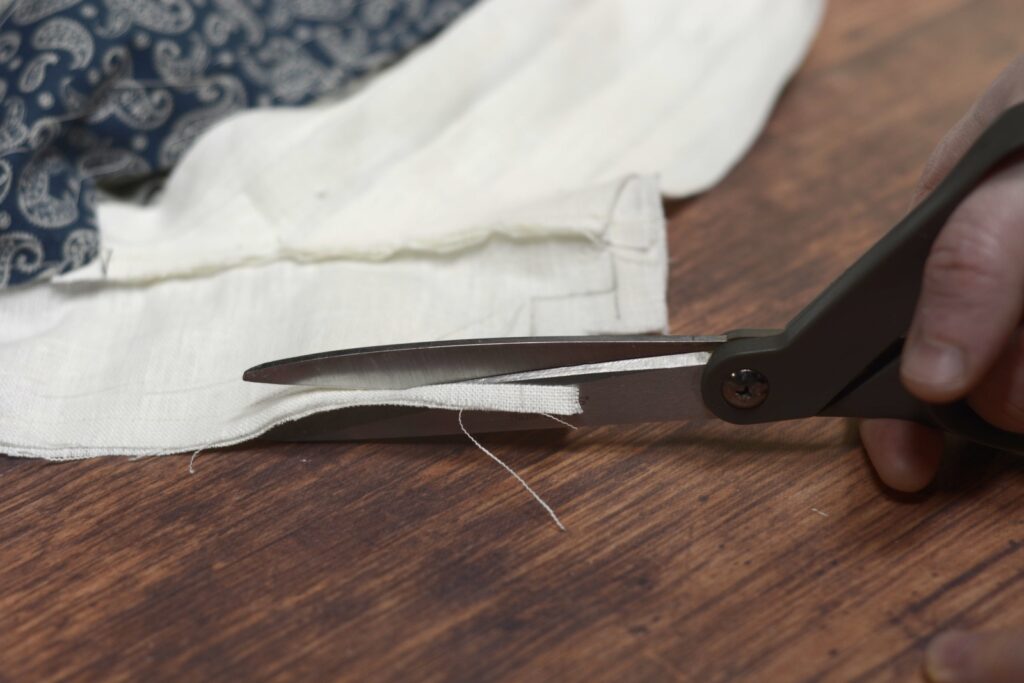
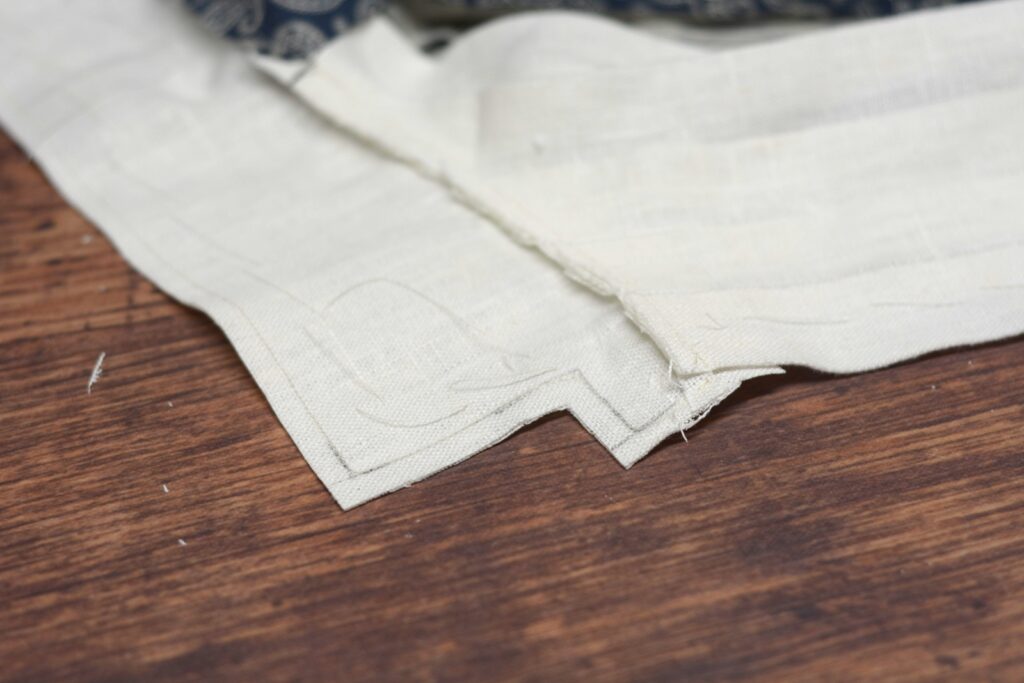
Miter the outside corners, keeping about 1/8″ from the stitching.
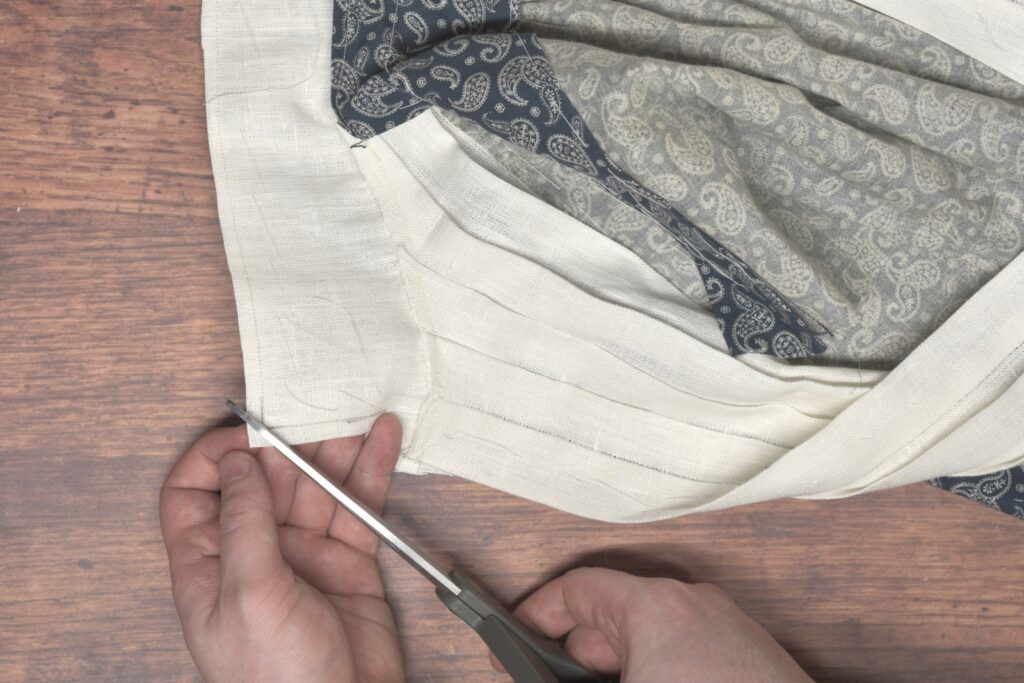
Then, further taper the miters to remove excess fabric from the tight corners.
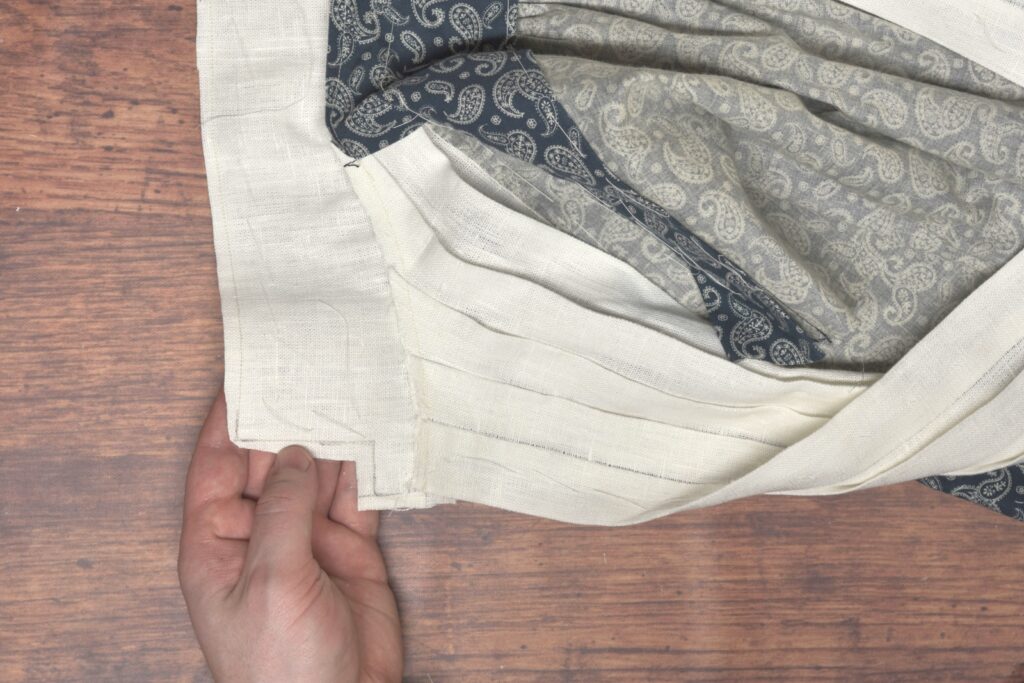
On the inside corners, snip the corner to within 1/16″ of the stitching. The closer the better, but you don’t want the linen to start unraveling.
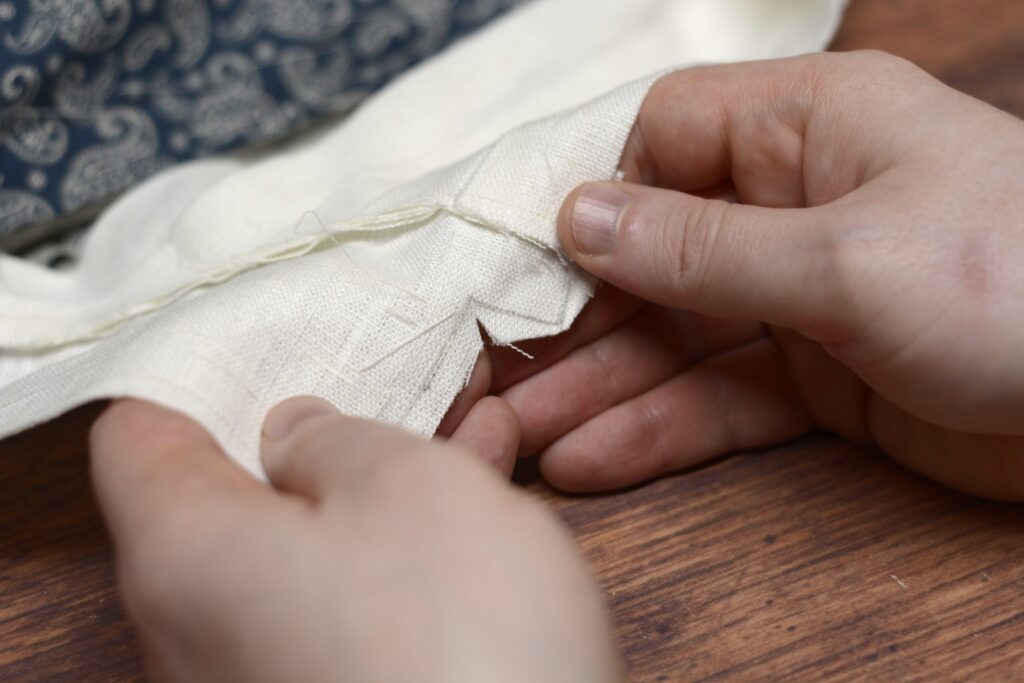
Cut away some of the excess seam allowances at the inner corners, tapering down to the cut you just made.
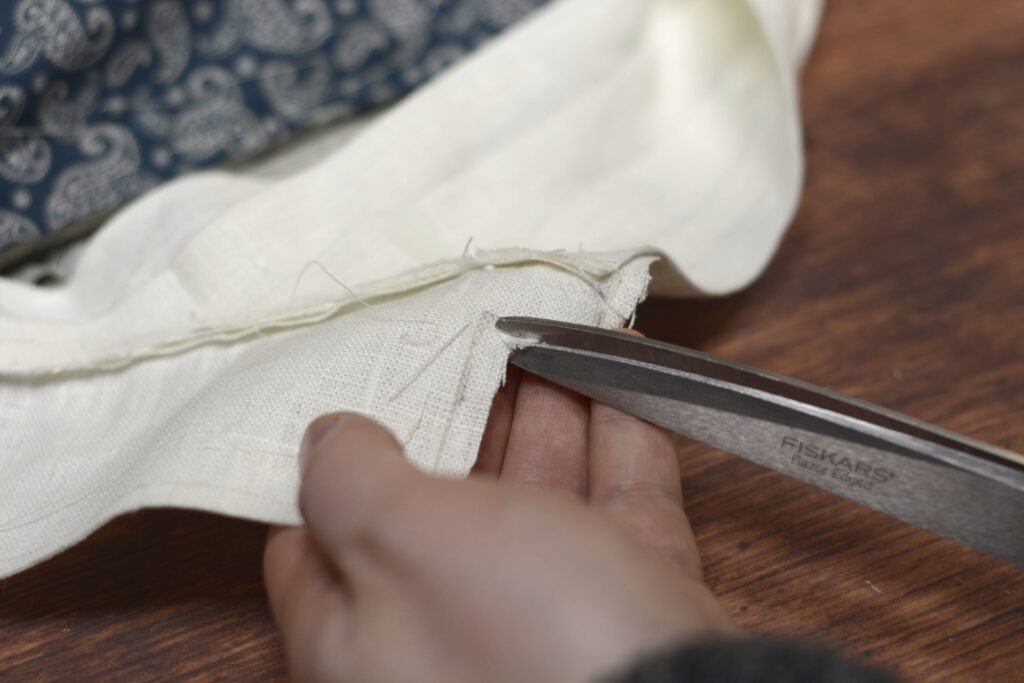
Here’s what my seam allowances looked like after trimming.
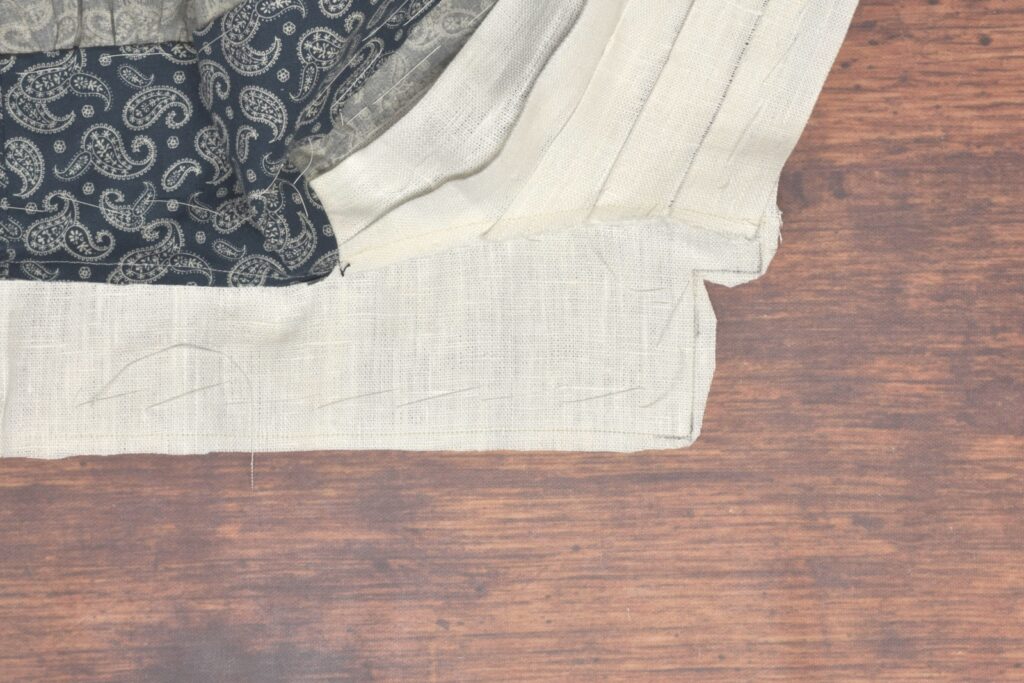
At the corners, press the seam allowances to one side, being as accurate as you can. I creased the press with my fingers followed by the iron.
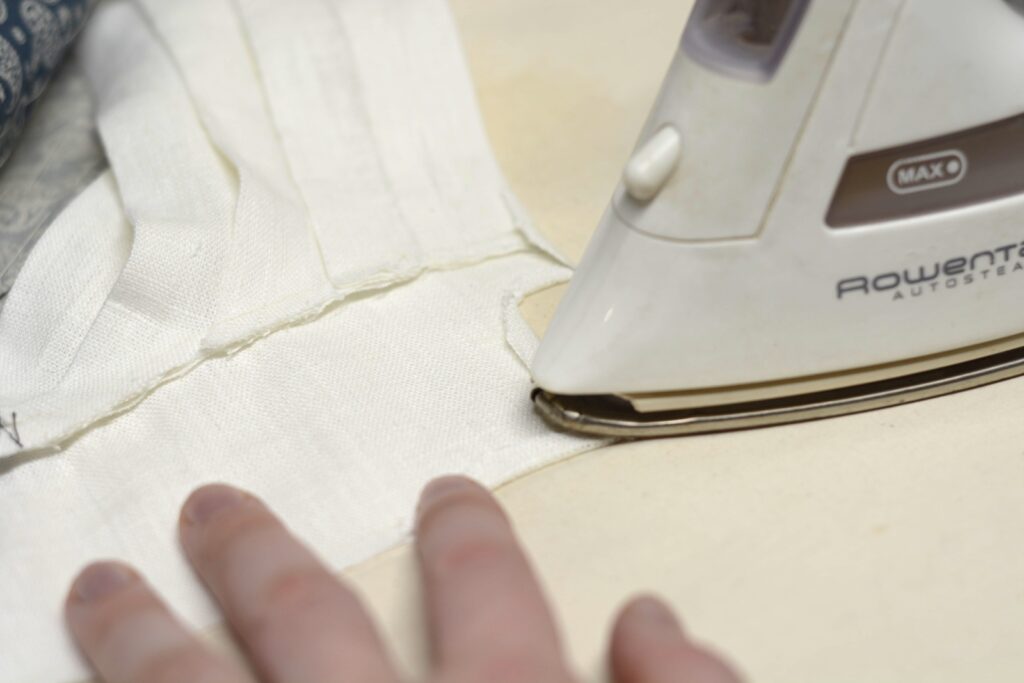
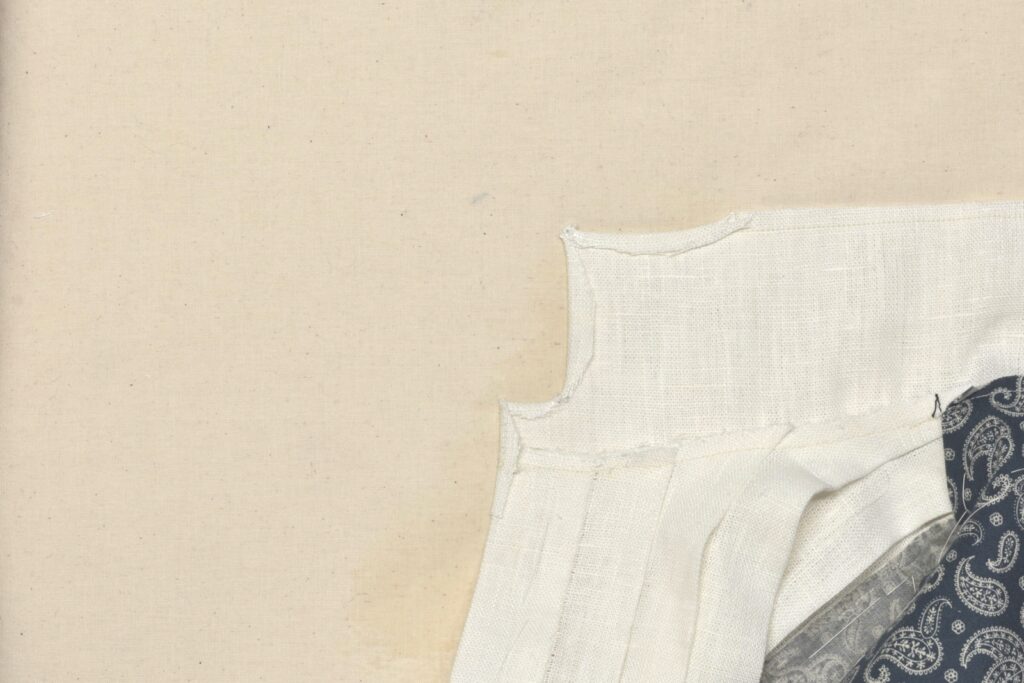
Finally, turn the collar right side out, paying particular attention to each of the corners. Use a seam turning tool to get the corners as sharp as possible.
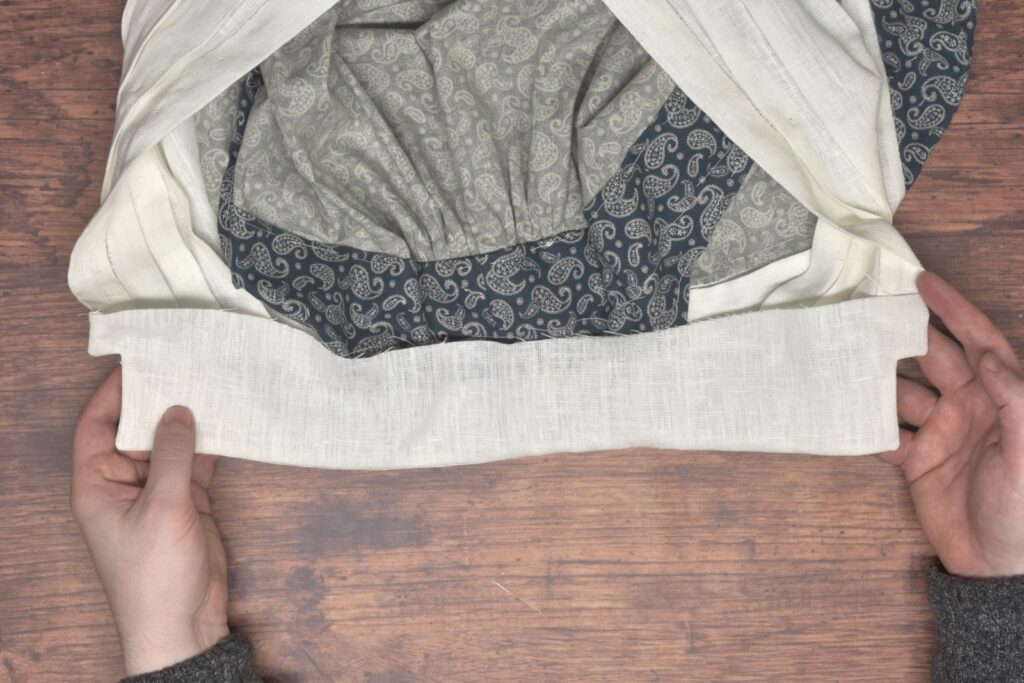
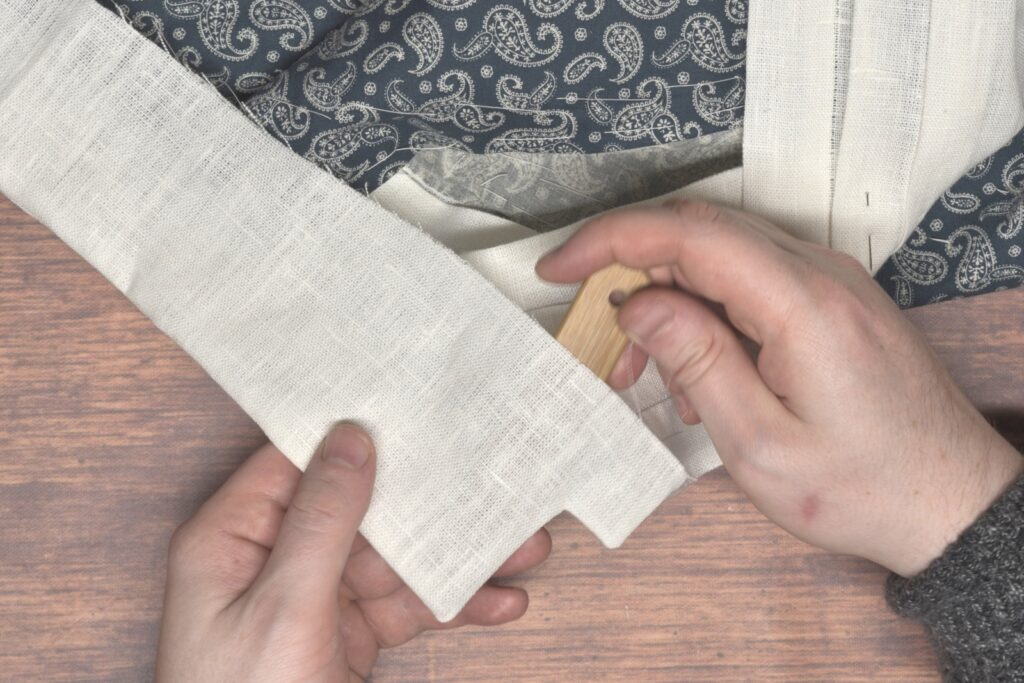
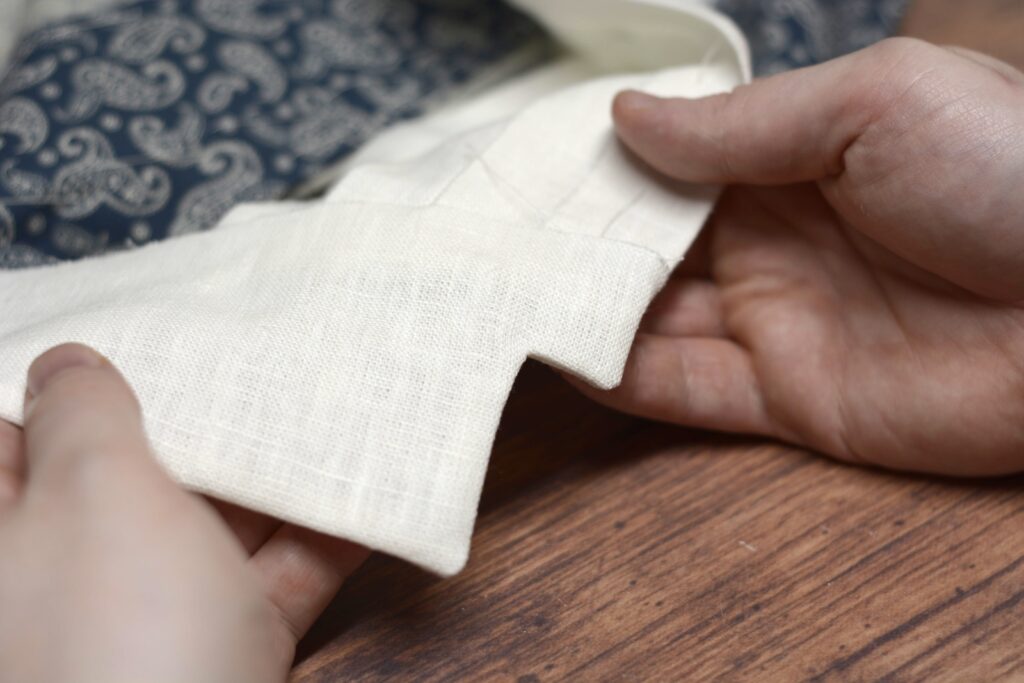
Baste around the outside of the collar, about 1/2″ from the edge, arranging the seam so that the inner collar is set back about 1/16″ – 1/8″. Press with your fingers as you go.
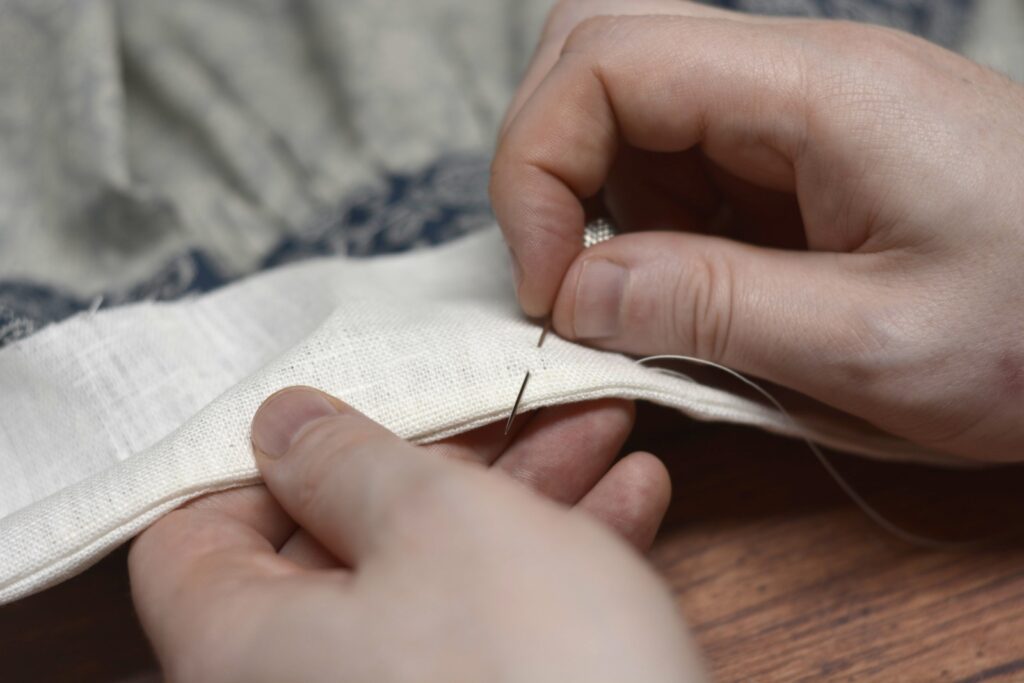
Here you can clearly see how the inner collar has been set back, so that it will not be visible from the outside of the shirt (assuming you’re making a standing collar, at least).

Now baste across the bottom of the collar, keeping about 1″ from the raw edge, or 1/2″ from the seam itself. Keep a neutral tension between the two halves of the collar.

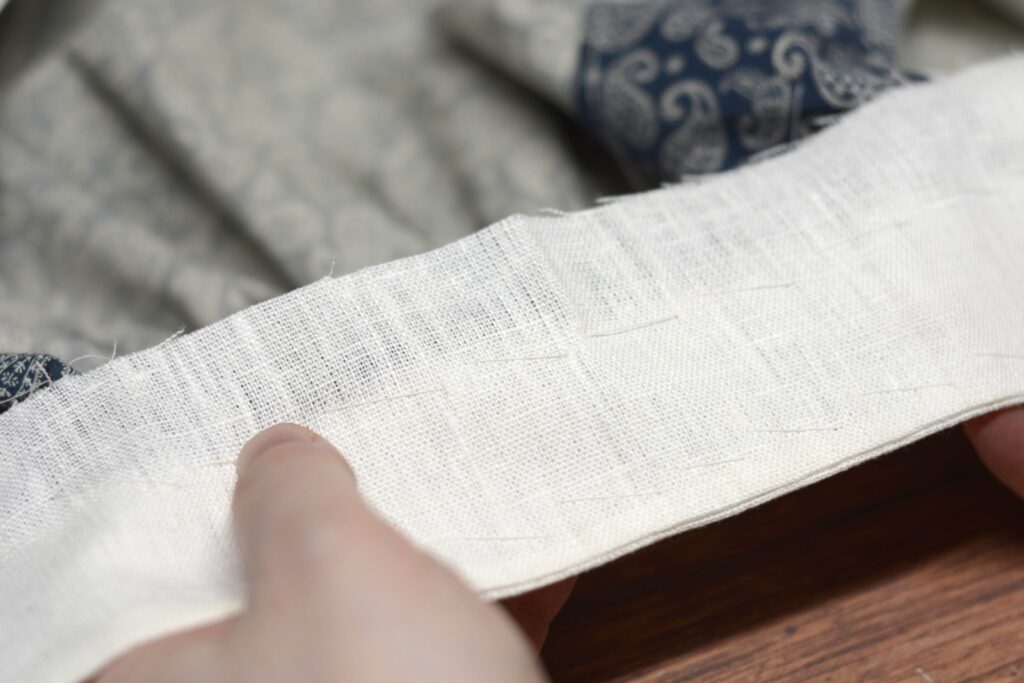
Now fold the raw edge of the linen collar to the inside. You may want to trim this last seam by 1/4″, as I ended up doing. Align the folded edge with the seam underneath, just covering it.
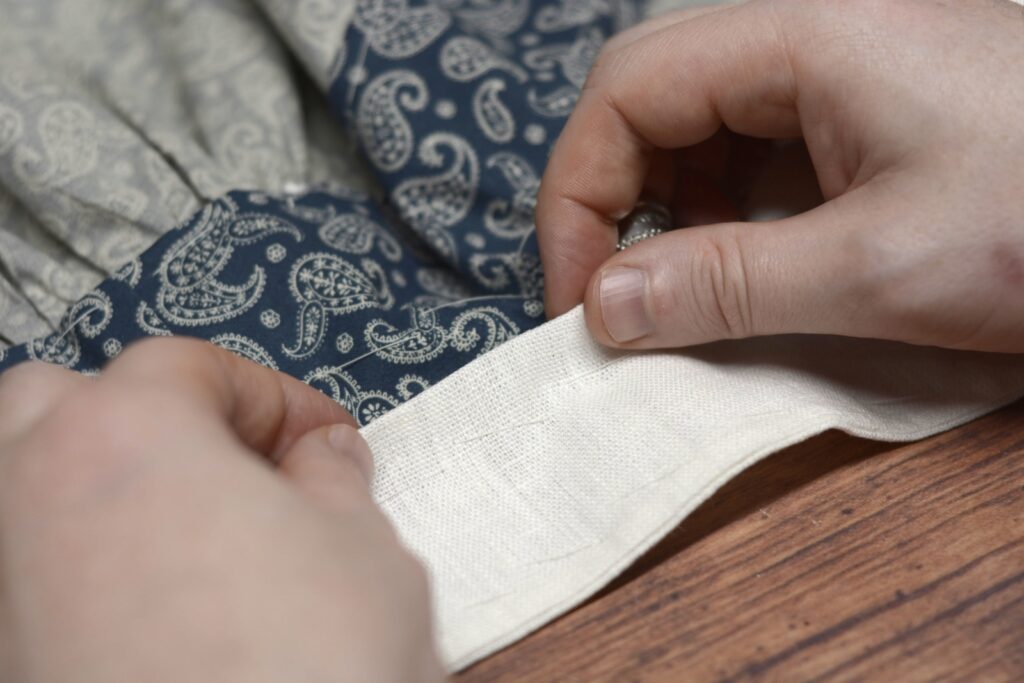
Baste the folded edge of the collar closed.
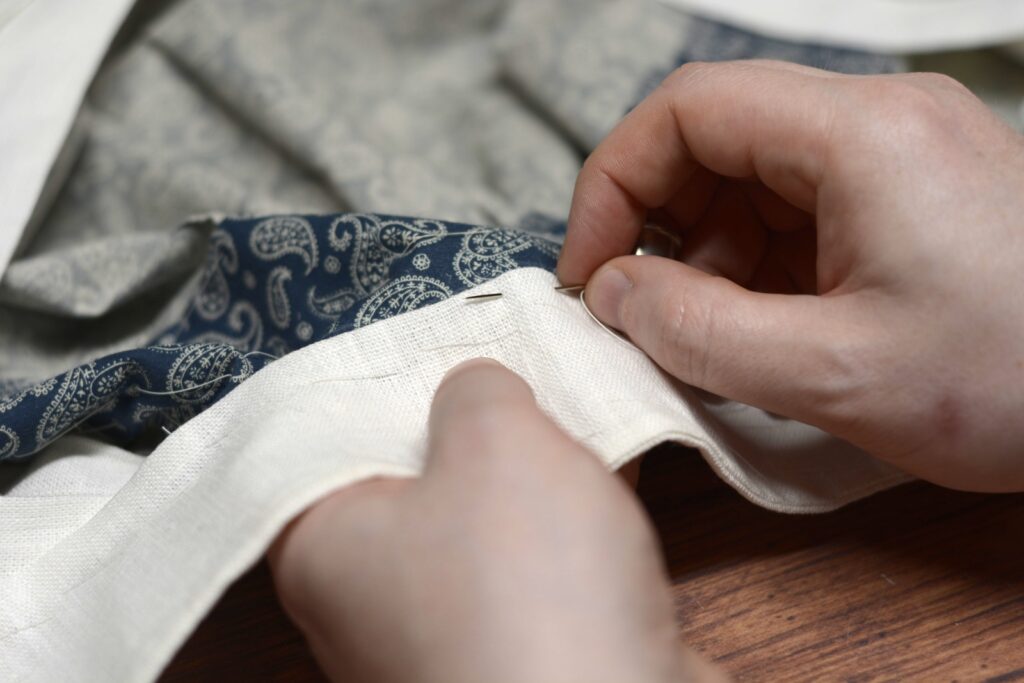
Carefully fell the folded edge to the seam underneath. You should be able to hide the diagonal part of the stitch in between the layers, should only a small stitch on the inside of the collar.
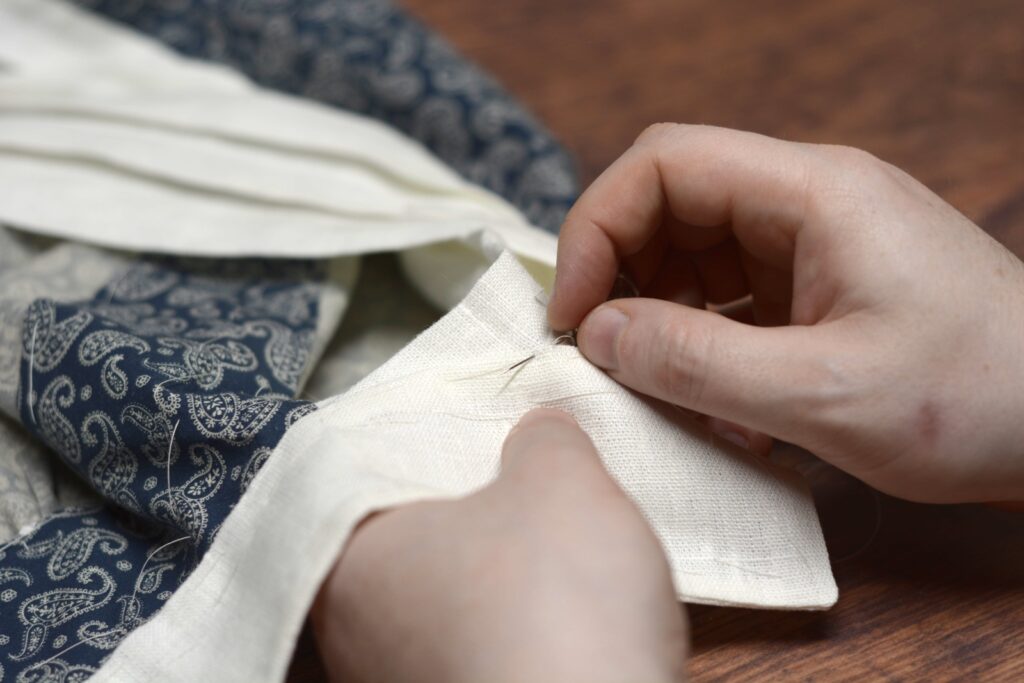
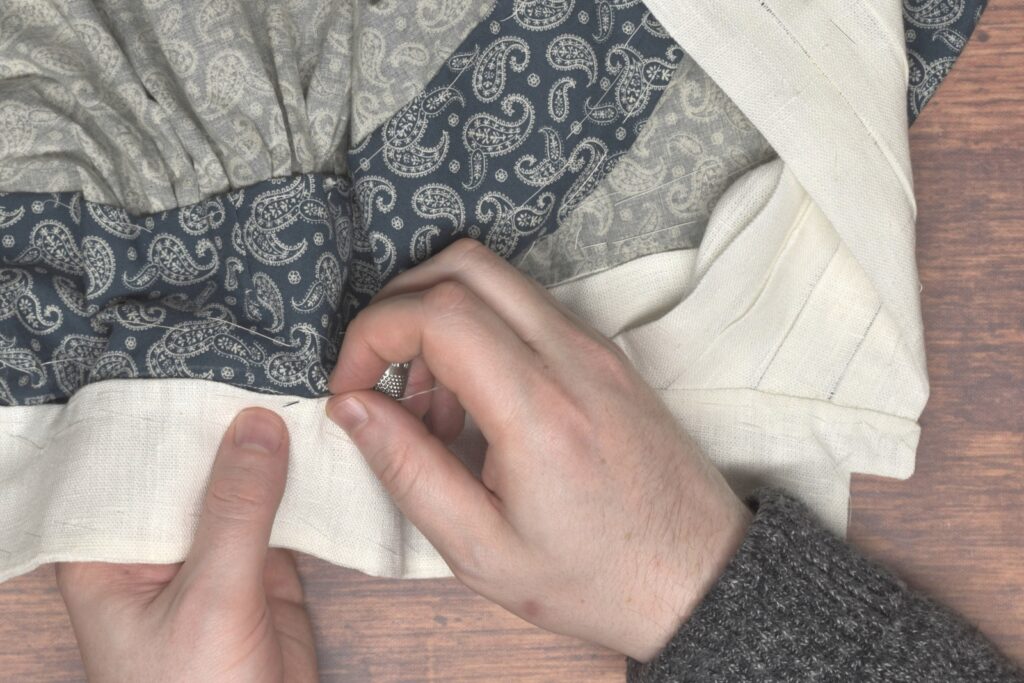
Lastly, top stitch the collar all the way around, including the neck seam, about 1/8″ from the edge. Take care around the corners to keep your stitching sharp and accurate.
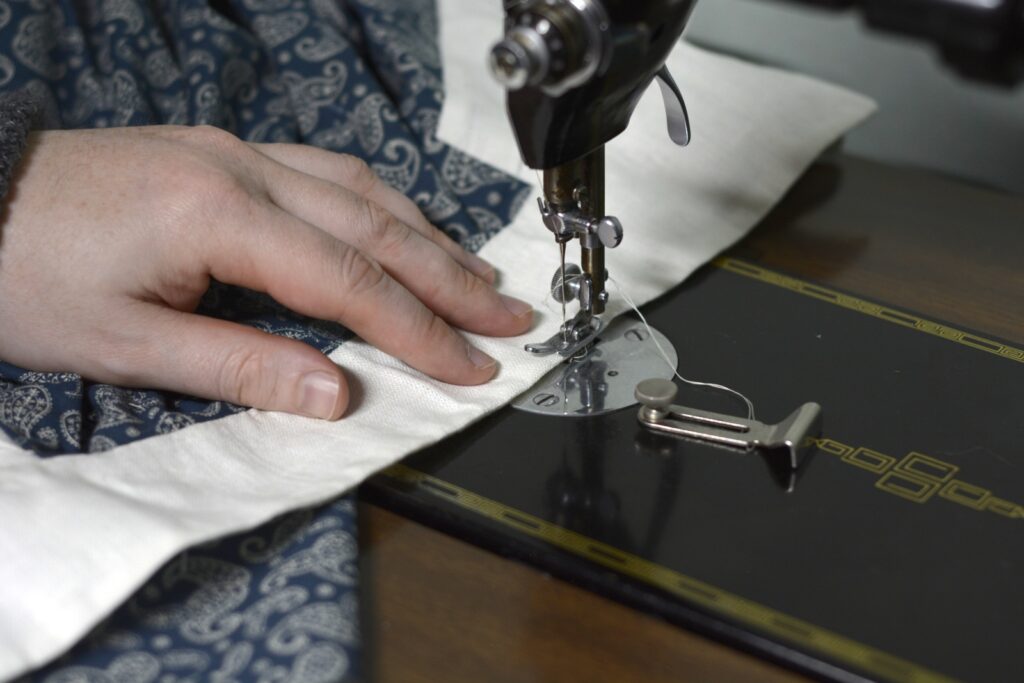
Not particularly happy with the way mine turned out, obviously need more practice! And I think I chose the wrong color of thread.
In any case, this completes the collar.
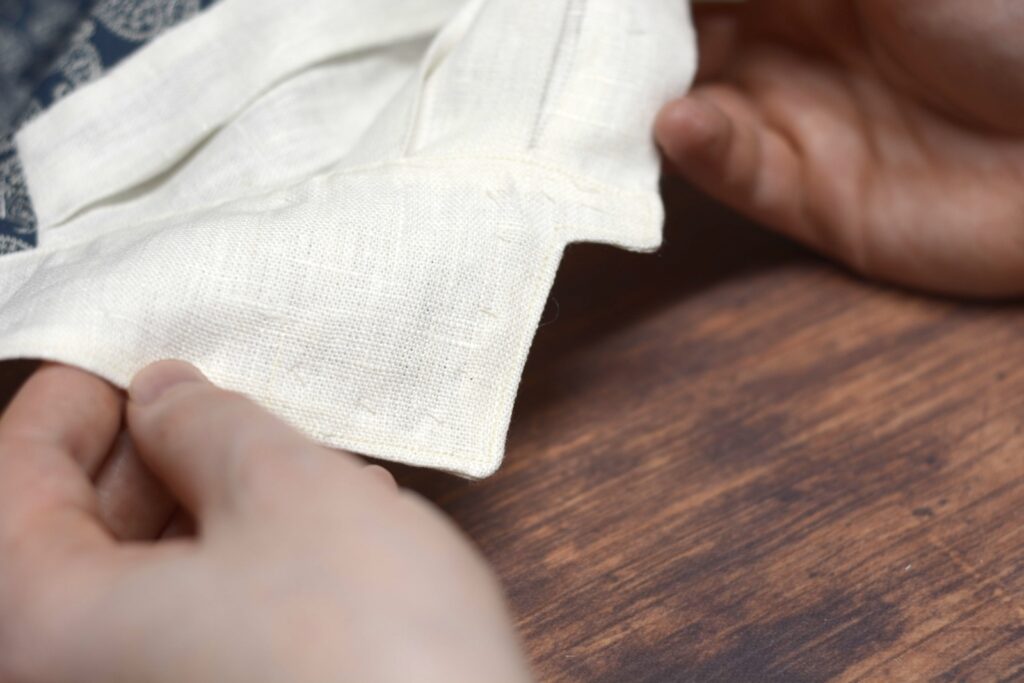
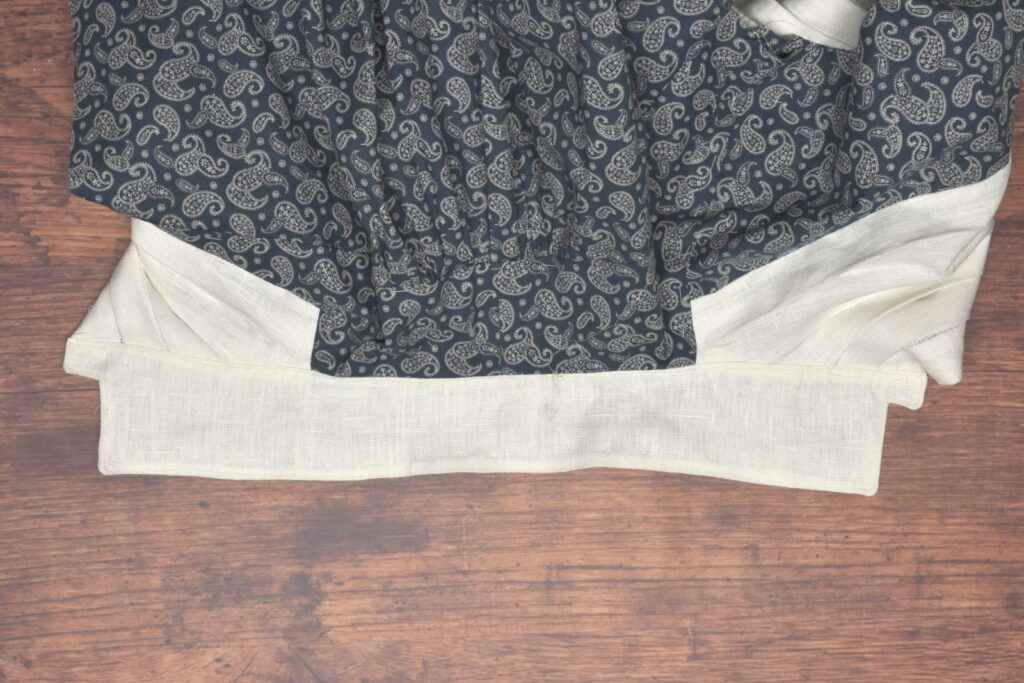
Your Progress
[columns gutter=”0″]
[col]
1 | Attach the outer collar. | |
2 | Attach the inner collar. | |
3 | Top stitch the collar. |
[/col]
[col align_text=”center, middle”]
[/col]
[/columns]
Side and Shoulder Seams
With the lining installed, it’s time to sew the side and shoulder seams together. Begin by laying the front on the back, right sides together, and align the side seam at the armscye.
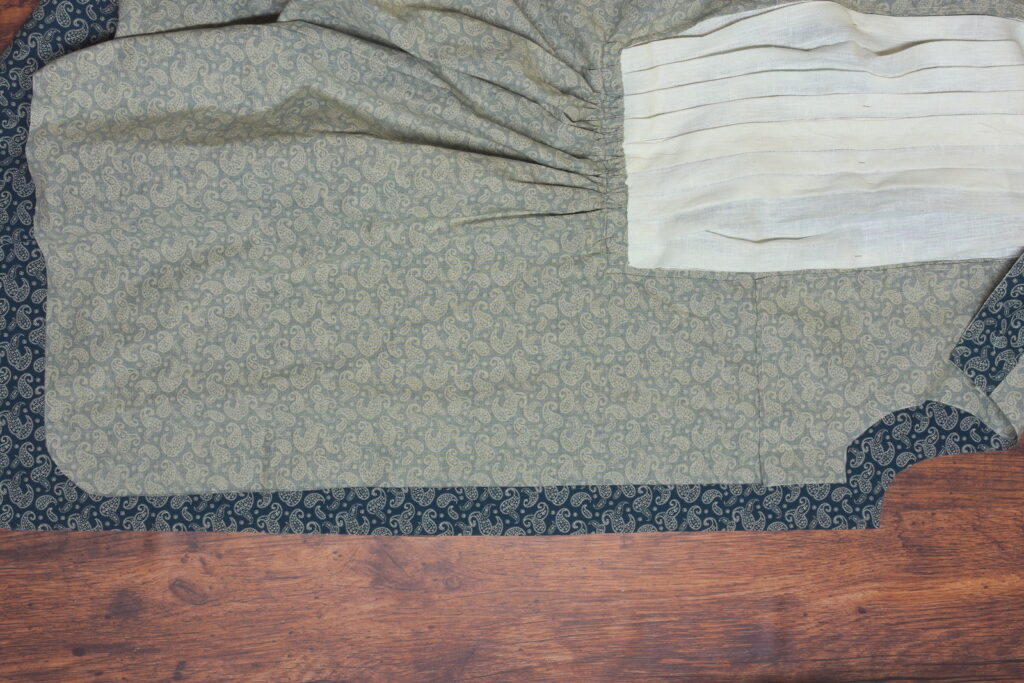
Taking the front only, pull back the edge of the lining at the armscye and pin in place, to keep it out of the way while sewing the side seam.
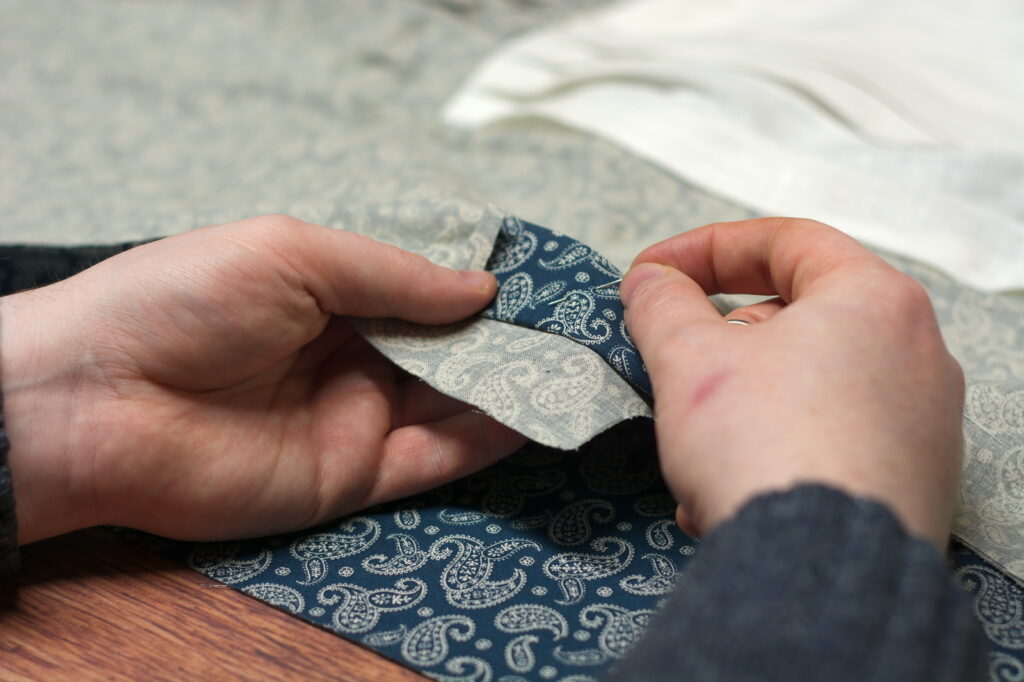
Pin the front to the back, right sides together, and aligning the side seam at the armscye.
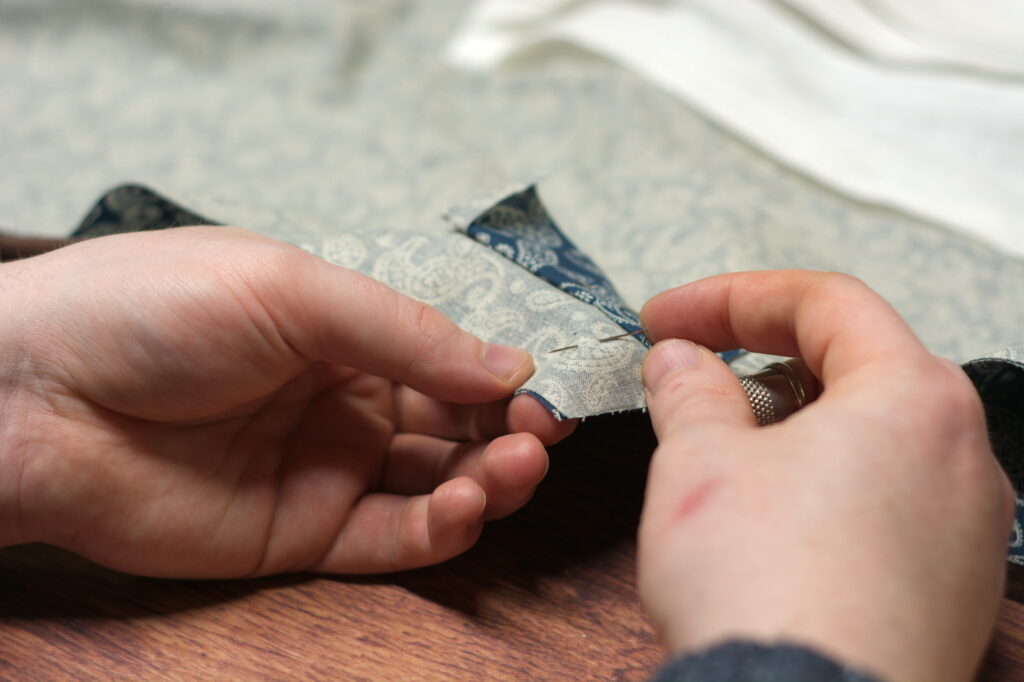
Continue pinning towards the bottom of the shirt, keeping an even, neutral tension between the two pieces.
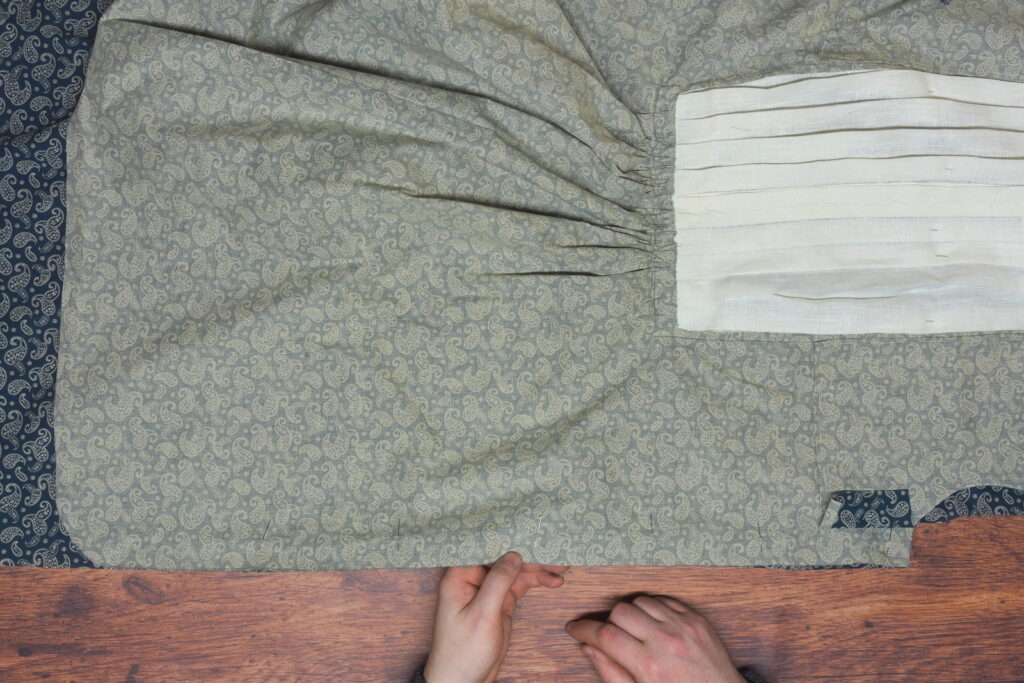
At the bottom of the front piece, make a small mark indicating the bottom of the stitch line, just at the point where the curve of the front ends.
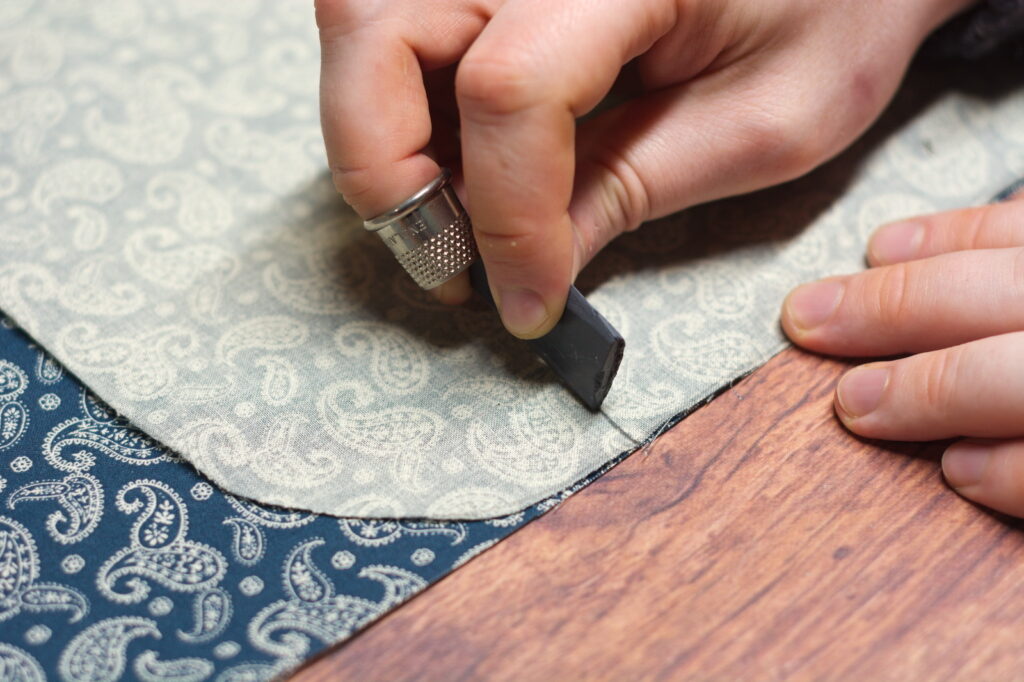
Sew the side seam from the armscye to the mark with a machine stitch or back stitch by hand using a 1/2″ seam allowance.
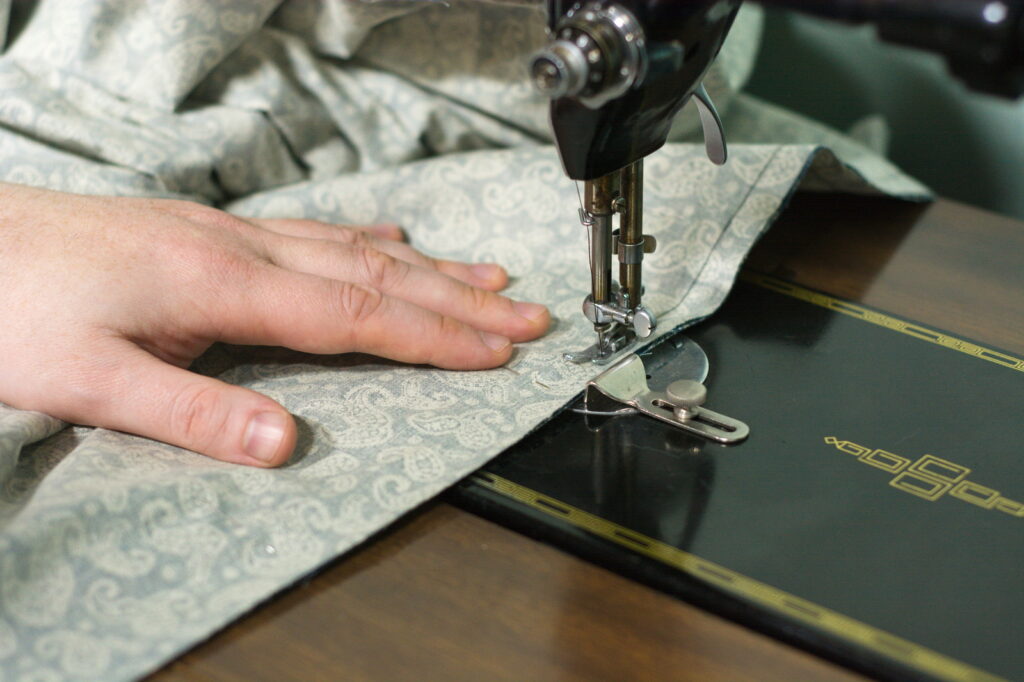
Here’s the seam so far. We’ll be pressing it later when we finish the raw edges and hem the bottom of the shirt.
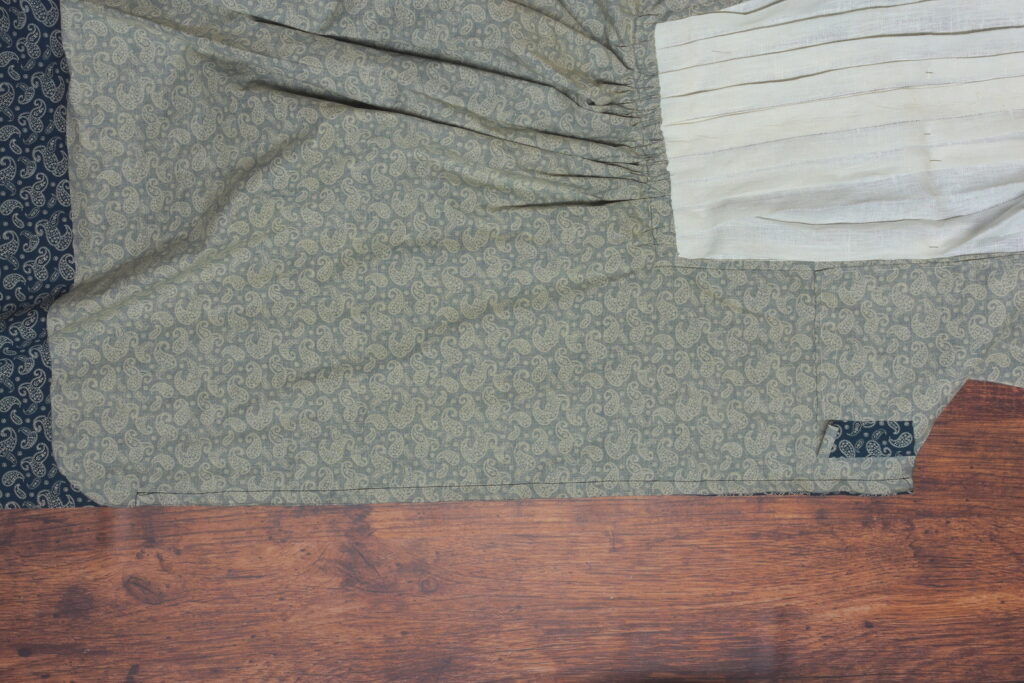
Shoulder Seam
Lay the shoulder seams right sides together.

Turn back the lining at the shoulder and pin to the front layer to keep it out of the way.
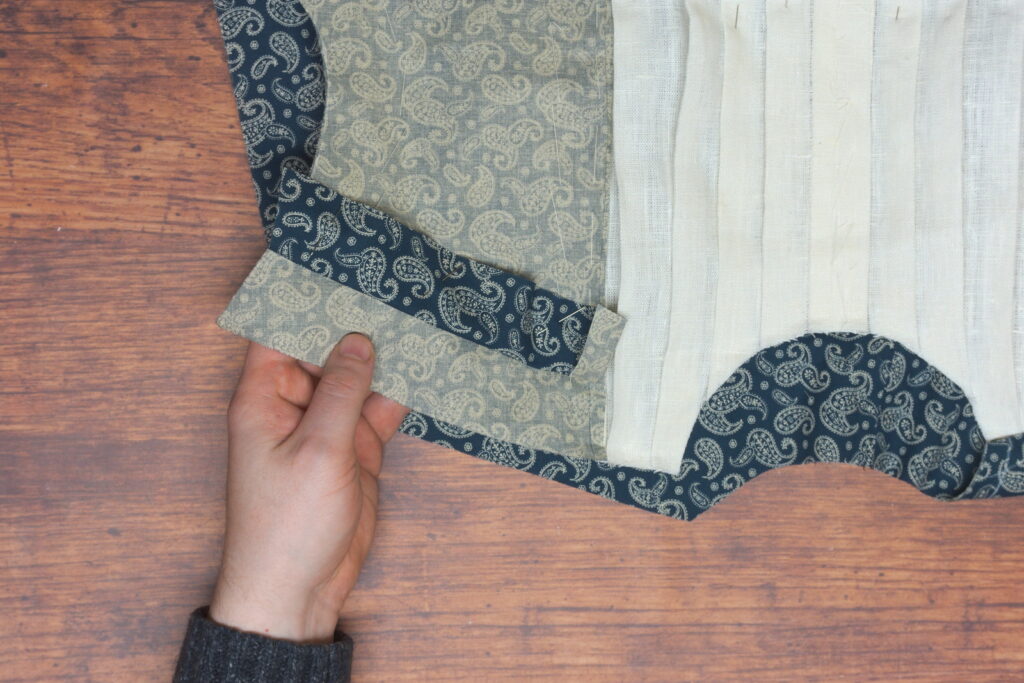
Turn the shirt over to the back side, and pull the back lining away from the shoulder as well, pinning it in place.
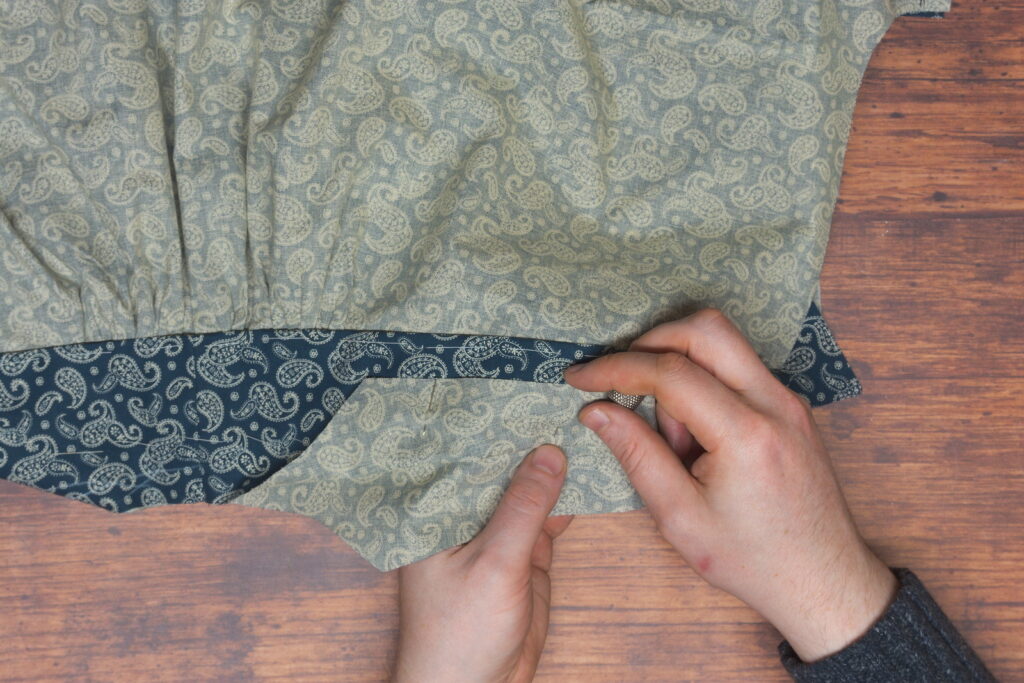
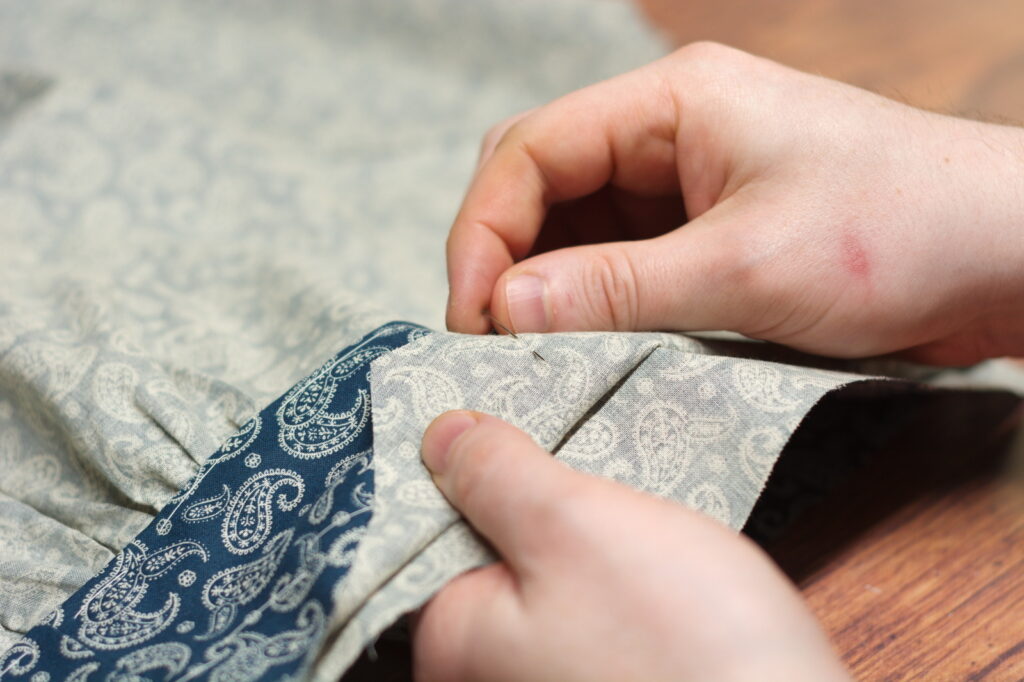
With right sides together and the linings out of the way, pin the shoulder seam at one end.
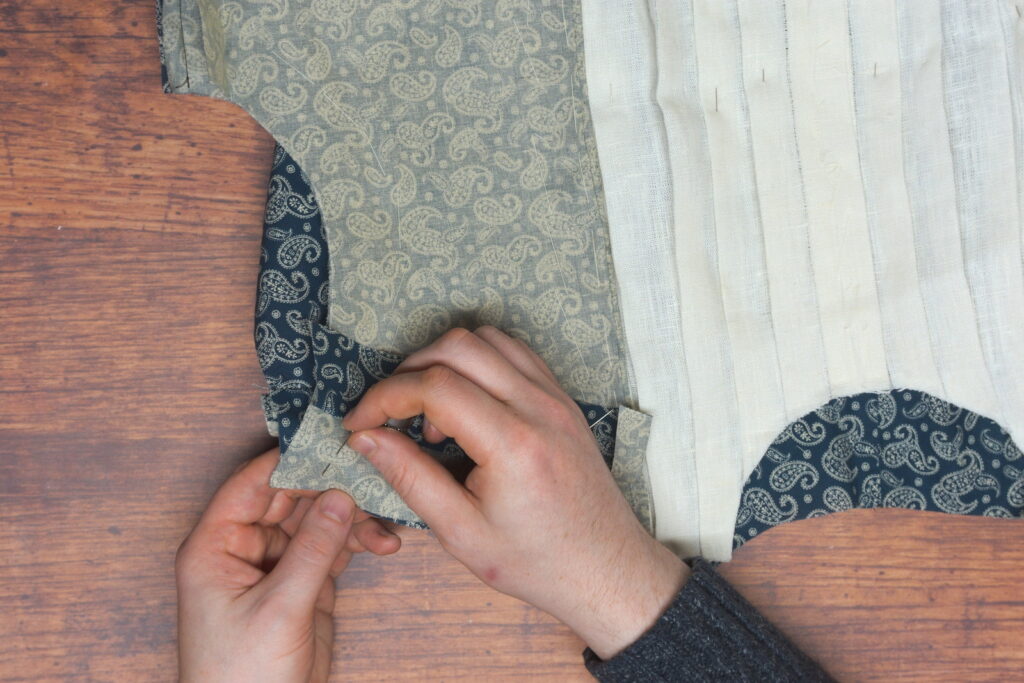
Note how I’m aligning the seams so that the ends of the seam lines meet at 1/2″ from the edge. I usually just do this by eye but if you’re more of a beginner you could measure until you develop your rock of eye further.
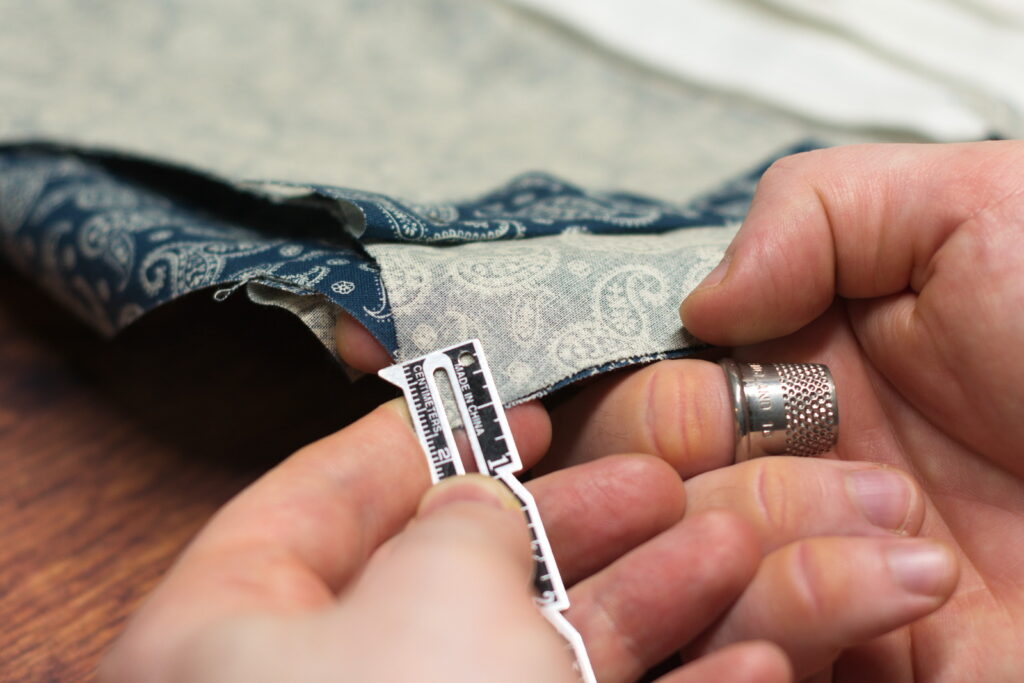
Pin the other end of the shoulder seam at the neck, aligning the seam lines as before.
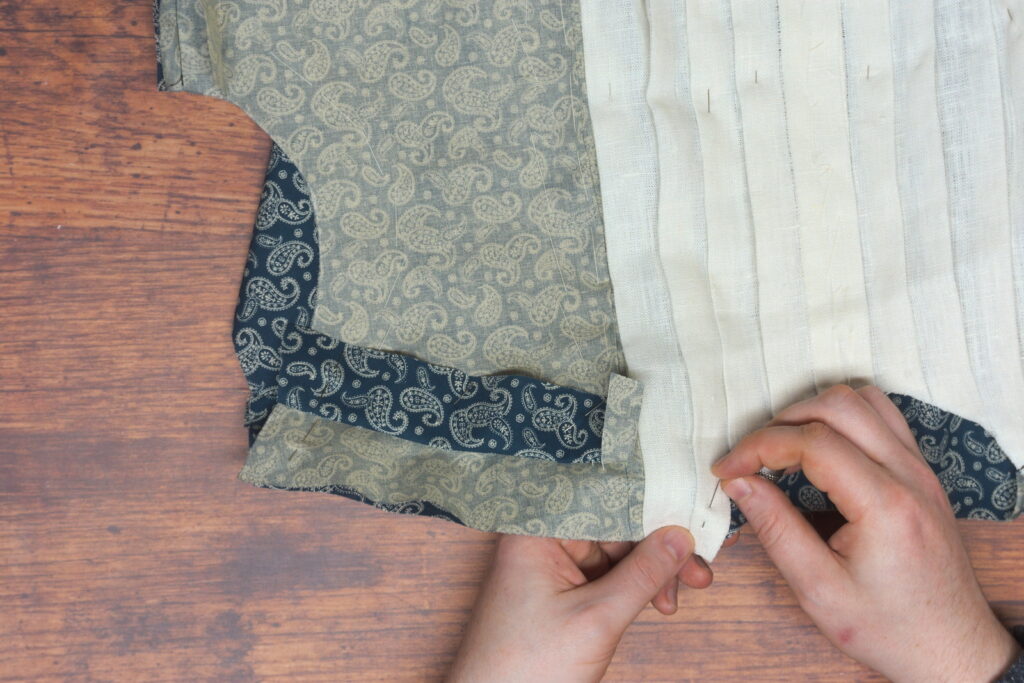
Now pin the rest of the shoulder seam, first in the middle, and then between each of the three pins, subdividing any fullness that may be in the seam.
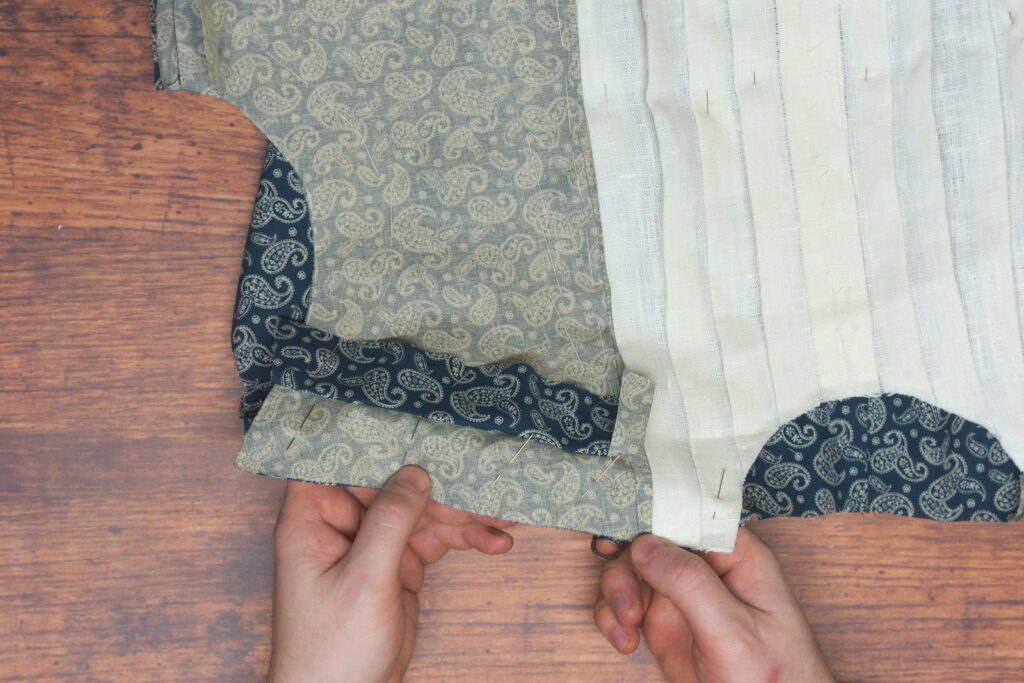
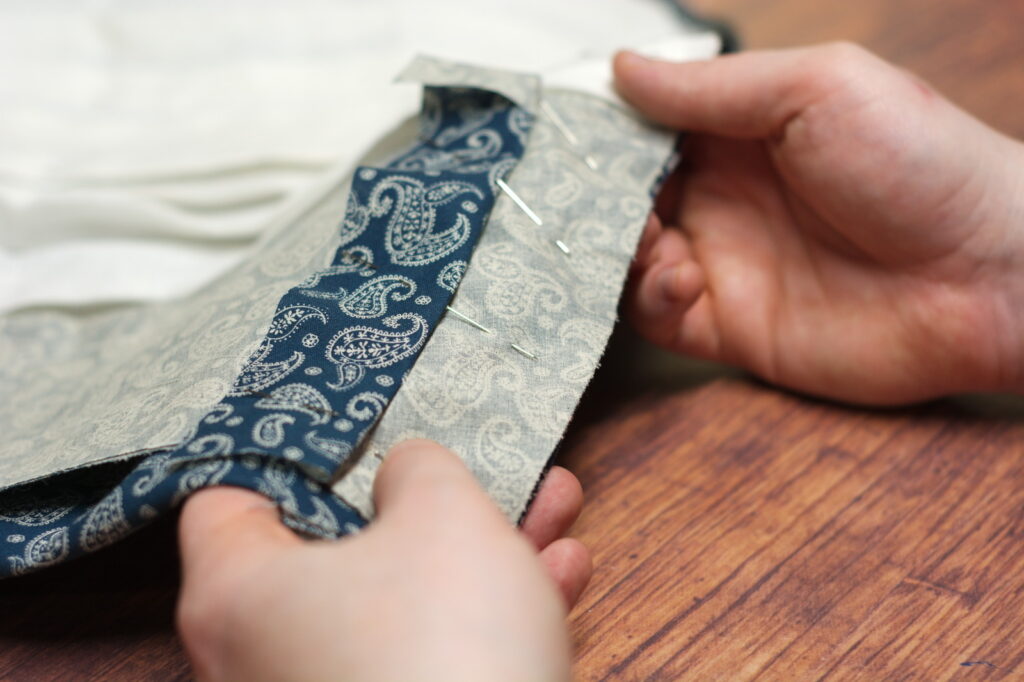
Sew the shoulder seam using a 1/2″ seam allowance.
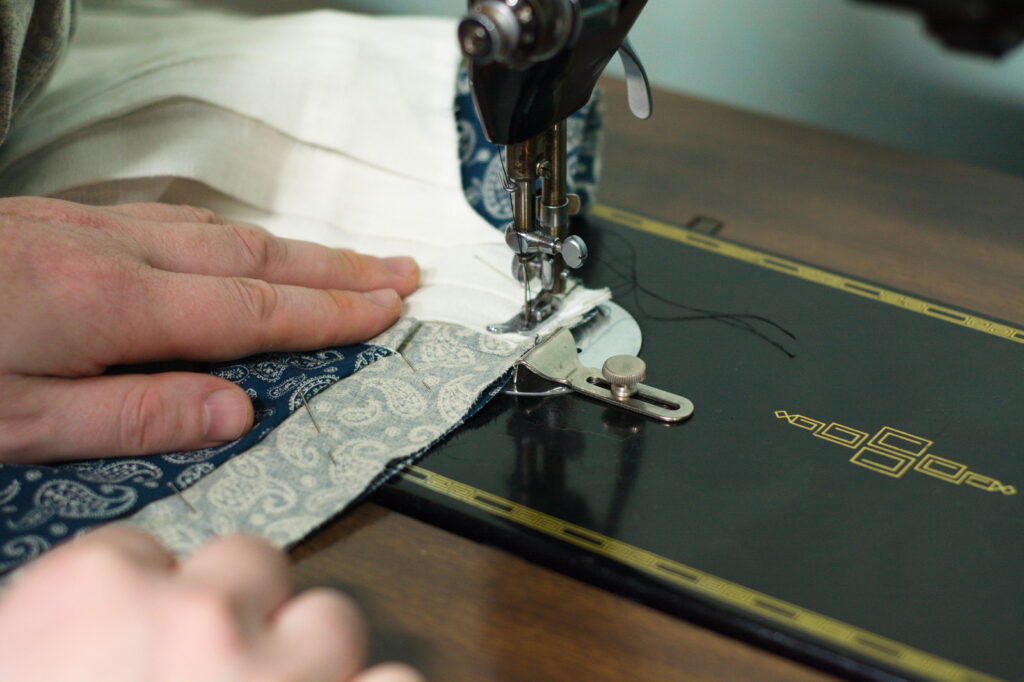
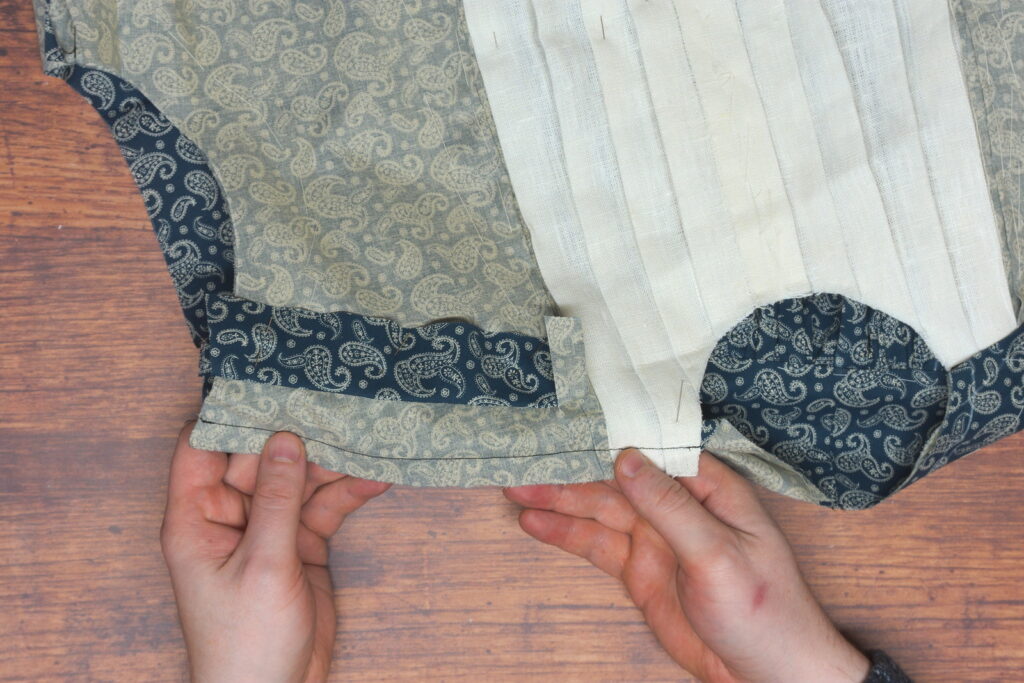
Here’s how my shoulder seam ended up aligning after sewing. I think something must have slipped, one reason I prefer to baste my seams most of the time. For this shirt though, this is close enough.
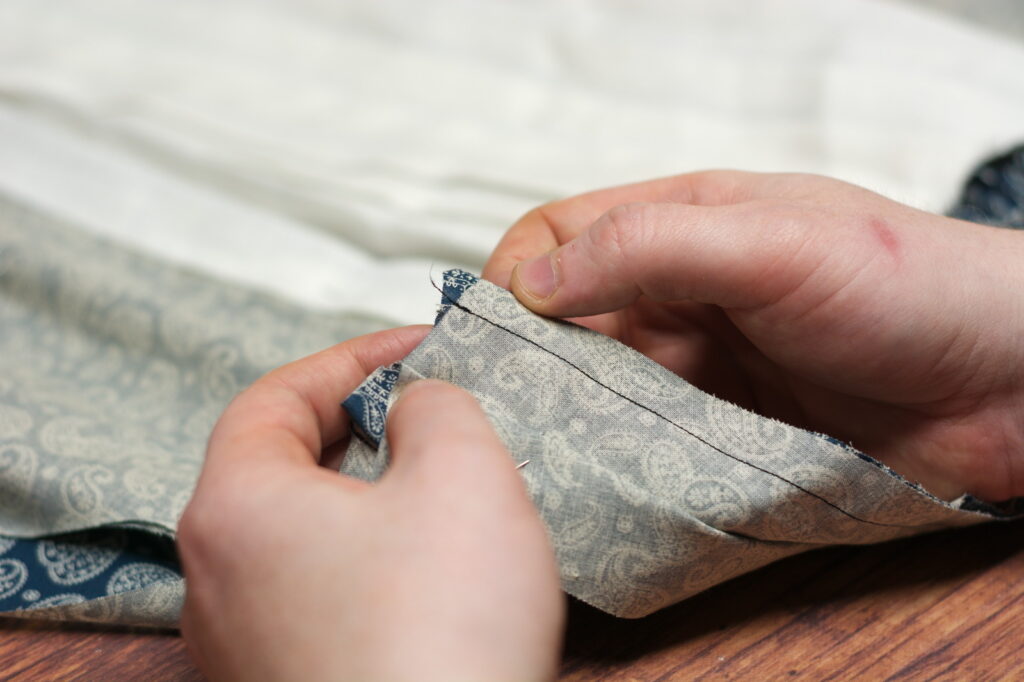
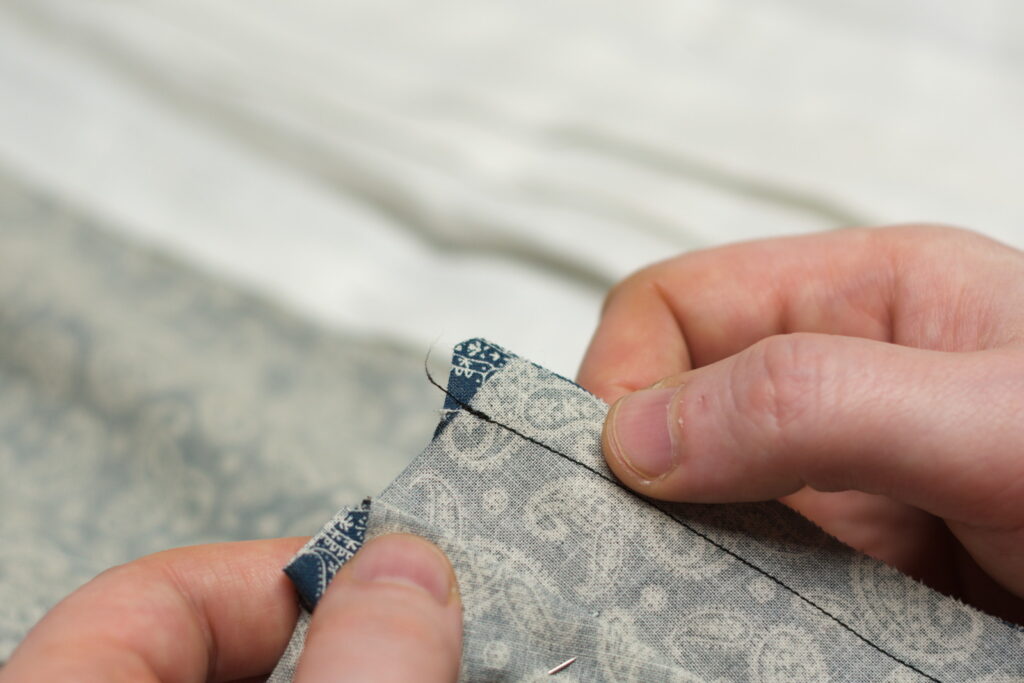
Pressing
This is slightly confusing to look at, but press the shoulder seams toward the back of the shirt, keeping the linings out of the way.
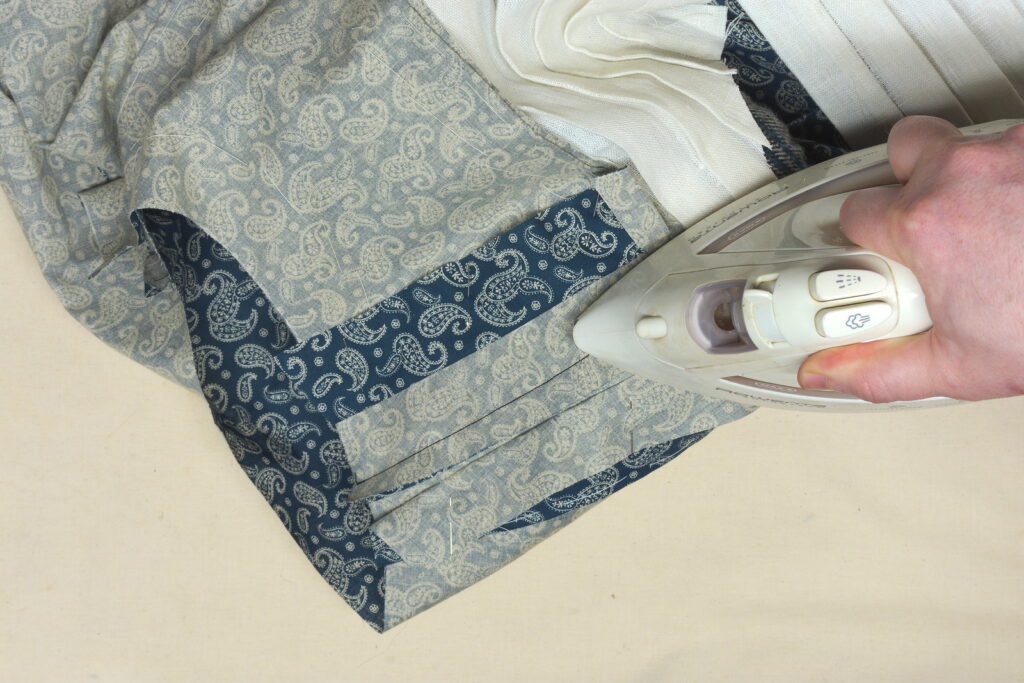
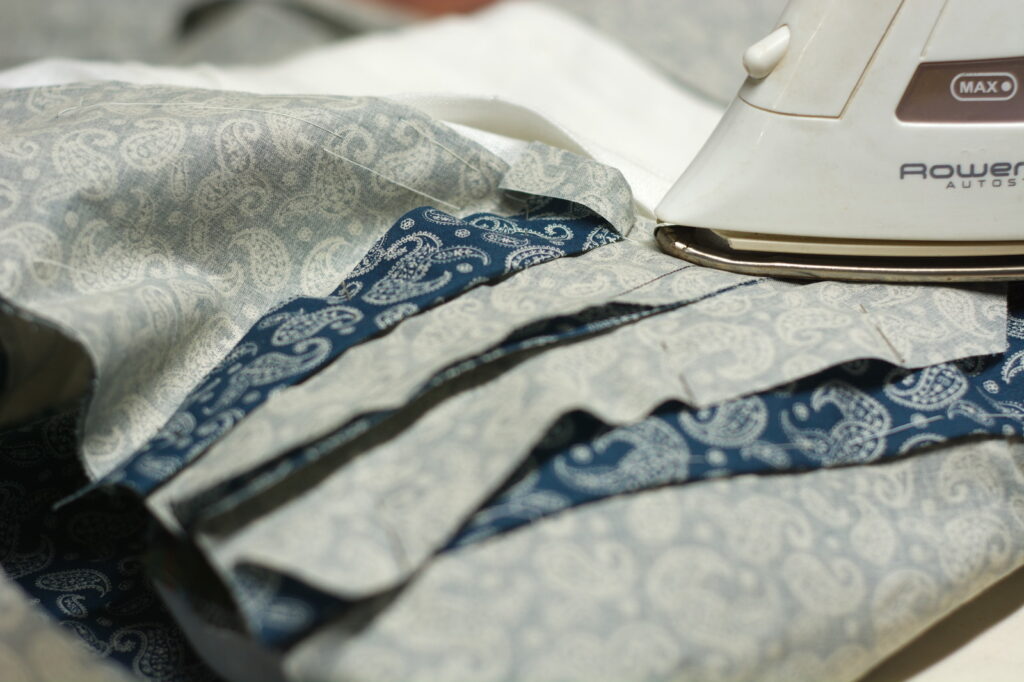
Now fold the front lining in place over the shoulder seam. It should just rest naturally and freely.
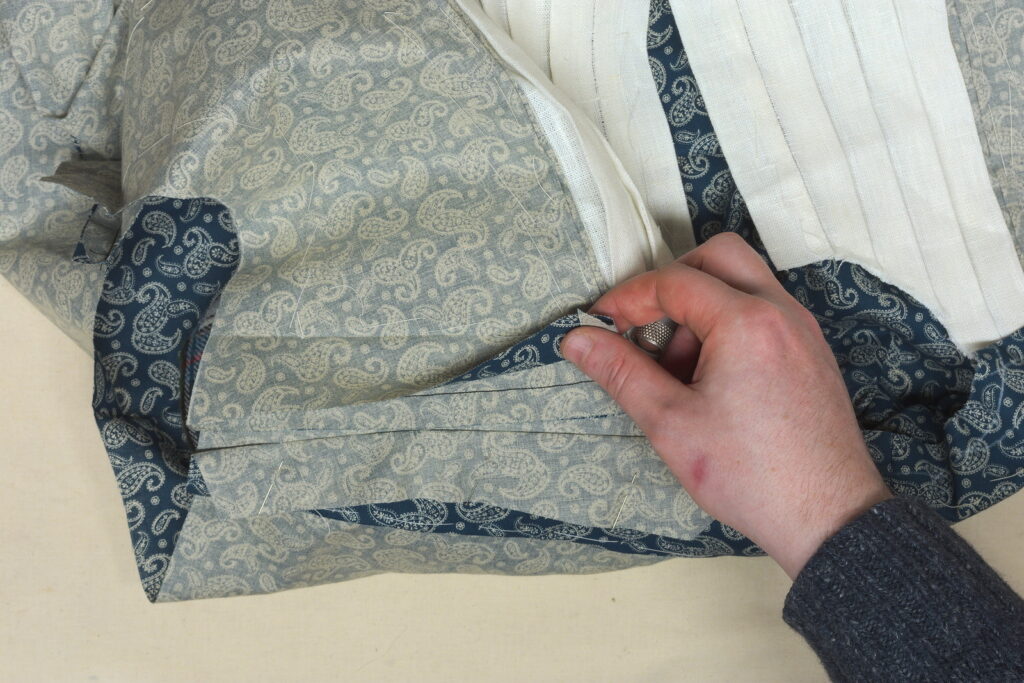
And lay the back lining over the top of the shoulder seam, sandwiching the front lining in between.
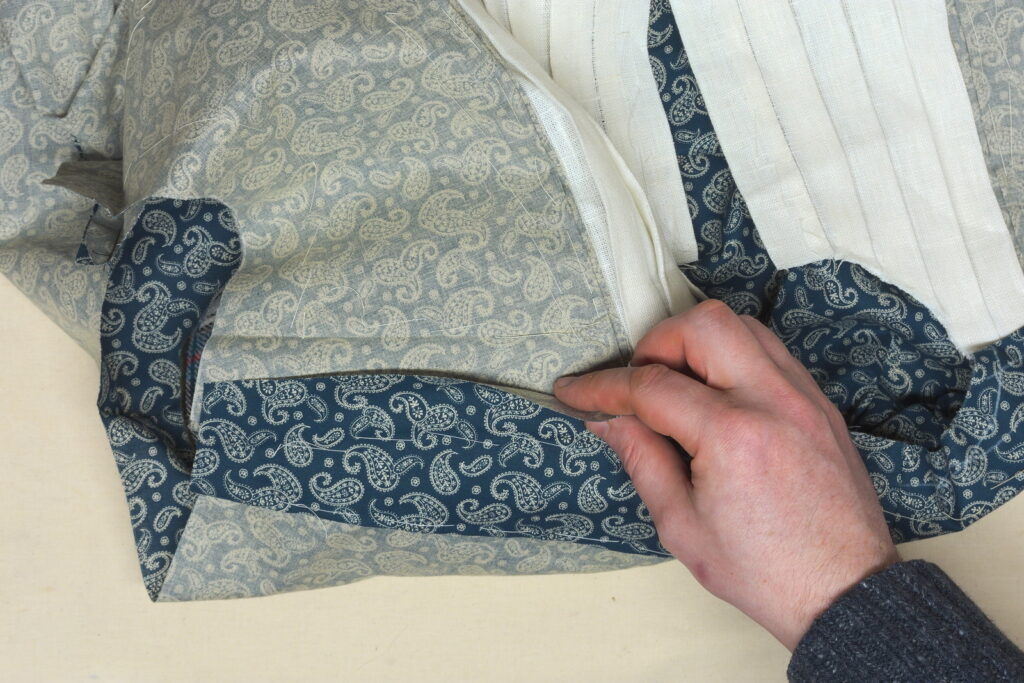
Fold under the raw edge of the back lining at the shoulder seam, aligning it carefully with the shoulder seam underneath. You should be able to feel the seam through all the layers with your fingers.
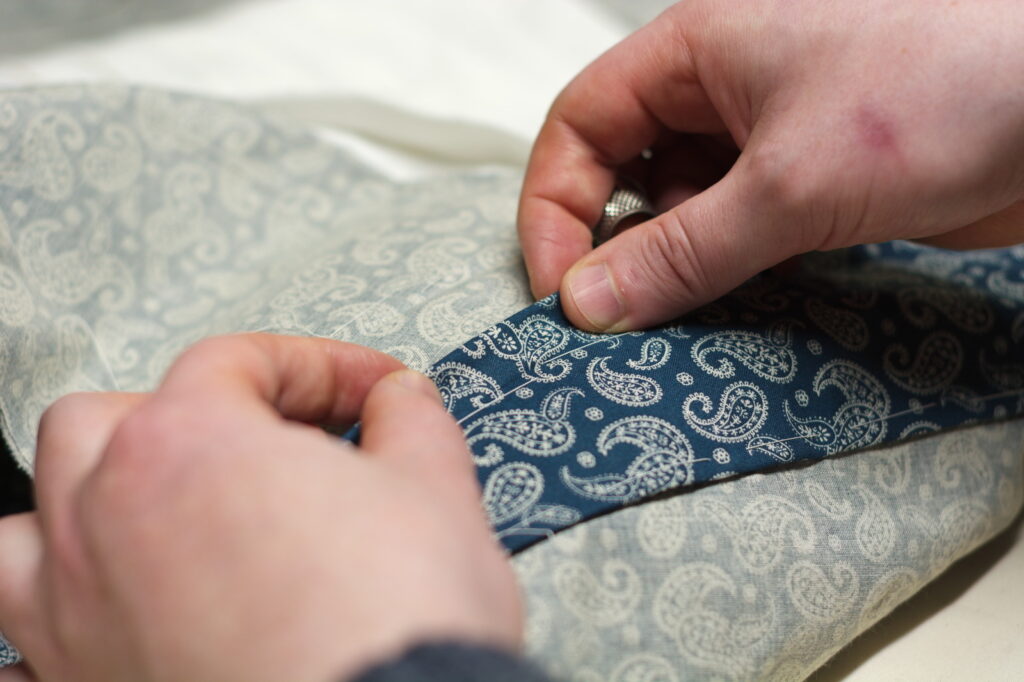
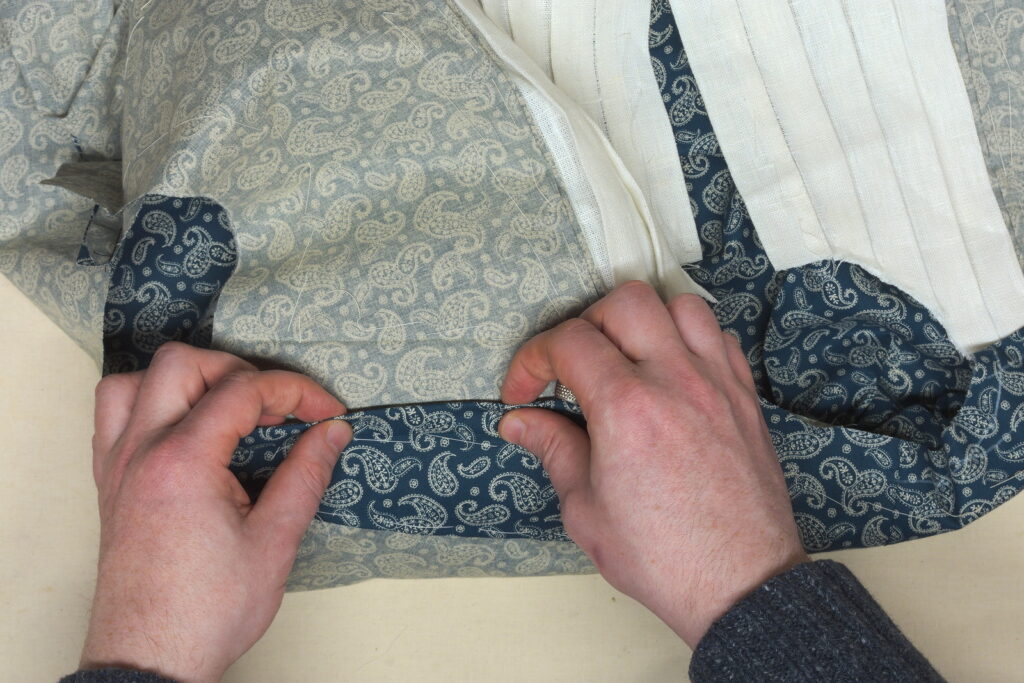
Give the shoulder lining seam a good press to keep it in place.
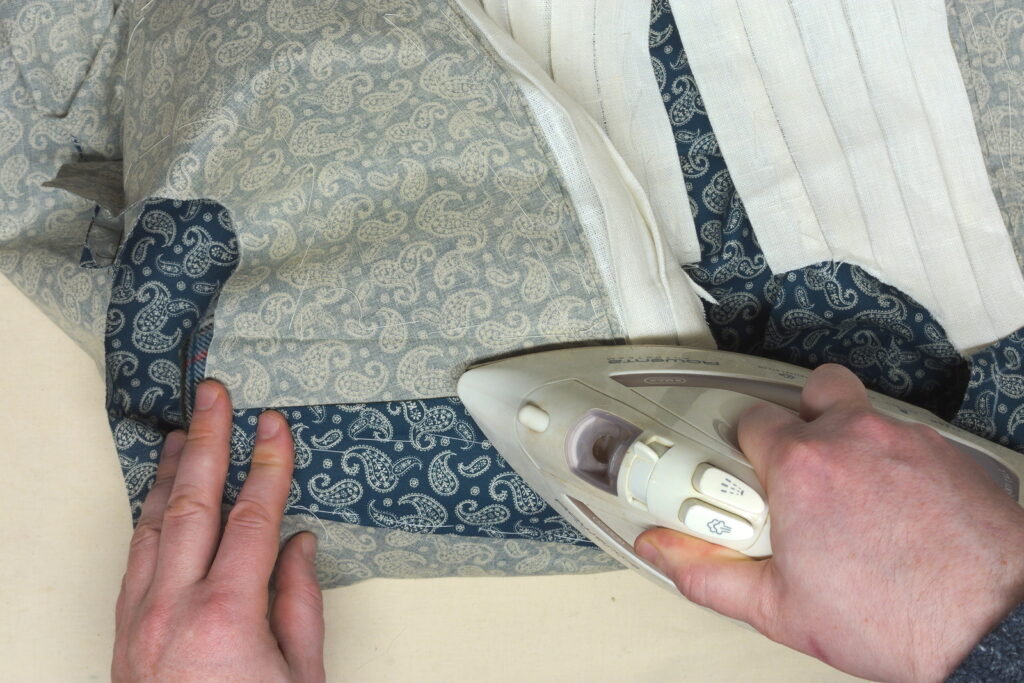
Finally, baste the lining closed at the shoulder seam.

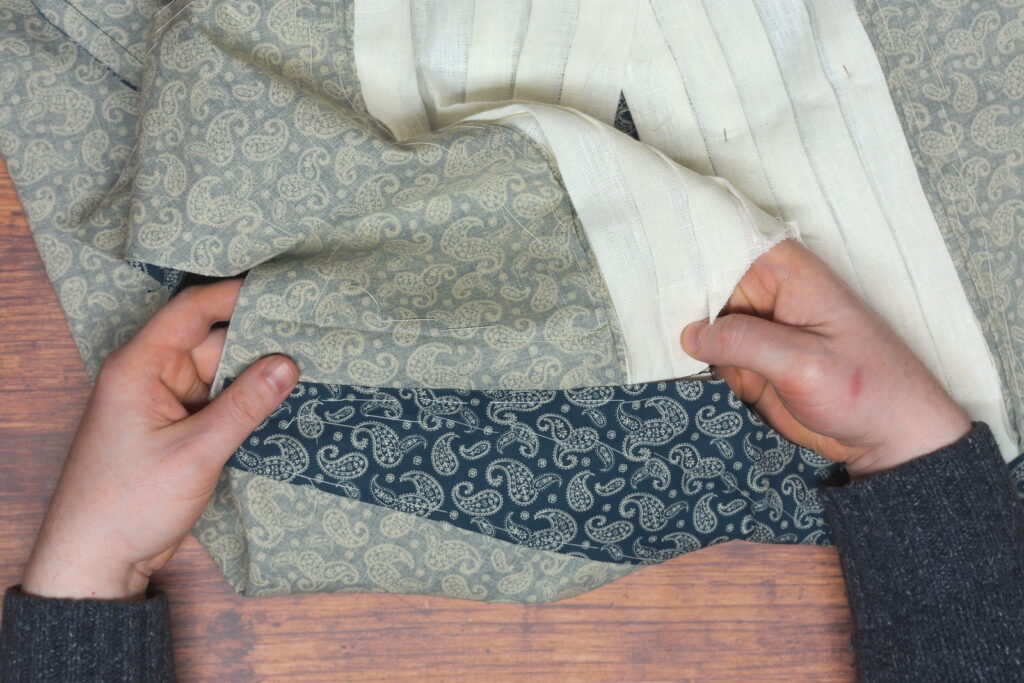
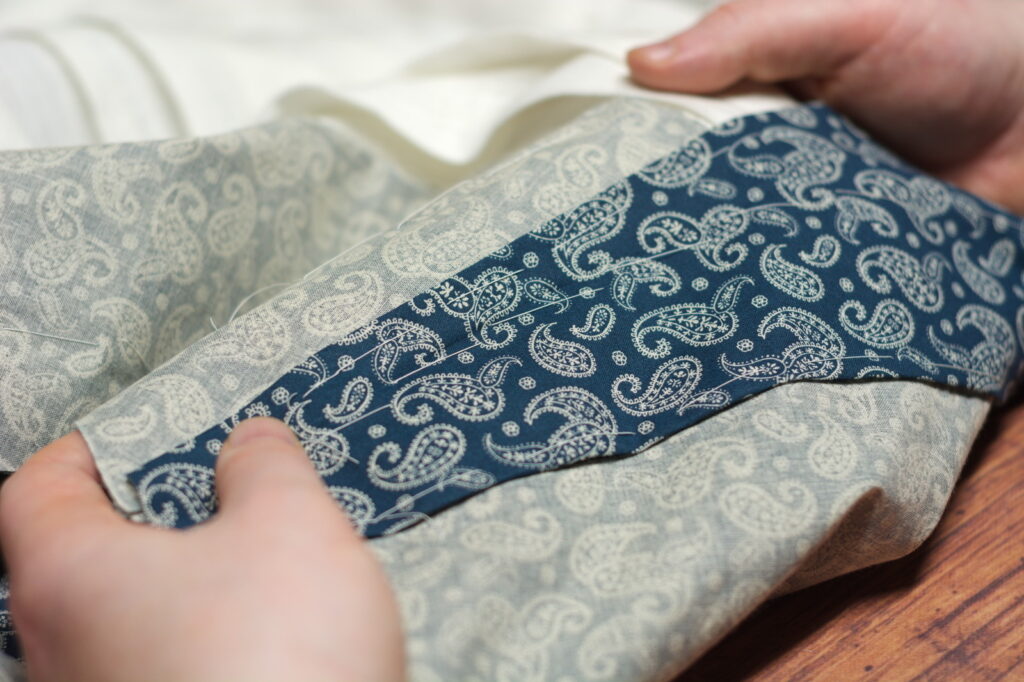
Your Progress
[columns gutter=”0″]
[col]
1 | Sew the side seams. | |
2 | Sew the shoulder seams. |
[/col]
[col align_text=”center, middle”]
[/col]
[/columns]
Installing the Lining
Shirts during the 19th century often had a lining in the front and back of the shirt, I’m guessing to help strengthen certain areas. The exact shape could vary from shirt to shirt, so I’ll be using a basic pattern for the front and back linings – feel free to alter the shape. In this lesson we’ll baste the linings into position while the shirt is still flat, and fell the edges later on after the sleeves have been attached.
Begin by tracing out the front onto a fresh sheet of paper, not including the pleated front area. Trace around the shoulders, armscye, and side of the pleated front, and then square across about 3 or so inches below the armscye for the bottom of the front lining pattern.
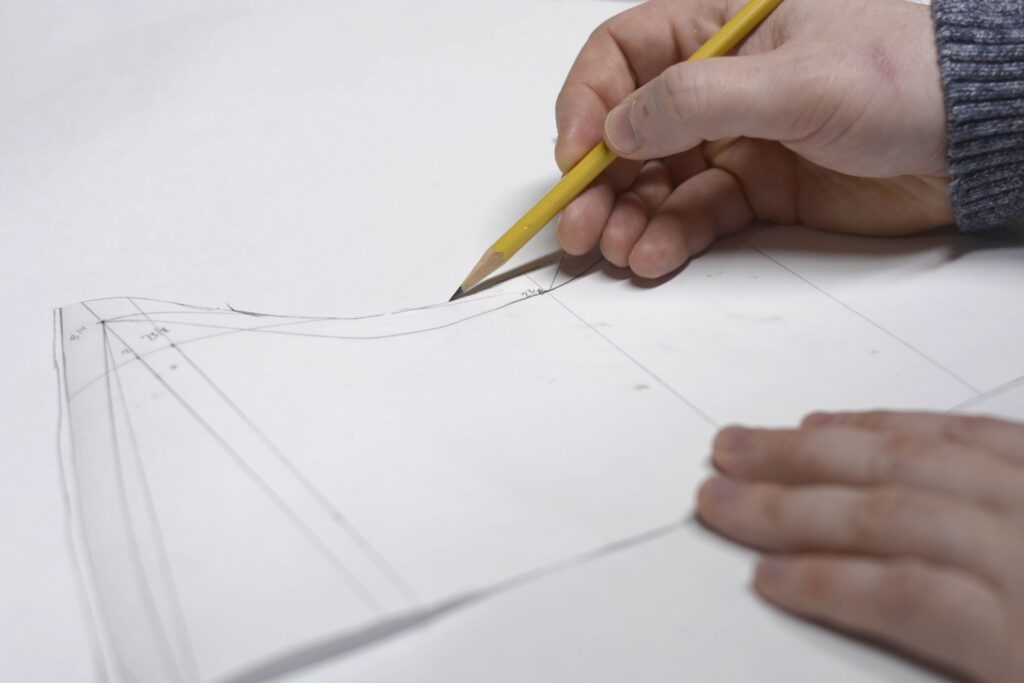
Add a 1/2″ seam allowance to the vertical line at the side of the pleated front. The other edges already have seam allowances included except for the bottom edge, where you can add one or just include the seam allowance as you draw the bottom edge, as I’ve done.
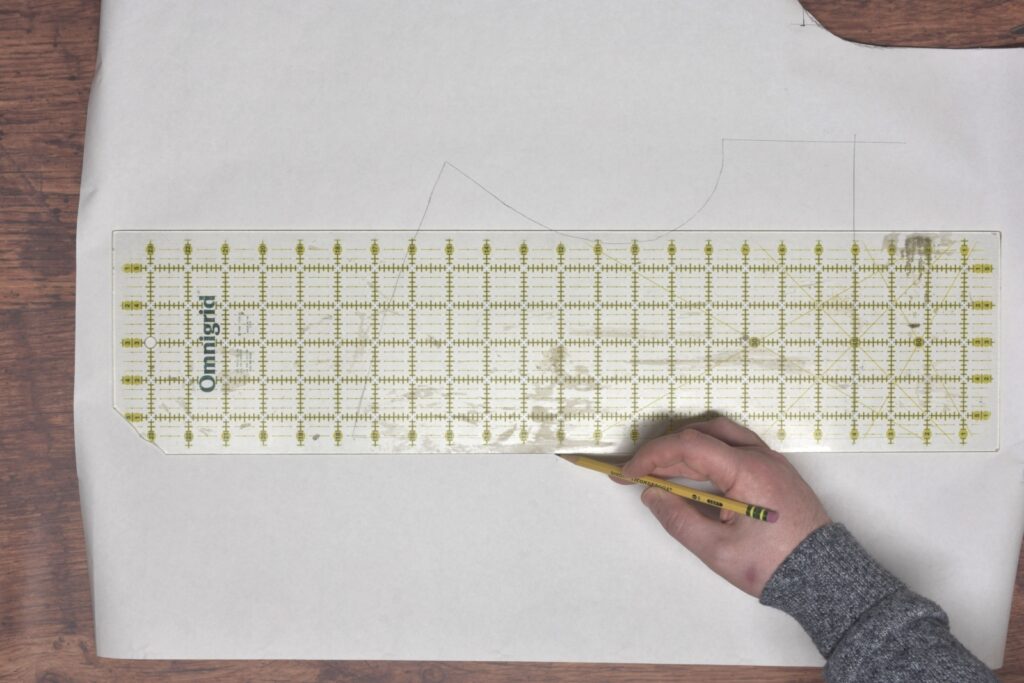
Here’s the completed front lining pattern. The back lining is identical to the yoke.
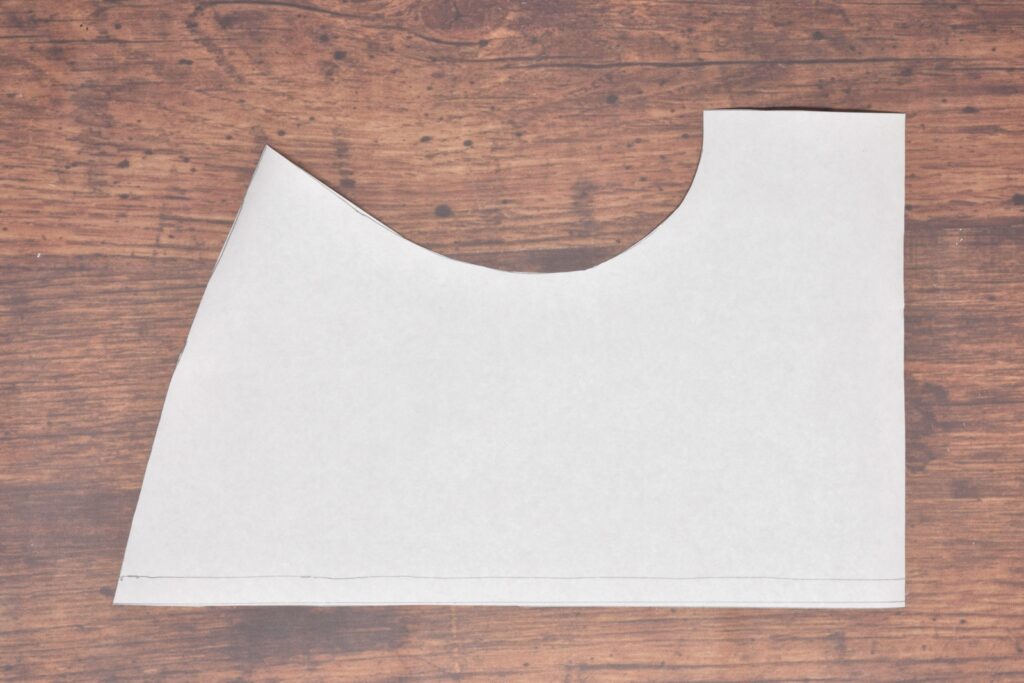
I was able to cut my front lining out of the excess fabric previously cut away from the pleated front area. I suspect this will work for any size, seeing as how the pattern is so proportional.
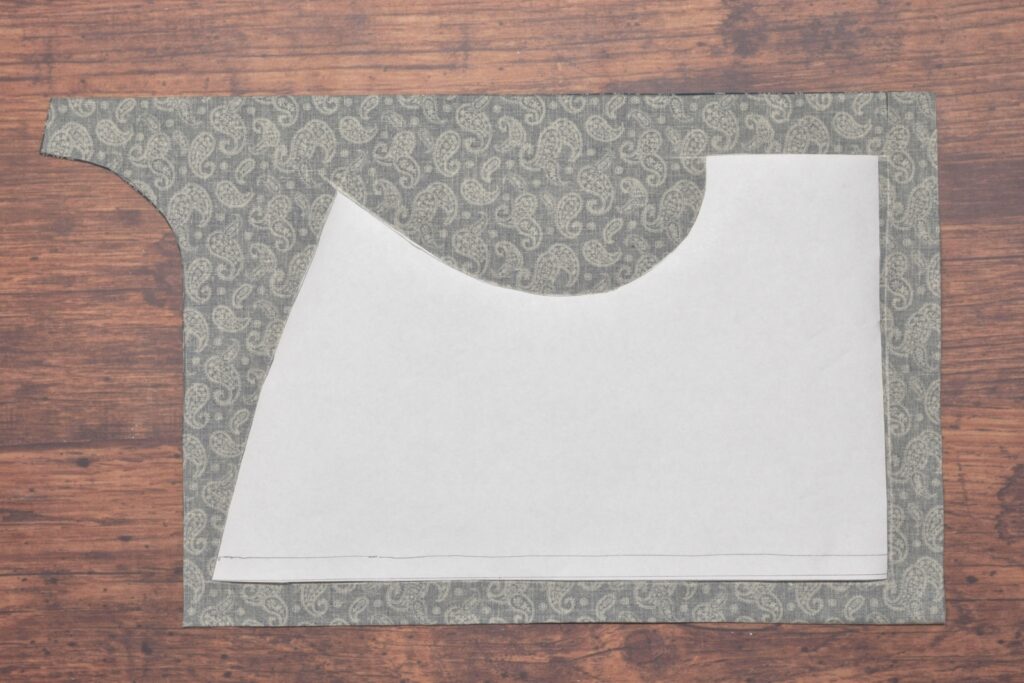
Here are the pieces for the shirt lining all cut. The back lining is identical to the yoke. However, before sewing it together, figure out which side of the lining you want facing towards you, and sew the back lining together with the appropriate sides facing each other. I’d originally wanted the wrong side facing towards my skin, but I sewed the seam right sides together which gave me the opposite result I was looking for – should have sewed it wrong sides together.
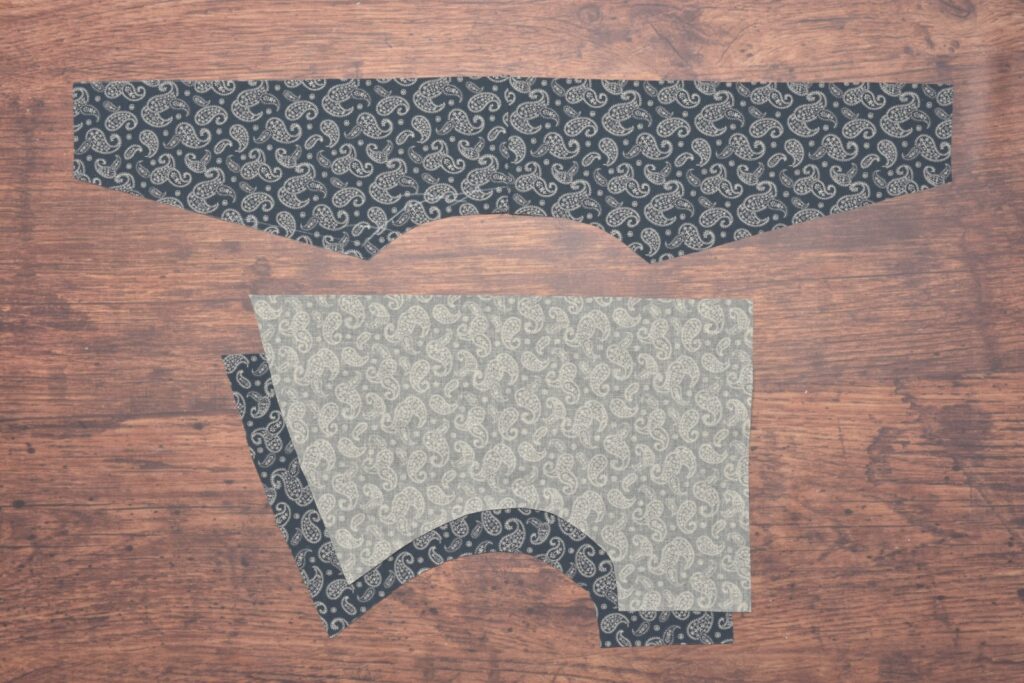
Place the front lining into position on the wrong side of the shirt, aligning the outer edges, and ensuring you have about 1/2″ overlap in the pleated front area. I chose to have the wrong side facing up so that if the shirt fabric wore through, the lining would still match underneath.
Baste the lining to the shirt, keeping your stitches at least 1″ away from the edge so they can be folded out of the way while sewing the various seams.
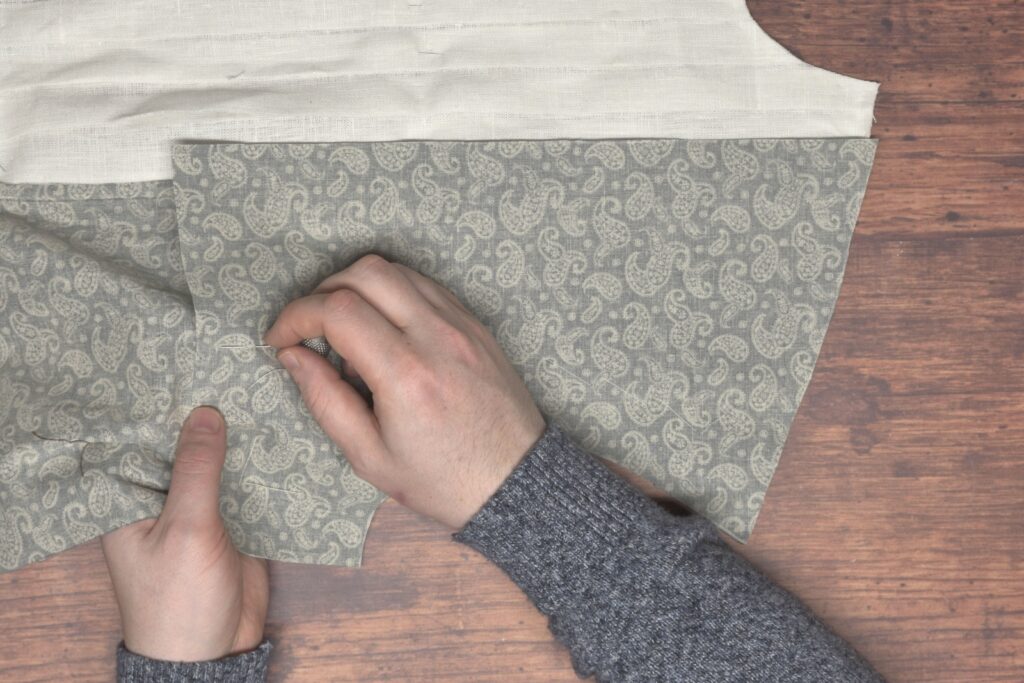
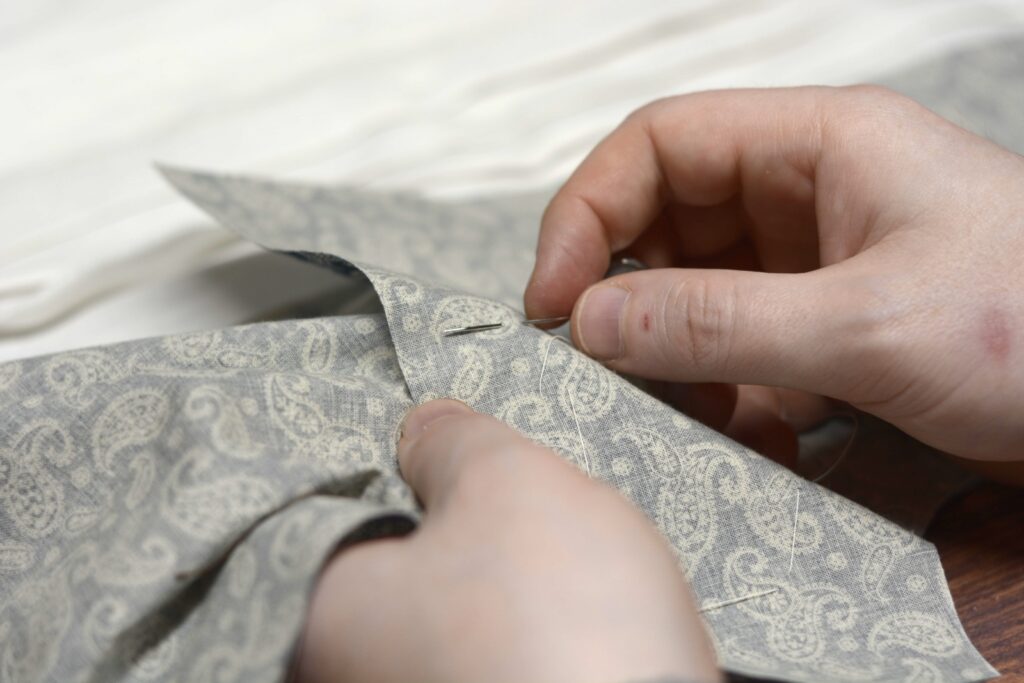
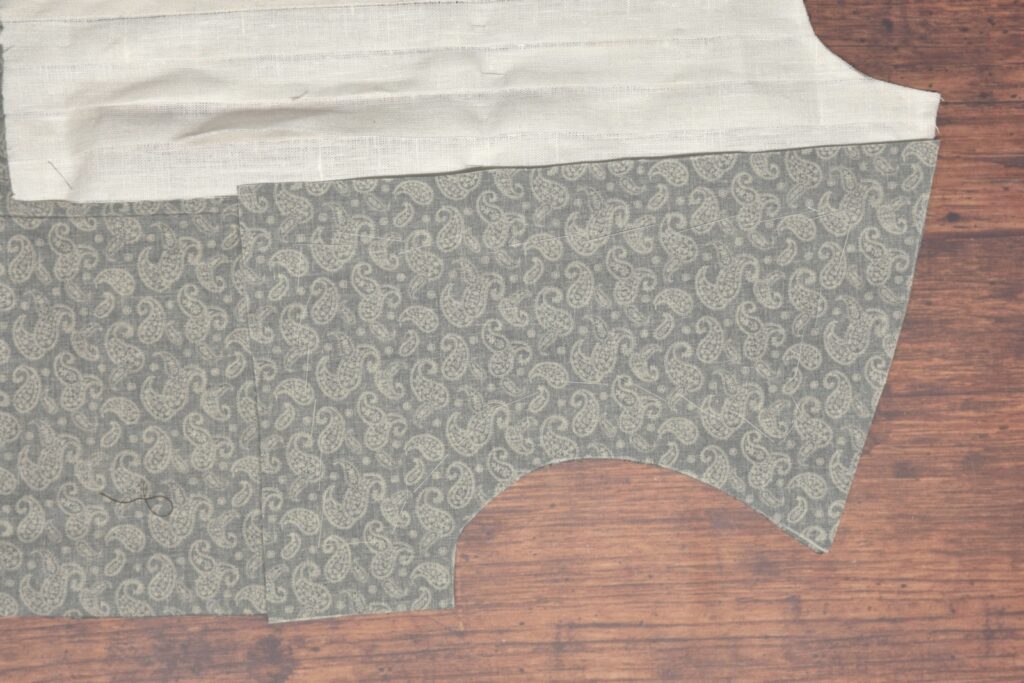
Now fold under the seam allowance at the pleated front and bottom edges. I kept the fold just past the stitch line of the pleated front.
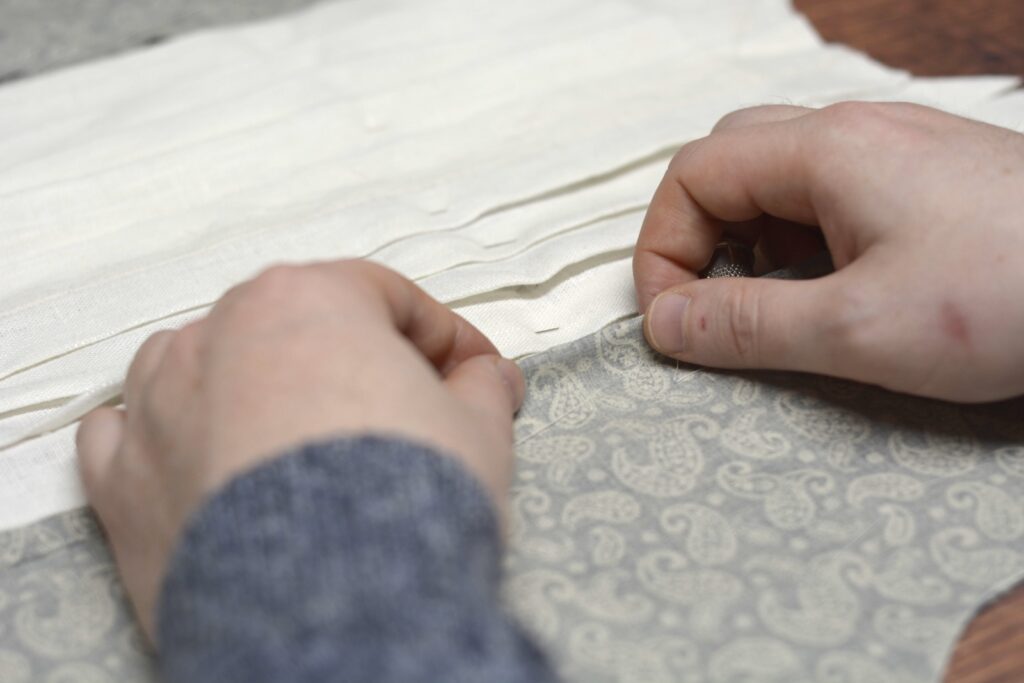
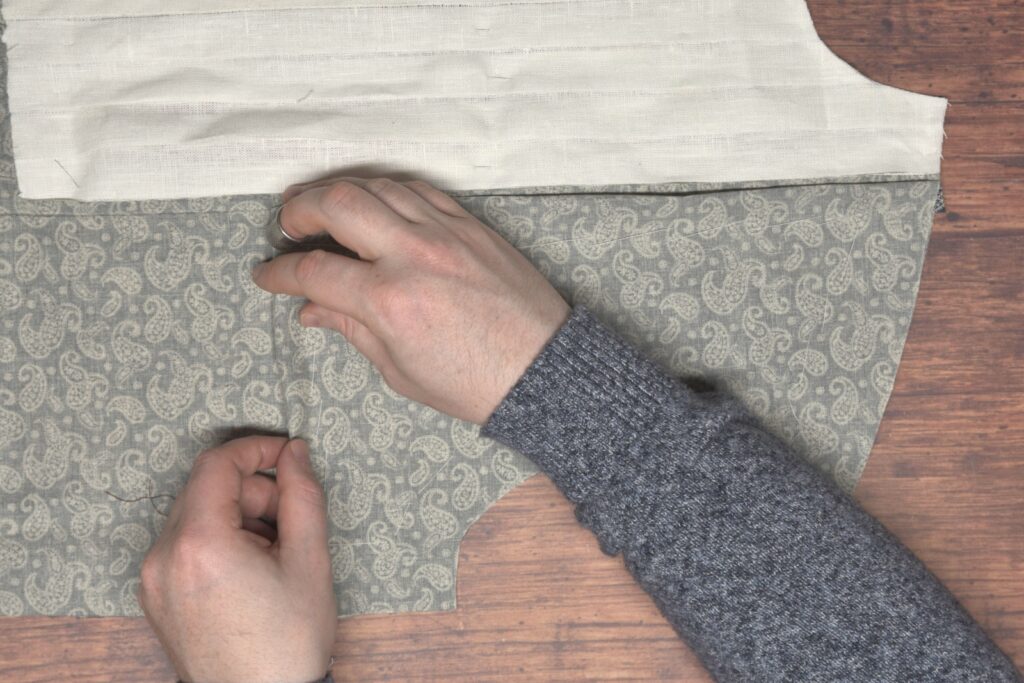
Baste the folded edges to the shirt using a straight basting stitch. Keep the stitches 1″ away from the shirt’s edges.
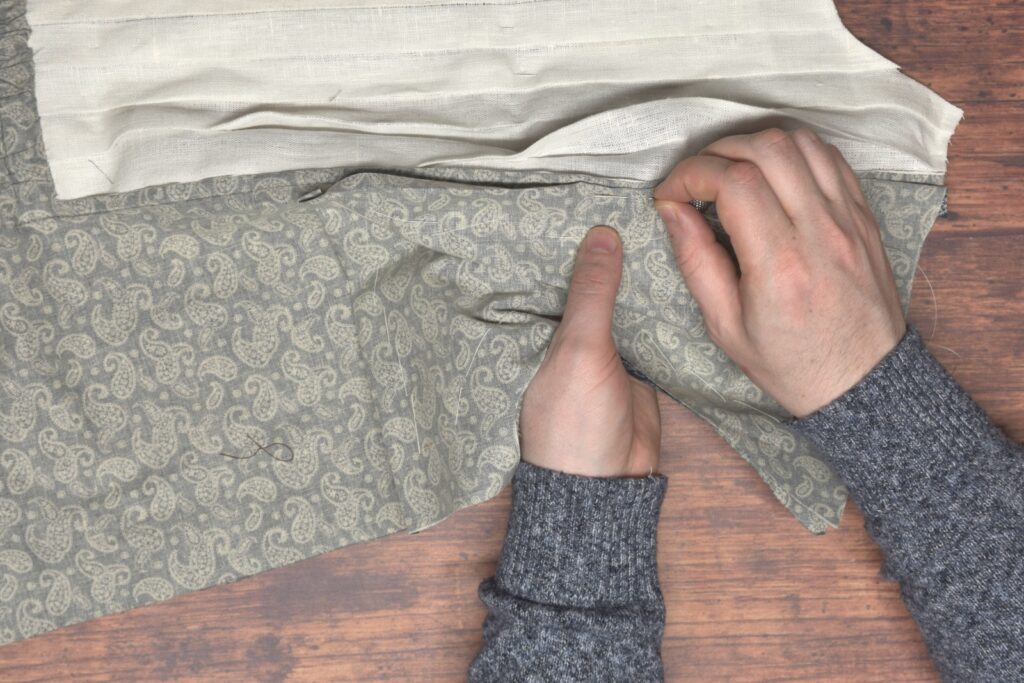
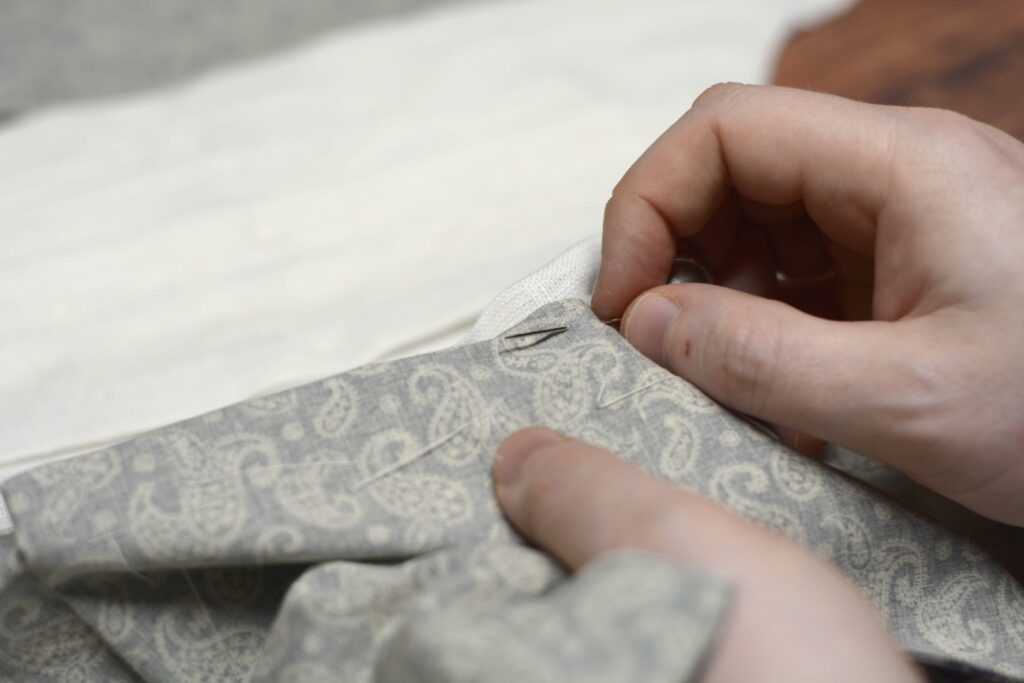
Here’s the lining basted in place.
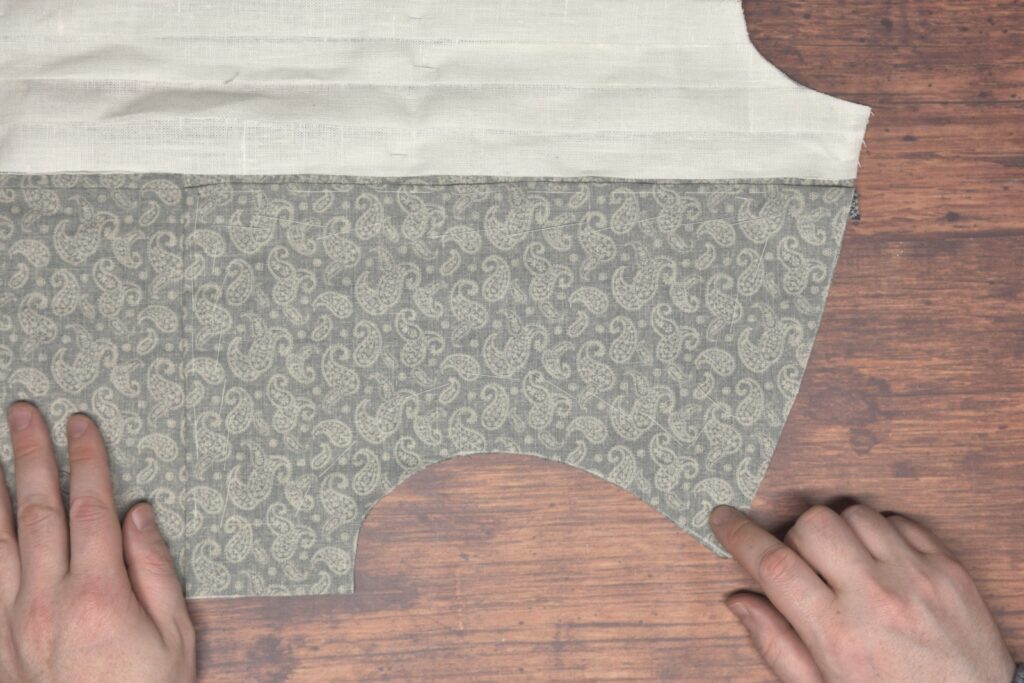
Turning to the back, place the back lining onto the yoke and baste across the upper edge, again keeping 1″ from the edge. You can see here how I should have sewn the lining wrong sides together so that the seam and pattern would have been on the inside. I chose just to work with my mistake instead.
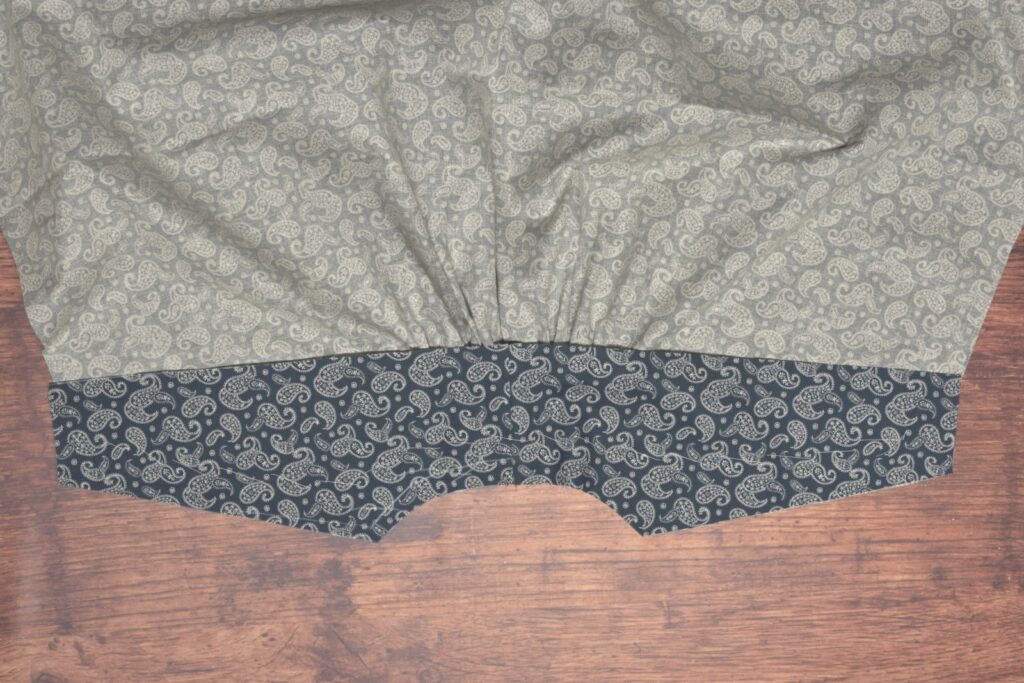
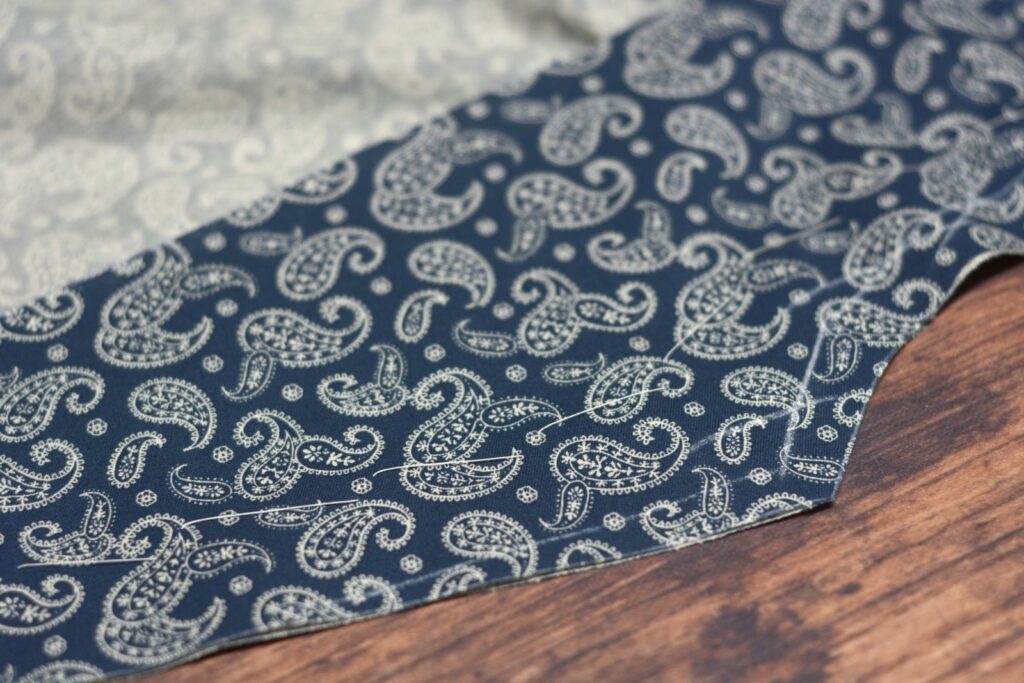
Turn under the bottom edge of the lining so it just covers the seam underneath, and baste closed, keeping the stitching 1″ from either end.
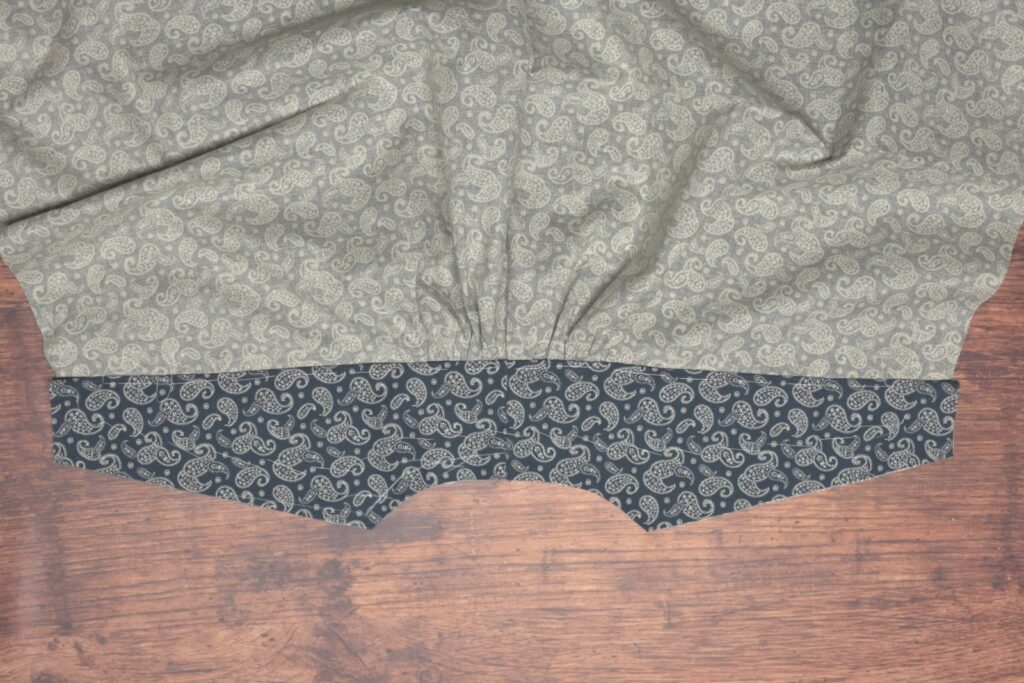
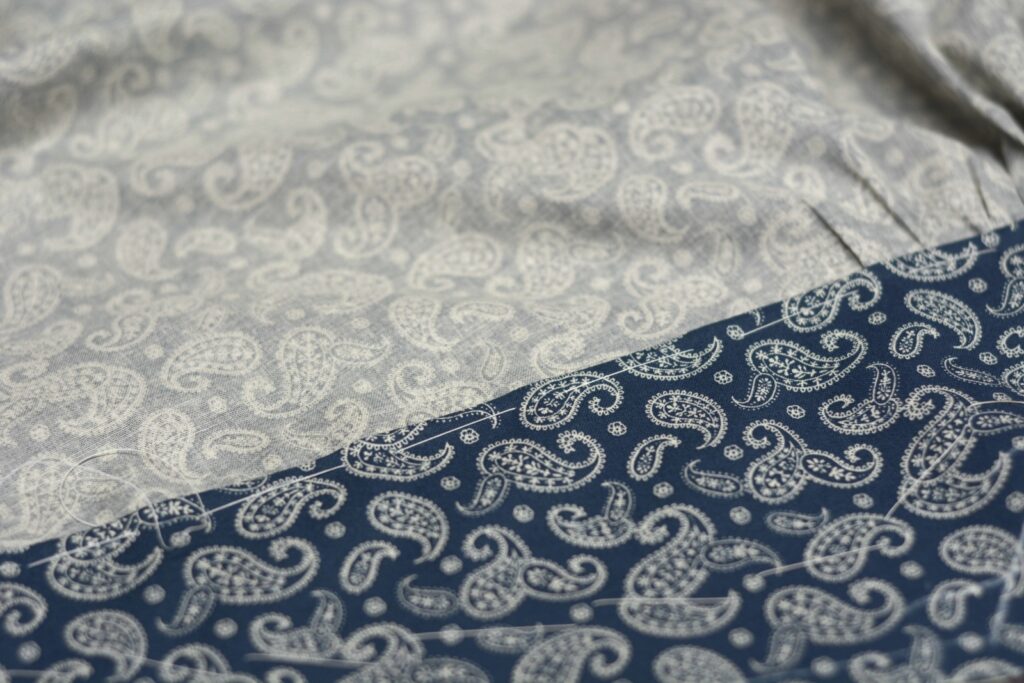
It’s important to be able to turn and pin back the lining edges on the various seams to aid in construction later on. Basting the lining in now however saves us a lot of trouble fitting and fiddling with the position of the lining if we were to wait until later to install it.
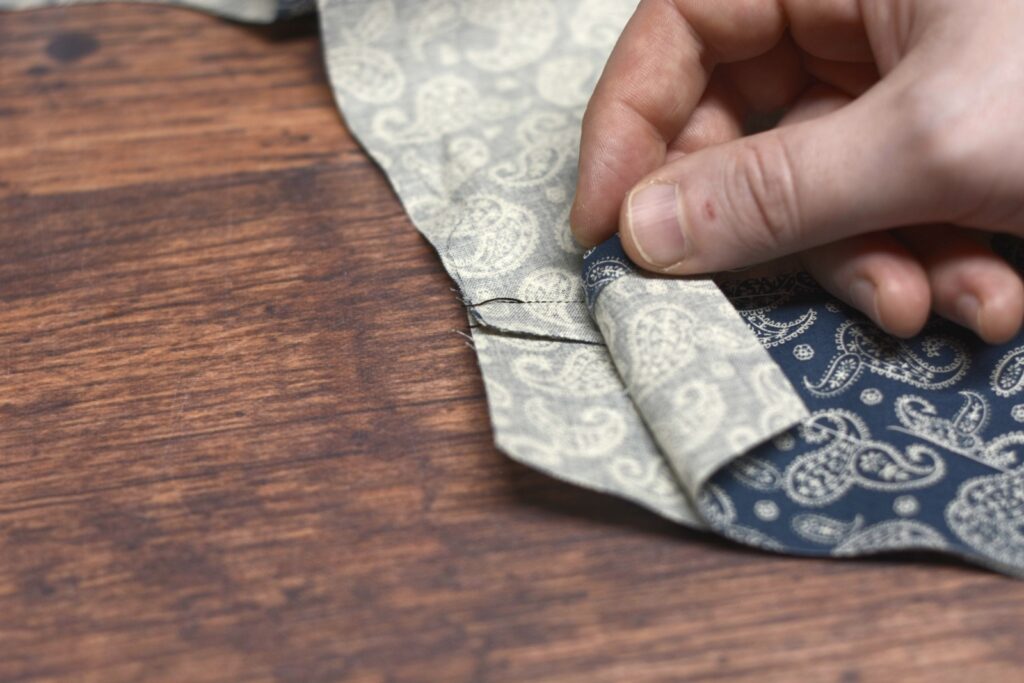
Your Progress
[columns gutter=”0″]
[col]
1 | Baste the linings into position. |
[/col]
[col align_text=”center, middle”]
[/col]
[/columns]
The Back
Construction of the back begins with piecing together the yoke. You should cut two of these (four pieces total), one for the back yoke and one for the lining.
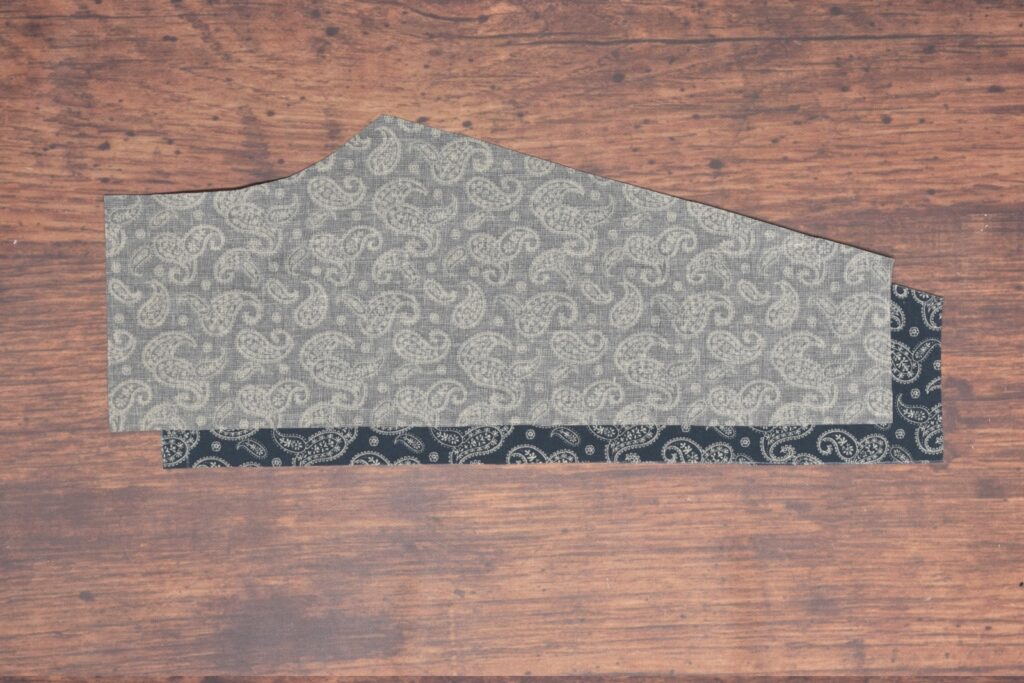
Sew the halves of the yoke together at the center back seam and press open.
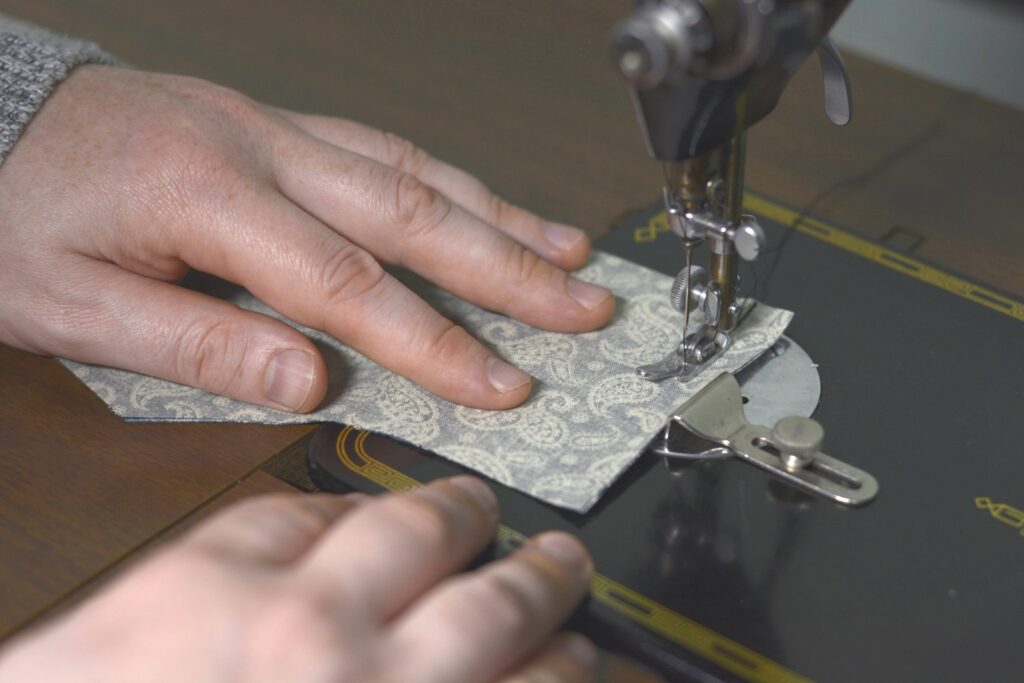
Lay the yoke on top of the back, right sides together. We must determine the area of the shirt to be gathered in – most of the period shirts I’ve seen were gathered at the center back for some reason.
The easiest way I’ve found to do this is to slide the yoke so one end is touching the armscye, and mark the other end on the shirt. Then slide the yoke to the other end and repeat the process. The area in between the two marks is what will be gathered in.
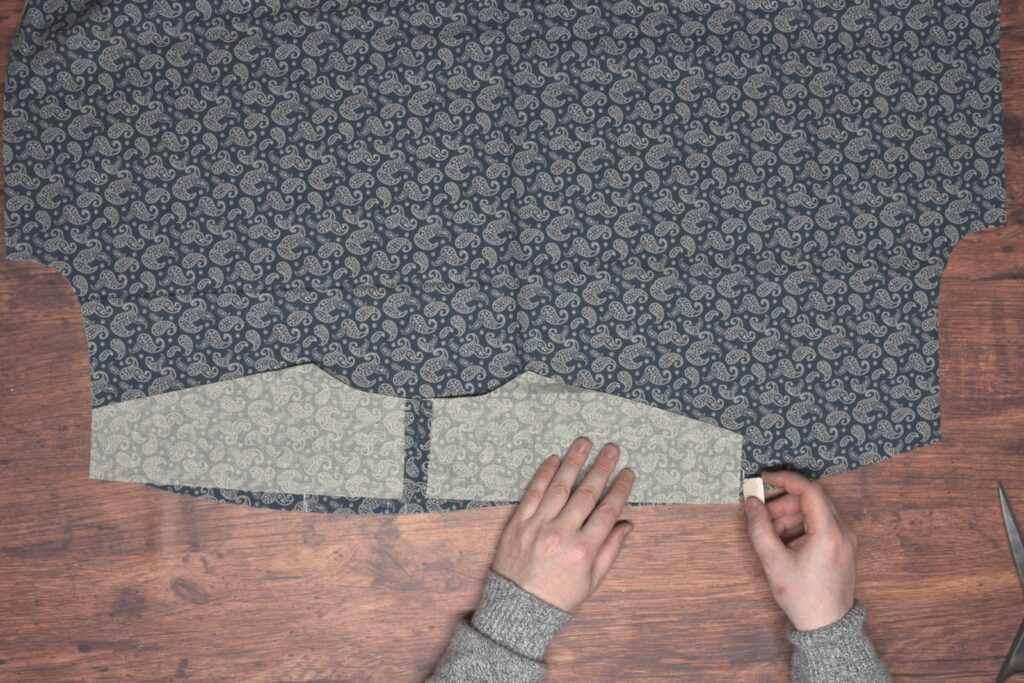
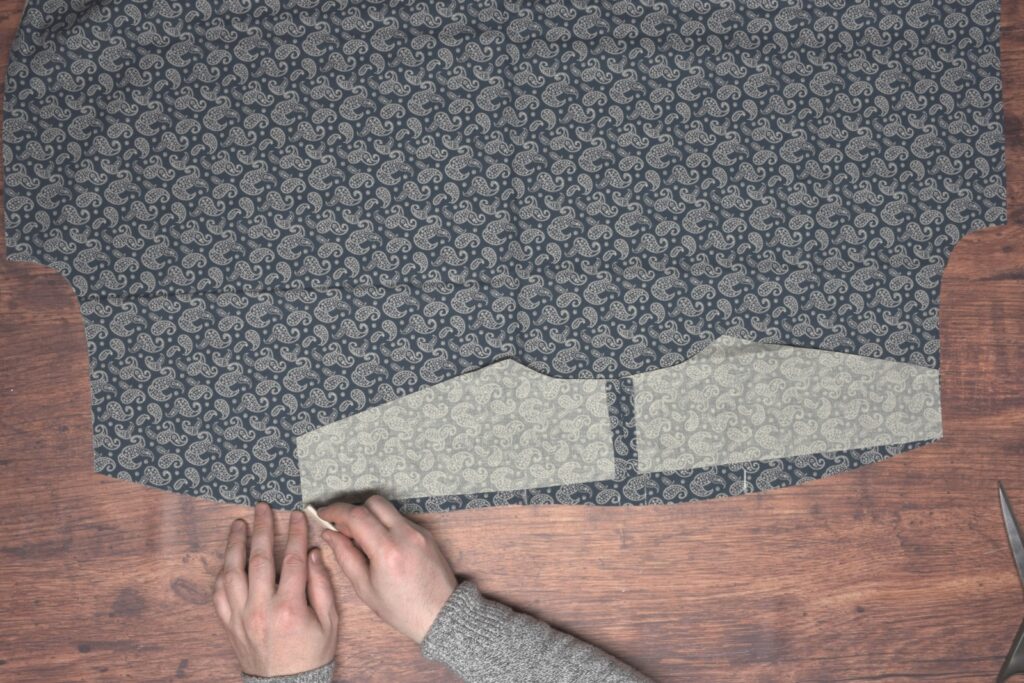
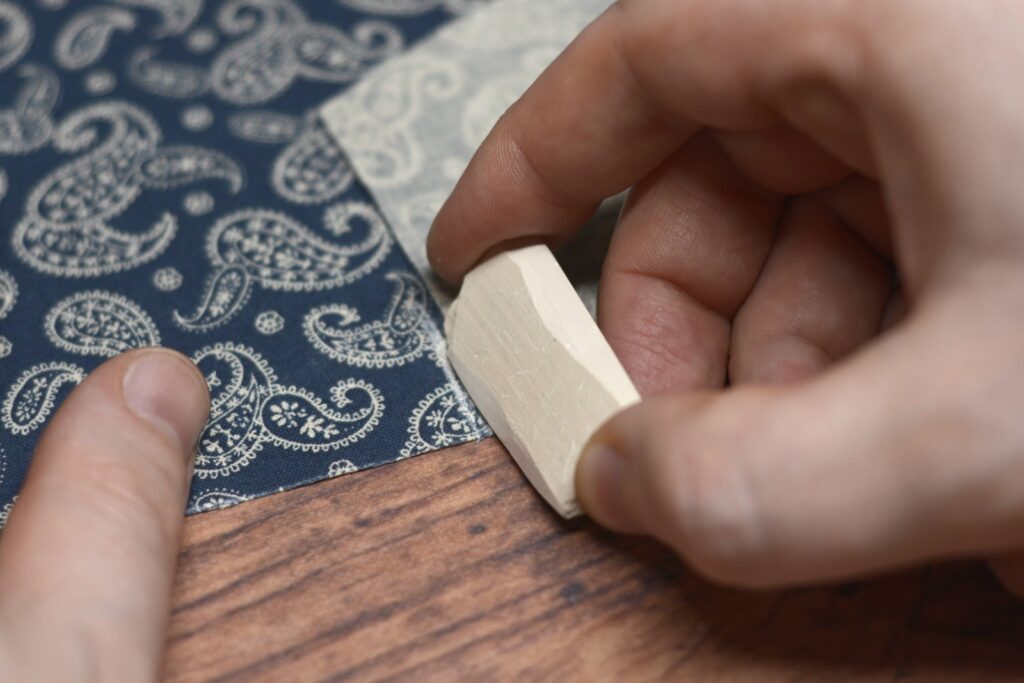
Run three rows of gathering stitches between the marks, as we did on the front at the bottom of the pleated area. Apologies for the extra marks on my shirt – I realized that I had done the layout incorrectly and started over again once or maybe twice.
Work from the wrong side, or at least pass the ends of the stitches to the wrong side so that they won’t be caught between the layers.
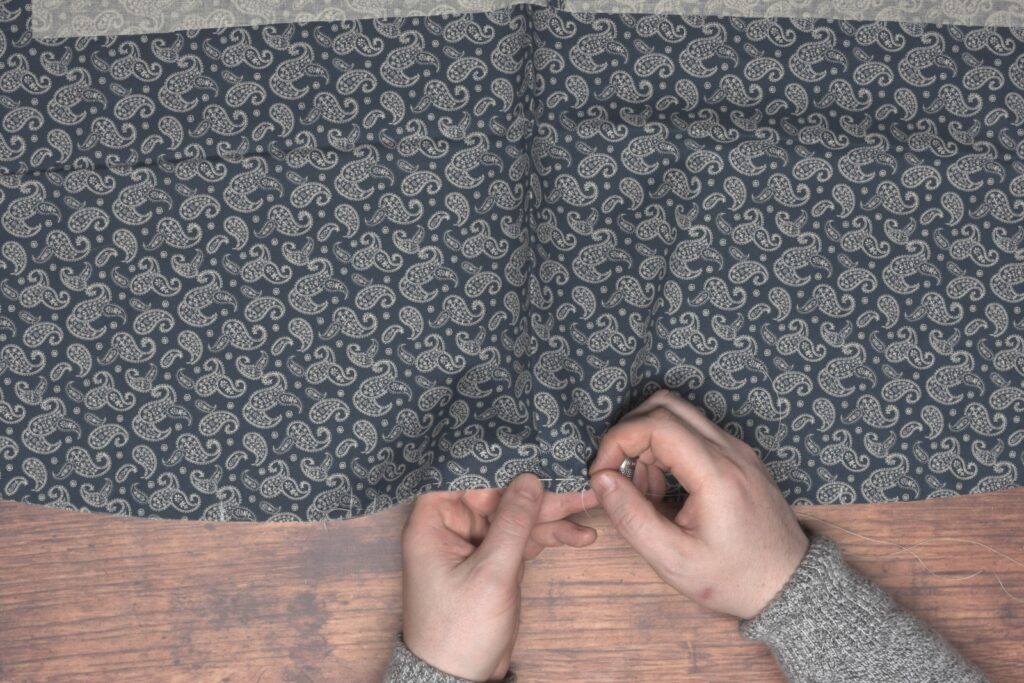
Here are the three rows of stitches complete. I did slightly smaller stitching here than on the front of the shirt as I just wanted to see the difference, but I’d recommend keeping them the same for consistency.
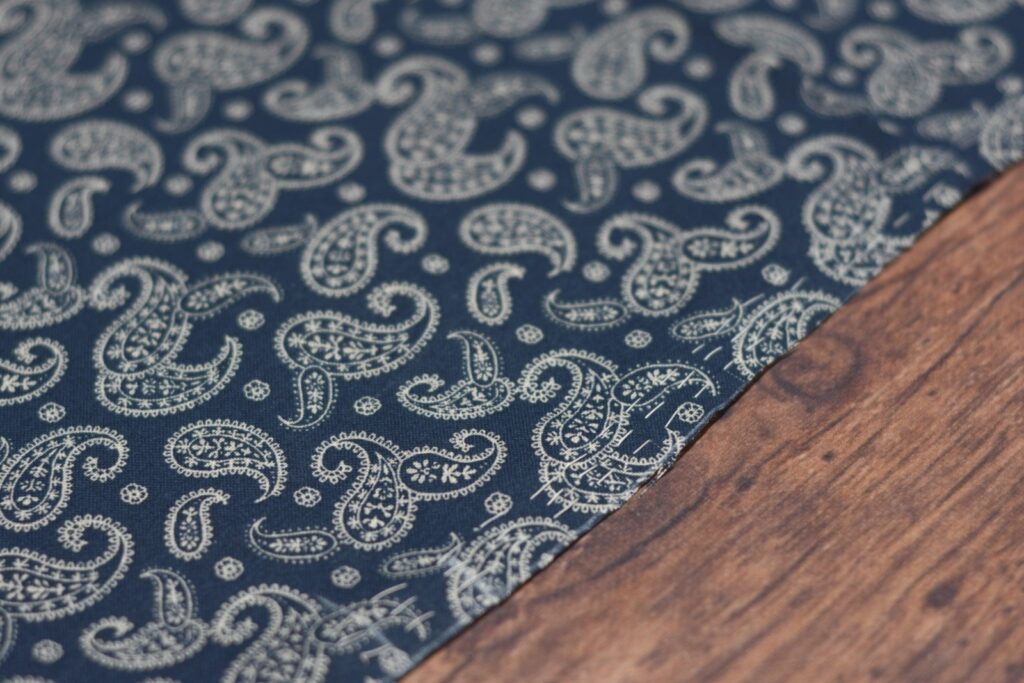
Tie the three threads together at each end.
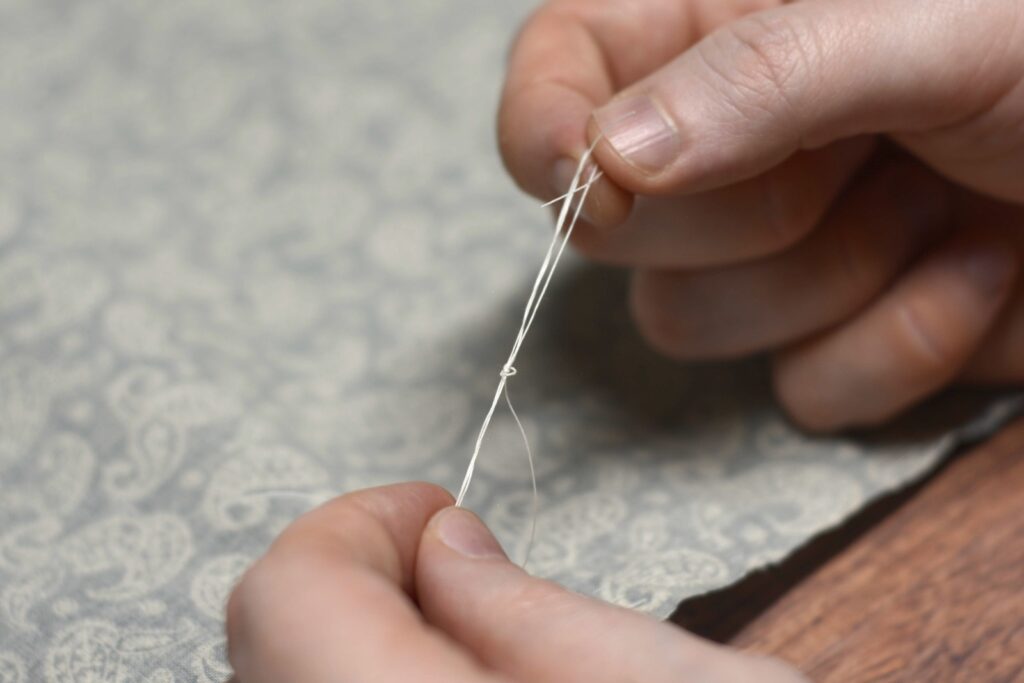
Place the yoke on top of the shirt back, right sides together, and pin both together, matching the center of each.
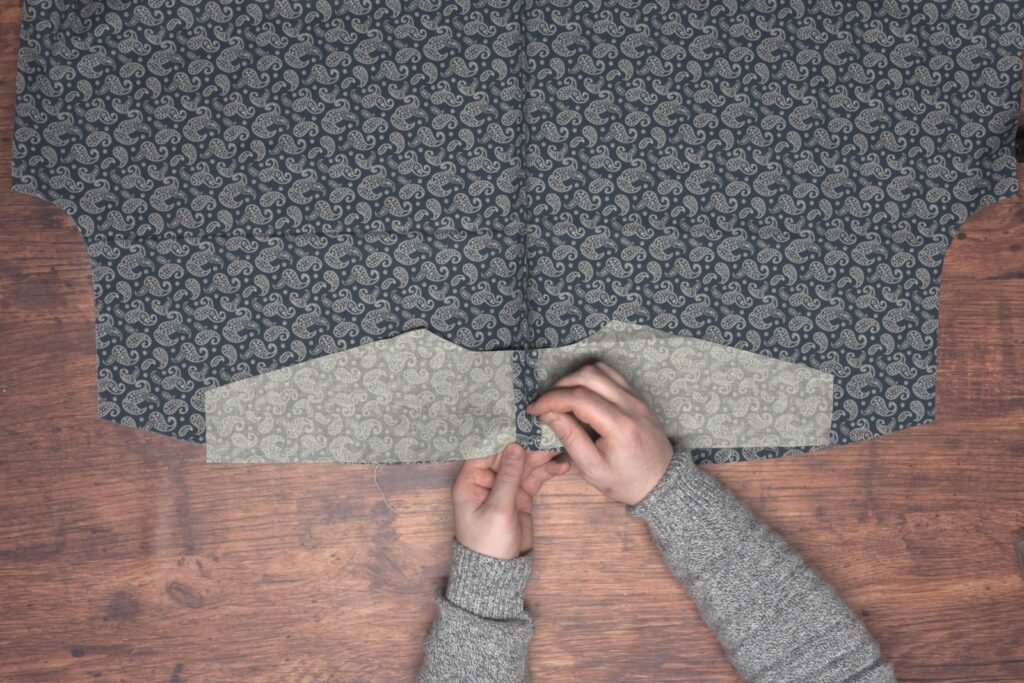
Pin each end as well.
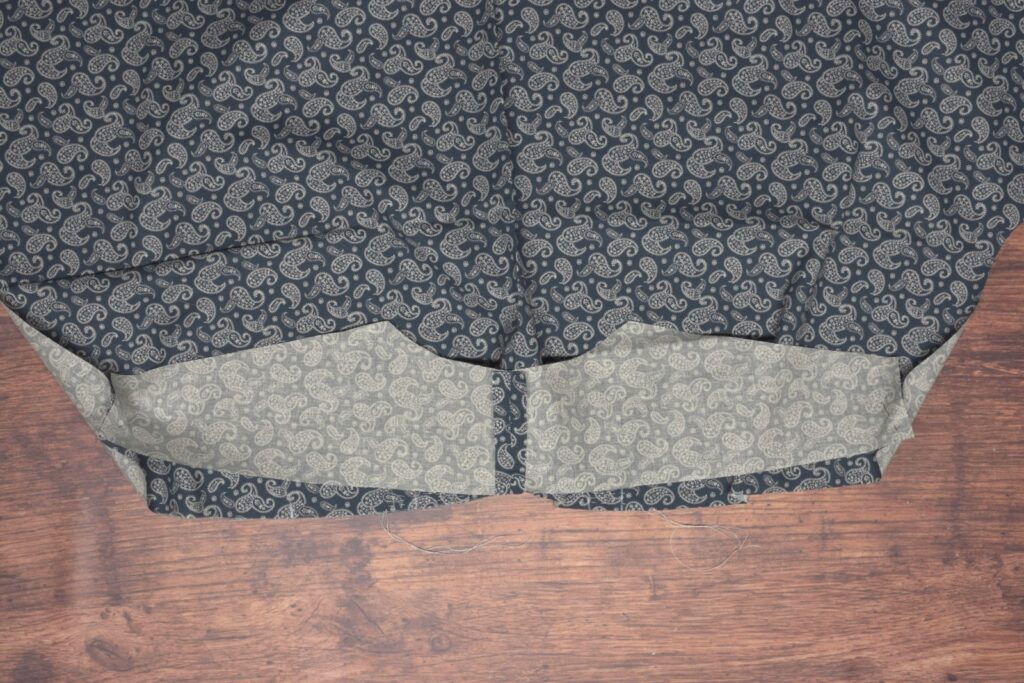
You can see here how I aligned the seams, the yoke slightly overlaps the back of the shirt.
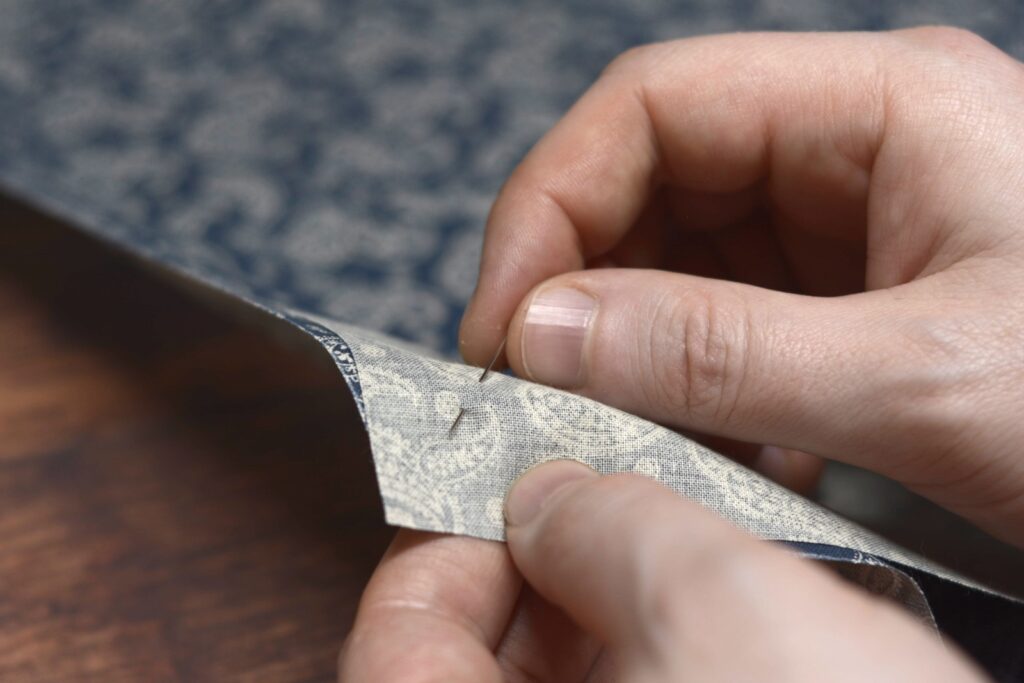
Then evenly pin the rest of the shoulder to the yoke on each side until you get to the two marks and the gathering stitches.
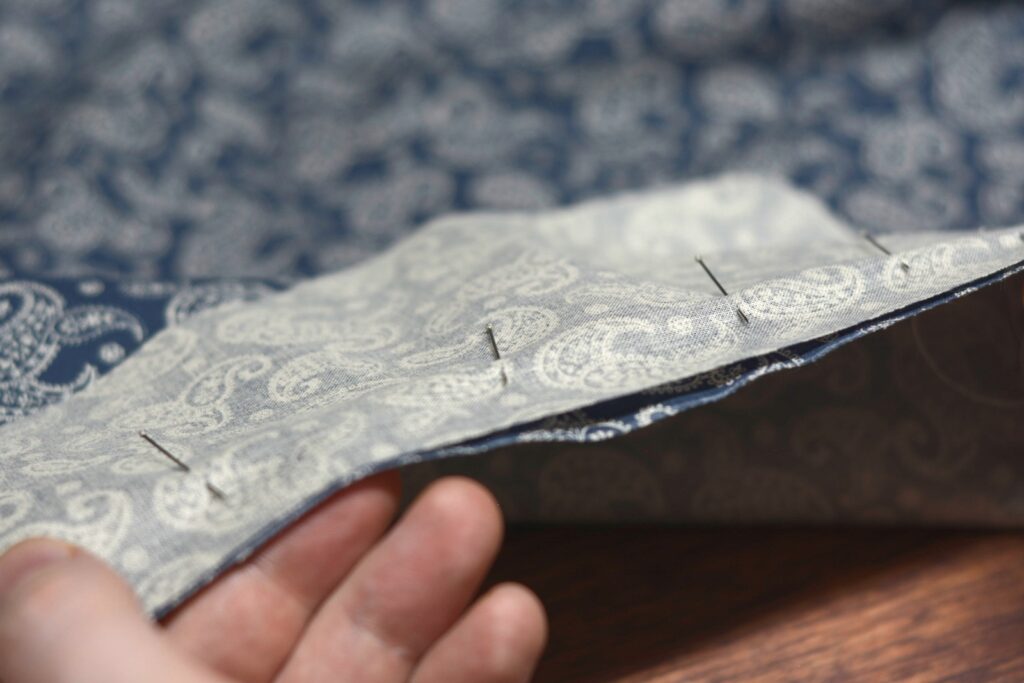
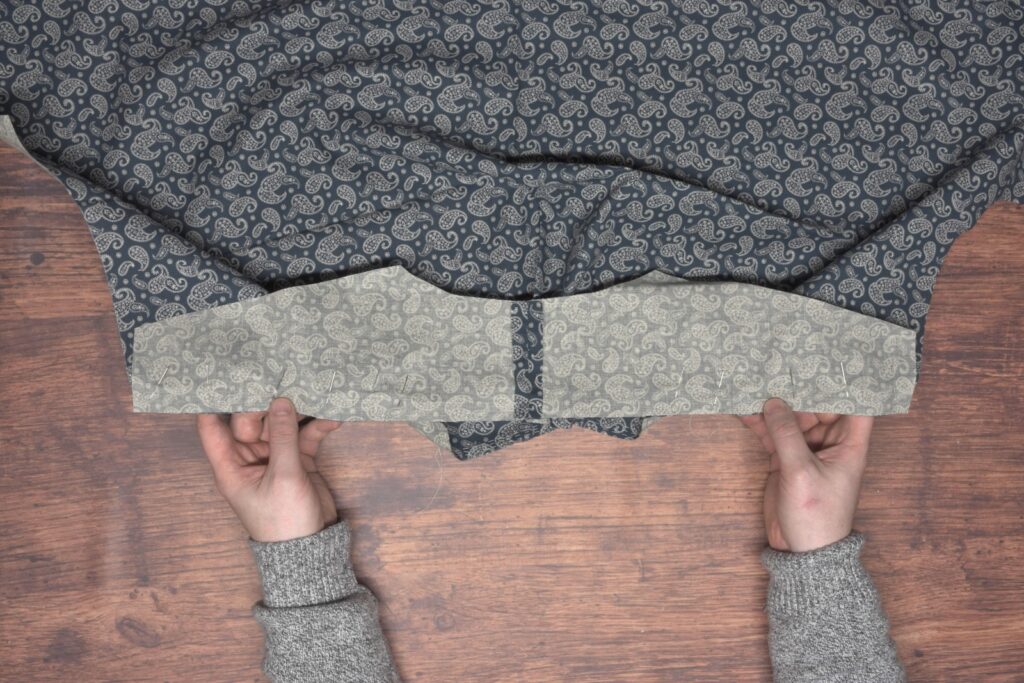
Turn the entire back over – it’s easier to work this way – and gently begin pulling on one side of the threads, forming the small gathers or pleats.
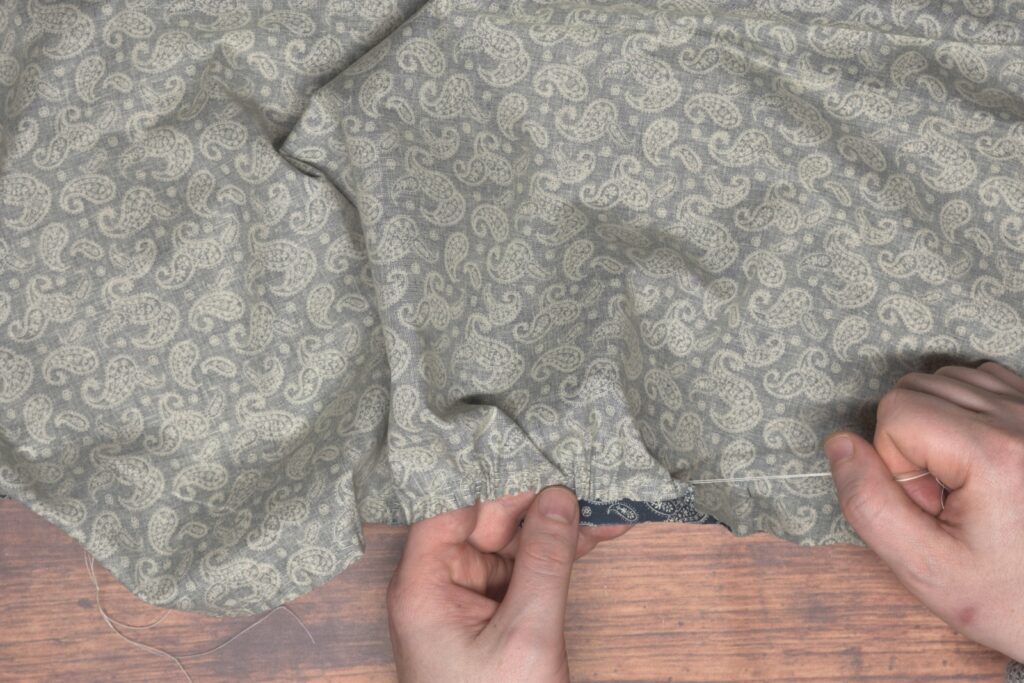
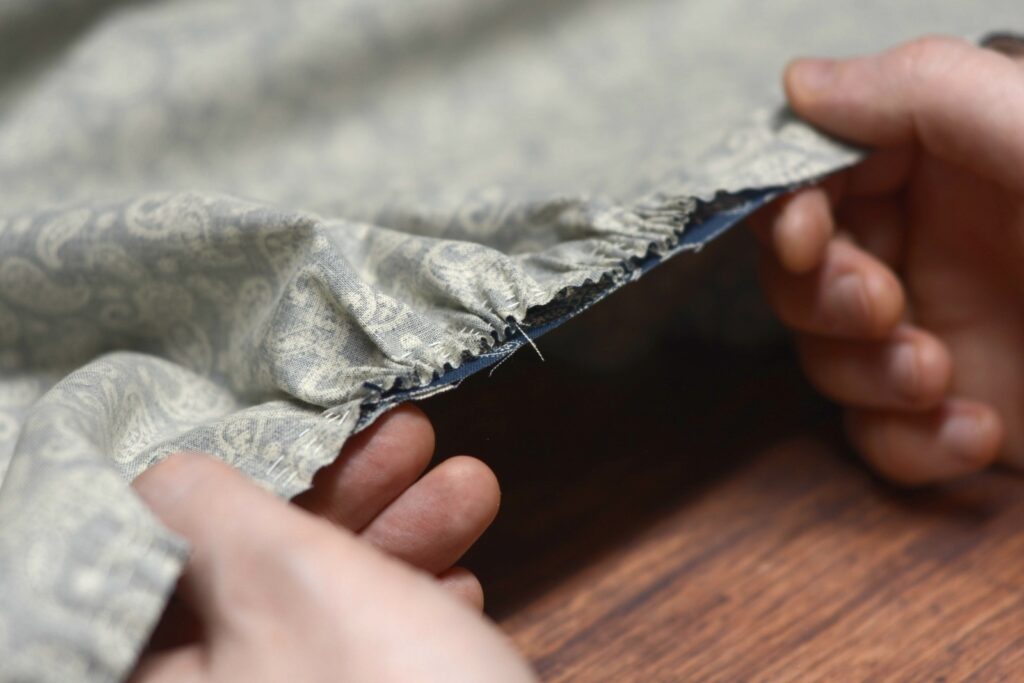
When you are happy with the spacing and appearance, pin the gathers in place, about 1″ or so between each pin.
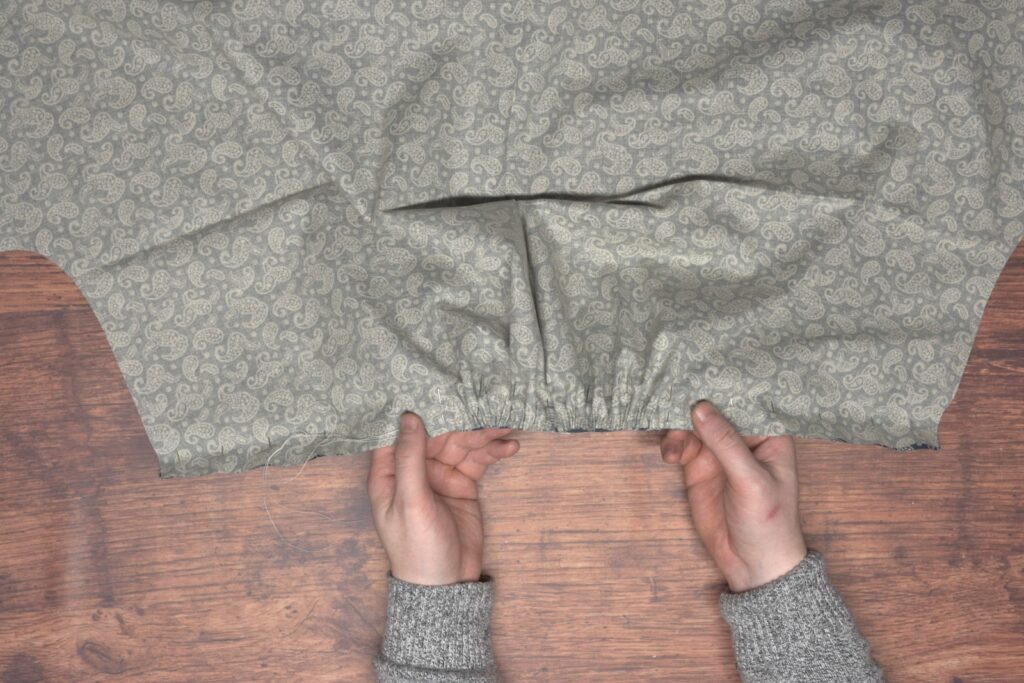
Baste a small running stitch through all layers, removing the pins and giving any final adjustments to the gathers as you work. This helps avoid running over pins with the sewing machine.
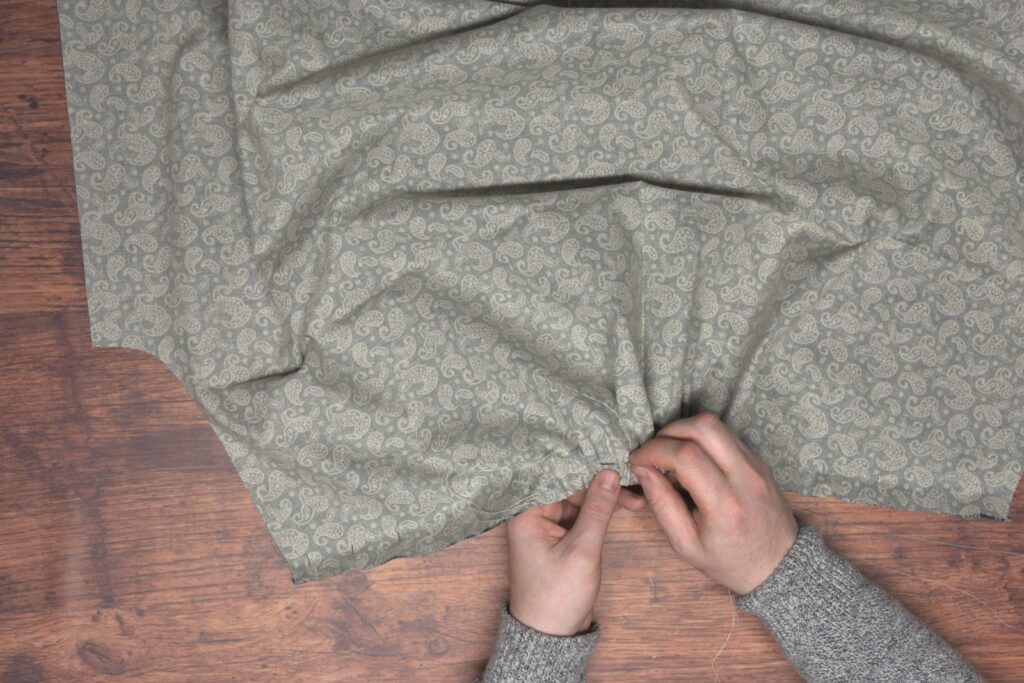
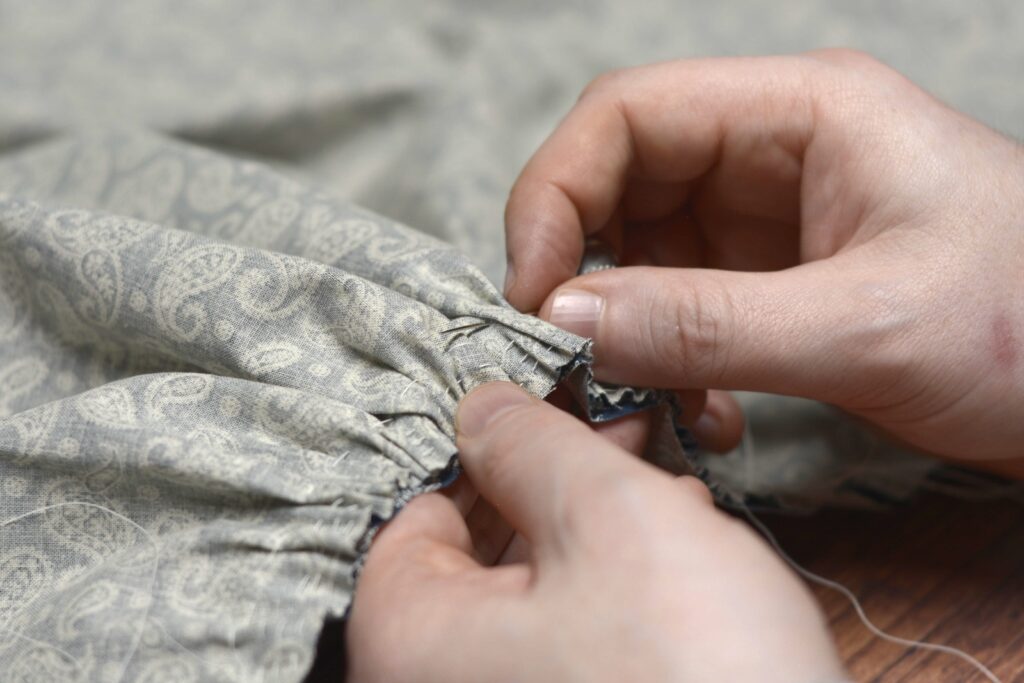
Sew the yoke seam using a 1/2″ seam allowance, and press the seams toward the neck.
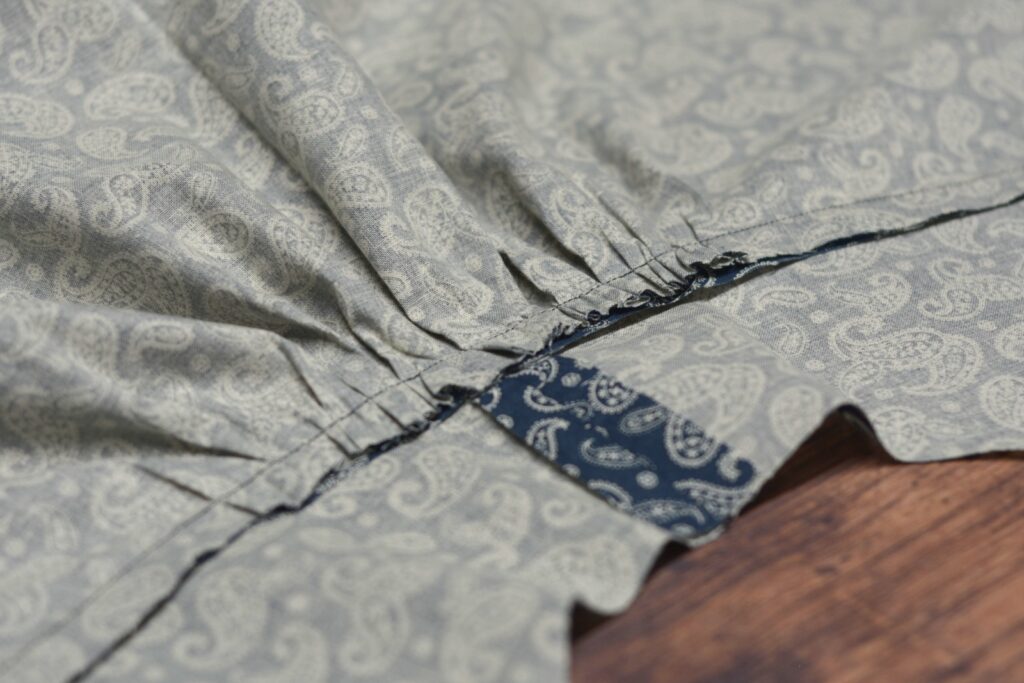
And here’s the completed back of the shirt.
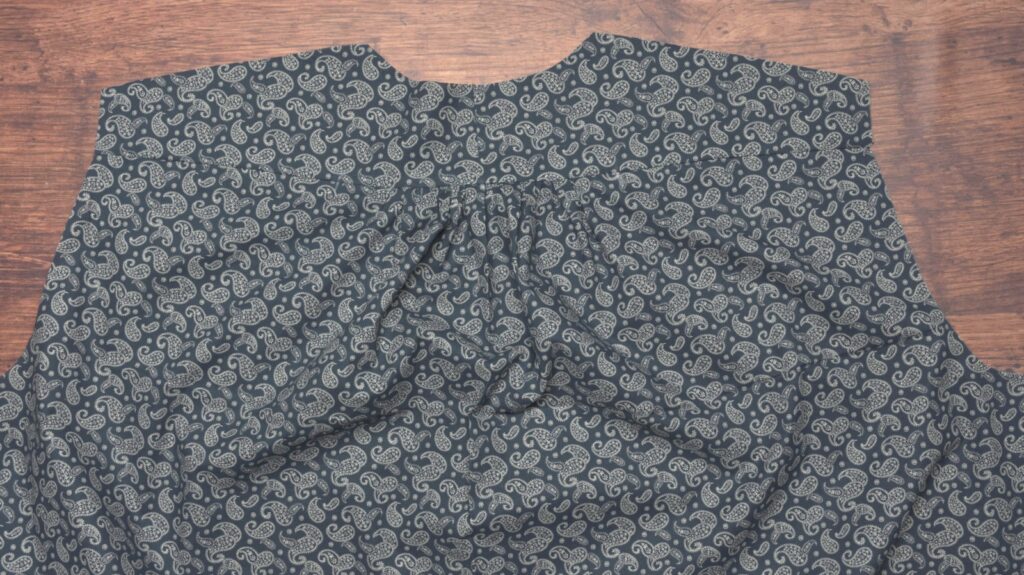
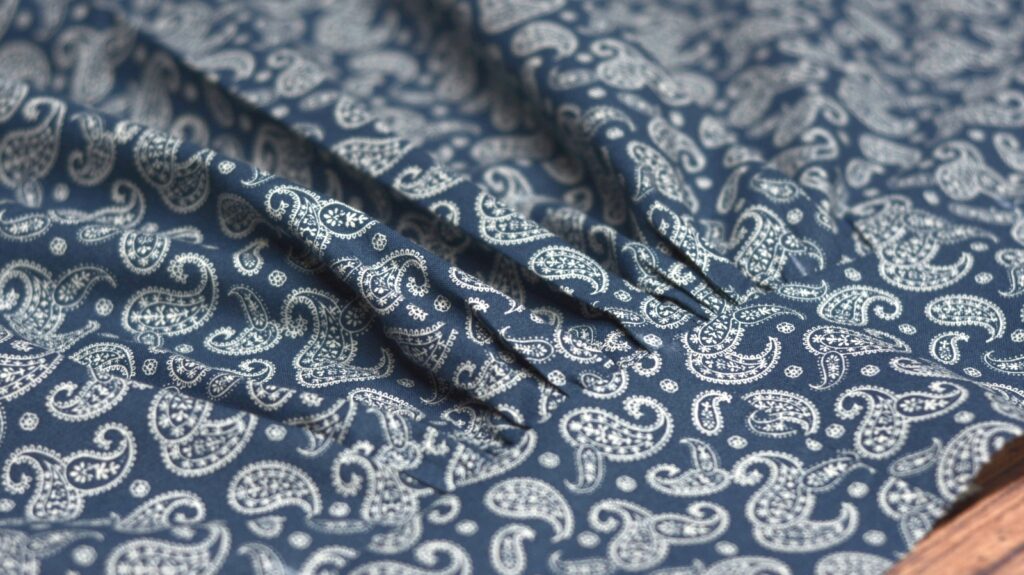
Your Progress
[columns gutter=”0″]
[col]
1 | Sew the yokes. | |
2 | Attach and gather the back to the yoke. |
[/col]
[col align_text=”center, middle”]
[/col]
[/columns]
Watch Pocket
The rest of the watch pocket goes fairly quickly now that you’ve got the waistband and facings attached and pressed.
Cut a length of linen stay tape 4 1/2″ long and lay it on the linen stay about 1/16″ below the stitch line for the pocket bag.
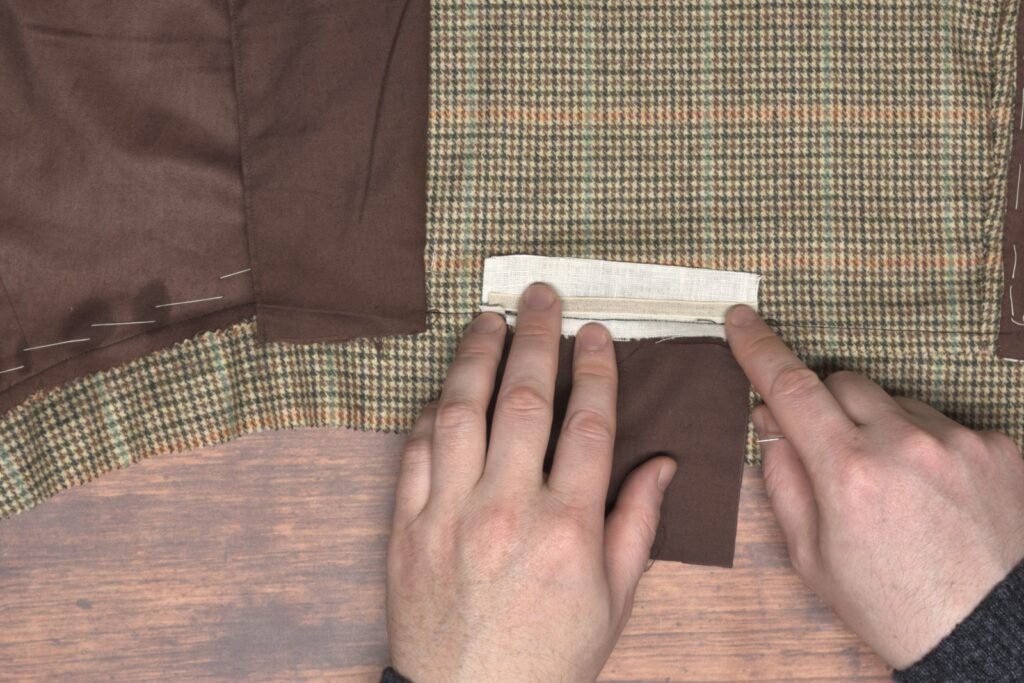
Baste the linen tape to the trouser front.
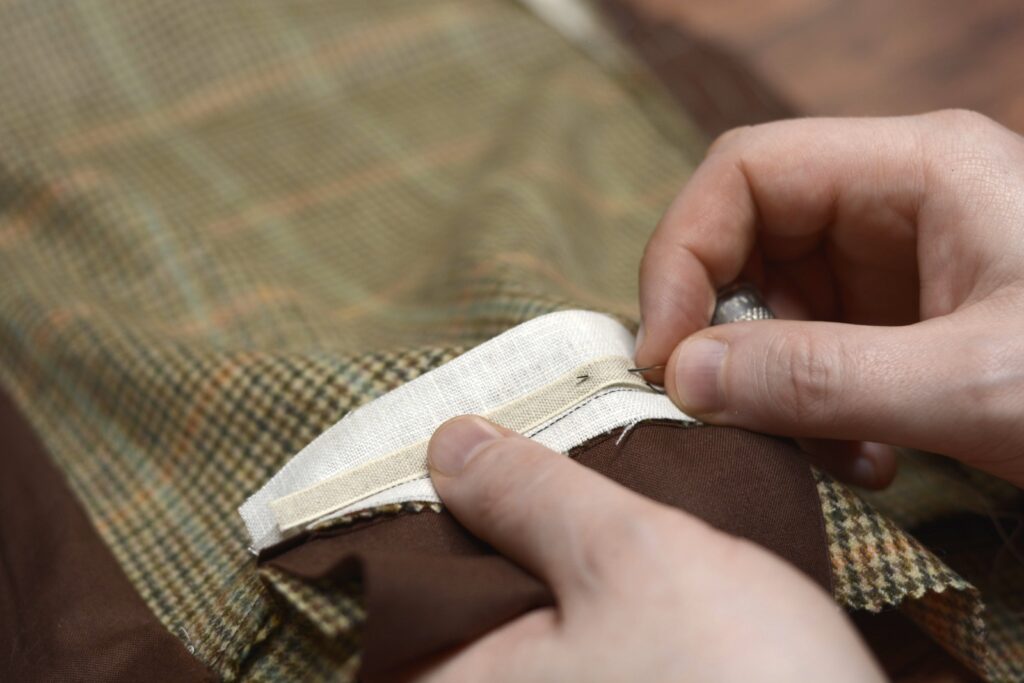
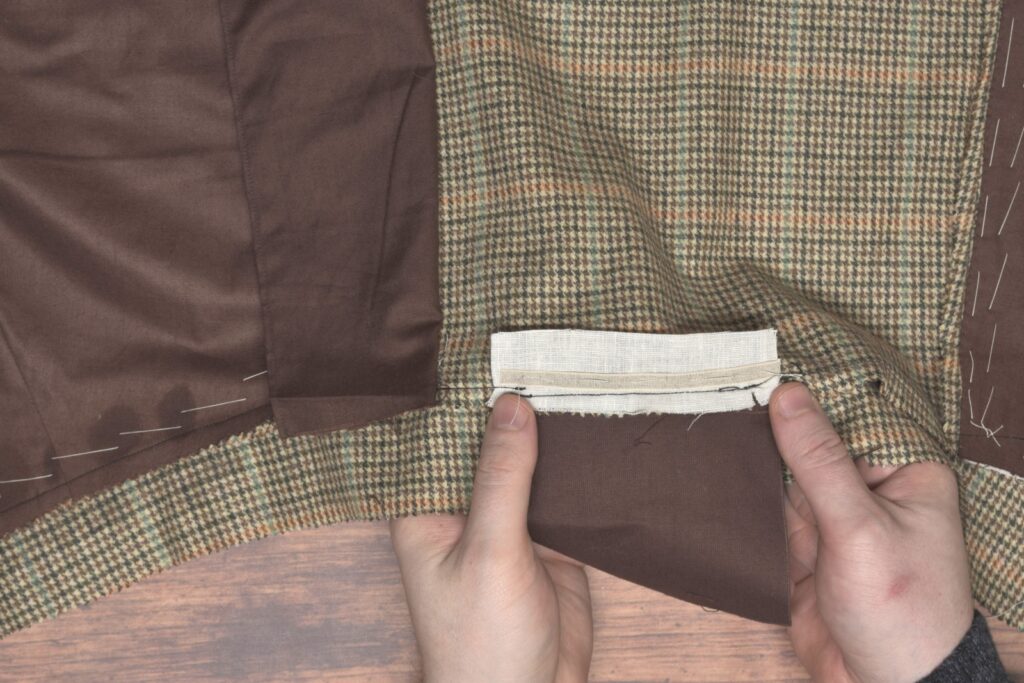
Cross stitch the linen stay tape to the trouser front, being sure not to let the stitches show through to the right side.
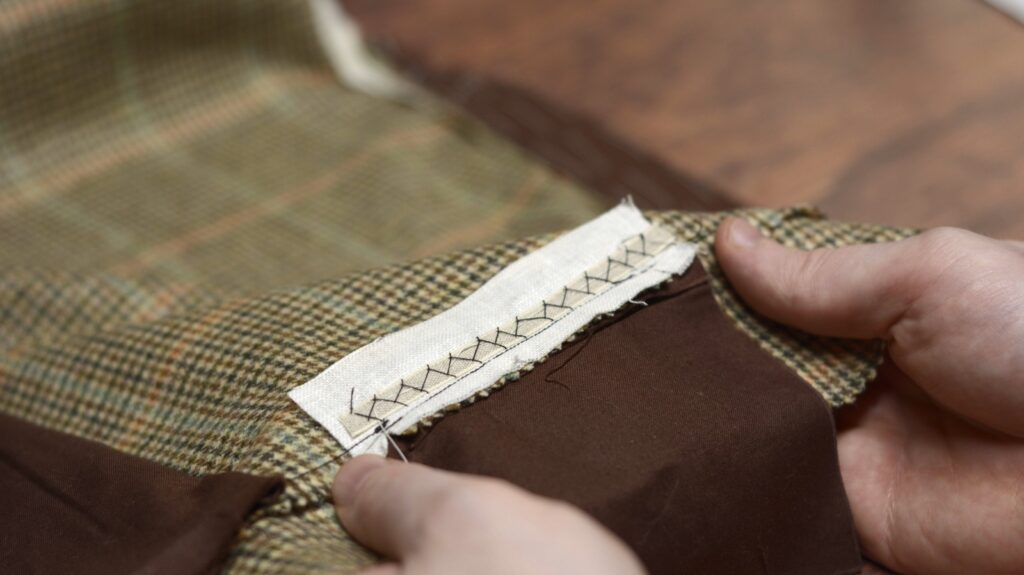
Now fold the pocket bag over the linen tape, off-setting the seam by 1/16″ to 1/8″ behind the fold, hiding the pocket bag from outside view. Baste securely in place.
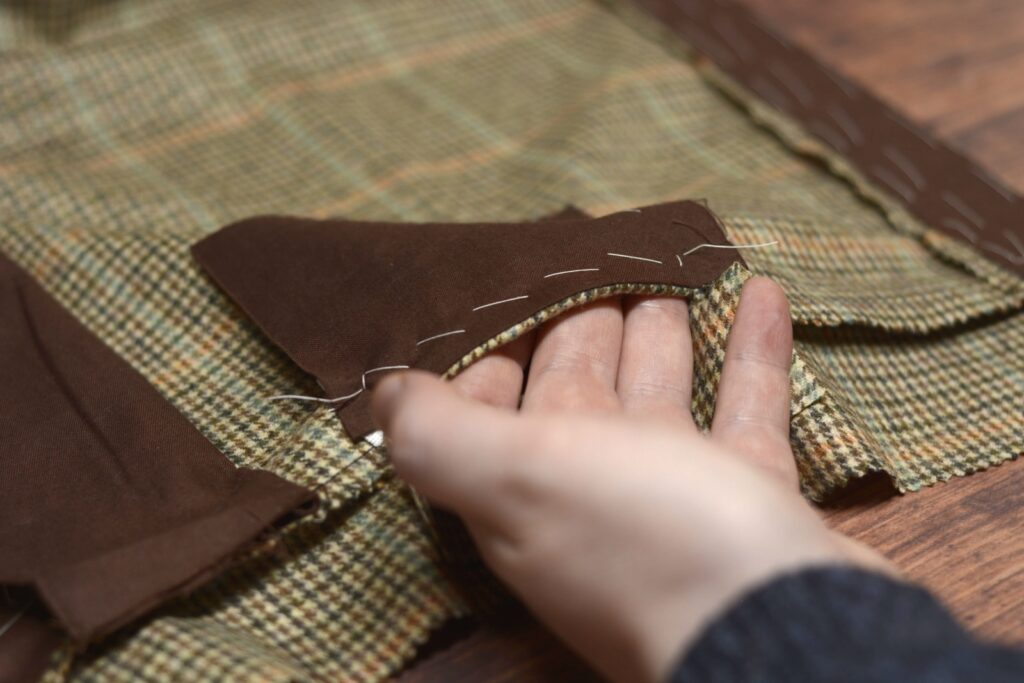
Top stitch across the pocket opening, catching the pocket bag underneath, using a machine stitch or a side stitch by hand. Keep the stitches about 1/8″ – 3/16″ away from the edge, so that they land in the middle of the stay tape that is sandwiched between the layers.
If using the side stitch, the needle enters the fabric just to the side of the previous stitch. On the underside, it is formed similar to a normal running stitch. The stitches should be 1/8″ to 1/4″ apart.

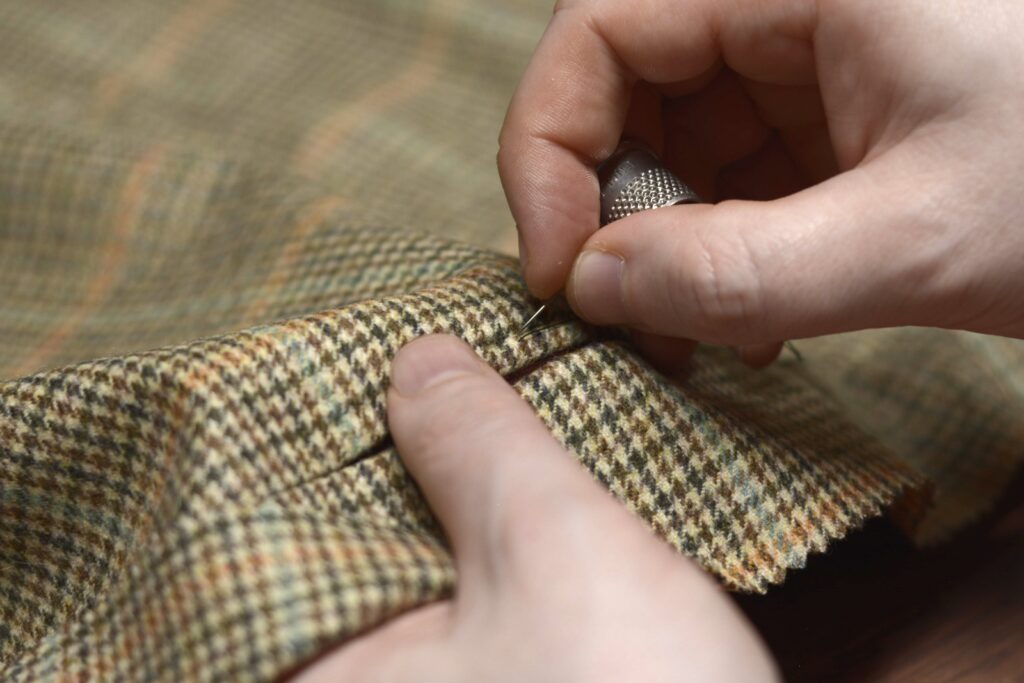
Here you can see the wrong side of the side stitches, catching the pocket bag and forming a firm opening for the watch pocket.
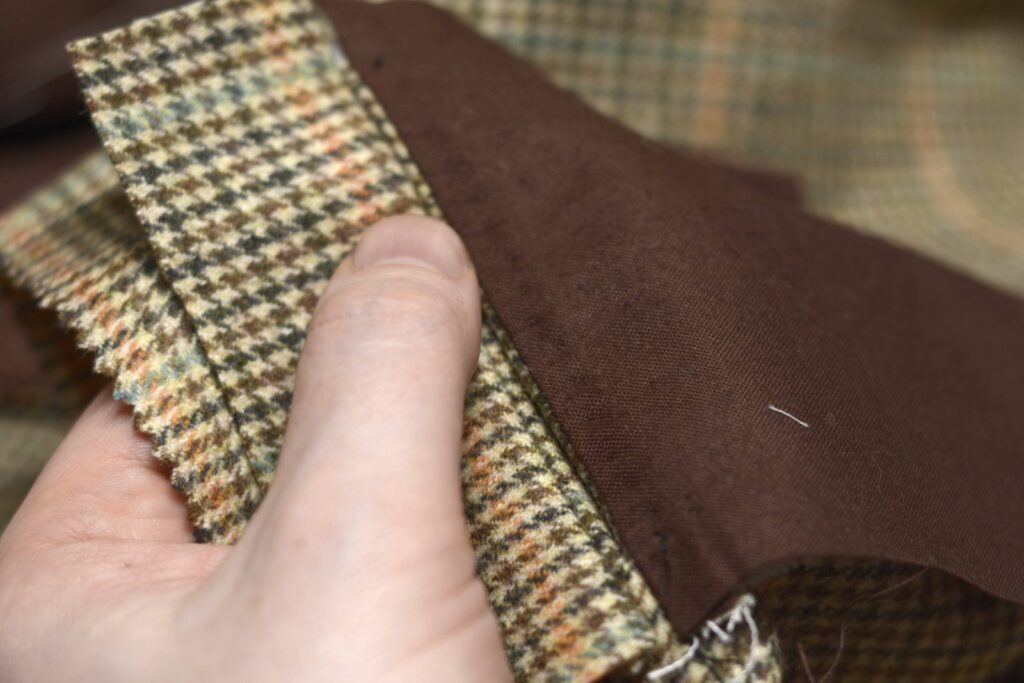
The outside of the watch pocket so far. I wish you could see the side stitches but they pretty much disappear into the fabric.
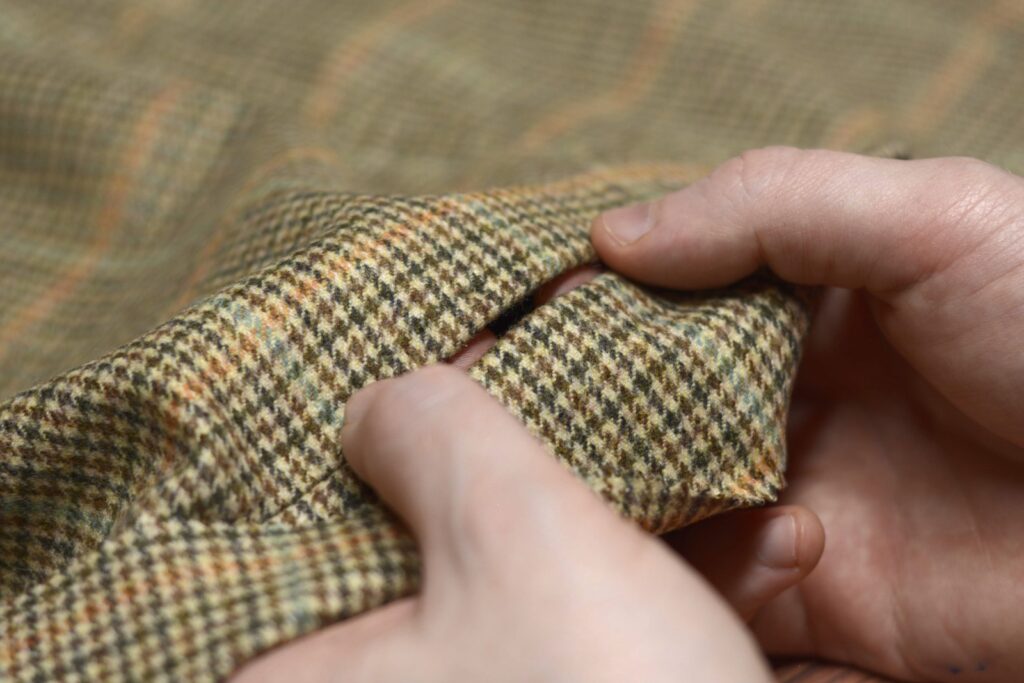
Take the remaining pocket bag half and press over the top edge 1/4″.
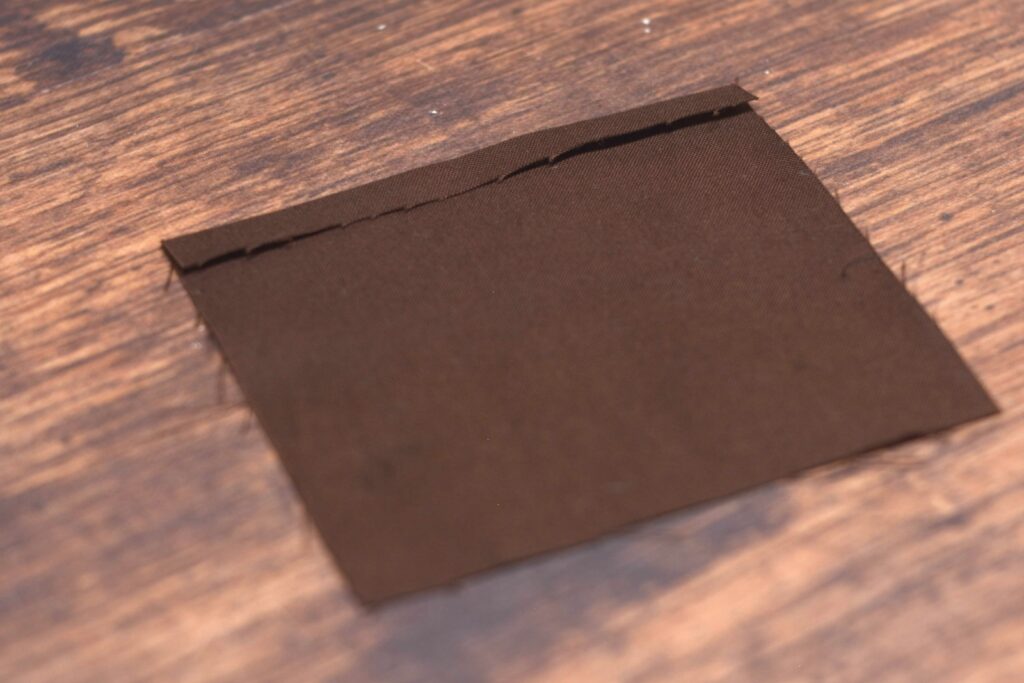
Open up the pocket and baste the pocket bag to the right side of the remaining pocket facing, 1/4″ from the edge.
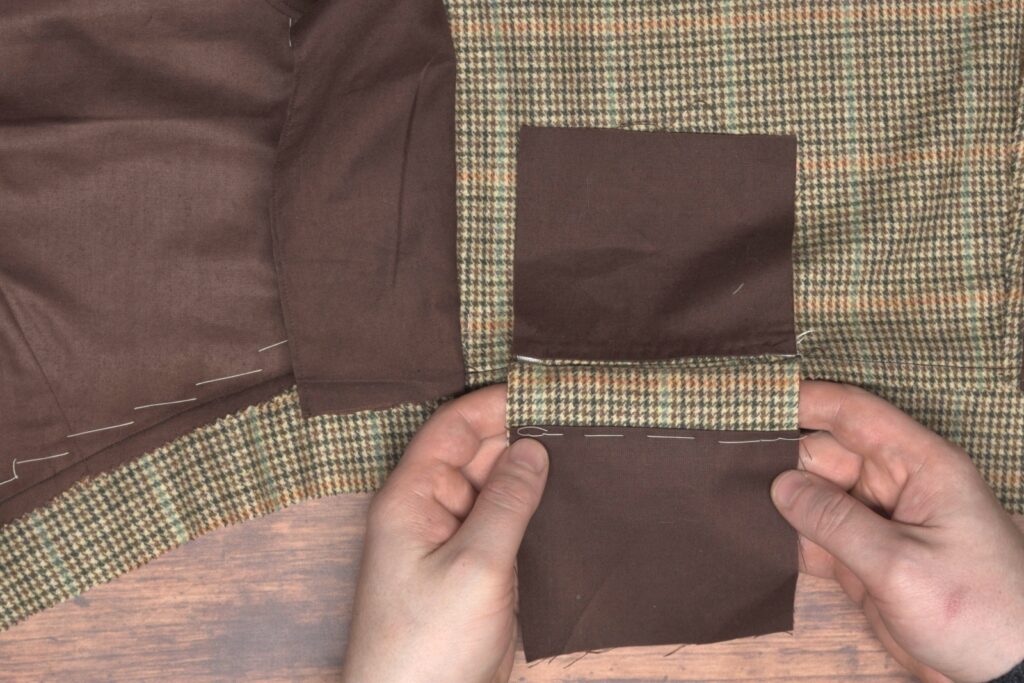
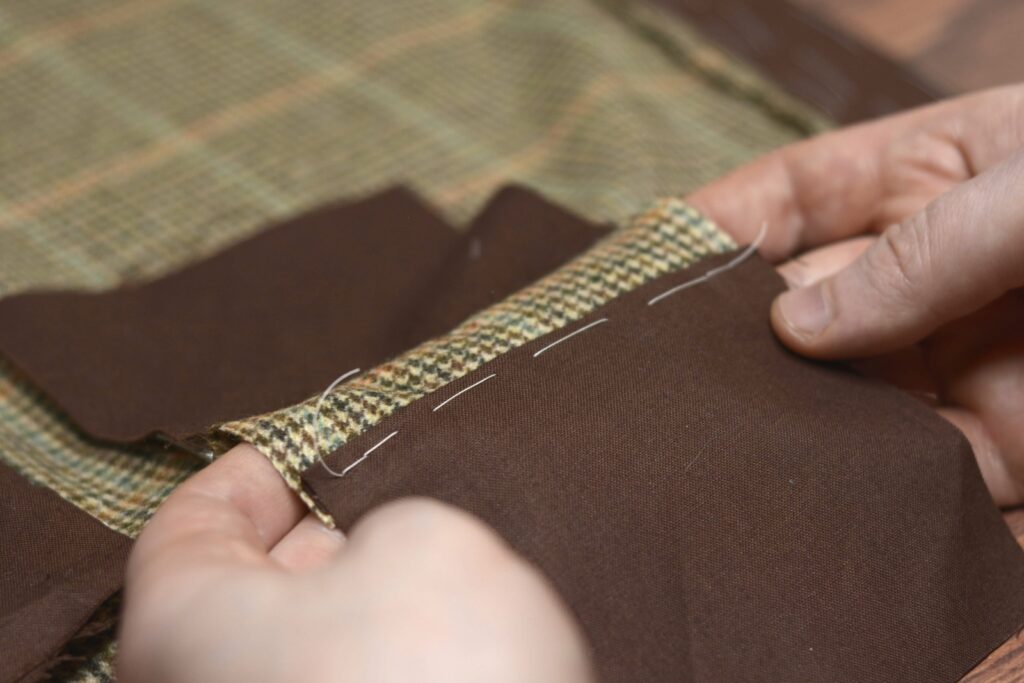
Fell the pocket bag to the pocket facing. Remove the basting stitches.
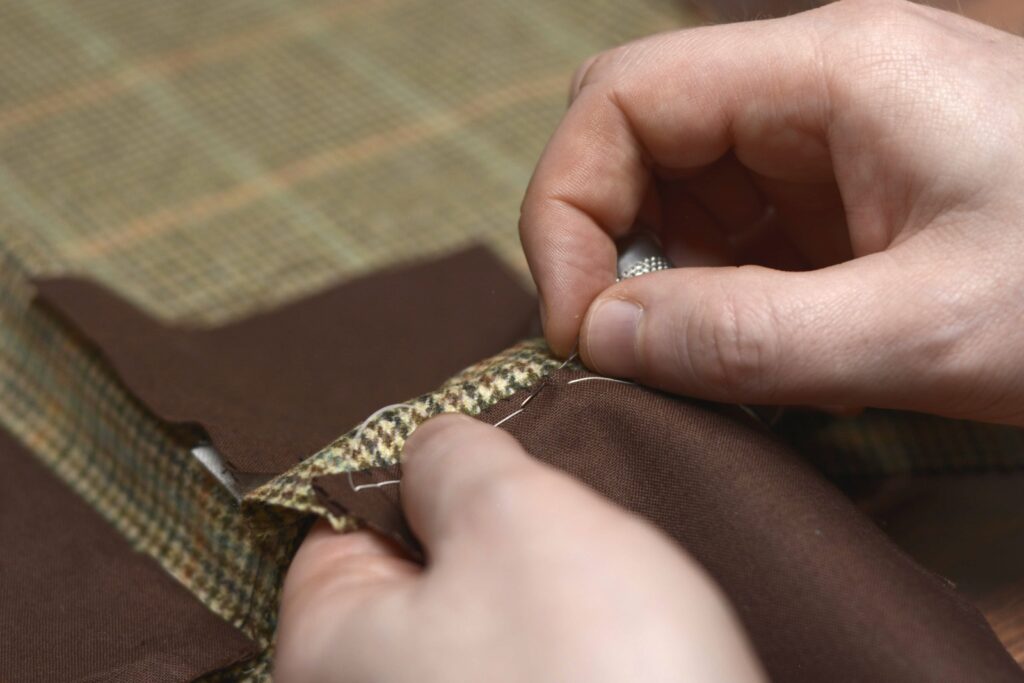
With both pocket bag halves now attached, grasp both of them, being sure they are aligned properly, particularly at the pocket opening area. Baste across the top of the pocket facing through both pocket bag halves. This holds all the layers in place while we sew the pocket bag closed.
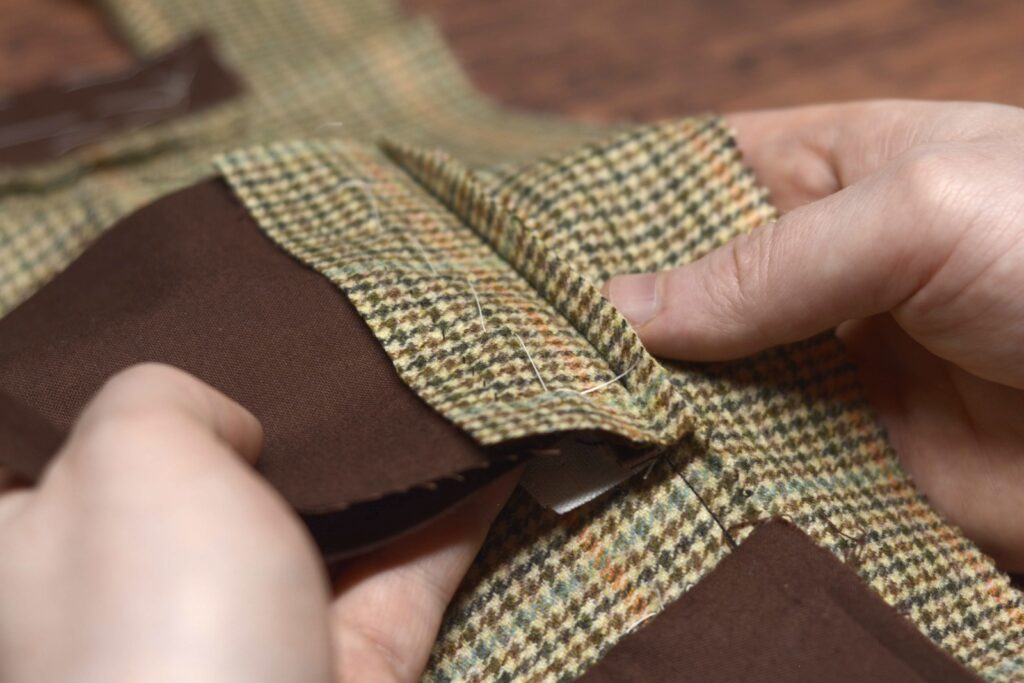
Draw out the seam lines on your pocket, 1/2″ from the edge. Be sure there is at least 1/2″ available on the underside, or you’ll end up like me with no room to turn under the raw edges. Add a couple of curves at each corner as well.
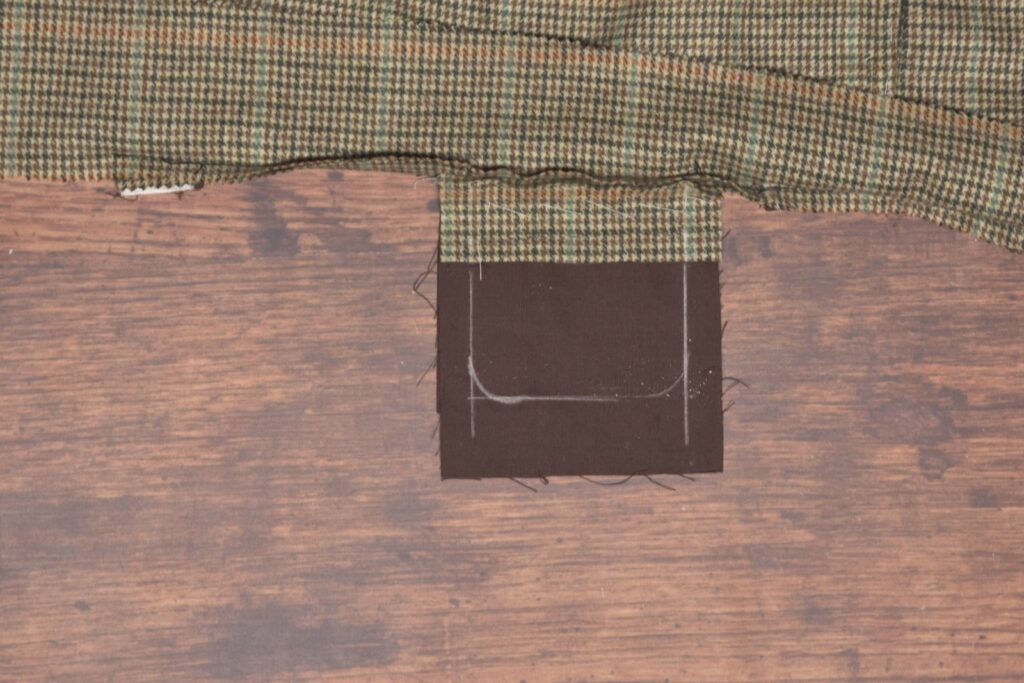

Sew the pocket bag closed, getting as close as you can to the waistband seam at the top without actually hitting it.
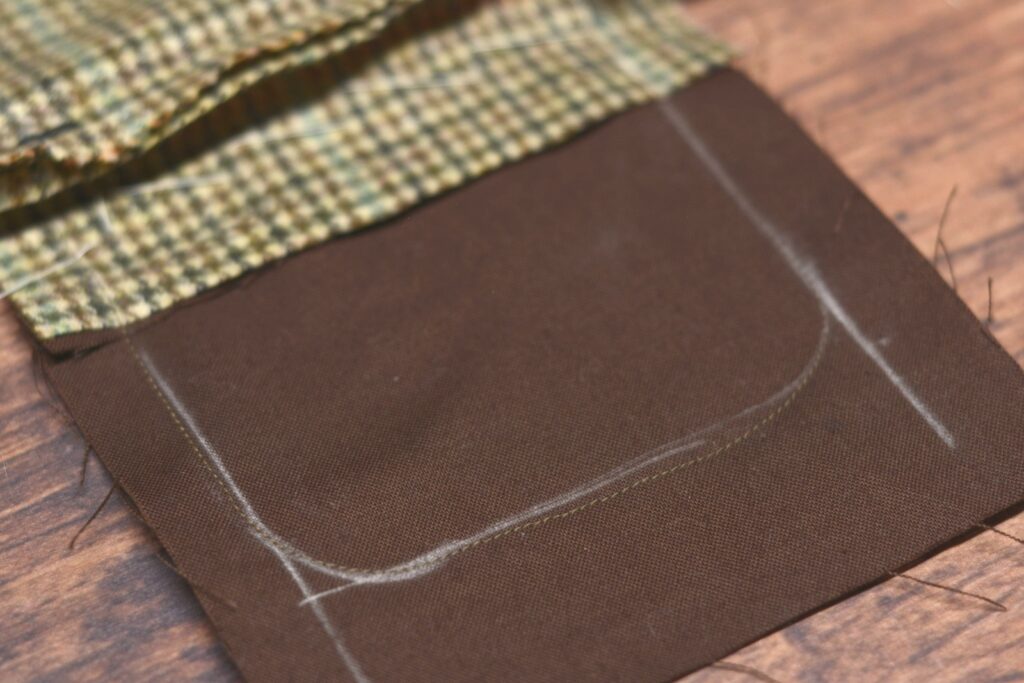
Trim the excess fabric from the pocket bag, leaving a 1/2″ seam allowance.
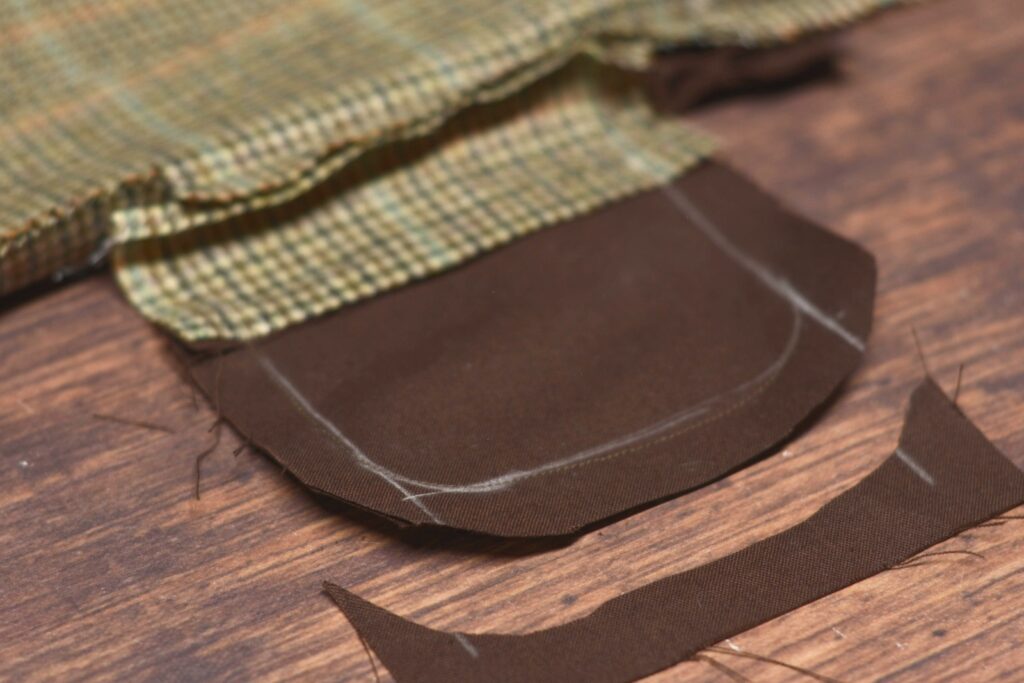
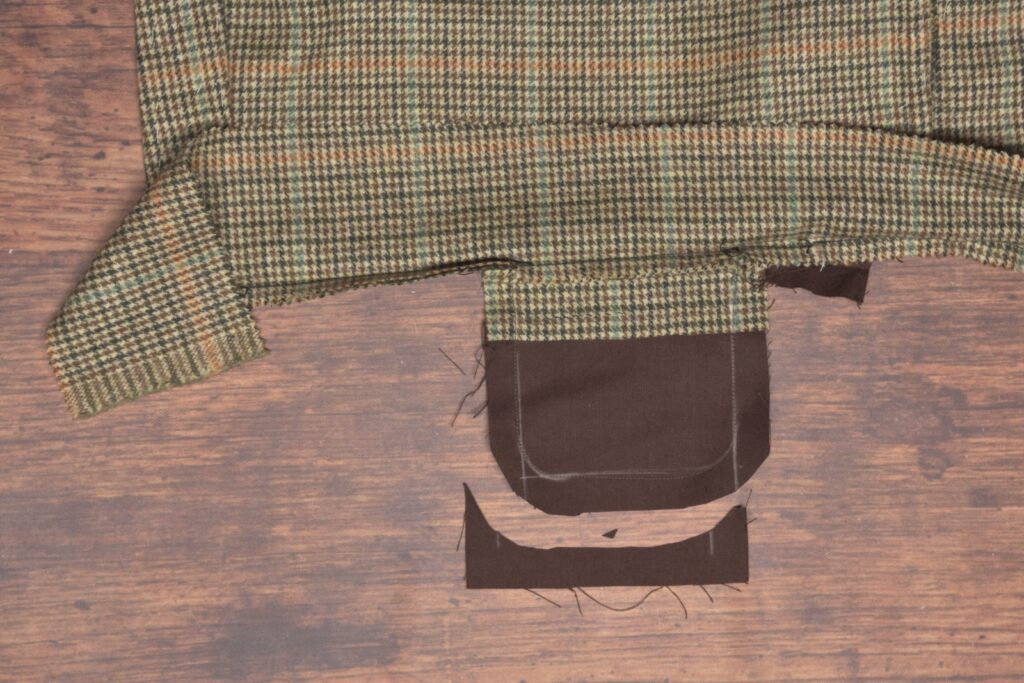
Carefully trim the pocket facing’s seam allowance to 1/4″ on each side, being sure not to cut the pocket bag below.
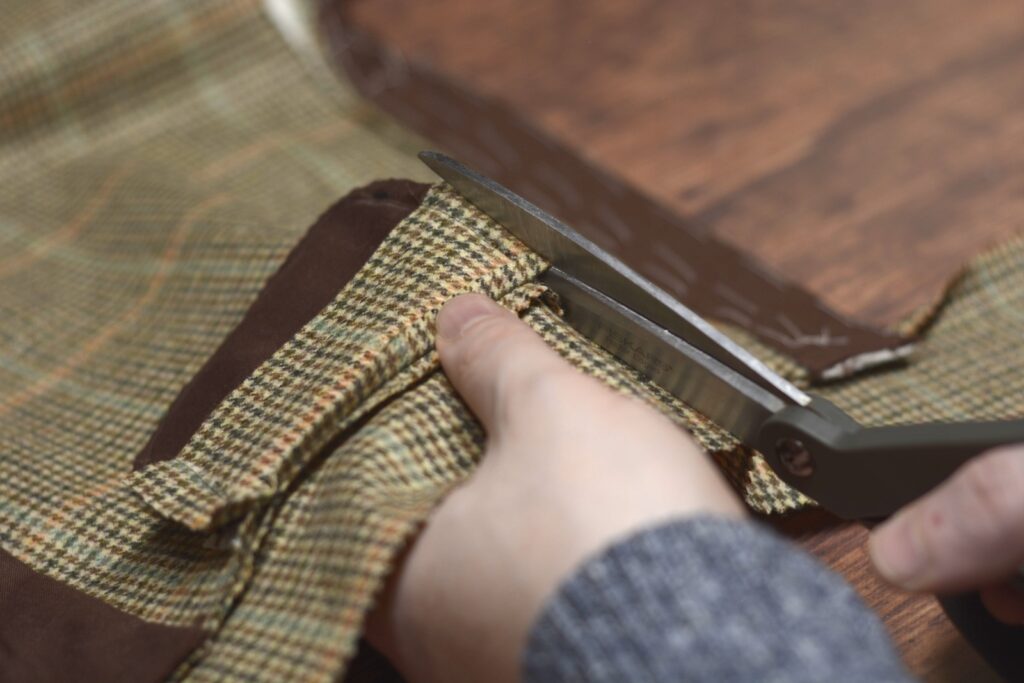
Fold the raw edges of the pocket bags inwards and press with your fingers as you go. The curved corners can be a little trick but you can perfect them as you overcast / fell the edges in the next step.
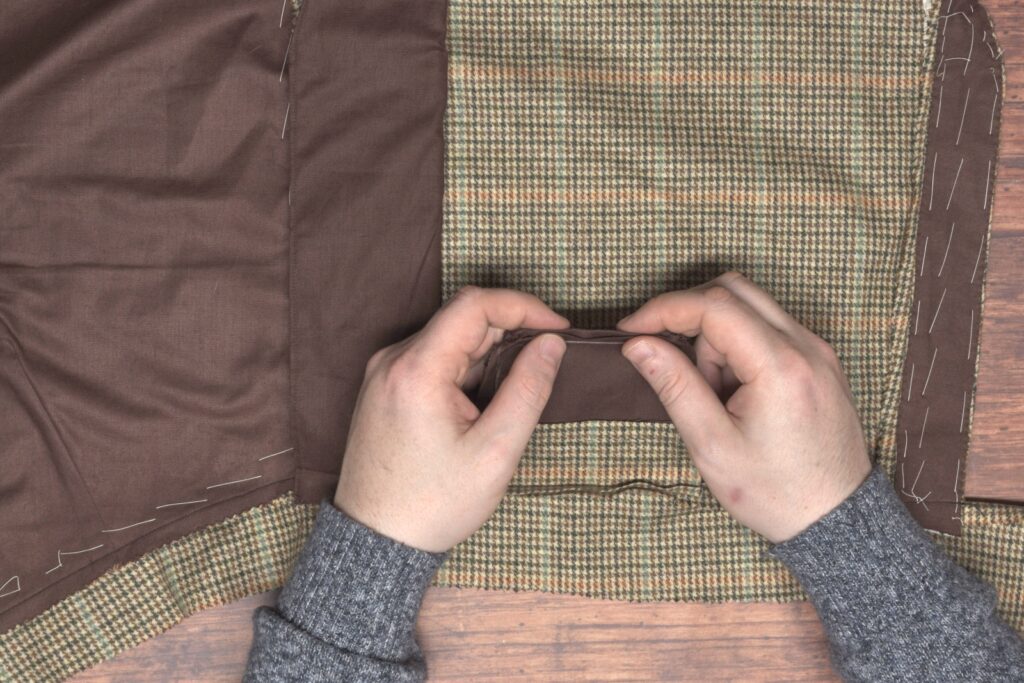
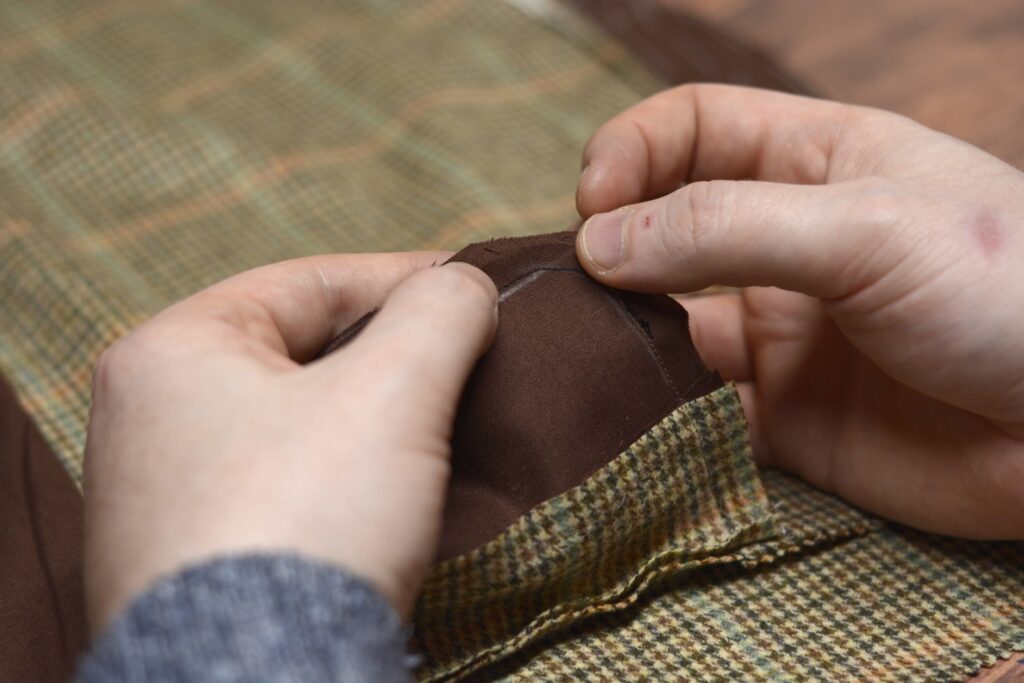
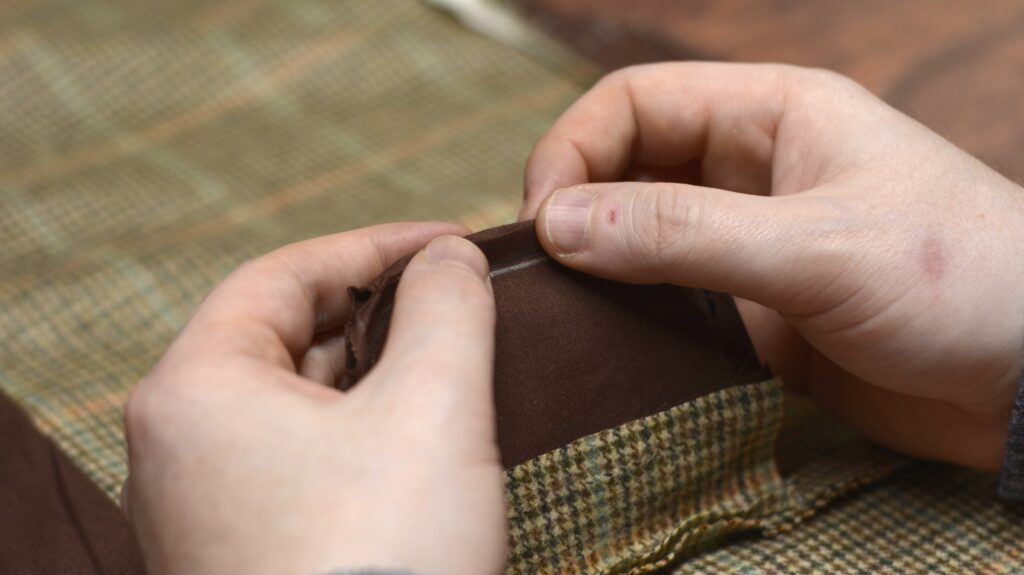
Fell or overcast the seam to the facings and along the pocket bag.
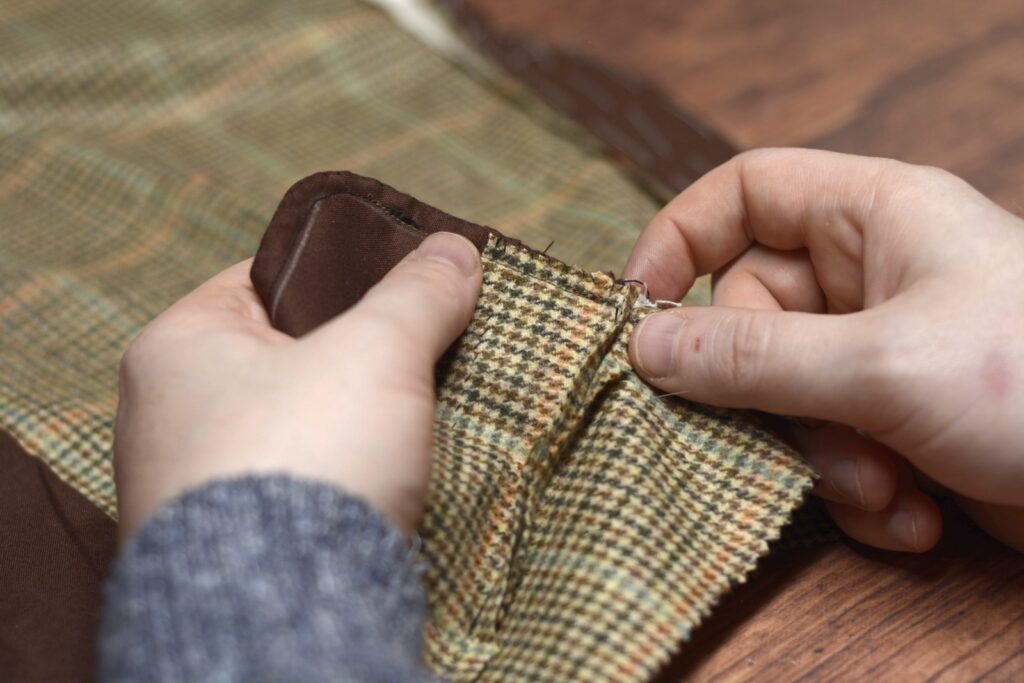
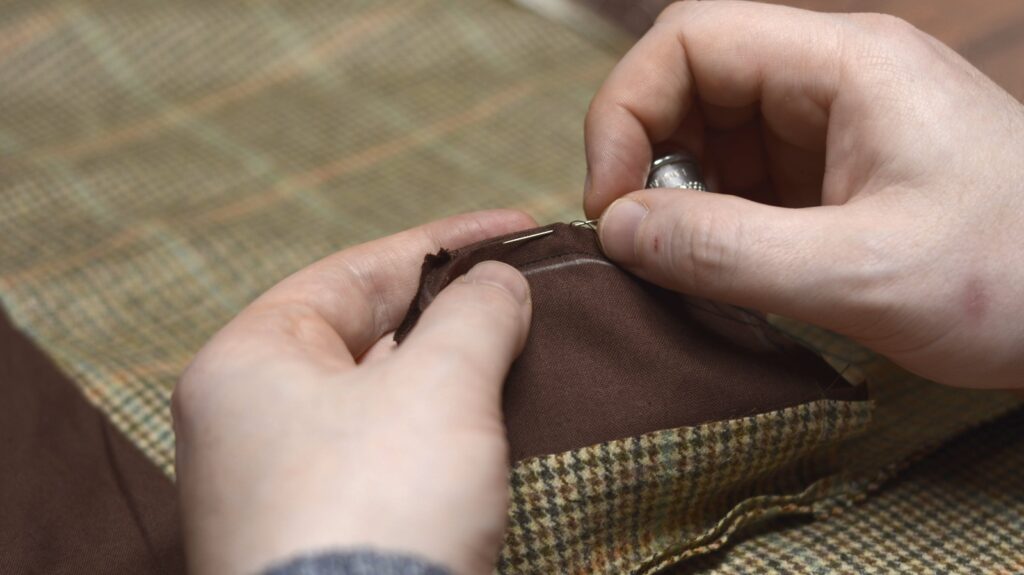
And with that the pocket is completed! We’ll tack down the ends of the pocket opening after the interfacing has been installed into the waistband.
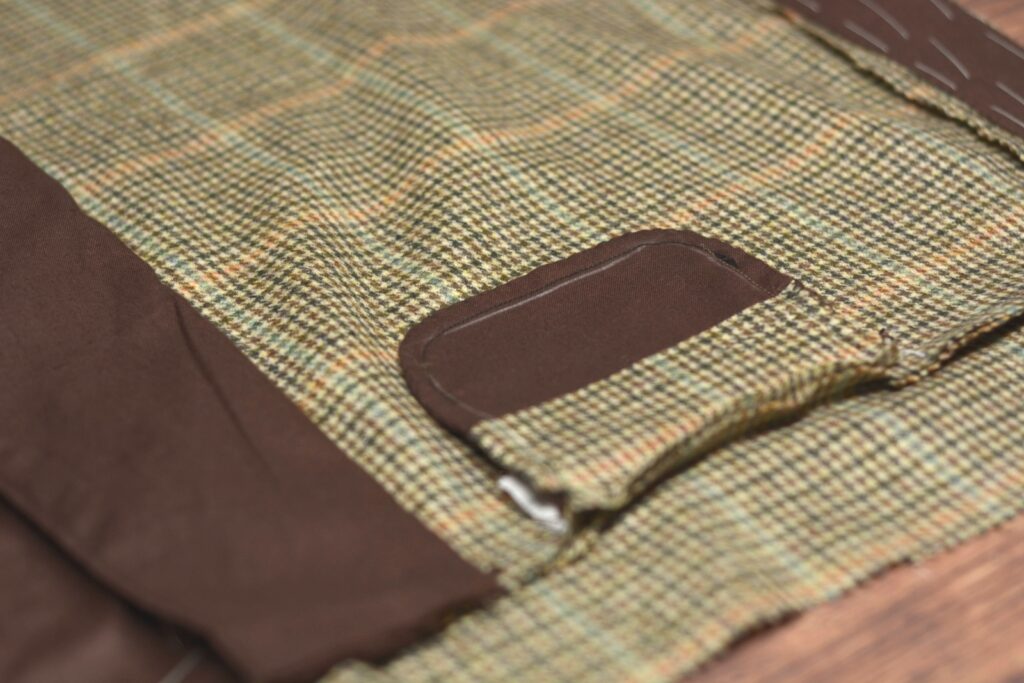
One last detail, fold the side seam pocket bag back into place and baste across the top edge, just below the waistband. We’ll finish attaching this after putting in the interfacing as well.
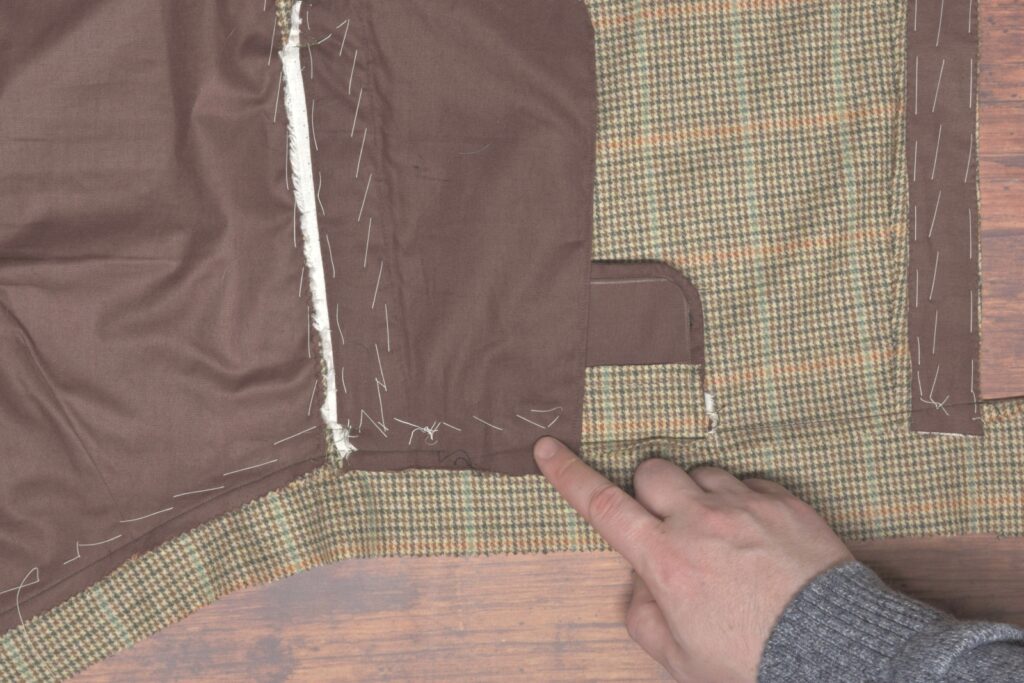
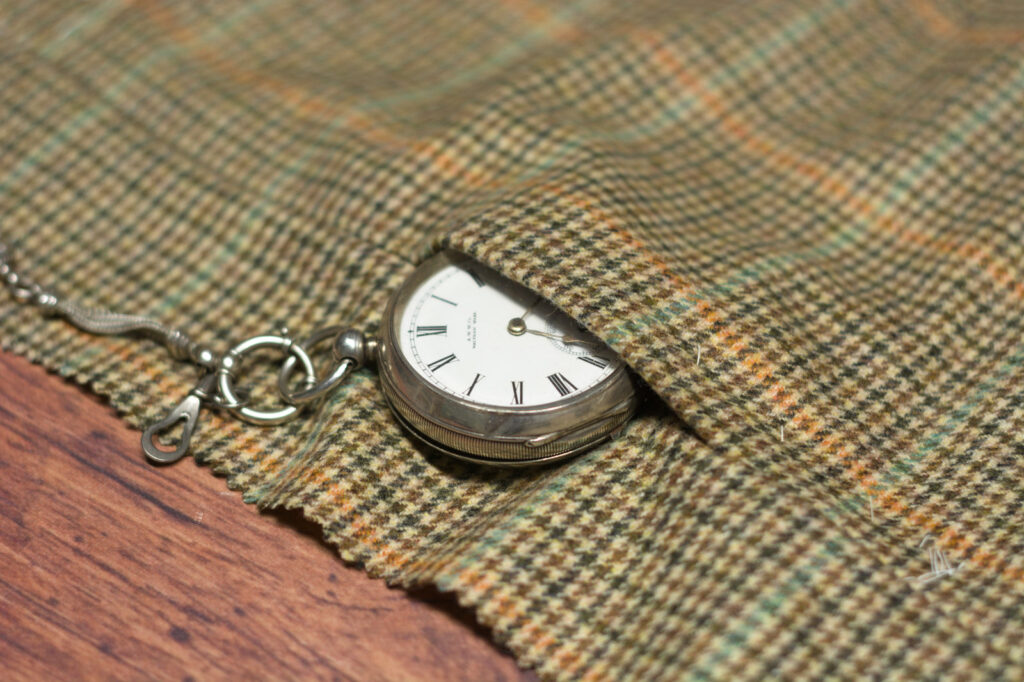
Trimming the Neck Line
The last thing to do on the shirt front is to trim the neck and shoulder line to its final shape. Lay the pleated front pattern on top of your linen, carefully aligning the shoulders, sides, and bottom edges. Then trace the neck and shoulder line in chalk. Flip the pattern over and repeat for the other half.
If necessary, baste the two halves of the pleated front together again (mine had come undone) before doing this step.
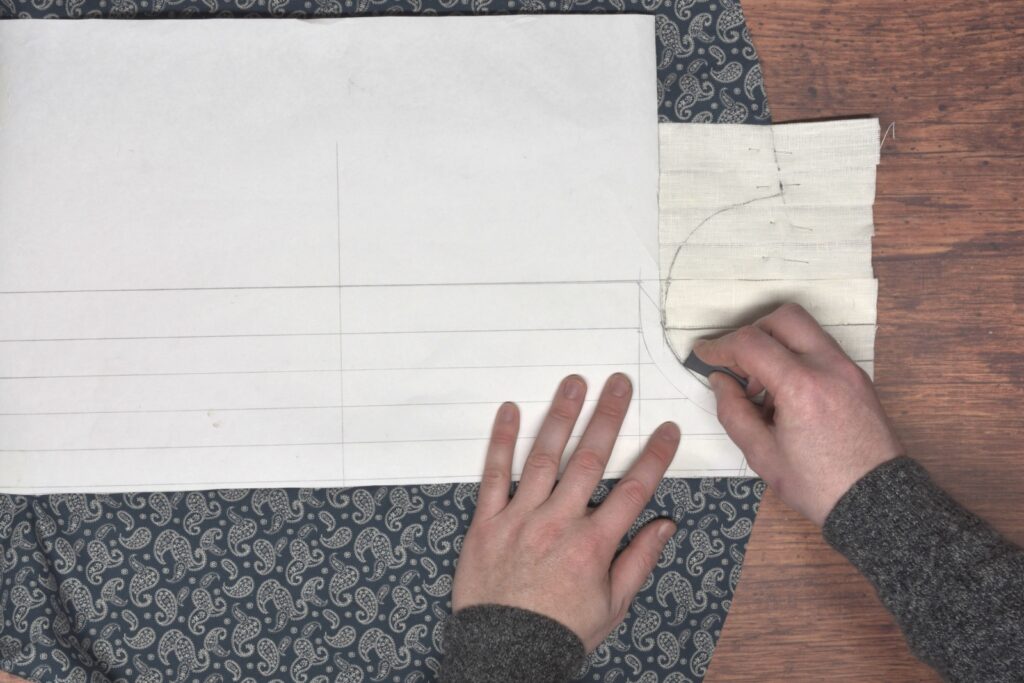
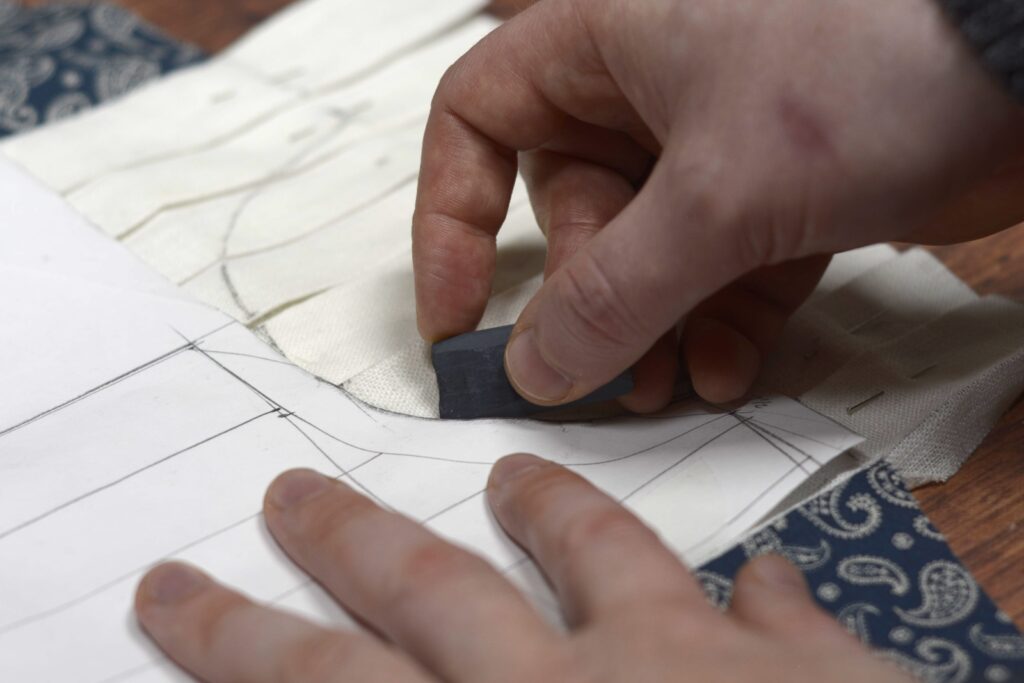
Now very carefully baste the pleats closed along the inside of the neck and shoulder line, keeping within 1/2″ of the line – this way you won’t have to remove the stitches after attaching the collar.
I used three or even four small diagonal basting stitches here, arranging the pleats in place as I worked, to ensure there is no movement during the rest of the construction.
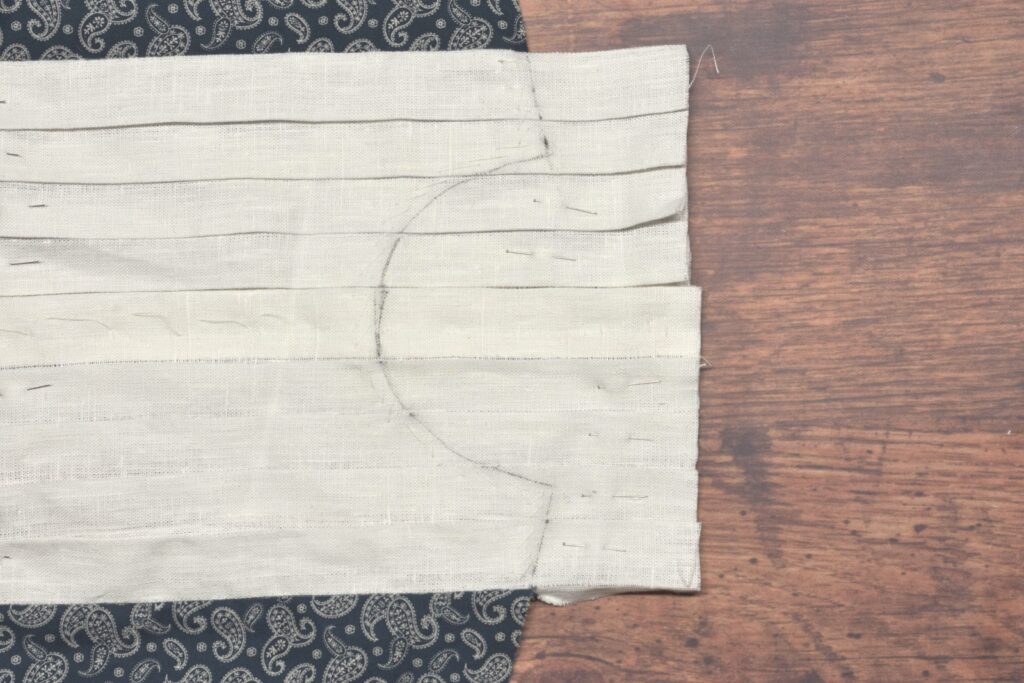
Finally, trim just to the inside of the lines, creating the curve of the neck and the final shoulder seams.
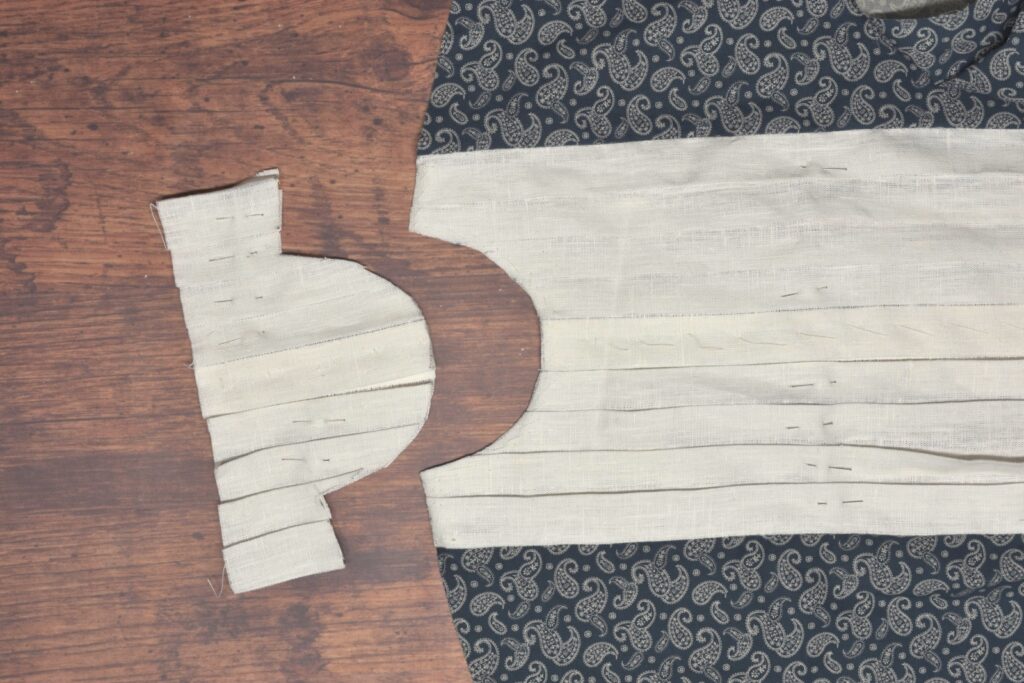

This completes the construction of the pleated front.
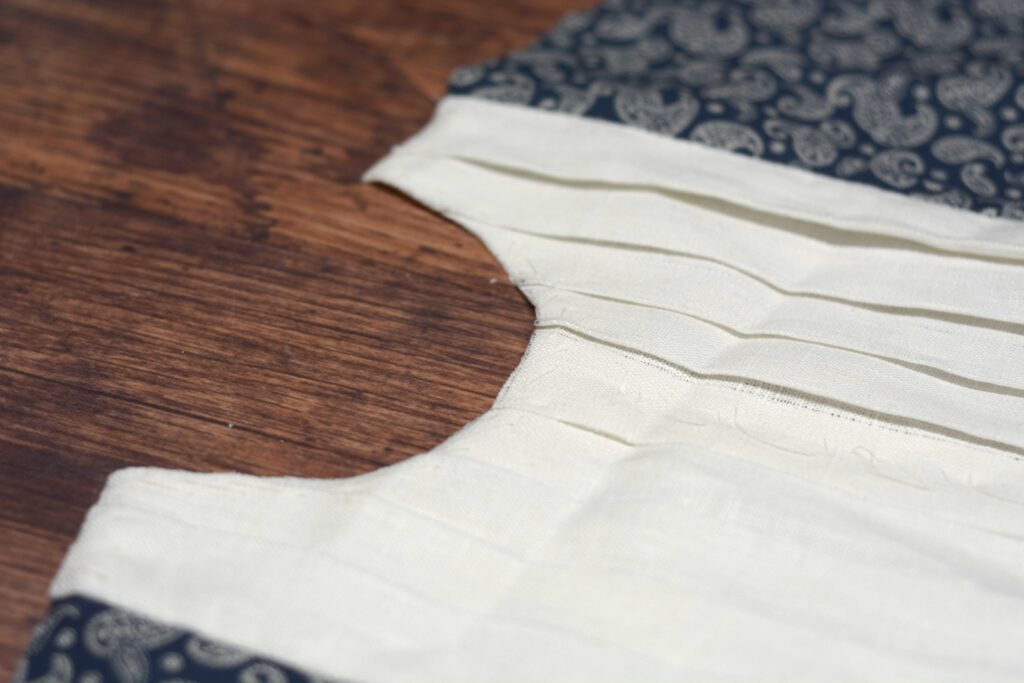
Your Progress
[columns gutter=”0″]
[col]
1 | Baste and trim the front neckline. |
[/col]
[col align_text=”center, middle”]
[/col]
[/columns]